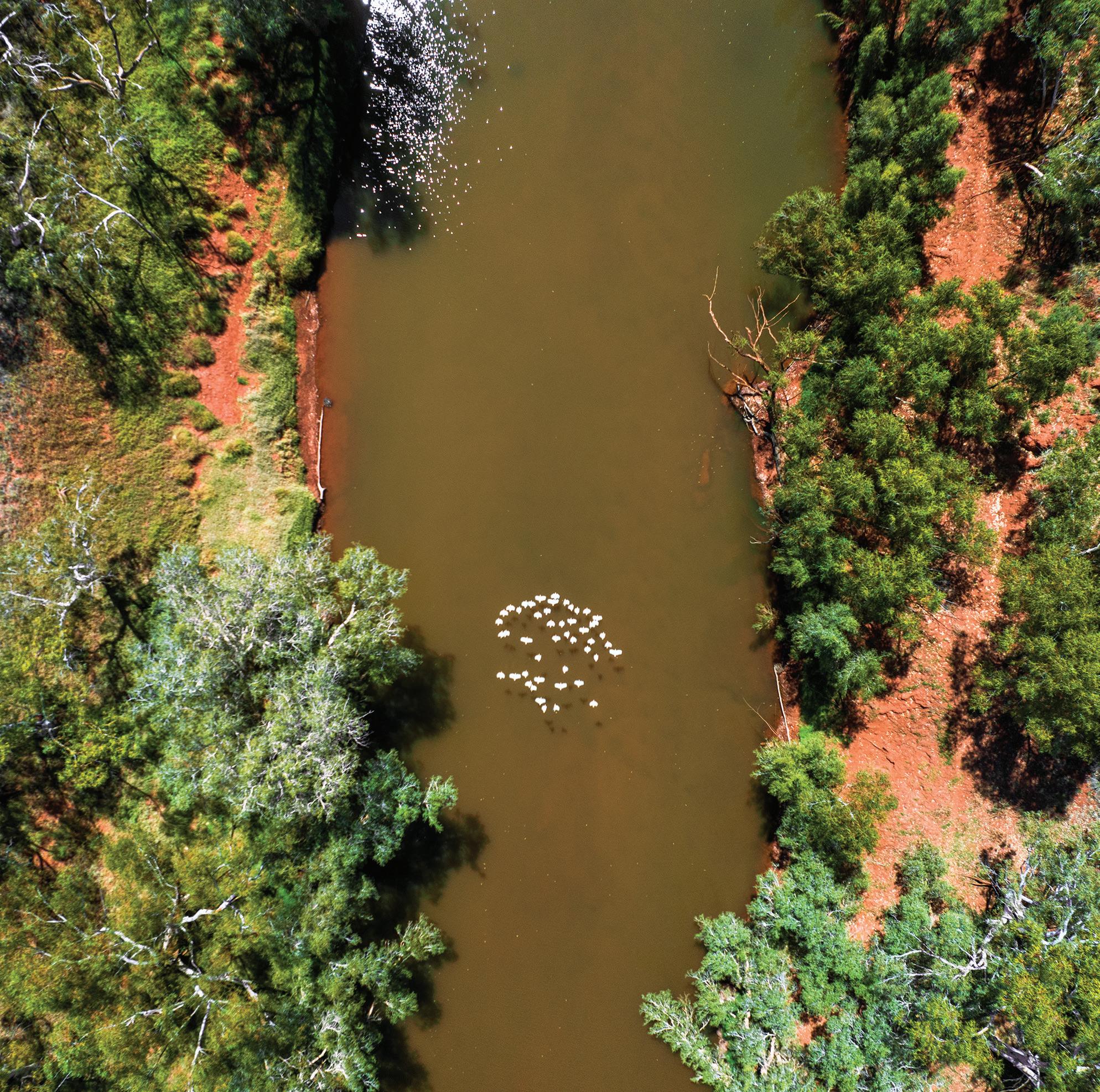
MINERAL RESOURCES LIMITED 2023 SUSTAINABILITY REPORT
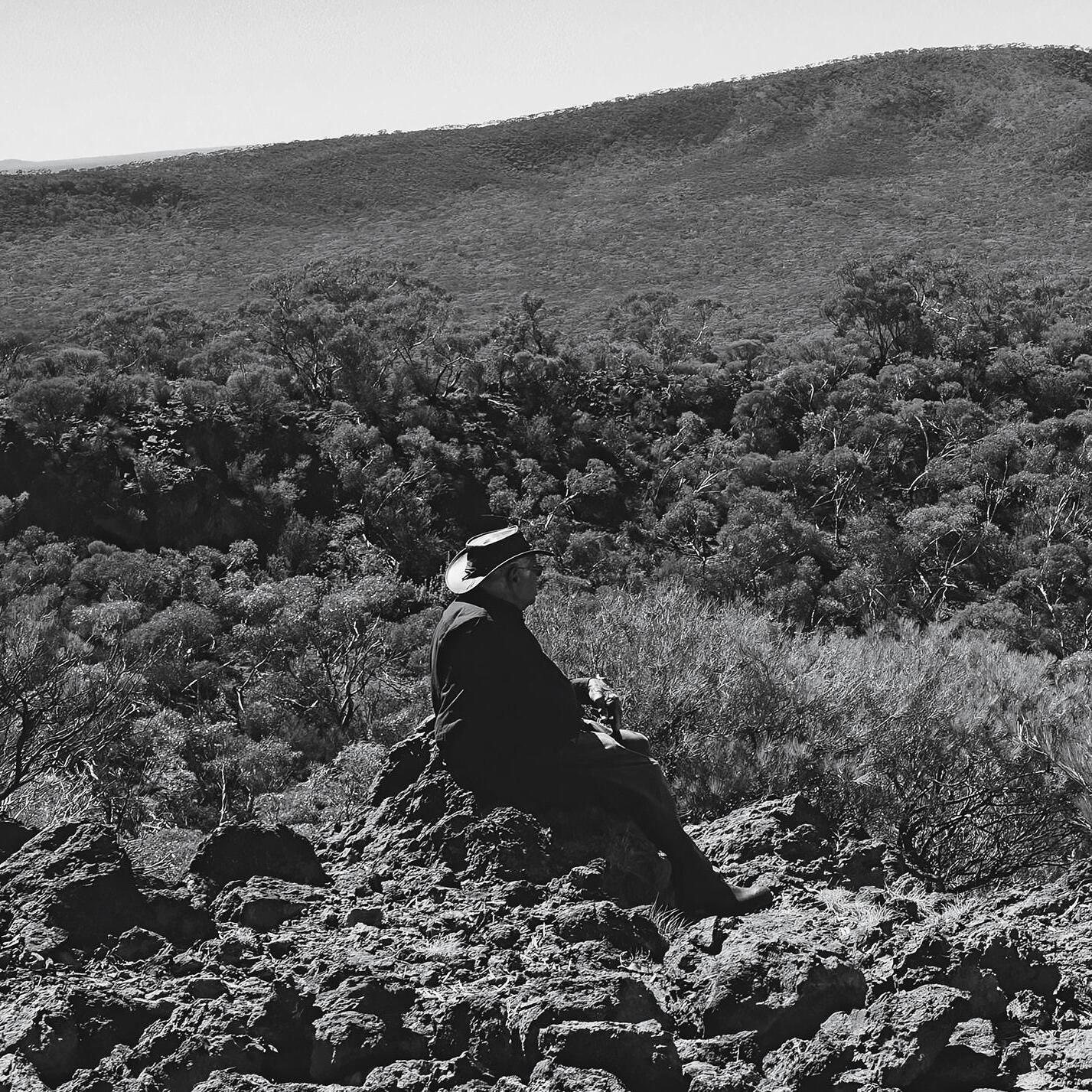


“BEING AN ELDER COMES WITH THE RESPONSIBILITY TO TAKE ACTION AS A LEADER. YOU’RE A GUIDE, STEERING OTHERS IN THE RIGHT DIRECTION, HELPING THEM ALONG THE WAY.”
Brian Champion
| Kalamaia Kaprun Elder | Eastern Goldfields and Yilgarn region, WA
ACKNOWLEDGEMENT OF COUNTRY
MINERAL RESOURCES LIMITED (MINRES) IS COMMITTED TO RECONCILIATION AND RECOGNISES AND RESPECTS THE SIGNIFICANCE OF ABORIGINAL AND TORRES STRAIT ISLANDER PEOPLES’ COMMUNITIES, CULTURES, AND HISTORIES.
MINRES ACKNOWLEDGES ABORIGINAL AND TORRES STRAIT ISLANDER PEOPLES AS THE FIRST AND CONTINUING CUSTODIANS OF THE LAND AND WATERS, AND IN DOING SO PAYS RESPECT TO ELDERS PAST AND PRESENT. WE EXTEND THIS ACKNOWLEDGMENT AND RESPECT TO INDIGENOUS PEOPLES AND COMMUNITIES GLOBALLY.
Where used herein “Indigenous Peoples” and “Indigenous Australians” refers to Aboriginal and Torres Strait Islander Peoples. Indigenous Australian readers are advised that this report may contain images and names of individuals who are deceased.
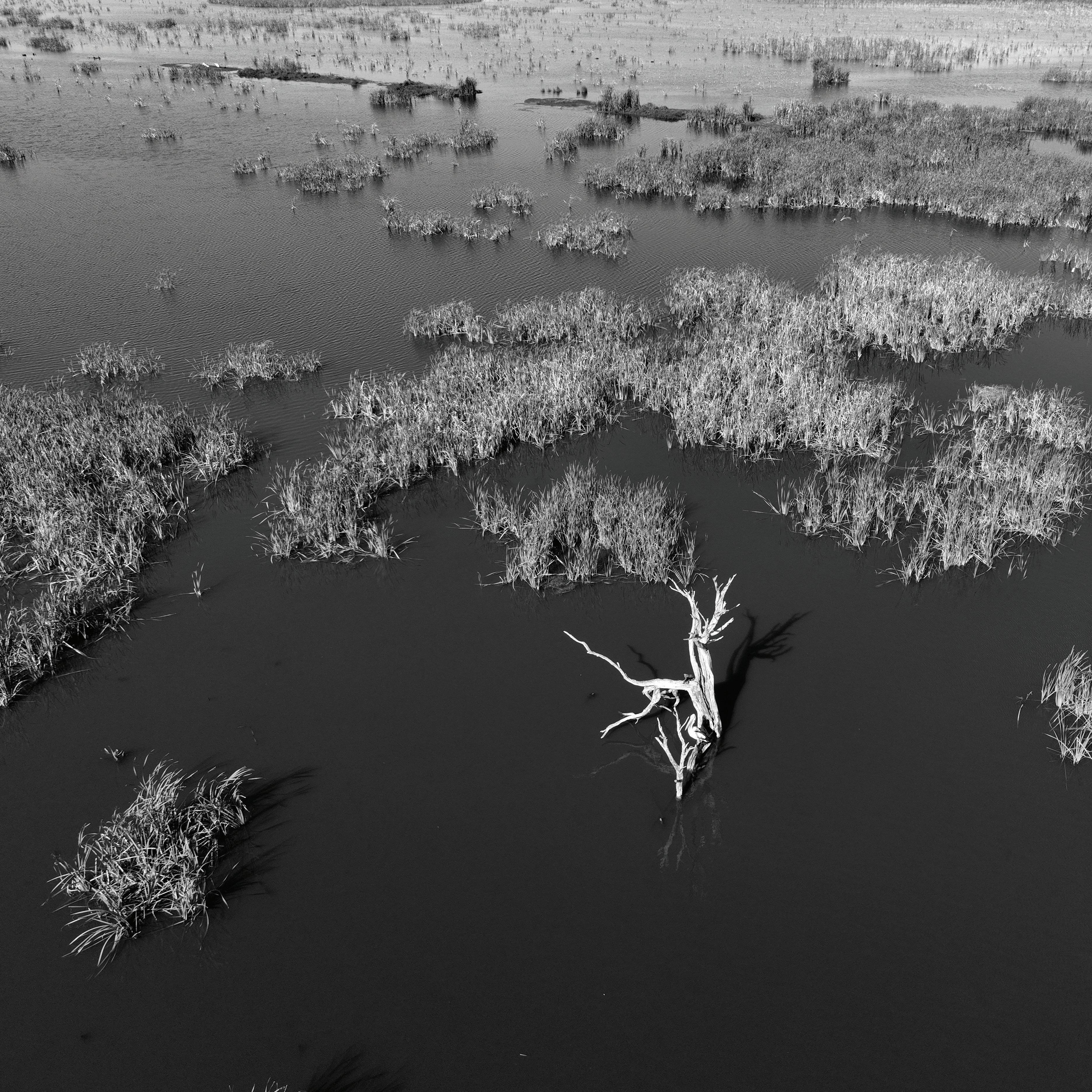
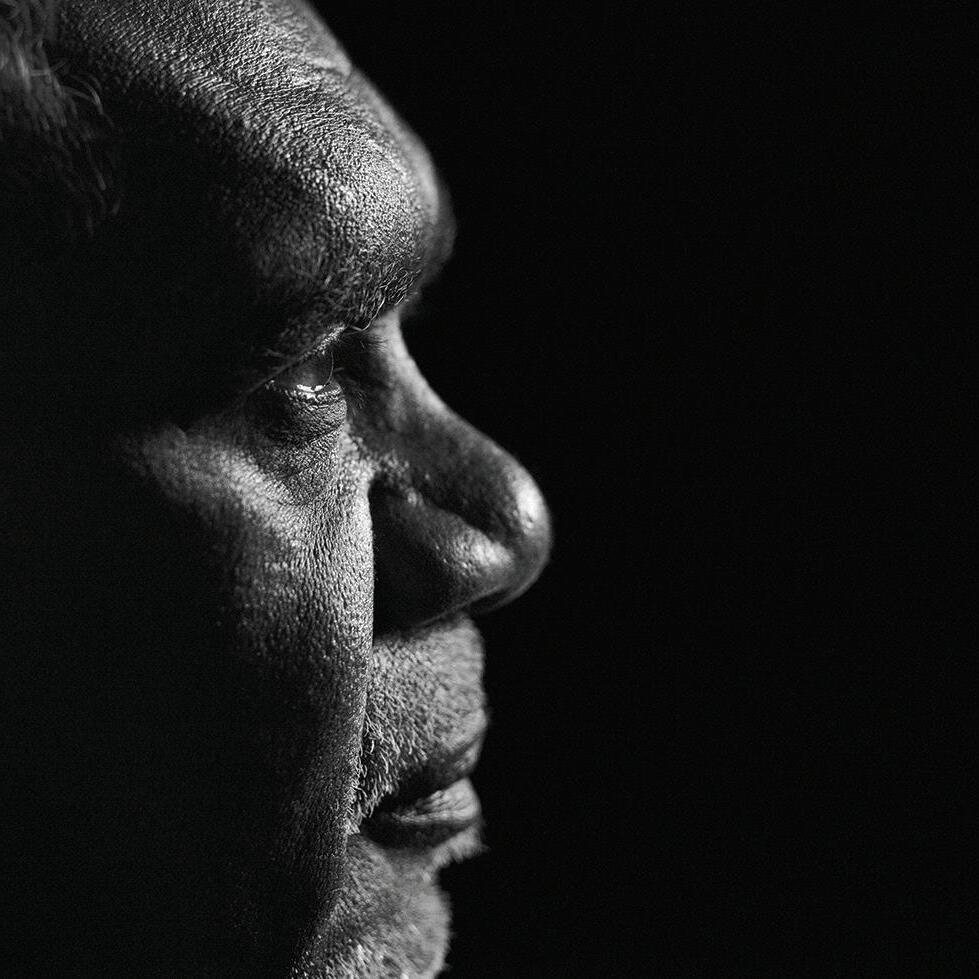
MINERAL RESOURCES LIMITED 2022 SUSTAINABILITY REPORT I 7
“KNOWLEDGE IS A FIRE THAT NEEDS TO KEEP BURNING SO CULTURE CAN LIVE ON. KNOWLEDGE IS NOT FOR US TO KEEP, IT MUST BE SHARED AND PASSED ON.”
Brian Tucker | Banyjima/Nyiyaparli Elder | Central Pilbara region, WA Brian Tucker | Banjima/Nyiyaparli Elder |
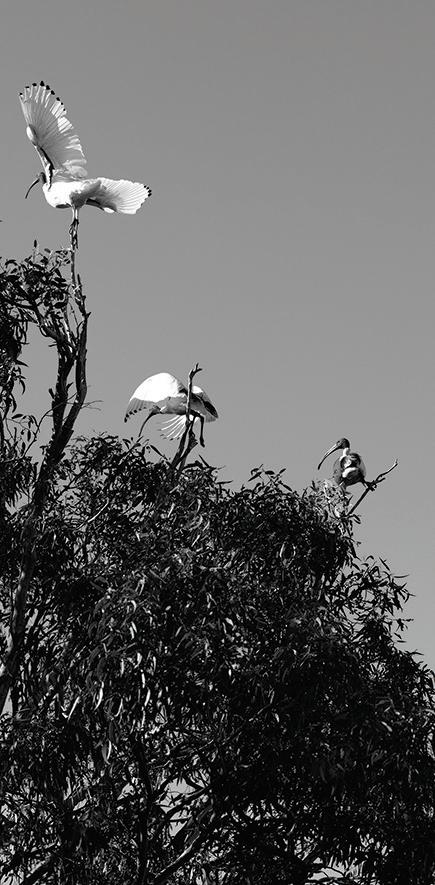
CHAIR AND SUSTAINABILITY CHAIR REVIEW 4 MINRES AT A GLANCE: VALUE CREATION 8 OUR SUSTAINABILITY APPROACH 11 GOVERNANCE 37 ETHICS AND INTEGRITY 44 ECONOMIC PERFORMANCE AND VALUE CREATION 52 RESPONSIBLE SUPPLY CHAINS 58 SOCIAL 67 HEALTH, SAFETY AND WELLBEING 68 ATTRACTING AND RETAINING TALENT 86 DIVERSITY AND INCLUSION 96 MANAGING LAND ACCESS AND CULTURAL HERITAGE 108 COMMUNITY AND STAKEHOLDER RELATIONSHIPS 118 ENVIRONMENT 125 MANAGING ENVIRONMENTAL IMPACT 126 AIR QUALITY 127 WATER STEWARDSHIP 128 NON-MINERAL WASTE 137 TAILINGS AND MINERAL WASTE 139 BIODIVERSITY 147 LAND MANAGEMENT AND REHABILITATION 154 MINE CLOSURE PLANNING 158 MANAGING CLIMATE CHANGE 160 TABLES AND FIGURES INDEX 177 INDEPENDENT LIMITED ASSURANCE STATEMENT 180 GLOSSARY AND LIST OF ABBREVIATIONS 185 MINRES LEADERS 196
CONTENTS
Photography by Russell James OAM. Creative direction by Ali Franco. Design by Calder Design.
BUILDING A LEGACY
MinRes has never been afraid to lead the way. For three decades, we’ve stayed true to our heritage by thinking differently, remaining agile and embracing a passion for innovation to seize new opportunities.
Today, MinRes is one of Australia’s leading pit-to-ship mining services providers with an expanding portfolio of world-class iron ore and lithium projects and an energy business focused on pursuing cleaner, cost-effective power for our operations.
We know our success comes with an obligation to operate responsibly and ethically. We are committed to continually improving our sustainability performance and demonstrating leadership in balancing the interests of our environment, communities, people and stakeholders.
This Sustainability Report celebrates the impact of leadership – from the stewards of the world’s oldest continuing culture to our people, who guide and support MinRes’ ambitious growth strategy every day.
Together, we’re building a legacy.
Images of Elders in this report feature in the 2023 Russell James exhibition
The Elders: Legacy of Leadership – a collection of portraiture exploring Elders’ history of leadership and innate connection to Country.
VISION
To be recognised as a great Australian company and a leading provider of innovative and sustainable mining services and mining operations.
PURPOSE
To provide innovative and low-cost solutions across the mining infrastructure supply chain by operating with integrity and respect, working in partnership with our clients, our customers, our people and our community.
OUR VALUES AGILE
You won’t hear “I don’t know” or “I can’t” very often at MinRes. We employ the best in the business to keep us moving forward. We act fast, seize opportunities and think differently.
FAMILY
We show up for each other and have each other’s back. We care for each other and the world around us and celebrate our differences because they make us stronger. Above all else, we are family.
ACHIEVE
Every person in our business contributes to our success. We do challenging work and we achieve incredible things. We have the courage to take on the impossible and the passion to make it happen.
MINERAL RESOURCES LIMITED 2023 SUSTAINABILITY REPORT I 1
ABOUT THIS REPORT
This Sustainability Report is a summary of Mineral Resources Limited’s material sustainability topics and performance for the financial year ended 30 June 2023 (FY23).
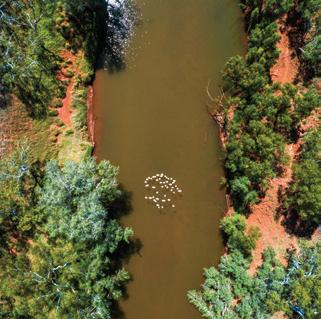

This report is part of our annual reporting suite which is accessible on our website: www.mineralresources.com.au
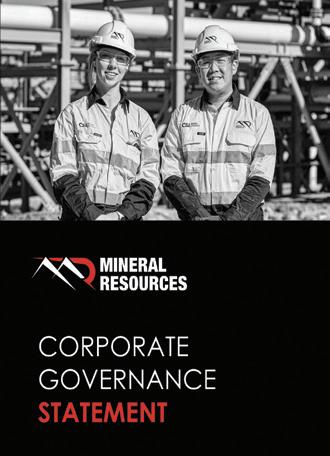

All references to ‘MinRes’, ‘the Company’, ‘the Group’, ‘we’, ‘us’ and ‘our’ refer to Mineral Resources Limited (ABN 33 118 549 910) and the entities it controlled, unless otherwise stated. Refer to our 2023 Annual Report for further information.
This report was reviewed and approved by MinRes senior management and Board of Directors (the Board) on 21 September 2023.
PUBLISHED DATE
This report was published on 16 October 2023.
REPORTING PERIOD
This report covers the period from 1 July 2022 – 30 June 2023. References in this report to ‘year’ are to the financial year ended 30 June 2023 unless otherwise stated.
CURRENCY REFERENCES
All dollar figures are expressed in Australian dollars (AUD) unless otherwise stated.
REPORTING FRAMEWORKS


This document has been prepared in accordance with the following frameworks:
• Global Reporting Initiative (GRI) Sustainability Reporting Standards and the GRI Mining and Metals Sector Disclosures










• Sustainability Accounting Standards Board (SASB) Metals & Mining and Coal Operations Standards





• Recommendations outlined by the Task Force on Climate-related Financial Disclosures (TCFD)
• United Nations (UN) Global Compact – MinRes is a signatory to the UN Global Compact.
Our sustainability performance against these frameworks can be found in our 2023 Sustainability Performance Data Tables.
In addition, we voluntarily engage with several top-tier organisations that assess and rank our sustainability performance across financially material environmental, social and governance (ESG) risks. These include Morgan Stanley Capital International (MSCI), Institutional Shareholder Services (ISS), Sustainalytics and FTSE 4 GOOD.
REPORTING BOUNDARIES
We strive to apply consistent reporting boundaries and are committed to providing complete and transparent reporting in line with industry practice. Figures and tables presenting an aggregated view of MinRes include all sites (except when otherwise stated), where:
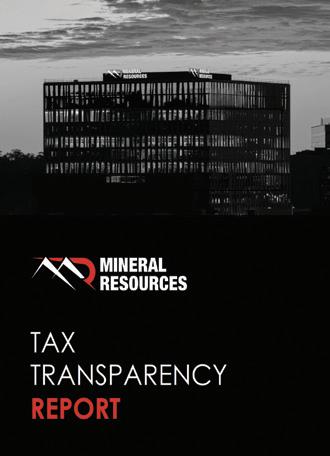
• MinRes has operational control.
• the sites are wholly managed by MinRes.

• MinRes maintains a majority ownership in a joint venture.


• MinRes has management on-site as per a joint venture agreement.
Entities that we do not control, but have significant influence over, are included in the form of disclosures of management approach. The report does not include data from equity interest fields/ projects, such as joint ventures, where we are not an operator.
Sustainability Performance Data Tables Annual Report
Modern Slavery Statement 2 I MINERAL RESOURCES LIMITED 2023 SUSTAINABILITY REPORT
Tax Transparency Report Corporate Governance Statement 2023 SUSTAINABULITY PERFORMANCE DATA TABLES 2023 SUSTAINABULITY PERFORMANCE DATA TABLES 2023 ANNUAL REPORT
LEGACY OF LEADERSHIP 2023 MODERN SLAVERY STATEMENT
The location of our operations are shown on page 7.
DISCLAIMER
This document contains forward-looking statements, including, but not limited to expectations regarding:
• climate change and climate-related risks and opportunities
• future execution of MinRes’ Roadmap to Net Zero Emissions
• achievements of net zero emissions in accordance with the projections from 2024-2050
• development and implementation of technologies or emission reduction projects
• trends in commodity prices and their supply and demand
• regulatory and policy developments.
When used herein, the words “anticipate”, “believe”, “could”, “estimate”, “expect”, “going forward”, “intend”, “may”, “plan”, “project”, “seek”, “should”, “will”, “would” and similar expressions, as they relate to the Company, are intended to identify forward-looking statements. The forward-looking statements are based upon certain assumptions and information available to the Company as at the date of this document. These assumptions may prove to be incorrect.
There are also limitations with respect to scenario analysis and it is difficult for the Company to predict which scenarios (if any) may eventuate.
Forward-looking statements are not a guarantee of future performance as they involve risks, uncertainties and other factors, many of which are beyond the Company’s control and may cause results to be different from statements in this document. The Company cautions against undue reliance on any forward-looking statements.
This document does not purport to be all inclusive or to contain all information which its recipients may require to make an informed assessment of the Company’s sustainability performance.
To the fullest extent permitted by law, MinRes, its affiliates and their respective officers, directors, employees and agents, accept no responsibility for any information provided in this document, including any forward-looking statements, and disclaim any liability whatsoever (including for negligence) for any loss howsoever arising from any use of this document or reliance on anything contained in or omitted from it or otherwise arising in connection with this. In addition, MinRes accepts no responsibility to update any person regarding any inaccuracy, omission or change in information or the Company’s expectations in this document or any other information made available to a person, nor any obligation to furnish the person with any further information.
This document should not be relied upon as a recommendation by, or advice from, MinRes to deal in its securities. This document should be read in conjunction with other MinRes periodic and continuous disclosure announcements lodged with the Australian Securities Exchange (ASX).
PERFORMANCE DATA
Figures in tables and in the text presented in this report may be rounded. Discrepancies in tables and figures between totals and sums of components are due to rounding.
Our 2023 Sustainability Performance Data Tables disclose MinRes' sustainability performance data, which illustrates our performance against our sustainability targets and metrics for the financial year. Where possible, data is presented across five years to highlight trends in our sustainability performance.
The 2023 Sustainability Performance Data Tables are available on our website and should be read in conjunction with this report.
RESTATEMENTS
Historic numbers are sometimes adjusted due to changes in reporting principles, changes of calculation factors used by authorities, or re-classification of incidents after investigations.
Where there have been changes to previously reported data, this is shown in italics. MinRes provides updated figures and explains the changes if the adjustment represents a material change.
INDEPENDENT ASSURANCE
MinRes engaged an independent, external assurance provider, Ernst & Young (EY), to provide limited assurance over ten of our sustainability performance indicators. This includes data on our safety performance, greenhouse gas emissions and energy consumption profile, gender diversity, employee training, community contributions, supplier screening and the value generated and distributed.
Refer to page 181 of this report for a copy of the Independent Limited Assurance Statement.
ADDITIONAL INFORMATION
Italicised text highlighted in the relevant section colour is hyperlinked to documents available on our external website.
We welcome your questions and feedback about our sustainability performance and any sustainability related disclosures. Please direct your enquiries to esg.reporting@mrl.com.au
MINERAL RESOURCES LIMITED 2023 SUSTAINABILITY REPORT I 3
As a leading mining services company, we recognise the importance of sustainable mining practices throughout our business activities. We understand the challenges facing our industry and continue to strive to improve as a responsible business. Responsible mining practices have never been more important, and effectively and transparently communicating our performance reinforces trust with our stakeholders. We remain focused on building and maintaining strong relationships within the communities in which we operate to create shared value.
Our FY23 sustainability reporting suite demonstrates our commitment to continually improving our performance while serving as a reflection of our journey.
GOVERNANCE
In FY23, the MinRes Board grew and diversified with the appointments of Emeritus Professor Colleen Hayward AM and Justin Langer AM as Independent NonExecutive Directors. Both bring a diverse set of new skills, experience and perspectives to our Company.




Our Sustainability Committee plays a crucial role providing oversight of MinRes’ sustainability management. As we mature as a company, strengthening our approach to sustainability governance relies on a diverse set of voices and perspectives. To this end, we made changes to our Sustainability Committee with James McClements and Xi Xi retiring as members, while Colleen and Justin joined in April 2023.
In line with improving our transparency, this year we also present our first annual Tax Transparency Report as part of this reporting suite.
HEALTH, SAFETY AND WELLBEING
We faced tragedy in June when an incident during construction at the Ken’s Bore site resulted in the death of contractor employee Kieren McDowall – a loving partner and father of two young boys who had his whole life ahead of him. The safety of our people is our number one priority. This tragic event has affected us and our whole team profoundly. We continue to offer every support to Kieren’s family, colleagues and loved ones.
The incident serves as a tragic reminder of the risks within our industry and the importance of remaining vigilant when it comes to safety. MinRes is undertaking an independent review of the incident to understand the circumstances and take action to prevent recurrence.
We remain committed to improving the wellbeing of our MinRes family, with zero tolerance for any behaviours that jeopardise employee safety. Our continued growth now sees MinRes supported by over 5,600 people and heightens our focus and shared responsibility to look after each other.
To achieve our strategic objectives, MinRes employees must feel valued, supported, and empowered. We focus on supportive leadership and proactive education, with a health and wellbeing system defined by three pillars: prevent harm, mitigate illness and promote thriving.
We consider mental health as equally important as physical health, playing a critical role in fostering employee engagement and enhancing productivity. During FY23, we engaged a new Employee Assistance Program provider to ensure a more holistic wellbeing program with improved accessibility, as well as adopting an Onsite Wellbeing Strategy to support our Health and Wellbeing Advisors to embed
health and wellbeing across our regional operations.
Acknowledging and effectively managing psychosocial hazards is crucial for safeguarding employee wellbeing, promoting a positive environment. In FY23, we delivered Psychosocial Hazard Awareness training to 2,299 employees, empowering them to identify, report and manage psychosocial hazards.
SAFE AND RESPECTFUL BEHAVIOURS
In FY23, we continued to enrich our workplace culture and foster an environment where all employees feel welcome and accepted. We identify a safe and respectful culture as being values-driven and we are committed to keeping our MinRes family safe.
Our Safe and Respectful Behaviours Procedure guides how we address inappropriate workplace behaviour, while our bias awareness, bullying, discrimination, and harassment training helps our workforce understand and model acceptable behaviours.
We continue to prioritise a safe and effective reporting culture through workforce education and accessibility to both internal and external reporting channels. We actively encourage the reporting of all incidents while ensuring those who raise issues are supported and treated with fairness and respect. In FY23, we recorded an increase in reports following our Safe and Respectful Behaviours training and awareness campaign, as well as our Psychosocial Hazards Awareness training.
DIVERSITY AND INCLUSION
MinRes has achieved several milestones in our efforts to attract and retain a diverse
4 I MINERAL RESOURCES LIMITED 2023 SUSTAINABILITY REPORT CHAIR AND SUSTAINABILITY CHAIR REVIEW
James McClements | Independent Non-Executive Chair
ON BEHALF OF THE BOARD AND SUSTAINABILITY COMMITTEE, WE ARE PLEASED TO PRESENT OUR ANNUAL SUSTAINABILITY REPORTING SUITE FOR THE 2023 FINANCIAL YEAR, INCLUSIVE OF THE SUSTAINABILITY REPORT AND PERFORMANCE DATA TABLES.
workforce, driven by more inclusive recruitment practices, strengthened parental leave and improved leadership diversity. We confirmed no gender pay gaps for comparable positions and are committed to conducting formal gender pay reviews annually, ensuring salaries remain equitable.
We increased our Indigenous Australian workforce to 3.5 per cent – offering over 160 roles to Indigenous Australian candidates, an increase of 93 per cent from FY22. Indigenous employee retention will be a focus in FY24, set to be supported by site-based Indigenous engagement professionals.
RESPONSIBLE SUPPLY
We strengthened processes to address risks of human rights abuses in our operations and supply chains, with a focus on responsible procurement practices to mitigate risk and meet industry expectations regarding sustainable sourcing and supply chain management. During FY23, 85 per cent of our Tier 1 supplier spend occurred in Australia, with 80 per cent based in Western Australia.
Further details about our approach are outlined in our annual Modern Slavery Statement, available on our website.
CLIMATE CHANGE
In line with the changing regulatory environment and importance of responsible mining practices, MinRes remains focused on reducing our carbon footprint and achieving our target of net zero emissions by 2050.
We acknowledge the inherent challenges facing our industry and are committed to tracking and reporting our progress against our Roadmap to Net Zero Emissions. Our expansion and construction activities saw an increase in our scope 1 emissions by 11 per cent.
To achieve our targets in FY24, we plan to deploy an autonomous road haulage fleet, install solar PV systems and energy storage solutions at our Onslow Iron project.
ENVIRONMENT
Our environmental management approach is underpinned by various policies and procedures and our mining operations are managed in line with the regulatory framework governed by both Commonwealth and State legislation. Our Environment team continues to expand with specialists in key areas to meet project requirements and strengthen in-house capability. Our achievements during the financial year include zero high-impact environmental incidents, developing a business wide Biodiversity Strategy and completing water efficiency audits at our lithium and iron ore operations.
INDIGENOUS AND COMMUNITY ENGAGEMENT
MinRes’ social investment framework was reviewed in FY23 to ensure alignment with industry best practice and support meaningful contributions to the communities in which we operate. Our framework prioritises mutually beneficial and sustainable relationships with our host communities, and includes the implementation of Indigenous Small Business Grants, increased cultural awareness training sessions and identification of initiatives to fund through our social investment program. In FY23, we increased our community contributions by nearly 30 per cent, with a total of $7.5 million delivered through our social investment program to support more than 120 organisations. We also revitalised our Reconciliation Action Plan (RAP) Working Group, which will oversee drafting of an Innovate RAP
LOOKING FORWARD
We respect the importance of operating responsibly and in the best interests of the environment, our people, local communities and stakeholders. This year we continued to make pleasing progress against our sustainability targets by implementing impactful Company initiatives.
As we look to the future, we will continue to proactively identify sustainability opportunities and risks while progressing our long-term growth and strategic goals.
We will support this trajectory by finalising the Corrective Action Plan from our responsible mining audit at our Mt Marion lithium operation and achieving Initiative for Responsible Mining Assurance (IRMA) verification at our Wodgina lithium operation to cement our position as a responsible supplier.
We remain thankful to Chris Ellison, his leadership team and the efforts of thousands of employees and contractors while we navigate another transformational year for our business.
Their adaptability, resilience and passion supports MinRes’ continued growth as an Australian success story.
Susie Corlett Sustainability Chair

 James McClements Independent Non-Executive Chair
James McClements Independent Non-Executive Chair

MINERAL RESOURCES LIMITED 2023 SUSTAINABILITY REPORT I 5
CHAIR AND SUSTAINABILITY CHAIR REVIEW
Susie Corlett | Sustainability Chair
MINRES REMAINS FOCUSED ON REDUCING OUR CARBON FOOTPRINT AND ACHIEVING OUR TARGET OF NET ZERO EMISSIONS BY 2050.
MINRES IS A LEADING DIVERSIFIED RESOURCES COMPANY, WITH EXTENSIVE OPERATIONS IN MINING SERVICES, LITHIUM, IRON ORE AND ENERGY ACROSS WESTERN AUSTRALIA.
WITH A FOCUS ON PEOPLE AND INNOVATION, MINRES HAS BECOME ONE OF THE ASX’S BEST-PERFORMING COMPANIES SINCE LISTING IN 2006.
6 I MINERAL RESOURCES LIMITED 2023 SUSTAINABILITY REPORT
MINRES IRON ORE MINRES LITHIUM CSI MINING SERVICES MINRES ENERGY EP SEA PORT OFFICE/WORKSHOP MINRES DEVELOPMENT PROJECT TOWN RAIL LINE ROAD WESTERN AUSTRALIA KEY MINRES DEVELOPMENT PROJECT TOWN OFFICE/WORKSHOP CSI MINING SERVICES MINRES ENERGY EP RAIL LINE SEA PORT MINRES IRON ORE ROAD MINRES LITHIUM OPHTHALMIA PERTH BASIN (LOCKYER DEEP ) BUNGAROO SOUT H RED HILL IRON OR E KEMERTON NEWMAN KWINANA WORKSHOP UTAH POINT SOUTH WEST CREEK PORT HEDLAND TOM PRIC E MARILLAN A KUMINA GERALDTON IRON VALLEY KOOLYANOBBING WODGINA WONMUNNA ONSLO W ESPERANC E K ALGOORLI E MT MARIO N PARKER RANGE BUNBURY CARINA PERTH WINDARLING NORTHERN TERRITORY SOUTH AUSTRALI A MINERAL RESOURCES LIMITED 2023 SUSTAINABILITY REPORT I 7
INPUTS
HUMAN CAPITAL: Our employees who provide the skills, experience and knowledge required to undertake our business activities.
NATURAL CAPITAL:
The natural resources such as water, land, materials and energy required to undertake our business activities.
SOCIAL AND RELATIONSHIP CAPITAL: The relationships we have with communities, government agencies and other stakeholders, as well as our reputation and brand, are essential.
FINANCIAL CAPITAL: The pool of funds provided by shareholders, bondholders and banks, or generated through investments and operations that are required to undertake our business activities.
MANUFACTURED CAPITAL: The manufactured tangible objects such as buildings, plant, equipment and infrastructure that are required to undertake our business activities.
INTELLECTUAL CAPITAL: Intangible aspects such as intellectual property, organisational knowledge, systems and processes required to undertake our business activities.
VALUE CREATION MODEL
THE MINRES BUSINESS IS STRUCTURED UNDER FOUR GROWTH PILLARS – MINING SERVICES, IRON ORE, LITHIUM AND ENERGY.
Each growth pillar operates as a separate business drawing on centralised shared services from MinRes.
These pillars are targeted for transformational growth over the next five years and require focused services and specialised skills to ensure they are set up for growth and success.
This structure aims to deliver value to shareholders by:
• Mining Services – Doubling in size as we build, own and operate a significant portfolio of world-class assets, while continuing to offer our Tier 1 clients pit-to-ship solutions
• Iron Ore – Increasing production from 20Mtpa to a targeted 90Mtpa+ through the development of our three iron ore hubs in Onslow, Pilbara and Yilgarn
• Lithium – Becoming a global top five lithium producer and creating a significant cost advantage through a globally diverse business model
• Energy – Displacing diesel with gas and solar across MinRes operations, and investigating downstream opportunities including LNG and iron ore pellet manufacturing
5 years
ENERGY
Decarbonise and power MinRes operations. Investigate downstream opportunities
DELIVERING THE STRUCTURES, SYSTEMS AND PEOPLE TO TAKE MINRES TO THE NEXT PHASE OF GROWTH Safety, Health and Wellbeing, Finance, Procurement, Human Resources, IT, Corporate Affairs, Environment and Approvals, Community and Stakeholder Engagement
MINRES AT A GLANCE: VALUE CREATION 8 I MINERAL RESOURCES LIMITED 2023 SUSTAINABILITY REPORT
MINING SERVICES Double in size over the next
IRON ORE Transition to large, low-cost producer –increase production to 90Mtpa+ in 5 years
LITHIUM Top 5 lithium producer with globally diverse presence in battery supply chain
FY23 OUTPUTS
FY23 OUTCOMES
6.7%
MINRES AT A GLANCE: VALUE CREATION MINERAL RESOURCES LIMITED 2023 SUSTAINABILITY REPORT I 9
ON INVESTED CAPITAL (ROIC)
IRON ORE PRODUCTION 17.5Mt SHIPPED SPODUMENE PRODUCTION 847k dmt SHIPPED MINING SERVICES CONTRACT TONNES 248Mt TOTAL MATERIAL MOVED 134,877Mt
RETURN
HUMAN CAPITAL TRIFR 2.08 LTIFR 0.07 Employee wages and benefits paid $835M Overall female representation 22% Career entry employees 369 NATURAL CAPITAL Total net energy consumption 5,538,632GJ Gross generation from renewable (solar PV before export) 2,640GJ Scope 1 and 2 GHG emissions 376,951tCO2e Rehabilitated land 1,217ha SOCIAL AND RELATIONSHIP CAPITAL Community contributions $7.5M Suppliers screened for modern slavery 2,958 Payment to Federal, State and Local governments $444M FINANCIAL CAPITAL Underlying net profit after tax $769M Share price as at 30 June 2023 $71.43 Dividends (fully franked) $1.90 MANUFACTURED CAPITAL Capital expenditure $1.8bn Mines owned/operated 5 Crushing and processing operating plants 26 INTELLECTUAL CAPITAL NextGen 3 modular crushing plant 5Mtpa - 50Mtpa Spodumene concentrate processing 1.65Mtpa

OUR SUSTAINABILITY APPROACH
MINERAL RESOURCES LIMITED 2023 SUSTAINABILITY REPORT I 11
WE STRIVE TO GENERATE SHAREHOLDER VALUE AND MAINTAIN OUR SOCIAL LICENCE TO OPERATE BY SUPPORTING THE WELLBEING OF OUR PEOPLE, PROTECTING THE ENVIRONMENT AND MAKING A POSITIVE CONTRIBUTION TO THE COMMUNITIES IN WHICH WE OPERATE.
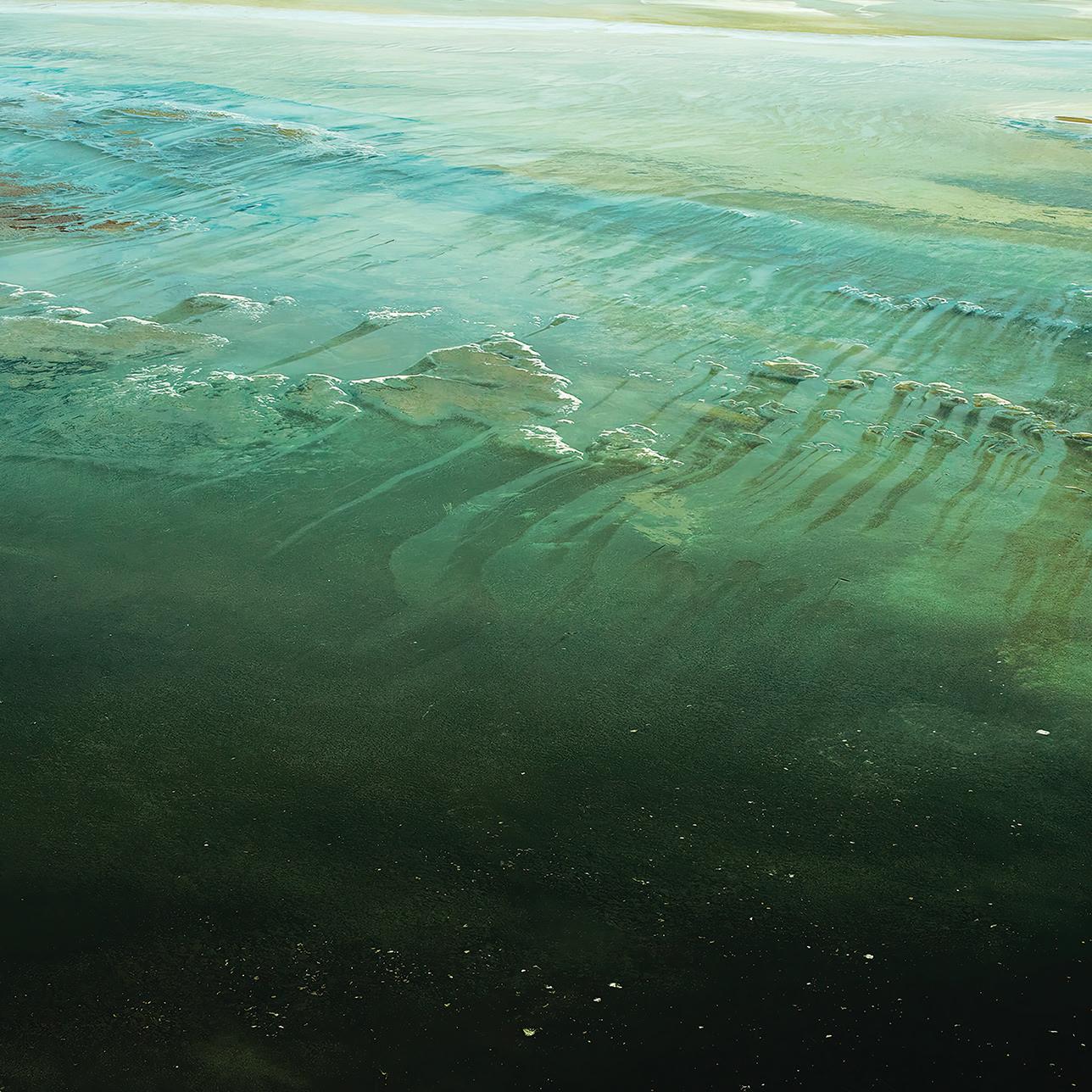
OUR SUSTAINABILITY PATHWAY
MinRes is committed to continually improving our sustainability performance as we continue providing the metals and minerals the world needs to transition to a low-carbon future. We strive to make a difference through our leadership in mining services and operations, encouraging responsible business practices, recognising the importance of sustainability, and acting in a manner that enhances our social licence to operate, with our aim to create long-term value for all stakeholders. We incorporate responsible mining principles into our decision-making, strategic planning and risk management processes.
Commenced reporting in accordance with the Global Reporting Initiative (GRI) Standards.


Reported our annual gender statistics to the Australian Government’s Workplace Gender Equality Agency (WGEA) for the first time.
Formalised and published externally our Sustainability Policy
Developed and externally published our Human Rights Policy
Reported climaterelated disclosures in alignment with the recommendations of the Task Force on Climate-Related Financial Disclosures (TCFD).
Developed our Roadmap to Net Zero Emissions, with a goal to achieve net zero emissions by 2050 announced.
Engaged EY for the first time to complete limited assurance over sustainability performance indicators.
Established a cross-functional Sustainability Working Group.
Reported in alignment with the UN Sustainable Development Goals (SDG) for the first time.
Commenced reporting to the Bloomberg Gender Equality Framework.
14 I MINERAL RESOURCES LIMITED 2023 SUSTAINABILITY REPORT
30 JUNE 2018 30 JUNE 2019 30 JUNE 2020 Released
Social and Governance (ESG) Report.
our inaugural Environmental,
OUR SUSTAINABILITY APPROACH - (CONTINUED)
Reported in line with the Sustainability Accounting Standards Board (SASB).
Since our inaugural sustainability report in FY18, we have continued to embed all matters of sustainability within the business, ensuring compliance with relevant legislation and regulations and prioritising strong governance frameworks, including the establishment of our Sustainability Committee in FY22. This has enabled a deepening in transparency and reliability of our reporting, with continued alignment to several internationally recognised reporting frameworks and an increased number of performance metrics externally assured. The below illustrates our sustainability pathway, showcasing MinRes’ progress and achievements from FY18 to FY23, as well as our future commitments.
Joined the United Nations Global Compact & reported in line with the Ten Principles. Released our inaugural Modern Slavery Statement as part of the FY21 Annual Reporting suite.
Implemented our inaugural Reconciliation Action Plan (RAP), formally endorsed by Reconciliation Australia.
Developed and externally published our Climate Change Policy
Appointed Colleen Hayward AM and Justin Langer AM to the Sustainability Committee to bolster the Committee’s experience.
Released our inaugural Tax Transparency Report as part of our Annual Reporting suite.
Undergo an independent audit against the IRMA Standards at our Wodgina lithium operations.

Established our Sustainability Committee.
Eliminated gender pay gaps across comparable positions through a Company-wide review.
Close-out corrective action items at our Mt Marion operations in line with external audit requirements.
Report in alignment with the Standards set by the International Sustainability Standards Board.
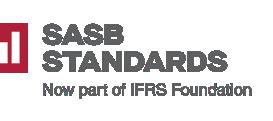
MINERAL RESOURCES LIMITED 2023 SUSTAINABILITY REPORT I 15
30 JUNE 2022
30 JUNE 2021
30 JUNE 2023 FY24 AND BEYOND OUR SUSTAINABILITY APPROACH - (CONTINUED)
OUR VOLUNTARY SUSTAINABILITY INITIATIVES
MinRes is guided by several voluntary sustainability initiatives, memberships, standards and goals. Each year we continue to assess alignment with other emerging frameworks.
Participants guided by the Ten Principles of the UN Global Compact.
Alignment with the UN Sustainable Development Goals.
OUR COMMITMENTS
Reporting in accordance with the GRI Standards.
Enhanced reporting in line with SASB.
Reporting to the Bloomberg Gender Equality Framework.
Aligning climate disclosure with recommendations from the TCFD.
International Sustainability Standards Board (ISSB)
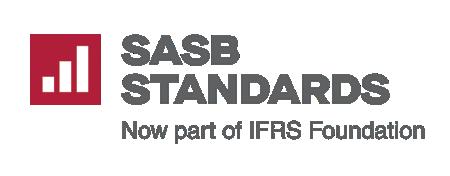
MinRes is committed to reporting in line with the recent release of the ISSB Standards, in accordance with proposed legislative requirements. In preparation, MinRes engaged an external consultant during FY23 to develop a roadmap which highlighted the key areas of focus towards reporting in line with the ISSB Standards. The roadmap includes updating our governance documentation, identifying risks and opportunities, as well as increasing the maturity of our data and systems. The Board has oversight of our approach, with our intention to report in line with the flagship ISSB Standards in FY25.
Initiative for Responsible Mining Assurance (IRMA)
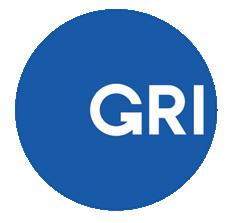
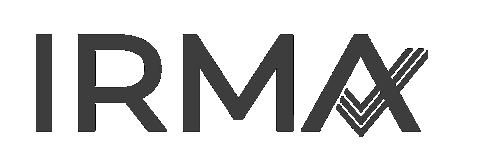
MinRes is committed to responsible mining practices throughout our operations and supply chain. MinRes has begun the self-assessment process against the IRMA Standards for our Wodgina operations. IRMA is widely considered as the international best practice standard for responsible mining. We anticipate the completion of our self-assessment during FY24 with an aim to achieve IRMA verification after an independent third-party audit process.
EXTERNAL AUDITING
During FY23, MinRes engaged in an external responsible mining audit at our Mt Marion operations against the IRMA 30 Critical requirements and the OECD Due Diligence Guidance for Responsible Supply Chains of Minerals from Conflict-Affected and High-Risk Areas. As a result, minor improvements were identified and recorded in a Corrective Action Plan. We are committed to implementing the necessary corrective actions to further enhance our operational performance.
MinRes has engaged EY, an independent external firm, to provide limited assurance over 10 of our sustainability performance indicators. This includes data on our safety performance, greenhouse gas emissions and energy consumption profile, gender diversity, employee training, community contributions, supplier screening and the value generated and distributed. Refer to page 181 of this report for a copy of the Independent Limited Assurance Statement.
OUR SUSTAINABILITY APPROACH - (CONTINUED)
16 I MINERAL RESOURCES LIMITED 2023 SUSTAINABILITY REPORT
OUR ESG PERFORMANCE

We engage with top-tier organisations who assess our Environment, Social and Governance (ESG) performance, such as FTSE Russell, MSCI, Sustainalytics and ISS, based on publicly available information.
MinRes' assessment with all ESG ratings demonstrated consistent improvement or maintenance throughout the year. MinRes achieved recognition for our sustainability commitments, leadership and performance from ISS and Sustainalytics.

OUR AWARDS AND RECOGNITION
Australasian Gold Sustainability Reporting Award


MinRes is proud to have been recognised for overall excellence in sustainability reporting by Australasian Reporting Awards (ARA). In 2023, ARA awarded our 2022 Sustainability Report a Gold Sustainability Reporting Award, identifying the report as providing a full disclosure of material sustainability topics, covering all pertinent legislative and regulatory requirements and as a model report for other organisations to follow.
Skilled Workplace Award
Our commitment to developing mental health first aid skills in our people and embedding an effective mental health program was recognised in September 2022 with an award from Mental Health First Aid Australia, with MinRes acknowledged as a Skilled Workplace. More than 260 MinRes employees have completed a two-day Mental Health First Aid training course delivered by Lifeline WA qualified trainers.

Operational Excellence Award
MinRes' CSI Mining Services team won the Operational Excellence Award at Rio Tinto’s Supplier Recognition Awards gala in 2023. The Operational Excellence award highlights businesses that go above and beyond to tackle obstacles, deliver safely, enhance productivity, and demonstrate industry leading performance. The team was recognised for safe, reliable and consistent delivery of key production tonnes for Rio Tinto’s Brockman and Tom Price iron ore mines. During 2022, CSI provided over 55 million tonnes of mining, crushing, stemming and road train haulage to Rio Tinto, while maintaining an outstanding safety record including ending the year with a Total Recordable Injury Frequency Rate of 0.
Companies rated “AA” and above represent the top 37% of MSCI metals and mining (non-precious metals) coverage universe of 164 companies.
MinRes received a score of 21.5, which represents the 9th percentile of Sustainalytics diversified metals and mining coverage universe of 223 companies.
MinRes obtained an ESG Corporate Rating of C for our performance, which represents the 30th percentile of the mining and integrated production sector.
OUR SUSTAINABILITY APPROACH - (CONTINUED) MINERAL RESOURCES LIMITED 2023 SUSTAINABILITY REPORT I 17
“MY OBLIGATION AND RESPONSIBILITY AS AN ELDER IS TO IMPART KNOWLEDGE TO THE NEXT GENERATION. THAT WAS MY DESTINY.”
Len Collard | Whadjuk Noongar Elder | Perth region, WA

OUR SUSTAINABILITY APPROACH - (CONTINUED)
OUR MATERIAL SUSTAINABILITY TOPICS
To determine the content and strategic objectives for our annual sustainability reporting, MinRes conducts a materiality assessment and review to understand our material sustainability topics. In line with best practice, our materiality assessment applies GRI Principles to determine report content, which is undertaken annually to identify the most critical sustainability issues influencing our ability to create and maintain value in the short, medium and long-term.
IDENTIFYING WHAT MATTERS MOST
To inform the development of our material topics and align as practicable with the concept of double materiality, both internal (inward business impact) and external materiality (outward business impact) were considered.

Our FY23 materiality process was informed by:
• internal stakeholder engagement
• investor roadshows
• third-party investor perception survey
• material issues defined by peer organisations
• mining industry analyses undertaken by prominent advisory firms
• media reviews
• criteria assessed by ESG rating agencies
• SASB - Metals and Mining Sustainability Accounting Standard
• United Nations (UN) Global Compact’s Ten Principles
• UN Sustainable Development Goals (SDGs).
20 I MINERAL RESOURCES LIMITED 2023 SUSTAINABILITY REPORT
OUR APPROACH TO IDENTIFYING, PRIORITISING AND INTEGRATING MATERIAL TOPICS
REVIEW EXISTING MATERIAL THEMES
The annual materiality process commences with a review of the previous year’s analysis. Input from stakeholder engagement and consultations are supported by detailed research and peer review to identify any new material issues that have emerged from recent events. The peer review is further supplemented with responses received from our third-party investor perception survey adding an additional layer of stakeholder insight. Issues are grouped into topics and assessed based on reporting frameworks such as GRI and SASB along with trends reported by the World Economic Forums Global Risks Report, Big Four accounting firms’ mining industry analysis and peer benchmarking.
IDENTIFY INTERNAL STAKEHOLDER VALUES
We conduct an internal survey across our management level and above (including C-suite) within the business. This informs the strategic direction for material areas of focus by ranking existing material topics and identifying risks and opportunities facing the business and the mining industry.
PRIORITISE AND CATEGORISE/CONSOLIDATE
We determine and prioritise material topics according to the significance of their impacts and relevance on both our stakeholders and the business.
3
1 5
Weighting is applied to determine the significance of each material topic with consideration of the severity of potential and actual impacts on governance, social and environmental characteristics. This is determined in accordance with our Enterprise Business Risk Register.
VALIDATE
MATERIAL TOPICS
Material topics are tested with Company subject matter experts and validated by the Sustainability Committee and the Board.
MONITOR, INTEGRATE AND REPORT MATERIAL TOPICS
Our 10 material topics remain consistent with our previous reporting period in FY22. There were minor shifts across all material topics. The updates that were made in FY23 are outlined in our materiality matrix (Figure 1). Targets are then formulated and set against our material topics to produce tangible actions aimed at reducing the risks related to each material topic. We report progress against these targets on a monthly basis to the Board.
2 4
All material topics are considered significant and covered in this report. Our materiality approach will be further refined within the next reporting cycle.
OUR SUSTAINABILITY APPROACH - (CONTINUED) MINERAL RESOURCES LIMITED 2023 SUSTAINABILITY REPORT I 21
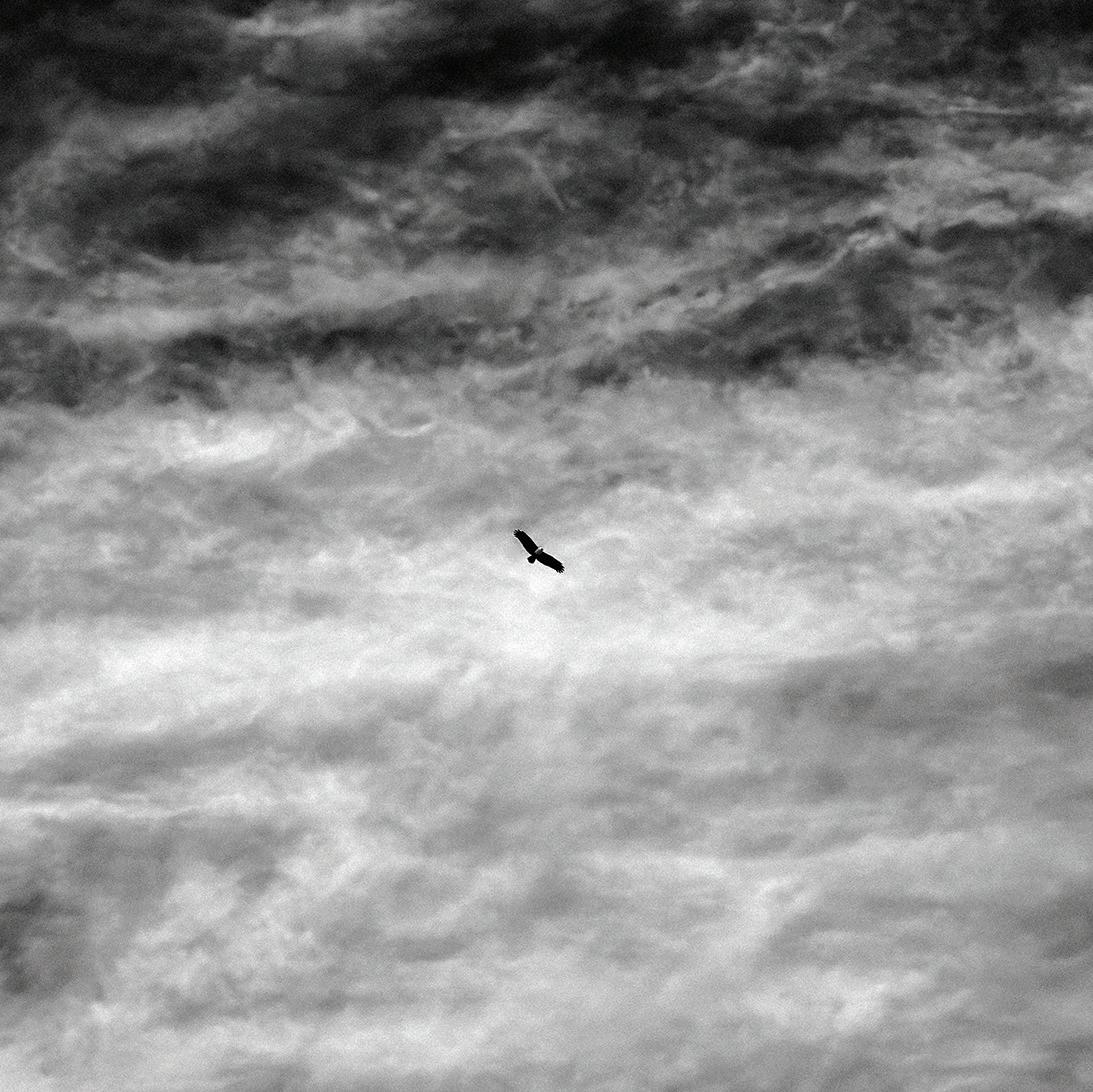

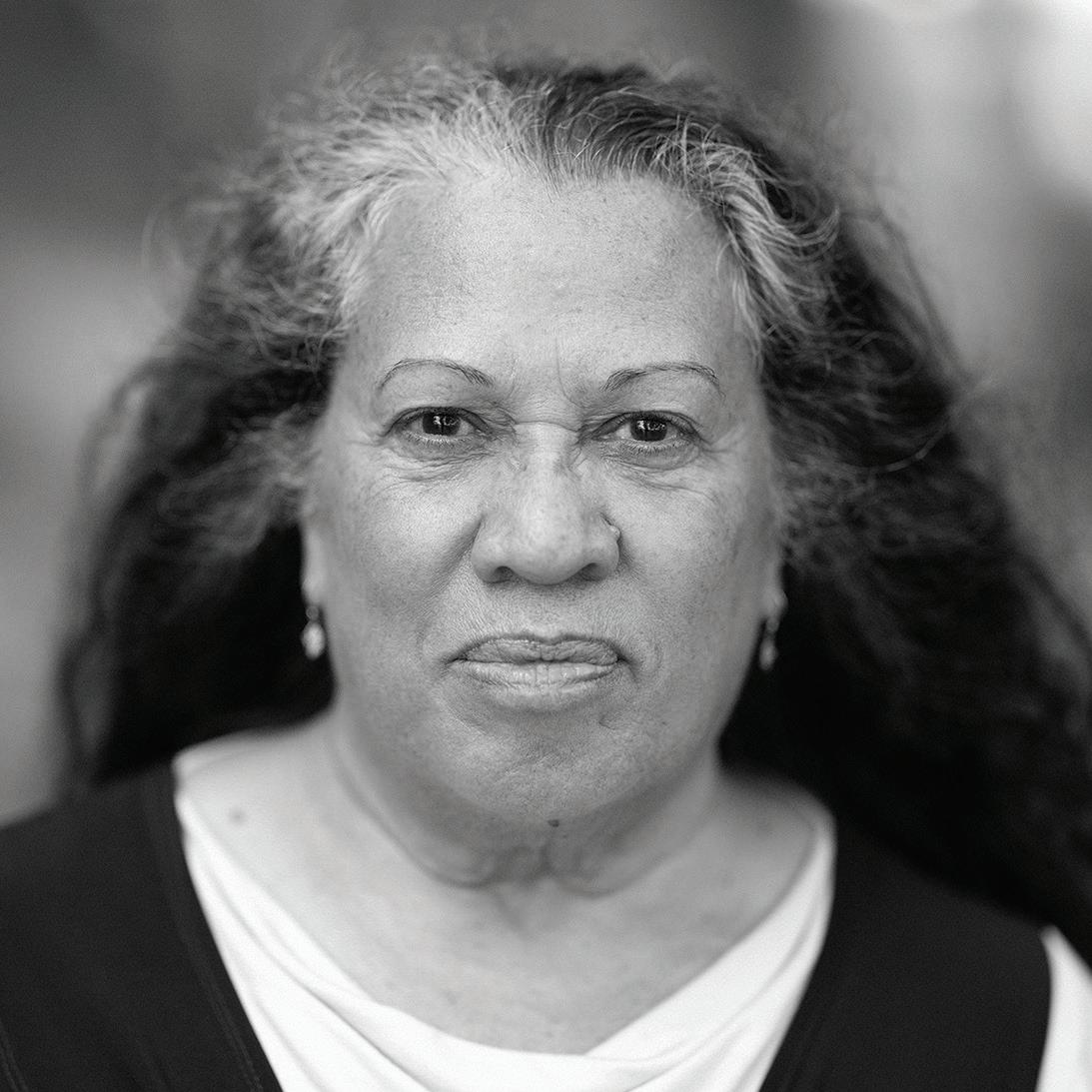
“EVERY ONE OF US IS A LEADER. WE ALL LEAVE THE LEGACY OF OUR LEADERSHIP.
Emeritus Professor Colleen Hayward AM Senior Noongar woman | Perth region, WA
“OVER THE YEARS, MY DESIRE TO UNDERSTAND HOW THINGS WORKED CHANGED TO A DESIRE TO UNDERSTAND HOW PEOPLE WORK AND WHAT DRIVES THEM.”
Joshua Thurlow | Chief Executive Lithium
1 Operating with ethics and integrity.
2 Maintaining a safe working environment that promotes health and wellbeing.
3 Attracting and retaining talent.
4 Developing a diverse and inclusive workplace.
5 Managing our environmental impacts by enhancing water stewardship and natural resource efficiency.
6 Understanding
managing our climate-related obligations, opportunities and risks under a changing climate.
7 Developing and maintaining strong community and stakeholder relationships.
8 Socially, environmentally responsible, transparent and agile supply chain.
9 Economic performance and value creation.
10 Protection of land access and cultural heritage.
OUR SUSTAINABILITY
- (CONTINUED)
APPROACH
and
TO MINRES IMPORTANCE TO EXTERNAL STAKEHOLDERS Medium to High Materiality Very High Materiality No to Low Materiality Medium to High Materiality 10 7 3 8 1 9 5 6 2 4 Climate Change Managing Environmental Impact Responsible Supply Chain Attracting & Retaining Talent Value & Performance Diversity & Inclusion Ethics & Integrity Community & Stakeholder Land Access & Cultural Heritage Safety, Health & Wellbeing Governance Social Environment
IMPORTANCE
24 I MINERAL RESOURCES LIMITED 2023 SUSTAINABILITY REPORT
Figure 1: FY23 materiality matrix
OUR SUSTAINABILITY APPROACH - (CONTINUED)
OUR MATERIAL TOPIC ALIGNMENT
During FY23, MinRes conducted a review of its alignment to the UN SDGs to ensure a targeted approach to those we can directly influence. Out of the 169 UN SDG targets, we identified 21 targets within our sphere of influence. Figure 2 shows our material sustainability topics mapped against the UN SDGs. Our progress against each of these material topics is highlighted against the UN SDG targets, detailed in the SDG Index located in our 2023 Sustainability Performance Data Tables.
Economic Performance & Value Creation
Operating with Ethics & Integrity
Responsible Supply Chains
Health, Safety & Wellbeing
Attracting & Retaining Talent
Diversity & Inclusion
Managing Land Access & Cultural Heritage
Community & Stakeholder Relationships
Managing Environmental Impact
Managing Climate Change
ENVIRONMENTAL SOCIAL GOVERNANCE MINERAL RESOURCES LIMITED 2023 SUSTAINABILITY REPORT I 25
Figure 2: FY23 sustainability framework – material topic alignment to SDGs
OUR STAKEHOLDERS
MinRes recognises the importance of building and maintaining respectful relationships with key stakeholders, with the aim of building mutually beneficial relationships based on trust, respect, and shared economic, social and environmental value creation. Stakeholder engagement is an important mechanism to inform our materiality assessment and understand the broader impact of our business and social licence to operate. MinRes engages with a diverse range of stakeholders to build trusting relationships and drive best business practices. Our stakeholders are identified as individuals, groups or organisations who have a material influence on, or are materially influenced by, MinRes operations and activities.
Table 1 provides an overview of our key stakeholder groups, our engagement mechanisms, and how we manage issues that matter to our stakeholders. Refer to our 2023 Sustainability Performance Data Tables for further information.
Table 1: Stakeholder engagement
Our stakeholders
How we engage
• Internal communications (intranet, weekly newsletters and leadership emails).
• On-site written communications (posters and printed collateral).
• In-person communication (networking events, daily pre-start meetings and team meetings).
How we manage what matters
• Safety Management Framework.
• Code of Conduct and Business Integrity training.
• Employee Assistance Program.
• Health and wellbeing programs.
• Remuneration and rewards, including Employee Share Plan.
• Participation in local events.
• Information sessions and meetings with community members.
• Heritage surveys.
• Meetings with claim groups and Traditional Owners.
• Agreements with Native Title groups.
• Community partnerships, donations and sponsorships.
• Engaging with local Indigenous businesses.
• Notification when applying for new tenements.
• Ongoing briefings and meetings.
• Establishing access agreements.
• Collaboration on impact management and associated initiatives.
• Ongoing liaison with regulators and government agencies.
• Ongoing briefings and meetings.
• Submissions as part of legal and regulatory approval processes.
• Notification when applying for new tenements.
• Regulatory reporting.
OUR SUSTAINABILITY APPROACH - (CONTINUED)
Indigenous Peoples
communities
Local, State and Federal government Other tenement holders/private land holders 26 I MINERAL RESOURCES LIMITED 2023 SUSTAINABILITY REPORT
and local
Employees and contractors
OUR SUSTAINABILITY APPROACH -
Table 1: Stakeholder engagement - (continued)
Our stakeholders
How we engage
How we manage what matters
• Customer visits.
• Timely and transparent communication.
• Quality services and products are provided as per customer agreements.
• Committing to continuous improvement of our practices and processes.
Customers Suppliers
• Meeting at a frequency agreed by both parties.
• Joint venture reporting of financial and operational results.
Joint venture partners
• Ongoing meetings with suppliers.
• Quarterly meetings with critical, high-spend suppliers.
• Supplier assessments and due diligence.
• Engaging on key matters in joint venture partnerships.
• Collaborate to effectively manage operations.
• Use of Coupa supplier software to provide on-demand business intelligence to our Procurement team.
• Sustainable Procurement and Modern Slavery screening program.
• Unions undertake regular visits to MinRes sites.
• MinRes responds to union issues and queries.
• Supplier assessments and due diligence.
• Right of entry access to all sites.
• Employees consulted over major workplace changes.
• Employees provided market comparable remuneration, a high standard of site accommodation and a strong safety framework.
• Attendance at industry association events.
• Participation in industry forums and collaborative projects.
• Research funding.
• Extensive industry association memberships.
• An active member of the Human Rights Resources and Energy Collaborative (HRREc).
• Curtin University partnership.
Finance providers and investors
• Investor roadshows.
• Full year and half year results briefings.
• Annual General Meeting.
• Ongoing meetings and periodic reporting to analysts, financial institutions, ratings agencies, proxy advisors, retail investors and institutional investors.
• Australian Securities Exchange (ASX) announcements.
• Disclosure of Annual Sustainability Report.
• Participation in verification of ESG rating agency requests.
• Engagement with key institutional investors.
(CONTINUED)
Trade unions
MINERAL RESOURCES LIMITED 2023 SUSTAINABILITY REPORT I 27
Industry associations, peers and academia
91% FY22: 89%
employee completion rate of the Code of Conduct and Business Integrity training.
$24 million
FY22: $10 million spent with Indigenous Australian businesses, representing an increase of more than 140 per cent compared to FY22.
Self-Assessment Questionnaires (SAQs) issued to our high-risk suppliers.
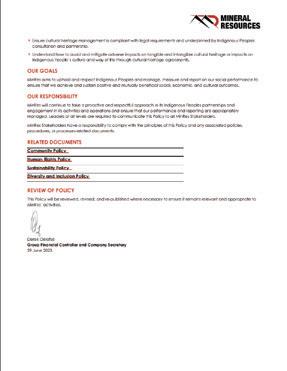
37.5%
FY22: 33.3%
female participation rate on the MinRes Board of Directors.
Released our inaugural Tax Transparency Report as part of the 2023 Annual Reporting suite.
85.1%


FY22: 77.3% spend with Australian suppliers, of which 80 per cent was based in WA.
99.8%
of our active suppliers screened for modern slavery risk.
Two Board appointments during FY23.
15 policies reviewed and updated.
Publicly released our Indigenous Peoples Policy million in revenue.
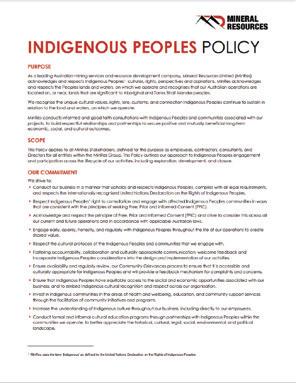
acknowledging the unique culture, rights, lore, customs and connection of Indigenous Peoples.
$4,779
$835M paid to our employees. FY22: $631 million
OUR SUSTAINABILITY APPROACH - (CONTINUED) 28 I MINERAL RESOURCES LIMITED 2023 SUSTAINABILITY REPORT
4,000 3,000 2,000 1,000 FY20 FY21 FY22 FY23 2,125 3,734 3,418
%2 i cn r e a se from FY22
158
($ millions) Taxes & royalties paid FY23 FY22 FY21 Payment to governments Non-government royalties 100 300 500 700
OUR FY23 GOVERNANCE PERFORMANCE
OUR FY23 SOCIAL PERFORMANCE
Opened our in-house health centre
to deliver free and holistic health care for our employees. with increase attributed to a contractor fatality and injury during the period.
Introduced our new Leadership Essentials program
with 92 per cent of those nominated deciding to pursue a formalised qualification.
3.98 High Potential Event Frequency Rate (HiPoFR)
with increase attributed to significant business growth.
Over
9%
of our workforce engaging in professional proactive psychological support services.
271 days
of ethnographic and archaeological surveys across our operations, representing an increase of 62 per cent compared to FY22.
3.5%
Indigenous Australian participation in our workforce, almost double FY22.
22% 0.07 Strategic partnership with Curtin University
to drive innovation in mining and prepare the next generation of talent for future jobs.
2.08
Eliminated all gender pay gaps
for comparable positions within the business.
overall female participation in the workforce.
contributed to communities through our corporate partnerships, sponsorships and social investment programs.
123
charitable organisations supported through our social investment program.
MINERAL RESOURCES LIMITED 2023 SUSTAINABILITY REPORT I 29 OUR SUSTAINABILITY APPROACH - (CONTINUED)
FY22: 1.65 FY22: 0.00 FY22: 7% Total Recordable Injury Frequency Rate (TRIFR) Lost Time Injury Frequency Rate (LTIFR) 3.63 2.31 2.33 FY20 FY21 FY22 FY23
$7.5 million 8 6 4 2 0 FY20 FY21 FY22 FY23 FY20:15% FY21: 17% FY22: 20% FY23: 22% 0% 50%
1,217ha
of land under rehabilitation across our operations.
Scope 1 GHG emissions
Drafted a business-wide Biodiversity Strategy
in alignment with the TNFD, and relevant state, national and international reporting requirements and guidelines.
2.1 megawatt solar battery system
commissioned at our Wonmunna iron ore project in the Pilbara region of WA, which will produce more than 30 per cent of the mine’s power requirements.
>8,000kg $20.1 million
native seed collected across the Pilbara and Yilgarn regions to date.
high-impact environmental incidents were recorded and no fines or prosecutions relating to environmental performance were received.
in line with the Global Industry Standard on Tailings Management (GISTM).
OUR SUSTAINABILITY APPROACH - (CONTINUED) 30 I MINERAL RESOURCES LIMITED 2023 SUSTAINABILITY REPORT
key
Commenced
of Greenhouse Gas Management Plans Gross generation from renewables (MWh) Net energy consumption across all operations FY21 FY22 FY23 5 5.5 million GJ Reviewed our tailings risk ratings increase in total non-mineral waste material across all operations,
hazardous and non-hazardous. at Wodgina, Mt Marion,
Valley and Yilgarn operations. 4.4 FY21 FY22 FY23 Other (18,071 tCO2-e) Energy (1,763 tCO2-e) Lithium (102,697 tCO2-e) Iron Ore (250,930 tCO2-e) Total 373,461 tCO2-e FY22: 337,489
across
operational sites. 13%
development
both
Iron
ZERO Carbon intensity of our operations 2.3 2.5 3.0 FY21 FY22 FY23 Completed water efficiency audits OUR FY23 ENVIRONMENTAL PERFORMANCE invested into emission reduction initiatives. 962 972 733 0 200 400 600 800 1,000 tCO2-e/Total Material Mined

OUR SUSTAINABILITY APPROACH - (CONTINUED)
OUR SUSTAINABILITY PERFORMANCE TARGETS
Our sustainability plan is built around our commitment to drive continuous improvement across all material topics. Throughout FY23, MinRes assessed sustainability performance against our integrated sustainability targets in line with our material topics, with monthly oversight from our Board.
Target met Positive progress Delayed / further focus required
ZERO HARM PERFORMANCE:
Zero fatalities and total permanent disabling injuries/illnesses
Target not met
Zero incidents of bribery and corruption
Table 2: Performance against our FY23 sustainability targets
Material Topic
Ethics and integrity
Responsible supply chain
Safety, health & wellbeing SOCIAL
Zero major social incidents Target
≥ 90 per cent employee completion rate of our Code of Conduct training as at end of year.
Zero major environmental incidents
≥ 90 per cent employee completion rate of our Safe and Respectful Behaviours training as at end of year.
≥ 90 per cent of suppliers screened for modern slavery risks as at end of year.
Result
A refresher e-learning module for the Code was launched during FY23, providing existing employees with a condensed training requirement for annual completion. The target was exceeded with a 91 per cent completion rate on our Code of Conduct training.
Safe and Respectful Behaviour training was delivered to 100 per cent of employees at 30 June 2023, via a combination of in-person training, an e-learning video, Managing Director communications, leadership messages and at pre-start and team meetings.
We completed a risk review of 2,958 (99.8 per cent)1 of our active suppliers, with screening for specific modern slavery risks.
< 4.5 Annual Total Recordable Injury Frequency Rate (TRIFR). Exceeded target: 2.08 TRIFR.
< 4.5 Annual High Potential Event Frequency Rate (HiPoFR). Exceeded target: 3.98 HiPoFR.
> 15,000 Annual Lead Indicator Frequency Rate. Exceeded target: 15,984.
≥ 5 per cent of our workforce engaging in professional proactive psychological support services through either EAP and/or in house consultations.
Ongoing initiatives aimed at increasing awareness resulted in more than 9 per cent of our employees engaging in professional psychological support services.
Performance
GOVERNANCE
Material Topic Target Result
Performance
32 I MINERAL RESOURCES LIMITED 2023 SUSTAINABILITY REPORT
1. External limited assurance is provided over our FY23 suppliers screened. Refer to page 181 for a copy of the Independent Limited Assurance Statement.
10 per cent increase year-on-year female participation of our workforce (excluding construction).
10 per cent increase year-on-year Indigenous Australian representation in full-time employment.
≥ 90 per cent actions completed of our Gender Equity Strategy.
Deliver on all four elements of our Reflect Reconciliation Action Plan across the business.
≥ 90 per cent delivery of planned stakeholder engagements over our projects and operations.
>100 cultural learning and awareness training sessions delivered to full-time employees across owner/operator sites and head office.
Achieved target: 22.6 per cent female representation.
Exceeded target: 3.5 per cent Indigenous Australian representation. This represents a 97 per cent increase from FY22.
Exceeded target: 92 per cent of planned Gender Equity Strategy actions were completed.
All four elements of the Reflect RAP were achieved, highlighting our dedication to reconciliation within the communities we operate in.
Achieved target, with onboarding of Principal Pastoral Engagement Advisor playing a vital role in this success.
Exceeded target: 164 sessions were delivered to employees at our corporate headquarters and various sites, including Wodgina, Koolyanobbing, Iron Valley, Windarling and Carina.
Completion of ≥ 85 per cent of our planned progressive rehabilitation across operations.
In FY23, 63 per cent of planned progressive rehabilitation was achieved. Despite delays, notable advancements were made in refining MinRes' closure knowledge gaps through technical studies and rehabilitation trials.
≥ 90 per cent seed collection against target. Exceeded target: 100 per cent collection of native seeds across the Pilbara and Yilgarn regions.
Development of the MinRes Biodiversity Strategy.
Significant progress was made towards the development of the MinRes Biodiversity Strategy with the onboarding of a Principal of Biodiversity in FY23. The strategy is currently under review and will be implemented in FY24.
OUR SUSTAINABILITY APPROACH - (CONTINUED)
MINERAL RESOURCES LIMITED 2023 SUSTAINABILITY REPORT I 33 Promoting a diverse and inclusive work environment Community & stakeholder relationships Managing land access & cultural heritage SOCIAL
Table 2: Performance against our FY23 sustainability targets - continued
Target Performance Result Material Topic
environmental impact Target Performance Result Material Topic
ENVIRONMENT Managing
Table
ENVIRONMENT
Target Performance Result Material Topic
Phased implementation of the business waste management strategy.
Managing environmental impact
Completion of onsite water efficiency audits across operations.
Managing climate change
Net zero operational emissions by 2050.
50 per cent absolute reduction in operational emissions on existing operations by 2035 from baseline FY221
Efforts are underway to conduct waste audits across multiple operational sites in alignment with the MinRes Waste Strategy. The initial audit was conducted at the Wodgina Lithium Project in FY23 with improvement actions being implemented. To improve waste data capture and reporting, we have implemented enhancements in our tools. Furthermore, MinRes have collaborated with local and Indigenous service providers to support our operational sites.
We have made positive progress toward the target of conducting on-site water efficiency audits. Audits have been completed at Wodgina and Mt Marion. Efforts are ongoing at the remaining iron ore sites and will be finalised in FY24.
At the C-suite and Board level, there has been notable progress in enhancing overall awareness of climate change. As a direct result, there has been approval for allocating additional resources and budget to facilitate the accomplishment of the business’ emissions reduction targets.
1. Based on FY22 operational emissions (scope 1 & scope 2), 321,744 tCO2-e and includes all existing operations under MinRes operational control as of 30 June 2022, including the Pilbara Hub (Wonmunna, Iron Valley), Yilgarn Hub (Koolyanobbing, Parker Range and Carina operations) and Mt Marion in alignment with our Roadmap to Net Zero Emissions in pursuit of a 1.5°C pathway. The baseline will be adjusted when structural changes occur in the company that change the facility boundary (such as acquisitions or divestments).
OUR SUSTAINABILITY
(CONTINUED)
APPROACH -
34 I MINERAL RESOURCES LIMITED 2023 SUSTAINABILITY REPORT
2: Performance against our FY23 sustainability targets - continued
OUR FY24 TARGETS
Board-approved sustainability performance targets have been set to address each of our material sustainability topics and form the basis of our FY24 Sustainability Plan. To develop these targets, we considered our material sustainability risks and global challenges – with a focus on those defined by the UN SDGs and UN Global Compact Ten Principles, as well as the Paris Agreement. In FY24, MinRes will target:
Zero fatalities and total permanent disabling injuries/illnesses
Zero incidents of bribery and corruption
RESPONSIBLE SUPPLY CHAIN
≥ 90 per cent of suppliers screened for social criteria1 risks as at end of year.
DIVERSITY & INCLUSION
10 per cent increase year-on-year female participation of our workforce (excluding construction).
Achieve 4 per cent Indigenous Australian participation of our workforce (excluding construction) as at the end of FY24.
Zero major social incidents
Zero major environmental incidents
CULTURAL HERITAGE
Implement updated land permit system.
CLIMATE CHANGE
Net zero operational emissions by 2050.
50 per cent absolute reduction in operational emissions on existing operations by 2035 from baseline FY222
ENVIRONMENT
≥ 90 per cent actions progressed in our Biodiversity Action Plan (that are relevant to this FY).
Develop an implementation plan to meet the Global Industry Standard on Tailings Management (GISTM).
Develop Water Management Plans across all operational sites.
SOCIAL & COMMUNITY
≥ 140 cultural learning and awareness training sessions delivered across all MinRes owner/operator sites.
ETHICS AND INTEGRITY
≥ 90 per cent employee completion rate of our Business Code of Conduct and Integrity training as at end of year.
≥ 90 per cent employee completion rate of our Safe and Respectful Behaviours training as at end of year.
SAFETY, HEALTH & WELLBEING
< 4.5 Annual Total Recordable Injury Frequency Rate (TRIFR).
100 per cent completion of critical risk inspections against business unit target3
All sites to identify, define and initiate all actions within 20 days of investigation completion related to Significant and High Potential Events.
1. Suppliers are screened against a number of social criteria to determine potential exposure to criminal activities and regulatory violations, including but not limited to, conflict and humanitarian crises, bribery and corruption, sanctions, money laundering, politically exposed persons, human rights abuses and modern slavery incidents by third-party platform.
2. Based on FY22 operational emissions (scope 1 & scope 2), 321,744 tCO2-e and includes all existing operations under MinRes operational control as of 30 June 2022, including the Pilbara Hub (Wonmunna, Iron Valley), Yilgarn Hub (Koolyanobbing, Parker Range and Carina operations) and Mt Marion in alignment with our Roadmap to Net Zero Emissions in pursuit of a 1.5°C pathway. The baseline will be adjusted when structural changes occur in the company that change the facility boundary (such as acquisitions or divestments).
3. Business unit relating to each pillar – Mining Services, Lithium, Iron Ore and Energy.
(CONTINUED) MINERAL RESOURCES LIMITED 2023 SUSTAINABILITY REPORT I 35
OUR SUSTAINABILITY APPROACH -

MINERAL RESOURCES LIMITED 2023 SUSTAINABILITY REPORT I 37 GOVERNANCE UN GLOBAL COMPACT PRINCIPLES SUSTAINABLE DEVELOPMENT GOALS ANTI-CORRUPTION LABOUR HUMAN RIGHTS OPERATING WITH ETHICS AND INTEGRITY PAGE 44 - 50
ECONOMIC PERFORMANCE AND VALUE CREATION PAGE 52 - 56
MINERAL RESOURCES LIMITED 2023 SUSTAINABILITY REPORT I 37 12 RESPONSIBLE CONSUMPTION & PRODUCTION
RESPONSIBLE SUPPLY CHAINS PAGE 58 - 64
GOVERNANCE - (CONTINUED) GOVERNANCE
As a Western Australian based Company, MinRes operations are governed by Federal and State government legislation, which promotes fair-trading and competition while protecting the environment and the community. Australia has built a reputation as a world leader in sustainable mining with a long history of implementing strong safety and environmental regulations while adopting best practice voluntary international codes, frameworks and standards. This has set the foundation for a resilient and stable economy with strong governance practices, which provide a predictable and low-risk business environment.
Our corporate governance practices, which set the rules, relationships, systems, and processes by which MinRes is directed and controlled, are core to our stable operating environment. Our governance supports us to actively and effectively manage our exposure to governance risks and opportunities. Good corporate governance also supports our performance and promotes investor confidence.
Refer to the MinRes 2023 Corporate Governance Statement, which reports on our core governance principles and practices in line with the ASX Corporate Governance Council’s Corporate Governance Principles and Recommendations (4th edition) throughout the reporting period.
We recognise the importance of good corporate governance practices in driving sustainable, responsible and ethical business practices. Our corporate governance framework (Figure 3) provides the structure for effective oversight and accountability, with the integrated approach of incorporating stakeholder perspectives in our management and decision-making processes long-term.
CORPORATE GOVERNANCE FRAMEWORK
SUSTAINABILITY COMMITTEE
EMPLOYEES & CONTRACTORS
BOARD OF DIRECTORS
REMUNERATION & PEOPLE COMMITTEE
NOMINATION COMMITTEE
AUDIT & RISK COMMITTEE
EXECUTIVE LEADERSHIP TEAM
Review governance processes | Set strategic sustainability and climate-related direction Oversee sustainability performance tracking | Agree to priorities and actions
LOCAL COMMUNITIES & LAND HOLDERS
GOVERNMENT & REGULATORS
BUSINESS PARTNERS & INVESTORS INDUSTRY ASSOCIATIONS
TRADE UNIONS
SUPPORTING SUSTAINABILITY LEADERSHIP GROUPS
ENTERPRISE RISK WORKING GROUP
DECARBONISATION WORKING GROUP
RECONCILIATION WORKING GROUP
DIVERSITY & INCLUSION STEERING COMMITTEE
OUR VISION, PURPOSE & VALUES STAKEHOLDER ENGAGEMENT
VALUE CHAIN OPERATIONS
GENDER EQUITY WORKING GROUP
HUMAN RIGHTS WORKING GROUP
MINE CLOSURE STEERING COMMITTEE
WATER WORKING GROUP
RESOURCES & RESERVES STEERING COMMITTEE
Our operating mines and mining services have on-ground subject matter expertise to implement and monitor sustainability strategy, define and review site level targets to drive performance.
Figure 3: Sustainability governance framework
38 I MINERAL RESOURCES LIMITED 2023 SUSTAINABILITY REPORT
GOVERNANCE - (CONTINUED) OUR BOARD
The MinRes Board is responsible for providing oversight and accountability of the Company’s strategic direction and sustainability performance. The Board represents shareholders, promotes and protects the interests of the Company, and works to build sustainable value for our shareholders. The Board discharges this responsibility by having regard for the interests of all relevant stakeholders.



As defined by the Board Charter, the Board also has a specific responsibility to oversee the management of sustainability by considering the social, ethical, and environmental impact of the Company’s operations, approving policies and monitoring compliance with the Company’s sustainability policies and practices. Refer to the 2023 Sustainability Performance Data Tables for further details on MinRes policies.
The Board monitors key risk indicators and the Company’s risk profile including any emerging risks, while taking necessary actions to address significant risks and protect the Company’s interests.
We are committed to fostering and promoting board diversity as an integral component of good corporate governance practice. We recognise that a diverse board strengthens our decision-making processes, drives innovation and enhances long-term value creation. The composition of our Board reflects a diversity of skills, experience, expertise and gender. We are committed to ensuring we maintain at least 30 per cent female participation on the Board. Refer to Diversity in Leadership for further information on our Board diversity.
During FY23, MinRes further strengthened its Board through the appointment of Emeritus Professor Colleen Hayward AM and Justin Langer AM, both as Independent Non-Executive Directors.







APPOINTMENT: 2006
APPOINTMENT: 2015

APPOINTMENT: 2021
APPOINTMENT: 2023
2022
APPOINTMENT: 2017
For further information on the Board visit our website
APPOINTMENT: 2010

APPOINTMENT: 2023

MINERAL RESOURCES LIMITED 2023 SUSTAINABILITY REPORT I 39
Chris Ellison Managing Director
Colleen Hayward Independent Non-Executive Director
Susie Corlett Independent Non-Executive Director
James McClements Independent Non-Executive Chairman
Justin Langer Independent Non-Executive Director
Kelvin Flynn Independent Non-Executive Director
Xi Xi Independent Non-Executive Director
Zimi Meka Independent Non-Executive Director APPOINTMENT:
OUR COMMITTEES
The Board has four established sub-committees which operate on a recommendation basis.
THE SUSTAINABILITY COMMITTEE
This Committee assists the Board in fulfilling its responsibilities overseeing the Company’s material sustainability related matters including, but not limited to:
• occupational health, wellbeing and safety
• labour practices and human rights, including modern slavery
• diversity and inclusion
• community development and engagement, including engagement with Indigenous Australians, reconciliation initiatives and relationships with the communities in which we operate
• protection of cultural heritage
• responsible supply chain management
• environmental stewardship including the management of water resources, biodiversity, waste, air quality, land reclamation and closure and tailings facility management
• climate change.
The Sustainability Committee was strengthened in FY23 with the appointment of Emeritus Professor Colleen Hayward AM and Justin Langer AM.
Colleen brings over 35 years of experience developing and leading programs to support and empower Indigenous Australians in Western Australia. Her skills and experience have strengthened our Sustainability Committee through her insights into our approaches to cultural heritage, Traditional Owner partnerships and community engagement.
Justin brings considerable leadership experience and a proven ability to build resilient and successful teams which will further enhance our focus on people and culture. This plays a critical role in
growing an engaged workforce and executing our growth strategy. Refer to the Sustainability Committee Charter for further information.
THE REMUNERATION AND PEOPLE COMMITTEE
This Committee provides assistance and recommendations to the Board in fulfilling its responsibilities to oversee the overall remuneration strategy of the Company and its specific application to the Managing Director, Key Management Personnel and NonExecutive Directors. The Remuneration and People Committee also reviews and makes recommendations to the Board on diversity within the Company, measurable objectives for achieving diversity and progress against such objectives.
Refer to the Remuneration and People Committee Charter for further information.
THE NOMINATION COMMITTEE
This Committee provides assistance and recommendations to the Board to ensure the best possible Directors are selected, appointed to the Board and retained. It also assists with providing advice on the appointment and succession of the Managing Director.
Refer to the Nomination Committee Charter for further information.
THE AUDIT AND RISK COMMITTEE
This Committee assists the Board in fulfilling its responsibilities in providing oversight to accounting and reporting practices, risk identification and management, internal and external audit functions, treasury and capital management practices, taxation practices and compliance with applicable legal and regulatory requirements.
Refer to the Audit and Risk Committee Charter for further information.
The Charters for the Board, Sustainability Committee, Remuneration and People Committee, Nomination Committee and Audit and Risk Committee were reviewed by the Board and have been updated within the last 18 months.
All MinRes sub-committees meet the ASX composition requirements, including: Composition requirements
Minimum three members
Majority Independent Non-Executive Directors
Chaired by Independent Non-Executive Director Charter is publicly available
GOVERNANCE - (CONTINUED)
40 I MINERAL RESOURCES LIMITED 2023 SUSTAINABILITY REPORT
Sustainability
Remuneration
Nomination Committee
Committee
and People Committee
Audit and Risk Committee

No change Retired from the Committee FY23 Joined the Committee FY23 Chair
MinRes has several sustainability leadership groups that support the advancement of sustainability within the business, underpinning the efforts of the Executive Leadership team by translating their vision and strategies into actionable plans. These leadership groups span topics from risk management, diversity and inclusion, gender equity, reconciliation, decarbonisation, human rights, water and mine closure. They consist of subject matter experts across various disciplines, serving as a platform to share best practice and lessons learned. In addition, they ensure decisions are well-informed and supported by a range of stakeholders within the business.
GOVERNANCE - (CONTINUED)
42 I MINERAL RESOURCES LIMITED 2023 SUSTAINABILITY REPORT
Member Board Audit and Risk Commitee Nomination Committee Remuneration and People Committee Sustainability Committee
Chris Ellison
James McClements
Susie Corlett
Kelvin Flynn Xi Xi
Zimi Meka
Colleen Hayward
Justin Langer
1. Xi Xi retired as Chair of the Nomination Committee as of 31 March 2023 with James McClements becoming Chair as of 1 April 2023. Xi Xi remains a member of the Nomination Committee.
2. Changes as of 1 January 2023.
3. Changes as of 1 April 2023.
3 3 3 3 1 3 2, 4 3 1 2 3 3 2 3 3 2 3 3 3
4. James McClements retired as Chair of the Remuneration and People Committee on 1 January 2023, retaining his position on the Committee.
Table 3: Governance appointment matrix
Table 3 provides an overview of the Directors appointed to the Board and each sub-committee.
EXECUTIVE LEADERSHIP TEAM

The MinRes Executive Leadership team are responsible for the day-to-day integration and management of sustainability-related matters across all our operations, in line with our strategic objectives. They are tasked with the review of governance processes, tracking performance against key objectives, developing and implementing sustainability and climate strategies, monitoring sustainability management systems and determining business priorities and appropriate actions.
For further information on the Executive Leadership team visit our website





BUSINESS CONTINUITY MANAGEMENT
Business Continuity Management (BCM) provides a framework for building and enhancing organisational resilience and effective response mechanisms that allow for the safeguarding of business value, reputation, brand, key investors and stakeholder interests. MinRes is committed to continually improving our approach to BCM, strengthening and maintaining our BCM and enhancing our overall organisational resilience to business disruption.
In FY23, MinRes continued to work with external consultants to build out our BCM framework and advance our BCM maturity, including documenting Business Interruption Assessments for critical business functions and implementing a governance structure to support the ongoing maintenance of the BCM framework.
GOVERNANCE - (CONTINUED)
MINERAL RESOURCES LIMITED 2023 SUSTAINABILITY REPORT I 43
Mike Grey Chief Executive Mining Services
Joshua Thurlow Chief Executive Lithium
Chris Soccio Chief Executive Iron Ore
Darren Hardy Chief Executive Energy
Chris Ellison Managing Director
Mark Wilson Chief Financial Officer and Company Secretary
WE ARE COMMITTED TO OPERATING ETHICALLY AND WITH INTEGRITY IN ALL BUSINESS ACTIVITIES AND STAKEHOLDER RELATIONSHIPS.
MATERIAL TOPIC: OPERATING WITH ETHICS AND INTEGRITY
MinRes believes consistent and proper business conduct creates loyalty and trust with our stakeholders and we are committed to promoting a culture of ethical corporate behaviour.
We expect our employees to learn and comply with all Company policies, applicable laws, and the principles outlined in our Code of Conduct and Business Integrity (the Code). We work continuously to improve our practices through internal and external review and assessments, while having procedures and processes in place to take immediate action when we identify conduct that breaches or falls below our standards. In addition, we have high expectations of our supply chain as evidenced in our Supplier Code of Conduct
Our policies and commitments provide the framework which guides sustainable business practice and embeds our Company vision, values and purpose. Our sustainability-related policies include the below.
• Anti-Bribery and Corruption Policy
• Climate Change Policy*
• Code of Conduct and Business Integrity
• Community Policy*
• Diversity and Inclusion Policy
• Environment Policy*
• Gendered Violence Position Statement*
• Health and Safety Policy
• Human Rights Policy*
• Indigenous Peoples Policy*
• Responsible Production Policy*
• Sustainability Policy*
• Supplier Code of Conduct*
• Tailings Storage Facility Policy*
• Whistleblower Policy*
• Whistleblower Procedure*
All policies are regularly reviewed to ensure their ongoing effectiveness.
During FY23, 15 policies were reviewed and updated, of which 12 were sustainability-related1
CODE OF CONDUCT AND BUSINESS INTEGRITY
The Code defines the way we do business, which is based on our values and represents our commitment to upholding the highest standards of ethics in our business practices. This key business document outlines our expectation that all employees and contractors behave with fairness, honesty and respect towards others.
1. Policies denoted with an asterix (*) were reviewed and updated during FY23.
733 MWh of renewable energy generated during FY23 Operations
Solar-battery system installed and commissioned at Wonmunna
Piloted hydrogen injection system on road haulage fleet at our Yilgarn Iron Ore
Released our inaugural Tax Transparency Report 91 per cent completion of Code of Conduct training across our workforce 15 policies reviewed and updated
FY23 HIGHLIGHTS
GRI Indicators 3-3 | 419-9 | G4-S08 SDG Targets 12.6 SASB Index EM-MM-510a.2 44 I MINERAL RESOURCES LIMITED 2023 SUSTAINABILITY REPORT
ETHICS AND INTEGRITY
Prior to commencing employment with MinRes, all employees are required to complete training on the Code, as well as undertaking refresher training each year to ensure they understand their requirements.
The Code covers a range of aspects including, but not limited to, MinRes values, the types of behaviours that are deemed unacceptable, the ways in which we work with our communities, how to operate with integrity and appropriately represent the Company, as well as the consequences of breaching the Code and where employees can seek assistance.
MinRes prohibits any form of punishment, disciplinary or retaliatory action against anyone for raising or helping to address a business conduct concern. Failure to comply with the Code is a serious matter that may lead to disciplinary action, including dismissal and/or legal action. On a monthly basis our Board has oversight of Code breaches. Information provided is de-identified and provides complainant type, detail, actions and resolutions.
During FY23, our refresher e-learning package on the Code was updated, widely communicated and implemented throughout the business with 91 per cent of our employees completing the training2, as illustrated in Figure 4.
Our senior leadership team is focused on:
• ensuring strong leadership, governance and education on safe and respectful workplace behaviour
• promoting positive workplace relationships that are built on respect
• creating a culture and work environment that supports people from all backgrounds and life experiences
• listening to and learning from the experiences of our people.
We expect all our people to:
• treat each other with respect and ensure their behaviours are aligned with our values
• show up for their colleagues, stand up to unacceptable behaviour, speak up to address situations and, if required, listen to and learn from the experiences of others.
WHISTLEBLOWING PROVISIONS
The Whistleblower Policy, and its supporting Whistleblower Procedure, outlines the various ways stakeholders can report matters they genuinely believe are in breach of the Code or are illegal. To better ensure whistleblowers feel safe to come forward, a whistleblower will qualify for protection even if their disclosure turns out to be incorrect or if they make the disclosure anonymously.
Reportable conduct may include any conduct that involves:
• actions that are dishonest, fraudulent or corrupt, including bribery or other activity in breach of the bribery and corruption provisions of the Code
• illegal activity such as theft, violence, harassment or intimidation, criminal damage to property or other breaches of State or Federal law
• unethical behaviour or behaviour in breach of MinRes policies, such as dishonestly altering company records or data, adopting questionable accounting practices or wilfully breaching the Code or other Company policies or procedures
• potential damage to stakeholders such as unsafe work practices, environmental damage, health risks or abuse of MinRes’ property or resources
• abuse of authority or conflict of interest
DISCRIMINATION, BULLYING AND HARASSMENT
MinRes' stance is that any form of harassment, assault or bullying is completely unacceptable and has no place in any setting, including our workplace.
• financial loss to MinRes, damage to MinRes' reputation or any other issue that may be detrimental to MinRes' interests
• sexual harassment, harassment, coercion, discrimination, victimisation or bullying
• any other kind of misconduct, observation or perception of an issue that may impact MinRes in any of the areas outlined above
• engaging in or threatening to engage in detrimental conduct against a whistleblower.
GOVERNANCE - (CONTINUED)
FY23 FY22 91% 89% 11% 9% Competent Not-competent
MINERAL RESOURCES LIMITED 2023 SUSTAINABILITY REPORT I 45
Figure 4: FY23 Code of Conduct competency
2. External limited assurance is provided over our FY23 Code of Conduct completion rate. Refer to page 181 for a copy of the Independent Limited Assurance Statement.
A human rights breach of obligations to respect, protect and fulfil human rights, including but not limited to directly ‘causing’, ‘contributing’ or being ‘directly linked’ to modern slavery risks or impacts are treated under the whistleblower process as if reported by a MinRes stakeholder.
MinRes ensures continued accessibility to our independent external whistleblowing service, MinRes Integrity Assist, which is widely communicated to employees and contractors.
Email: minresintegrity@deloitte.com.au
Phone: 1800 951 300
Fax: +61 3 9691 8182
Website: www.minresintegrity.deloitte.com.au
Mail: MinRes Integrity Assist Reply paid 12628 A’Beckett Street Melbourne VIC 8006.
MinRes promotes the whistleblower platform through our Code of Conduct training, Safe and Respectful Behaviours training, intranet and leadership messaging.
The number of cases received through MinRes Integrity Assist are categorised based on the reporter’s claim. Of the reports received during FY23:
• nine per cent were substantiated cases relating to bullying and health and safety breaches
• 74 per cent were not able to be fully substantiated. Of these, 56 per cent were anonymous cases unable to be substantiated due to insufficient data to support investigations from the report
• 16 per cent remain open and still under investigation as at end of FY23.
MinRes maintains a secondary internal reporting mechanism, allowing employees to raise and seek resolution to disputes or grievances regarding sexual harassment, bullying, workplace discrimination, aggression, and other related matters. Through this mechanism, reports are subject to internal investigations, with the aim of achieving appropriate and fair resolutions.
Of the reports received internally during FY23:
• 21 per cent related to psychosocial incidents, of which four per cent related to claims of sexual harassment
• 61 per cent related to reports of health, safety and environmental breaches
• 18 per cent of the remaining cases related to instances of Code of Conduct breaches, absenteeism, and serious misconduct.
Of all reported cases in FY23, resolutions included written warning (43 per cent), counselling (30 per cent), termination/resignation (19 per cent), education and training (two per cent), with four per cent of cases ongoing and three per cent not able to be substantiated.
MinRes is committed to creating a safe reporting culture and ensuring that people who raise reports and complaints are well supported. Inappropriate behaviour and conduct can be reported through both internal and external reporting channels.
We are actively encouraging the reporting of incidents and have recorded an increase in reports following our Safe and Respectful Behaviours training and awareness campaign, as well as our Psychosocial Hazard Awareness training. We will continue to reinforce this messaging and measure our trends in reporting rates, types of reports and feedback through the anonymous Your Voice culture surveys.
GOVERNANCE - (CONTINUED) 46 I MINERAL RESOURCES LIMITED 2023 SUSTAINABILITY REPORT
Breakdown of the nature of psychosocial cases reported MinRes Integrity Assist and Internal Grievance Mechanism cases 3% 1% 2% 23% 13% 58% 2% 4% 1% 1% 6% 14% 48% 24% Aggression Discrimination Inappropriate Language Racial Harassment Bullying Harassment Microaggression Sexual Harassment Code of Conduct Health, Safety and Environment Performance and Attendance Psychosocial Serious Misconduct Other
Figure 5: Number of whistleblower cases per category received in FY23 and a breakout of the number of psychosocial cases per category

ANTI-BRIBERY AND CORRUPTION POLICY
Bribery and corruption adversely affect the business environment by undermining legitimate business activities. As part of MinRes’ commitment to operating ethically and with integrity in all business activities and stakeholder relationships, we have an Anti-Bribery and Corruption Policy. This Policy outlines our expectations in not tolerating bribery or corruption, or any actions that constitute fraud, and encourages employees to speak up and report any concerns internally and/or externally, including through our external whistleblower hotline, MinRes Integrity Assist.
HUMAN RIGHTS POLICY
MinRes seeks to build mutually beneficial relationships and respects the rights of our employees, contractors, members of our local communities and other stakeholders directly impacted by our operations. We prohibit the use of forced labour which includes child labour, slave labour and human trafficking.
Our Human Rights Policy outlines our commitment and joint responsibility to ensure our business activities respect the rights and dignity of all people. All employees, contractors, suppliers and other relevant stakeholders are required to comply with the principles outlined in this Policy and are encouraged to report any breaches of this Policy through our internal and external whistleblower mechanisms.
RISK MANAGEMENT
MinRes’ Enterprise Risk Management Policy outlines our expectations with regards to the formal management of risk, which includes:
• identifying, assessing, monitoring and reporting risks to provide management and the Board with the assurance that risks are being effectively identified and managed
• consistently apply risk management processes across all stakeholder engagement
• foster leadership and promote a good risk culture through proper engagement, information sharing and training across the business
• implement processes for crisis management and business continuity planning that enable us to effectively respond to material risk events
• assure effectiveness of systems and controls through appropriate assurance mechanisms.
MinRes is continuously improving how ESG risks are incorporated into the Group risk management framework, policies, and processes. Whilst MinRes has focused on certain material sustainability issues that represent common themes that internal and external stakeholders are currently concerned, Group strategy encompasses a broad range of issues that are managed through an ongoing process. Refer to page 76 in our 2023 Annual Report. This process is supported by ongoing work to embed the use of a centralised online risk management platform into day-to-day decision making and to refine processes and tools for managing risk. MinRes' risk management platform effectively integrates strategic and operational level reporting, with the software providing both desktop and mobile user accessibility. This improves efficiency and allows for real-time data collection and analysis.
During FY23, our Risk Working Group conducted multiple workshops attended by subject matter experts from across the business.
Each business unit tracks and monitors their risks via risk registers on an ongoing basis. A consolidated business risk register is used to maintain enterprise-wide risks and is reviewed and reported to the Audit and Risk Committee on a quarterly basis. Following review by the Audit and Risk Committee, High and Very High risks are then reported to the Board on a quarterly basis.
The Business Risk Register considers all strategic, operational, compliance, regulatory and financial risks impacting MinRes. Our sustainability and climate-related risks are also incorporated into the Business Risk Register. Risk workshops are conducted across the business to encourage awareness and ensure sustainability issues are integrated appropriately into day-to-day operations.
Understanding MinRes' risks, and managing these risks appropriately, will enhance our ability to successfully deliver on objectives and provide greater certainty and confidence for shareholders, employees, customers and suppliers, and the communities in which we operate.
Our approach to Enterprise Risk Management (ERM) is aligned to ISO31000:2018. Refer to Figure 6, which demonstrates how our ERM manages and mitigates risks including sustainability risks and tracking our sustainability performance.
GOVERNANCE - (CONTINUED) 48 I MINERAL RESOURCES LIMITED 2023 SUSTAINABILITY REPORT
The ‘Four T’s’ model was applied during our risk management review to support the formulation of our risk management strategy as outlined in Figure 7.
The MinRes Information Technology team has adopted a riskbased security approach using the Australian Government’s Australian Signals Directorate Top 37 security framework. This ensures the framework includes controls and standards which are periodically tested by independent parties.
The measures we have in place to protect our business against cybersecurity risks include:
• a security plan which sets out the policies and operational guidelines for a proactive defensive security environment
• active monitoring and blocking of malicious external and internal attacks
• regular cybersecurity risk assessments to ensure new technology is appraised for security risks before implementation
• encryption of laptops and mobile devices to ensure that information is inaccessible when these devices are lost or stolen
• disaster recovery plans
• incident response plans and playbooks.
PRIVACY
MinRes has set out its approach to compliance with the Australian Privacy Principles in its Privacy Policy, published on the Company’s website.
In FY23, we took the opportunity to review and strengthen our privacy framework in light of the legislative reforms announced by the Australian Government in February 2023 to ensure that MinRes can comply with the enhanced requirements once the legislation is enacted in FY24.
BUSINESS ETHICS RISK
MinRes has developed a set of core policies, procedures and internal controls to assist the Group in complying with our legal and regulatory obligations and aims to meet the highest standards of corporate conduct. The Code, Anti-Bribery and Corruption and Whistleblower policies describe Group shared values and set out the standards of behaviour expected.
CYBERSECURITY RISK MANAGEMENT
Widespread cybercrime and cyber insecurity rated the eighth top risk in the World Economic Forum’s 2023 Global Risks Report across both two-year and 10-year time horizons.
Like many large businesses, MinRes faces the ever-evolving threat of cyberattacks as they become more sophisticated in attempting to disrupt business services, steal or destroy valuable data and hold business systems to ransom.
As described in Whistleblowing Provisions, MinRes' Whistleblower Policy and Procedure aim to promote a workplace in which people feel safe, supported and encouraged to speak up about improper conduct. MinRes takes whistleblower reports of misconduct very seriously and investigates all incidents. MinRes is committed to taking action to address substantiated issues, including discipline, training and implementation of enhanced policies and controls.
The Audit and Risk Committee are informed of all material misconduct breaches, with 18 instances of serious misconduct reported in FY23.
GOVERNANCE - (CONTINUED) Communication and consultation Monitoring and review
RISK IDENTIFICATION
RISK ANALYSIS
RISK EVALUATION
RISK TREATMENT
ESTABLISHING THE CONTEXT
(2)
(3)
(4)
(5)
(1)
Figure 6: Enterprise risk management framework
1 2 4 3 TERMINATE Eliminate the risk by removing the cause of the risk. TRANSFER Seek another party to take responsibility for the risk with increased capacity for mitigation and management. TOLERATE Do not take any additional action unless the risk occurs. TREAT Reduce the likelihood or consequence/impact of the risk event. MINERAL RESOURCES LIMITED 2023 SUSTAINABILITY REPORT I 49
Figure 7: The Four T’s model for determining a risk treatment strategy
SECURITY FORCE RISK
MinRes is committed to ensuring that security management at all operations is conducted in line with the protection of human rights while providing protection to employees, contractors, equipment and facilities. To decrease risk, at all MinRes operations, we contract private security providers and ensure they operate consistently with the Voluntary Principles on Security and Human Rights (VPSHR). The VPSHR guides providers to uphold human rights, protect the safety and dignity of individuals, and maintain responsible security practices.
SANCTIONS RISK
MinRes is committed to ensuring that our supply chains are managed in accordance with all regulatory requirements and ethical responsibilities. The Group has implemented a risk-based compliance framework based upon sanctions laws and regulatory guidance from Australia, the United Nations and, as applicable, other jurisdictions in which MinRes may operate.
Key aspects of MinRes’ sanctions framework include:
• due diligence processes to identify and assess sanctions risk, with enhanced due diligence protocols applied in incidences where a higher sanctions risk is identified
• initial, ongoing, and ad hoc sanctions screening conducted in relation to all suppliers
• commitment to exercise due care in any transaction with an individual or entity that is owned or controlled by, or acting on behalf of, persons or entities that are ‘designated’ under sanctions laws.
GOVERNANCE - (CONTINUED) 50 I MINERAL RESOURCES LIMITED 2023 SUSTAINABILITY REPORT
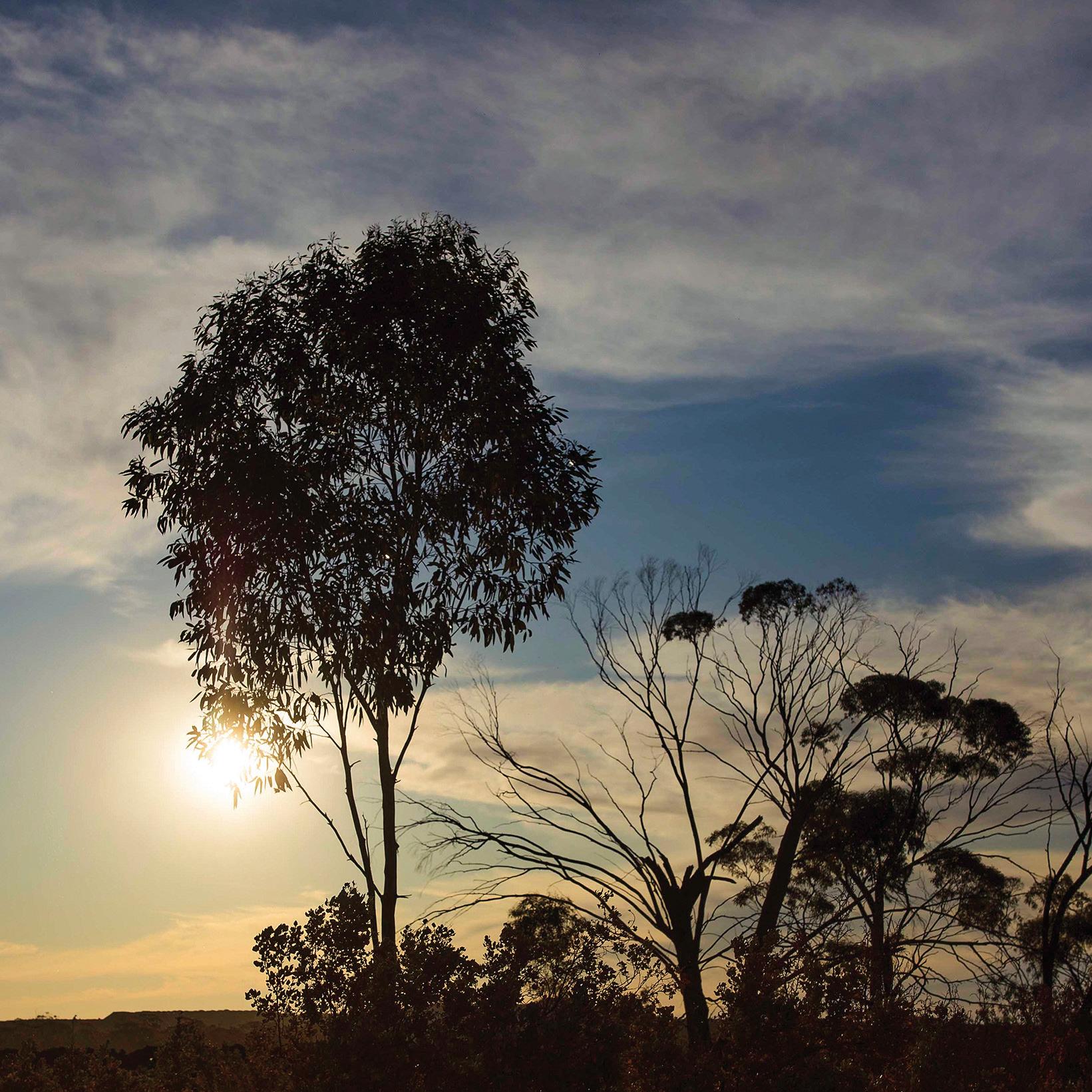
ECONOMIC PERFORMANCE AND VALUE CREATION
MATERIAL TOPIC: ECONOMIC PERFORMANCE AND VALUE CREATION
MinRes has developed an operating model with the aim to sustain long-term value creation for our stakeholders. While identifying challenges and improvement areas for our business, we aim to establish a holistic approach that captures all aspects of our economic sustainability and value creation. The inputs, or capital sources, from which we create value include human, natural, social and relationships, financial, manufactured and intellectual. Refer to MinRes At A Glance: Value Creation for further information.
FINANCIAL AND OPERATIONAL
MinRes is committed to optimising our operations and leveraging market opportunities to enhance shareholder value and generate sustainable financial performance. Through a pursuit of operational excellence, embracing innovative technologies, and adopting best practices, MinRes endeavours to optimise productivity and efficiency, which in turn fuels revenue growth and profitability. Through strategic planning and risk management, we identify challenges and growth options to capitalise on opportunities that align with our long-term objectives, ensuring sustained value creation for our shareholders.
MinRes made economic contributions in FY23 to Federal, State and Local governments, employees, suppliers and subcontractors. These financial distributions have been summarised in Table 4 below.
FY21 $M FY22 $M FY23 $M Value Generated Revenue 3,733.6 3,418.0 4,779.1 Value Distributed2 Payment to Federal, State, and Local governments 692.7 397.1 444.2 Employee wages and benefits paid 479.9 631.2 835.1 Community contributions 5.3 5.8 7.5 Payments to suppliers and subcontractors 1,227.2 2,034.0 2,667.3 Investment in infrastructure, exploration and innovation 774.5 1,000.3 1,821.1 Financing costs 86.4 82.5 257.3 Royalties to nongovernment groups 26.1 63.6 101.7
Table 4: Value generated and distributed1
1 External limited assurance is provided over our FY23 value generated and distributed. Refer to page 181 for a copy of the Independent Limited Assurance Statement. 2 Value derived from the MinRes Cash Flow Statements. 733 MWh of renewable energy generated during FY23 Solar-battery system installed and commissioned at Wonmunna Piloted hydrogen injection system on road haulage fleet at our Yilgarn Iron Ore Operations
HIGHLIGHTS $4.8 billion in revenue generated $835 million paid to employees $444 million in taxes and royalties paid to Local, State and Federal governments
FY23
WE ARE COMMITTED TO OPERATING WITH AN AIM TO SUSTAIN LONG-TERM VALUE CREATION FOR ALL OUR STAKEHOLDERS.
GRI Indicators 3-3 | 201-1 | 201-2 | 207-1 | 207-2 | 207-3 | 207-4 G4-EC1 SDG Targets 12.6 52 I MINERAL RESOURCES LIMITED 2023 SUSTAINABILITY REPORT
WORKING WITH GOVERNMENTS
Upholding transparency regarding taxes and royalties strengthens our social and operational licence within the regions where we operate. We have enhanced our approach to tax transparency in FY23 with the release of our inaugural Tax Transparency Report. We believe that informing our stakeholders on our approach to tax, and the governance processes we have, builds trust within the jurisdictions in which we operate and improves the overall integrity of the tax regimes we must comply with. We fulfil our tax obligations and pay royalties in accordance with the laws and regulations of the jurisdictions in which we operate.
Refer to our inaugural 2023 Tax Transparency Report.
VALUE CREATION MODEL HUMAN CAPITAL
At MinRes we recognise that our 5,687 employees3, supported by thousands of contractors are our most valuable asset. The collective knowledge, skills and dedication of our workforce are essential drivers of our economic success and long-term value creation.
Despite the current labour market landscape and our historical challenges with employee retention, we remain committed to prioritising our human capital by making significant investments in our workforce. In FY23 we prioritised the recruitment, development, and retention of top talent across all disciplines and levels of the organisation. This included total payments to our employees of $835 million.
Health and wellbeing were at the forefront of the design for our state-of-the-art headquarters with the aim to provide a one-ofa-kind workplace for our employees and their families to enjoy. This includes a restaurant, cafe, gym, crèche, end-of-travel facilities, subsidised take home meals and a health centre. Our headquarters will be the benchmark for how we develop workplaces across our operations going forward. Refer to Our Workplace Culture for more information.
For our fly-in-fly-out (FIFO) employees, we have implemented upgrades to sites to improve the quality of safety and lifestyle and will soon begin construction on resort-style accommodation which will transform the standard of onsite accommodation in our industry. Refer to Onslow Resort-style Accommodation for more information.
NATURAL CAPITAL
Mining operations inherently involve the extraction of resources, which has an impact on natural capital. MinRes acknowledges and understands our responsibility to protect, preserve and maintain the regions in our operational footprint. From exploration to closure, we follow strict environmental standards within the jurisdictions we operate. In doing this, we strive to mitigate the potential negative impacts on natural capital and ecosystems.
We continue to improve our approach to land management, disturbance and rehabilitation including increasing seed collections and conducting technical studies to address knowledge gaps to inform enhanced rehabilitation and closure outcomes. Refer to Environment Management Approach for more information.
SOCIAL AND RELATIONSHIP CAPITAL
MinRes places a high degree of value on the relationships the business has built with external stakeholders, as these connections and the resulting trust are vital to our social licence to operate. The relationships we have with all stakeholders including communities, government and non-government agencies, landholders and Traditional Owners is essential to the long-term sustainability of our business.
MinRes is committed to engaging with Indigenous Australian communities in a respectful and mutually beneficial manner. We recognise the unique cultural values, rights, lore, customs and connection Indigenous Australians continue to sustain with the land and waters on which we operate. MinRes engages with Indigenous Australians and communities associated with our projects, to build respectful relationships and partnerships to secure positive long-term economic, social, and cultural outcomes for all parties involved. We actively support employment and training initiatives, promote business opportunities, and invest in community development programs that address the specific needs and aspirations of Indigenous Australians. Refer to Our Approach to Indigenous Engagement for further information.
We strive to be a responsible corporate citizen and actively engage with the communities in which we operate. Through ongoing dialogue and consultation, we seek to understand and address the needs, concerns, and aspirations of the local communities. In having open and transparent communications, we aim to build mutually beneficial relationships based on trust, respect, and shared value creation. Refer to Developing and Maintaining Strong Community and Stakeholder Relationships for further information.
Our operations are complex and require expertise from many disciplines, including from external contractors. It is vital that we develop strong and long-term relationships with these providers. We actively engage with local businesses, fostering economic relationships and contributing to local supply chains. By prioritising local procurement where possible and providing fair and transparent opportunities, we aim to support the growth and development of local enterprises. Our supplier and contractor engagement initiatives create employment opportunities, stimulate economic growth, and strengthen the social fabric of the local communities where we operate. Refer to Socially, Environmentally Responsible, Transparent and Agile Supply Chains for further information.
GOVERNANCE - (CONTINUED)
MINERAL RESOURCES LIMITED 2023 SUSTAINABILITY REPORT I 53 3. This figure does not included contractors or Non-Executive Directors.
“BEING A CUSTODIAN FOR FUTURE GENERATIONS MEANS SHIFTING YOUR MINDSET TO A VERY DIFFERENT WAY OF THINKING.
ENCOURAGING OTHERS TO APPROACH DECISION-MAKING WITH A MUCH LONGER-TERM VIEW
.”
Trevor Parker | Banjima Elder | Peedamulla Station, Pilbara region, WA

MinRes recognises the significance of social and relationship capital as vital components of our sustainability journey. Our goal is to cultivate positive relationships through collaboration, active engagement, and community investment to create shared value and contribute to the social and economic wellbeing of our communities with whom we interact.
This represents a significant economic contribution to the communities we operate in and further drives development and value creation for the local, state and national economies where we do business.
For more information on how we engage with our stakeholders, refer to the 2023 Sustainability Performance
Data Tables FINANCIAL CAPITAL
MinRes has an obligation to all stakeholders, not just investors, to be strong stewards of allocated capital and invest in activities that not only generate strong returns but do so in a sustainable manner. Financial capital acts as a catalyst for sustainable growth, innovation and long-term success. In FY23 MinRes generated $4,779 million in revenue. This represents a significant creation of economic value which was distributed widely in state, federal and international economies in the form of employee salaries and wages, payments to contractors and suppliers, capital expenditure, taxes, royalties and dividend distributions.
MinRes is committed to delivering value to our shareholders. We aim to generate sustainable profits and maintain a robust financial position, enabling us to provide attractive returns to our shareholders through ongoing dividends and capital appreciation. Our focus on financial performance and disciplined capital allocation helps us build investor confidence, attract investment and contribute to the broader economy.
We maintain high standards of financial transparency and accountability. Through accurate and timely financial reporting, we provide stakeholders with a clear understanding of our financial performance, position and prospects. We adhere to applicable accounting standards and regulatory requirements, ensuring that our financial capital is managed responsibly and ethically. By maintaining transparency of our financial activities, we hope to foster trust, promote informed decision-making and enhance stakeholder confidence.
Financial capital is crucial in driving economic development and value creation. Through strategic investment, exploration, partnerships, cost management and a commitment to transparency, we aim to optimise the deployment of our financial resources.
MANUFACTURED CAPITAL
Our operations are capital-intensive and require investment in infrastructure including significant plant and equipment. These capital-intensive investments not only support our mining activities
but also generate economic development and value.
MinRes understands the importance of robust infrastructure in supporting our operations and driving economic value. We allocate substantial financial resources to acquire and develop infrastructure. In FY23 we invested a total of $1,821 million in new exploration and infrastructure projects essential for the continuation and expansion of our operations. The establishment and operation of mining infrastructure requires various goods and services, leading to the indirect employment of thousands of people in sectors such as manufacturing, technology and service providers.
INTELLECTUAL CAPITAL
Intellectual capital plays a crucial role in driving economic growth and value creation at MinRes. We take pride in our ability to develop the skills, expertise and knowledge to perform work internally whilst still leveraging external contractors and suppliers when needed.
We prioritise knowledge management and innovation as key drivers of economic success. In FY23 we invested heavily in research and development initiatives aimed at improving the efficiency, profitability and sustainability of our operations. By harnessing the expertise and insights of our workforce, we foster innovation, improve operational efficiency, and drive economic value through process improvements, cost savings, and the development of new technologies and solutions.
In line with our commitment to sustainability and greenhouse gas emissions reduction, we direct resources towards research and development (R&D) initiatives. These endeavours centre on pioneering solutions to effectively minimise our carbon footprint. Examples of our R&D efforts include the enhancement of lithium recovery processes and supporting the growth of clean energy technologies, such as renewable energy storage and electric vehicles.
Additionally, we are dedicated to developing improved transhipment technologies, incorporating remote bridge and automooring systems to optimise loading efficiency and minimise fuel consumption in iron ore bulk carriers. These are just two examples which demonstrate our commitment to innovation, sustainability and the continued pursuit of value creation while proactively working towards reducing our environmental impact. Refer to Emission Reduction Initiatives for further information.
Intellectual capital is vital for our approach to economic growth and value creation. Through innovation, partnerships and continuous employee development, we harness our intellectual capital to drive financial growth, enhance our competitive position and create sustainable value for our stakeholders.
GOVERNANCE - (CONTINUED) 56 I MINERAL RESOURCES LIMITED 2023 SUSTAINABILITY REPORT


“FOR ME, INTEGRITY IS IMPORTANT. IT MEANS YOU VALUE TREATING EVERYONE FAIRLY AND HONESTLY AT ALL TIMES. BE TRUSTWORTHY.”
Mike Grey | Chief Executive Mining Services
“EFFECTIVE LEADERS PROMOTE A CULTURE THAT SUPPORTS THE LONG TERM GROWTH AND SUCCESS OF THE TEAM, INCLUDING THE DEVELOPMENT OF ITS MEMBERS.”
Mark Wilson | Chief Financial Officer and Company Secretary
RESPONSIBLE SUPPLY CHAINS
MATERIAL TOPIC: SOCIALLY, ENVIRONMENTALLY RESPONSIBLE, TRANSPARENT AND AGILE SUPPLY CHAIN
OUR MANAGEMENT APPROACH
MinRes’ commitment to ethical and sustainable business practice extends to our supply chain. We seek to partner with suppliers who will work with us to apply responsible and sustainable business practices with their own operations and with their supply base. We expect suppliers to align with our values and conduct business in a manner that complies with all applicable laws and regulations including the internationally recognised labour and human rights principles contained in the United Nations (UN) Universal Declaration of Human Rights, the UN Declaration on the Rights of Indigenous Peoples, the UN Guiding Principles on Business and Human Rights and the International Labour Organisation’s Declaration on Fundamental Principles and Rights at Work
MinRes’ Human Rights Policy outlines our commitment and joint responsibility to ensure that our business activities respect the rights and dignity of all people, including prohibiting any form of forced labour and any retaliation, discrimination, harassment or intimidation against any person reporting, in good faith, a breach or suspected breach of this Policy.
The Human Rights Policy extends to all stakeholders, including our suppliers, with our Supplier Code of Conduct defining our expectations of our suppliers’ conduct with regard to business integrity, health and safety, environmental, labour and human rights issues. All suppliers, including their suppliers and contractors, are expected to comply with all relevant MinRes policies and procedures.
If a supplier or any other entity is found to be in material breach of the terms of their contract conditions, including the Supplier Code of Conduct, MinRes may exercise its right to suspend or terminate the contract with that supplier. Where possible, we will work with our suppliers to remediate and/or substantially mitigate the risk and require action within a reasonable timeframe.
We believe it is crucial to ensure our suppliers can confidentially and transparently engage with us regarding their concerns. MinRes has a Whistleblower Policy and Whistleblower Procedure, which outlines the ways in which our stakeholders can report matters they believe are in breach of the Supplier Code of Conduct or are illegal. Refer to Whistleblowing Provisions for further information.
85 per cent of total spend with Australian-based suppliers
FY23 HIGHLIGHTS
158
Self-Assessment Questionnaires (SAQs) issued to suppliers
99.8 per cent of suppliers screened for modern slavery risk
WE ARE COMMITTED TO ETHICALLY AND SUSTAINABLY PROCURING GOODS AND SERVICES ACROSS OUR BUSINESS VALUE CHAIN.
GRI Indicators 3-3 | 204-1 | 408-1 | 409-1 | 414-1 | 414-2 SASB Index EM-MM-510a.2 58 I MINERAL RESOURCES LIMITED 2023 SUSTAINABILITY REPORT
GLOBAL SUPPLY CHAIN RISKS
In FY23, several global supply chain challenges eased, with ocean freight on major global routes generally returning to pre-pandemic levels, however some aspects in the Asia Pacific region remained a challenge. Geopolitical tensions, such as the Russia-Ukraine conflict, continue to interrupt and complicate supply chains across the world.
MinRes was able to successfully manage and mitigate global supply chain risks through a combination of:
• supplier risk profile management
• maintaining agile supply arrangements
• identifying multiple sources of supply
• leveraging strong relationships with our critical and key global suppliers
• remaining focused on supporting a local supply base.
MinRes utilises a third-party platform that enables risk screening across all active suppliers and their shareholders for regulatory and reputation risks including sanctions, fraud, Securities and Exchange Commission violations, cybercrime, politically exposed persons, adverse media, environmental crimes and human rights abuses.
In FY23, MinRes implemented a risk-based software platform to enable assessment of our supply chain risks beyond Tier 1. This has facilitated further risk identification and appropriate due diligence beyond the previous supplier screening process.
CONFLICT MINERALS
Our Responsible Production Policy outlines our commitment and responsibility to respect human rights, engage in responsible production and sourcing, and not contribute to conflict. While MinRes does not operate in any high-risk or conflict-affected areas, we recognise that there may be a risk of significant adverse impacts associated with extracting, trading, handling, and exporting minerals from conflict-affected and high-risk areas.
We have a responsibility to respect human rights and not contribute to conflict. MinRes continues to be guided by the Organisation for Economic Co-Operation and Development Due Diligence Guidance for Responsible Supply Chains of Minerals from Conflict-Affected and High-Risk Areas and comply with relevant United Nations sanctions resolutions or, where applicable, domestic laws implementing such resolutions.
PROCUREMENT PRACTICES
MinRes considers the social, environmental and economic impacts of our procurement. In FY23, we increased support for local suppliers and continued to review the social and environmental performance of our supplier base.
Local and Indigenous procurement
MinRes is committed to contracting business partners to promote, support and employ local Indigenous Australians through a range of well-designed and fully supported business opportunities. We place high importance on purchasing goods and services locally to support the communities in which we operate and to build resilient supply chains.
We invest in building local capability by identifying programs and processes that can assist local Indigenous businesses and people to meet their aspirations in having their own business. Refer to Ensuring meaningful Indigenous economic participation and opportunity for further information.
During FY23, MinRes positively impacted the local community through direct employment, skill creation and the growth in Indigenous entrepreneurs and business owners.
We have provided opportunities for local Indigenous Australians through contracts including:
• a recruitment services contract under which candidates will be sourced and provided to the business for opportunities
• three cultural awareness contracts covering a number of MinRes sites including its headquarters
• a medical services contract providing pre-employment medicals and health surveillance
• an equipment hire agreement for lighting towers with a threeyear term
• a construction agreement for airport fencing at Ken’s Bore
• a three-year agreement with local Traditional Owner business for village gardening and maintenance services.
Environmental procurement
MinRes aims to engage with suppliers that take a precautionary approach towards environmental issues and seek ways to minimise the adverse environmental impacts of their operations, products and services. We are committed to understanding and managing our climate-related obligations, risks and opportunities and expect our suppliers to take appropriate actions to evaluate and mitigate the risks and opportunities of climate change associated with their operations. In relevant industries, suppliers are encouraged to adopt climate-related financial disclosure practices in terms of the recommendations of the Task Force on Climate-Related Financial Disclosures.
We have continued our focus on sustainable packaging options to reduce our reliance on single-use plastics and promoting a circular economy approach by engaging with eco-friendly WA-based suppliers.
GOVERNANCE - (CONTINUED)
MINERAL RESOURCES LIMITED 2023 SUSTAINABILITY REPORT I 59
In FY24, MinRes will introduce environmental questions as part of our new Social Responsibility and Ethical Sourcing Questionnaire, which will replace our current Modern Slavery Supplier Questionnaire. This aims to capture our suppliers’ environmental risk profile.
MANAGING HUMAN RIGHTS SUPPLY CHAIN RISKS
We recognise that through our supply chain we could be indirectly exposed to human rights risks, including risks of modern slavery4 practices. To prevent, detect and address human rights abuses, including modern slavery, we:
• identify parts of our business and supply chain where there are elevated risks of human rights abuses
• conduct due diligence in relation to human rights in our business and supply chains
• assess our effectiveness in preventing risks relating to human rights in our business and supply chains
• engage directly with suppliers about specific risks, including via social audits, working with them to provide further visibility into Tier 2 risks and beyond.
As part of our reporting obligations under the Modern Slavery Act 2018 (Cth) we develop an annual Modern Slavery Statement. Our Modern Slavery Statement is submitted to the Australian Border Force within six months of the end of the financial year and is made available on the online public register and our website5
We raise awareness of the potential risks of human rights abuses, including modern slavery, through our internal, management-led Human Rights Working Group. The Working Group is responsible for matters and activities related specifically to the management and response processes for human rights. The Working Group meets monthly and is comprised of key representatives from the Procurement and Sustainability teams with participation as required from Shipping and Legal Counsel.
To understand our potential exposure to human rights risks, we follow a risk-based approach to identify the types of suppliers that may have a higher risk of human rights abuses by utilising a thirdparty platform to conduct supply chain due diligence. Supporting this process, all identified high-risk suppliers are issued with a with an SAQ. The responses are then assessed, with any risk areas remaining addressed with the supplier in a two-way dialogue. The SAQ process provides MinRes with an opportunity to engage and share good practice measures to support suppliers on effective management and response to human rights risks within their supply chains, as well as identify any remaining human rights risks
that may require remediation.
Industry collaboration
MinRes continues to actively participate in the Human Rights Resource and Energy Collaborative (HRREc), which provides a forum for practitioners in the extractives, resources and energy sectors to contribute towards the meaningful implementation of the Modern Slavery Act 2018 (Cth).
The HRREc meets regularly to share good practice measures to assist member businesses with the effective and efficient management of human rights risks within operations and supply chains. Our participation with the HRREc allows us the opportunity to be consistent with other industry members on employing appropriate actions and remedies.
A key achievement, as an active member of HRREc in FY23, was the development of the Social Audit FAQ document. This document is utilised by MinRes and shared with our suppliers, as well as with other companies in similar industries.
Social audits
MinRes recognises the importance of conducting social audits with our suppliers in an effort to promote transparency and uphold responsible labour practices across the supply chain.
In FY23, MinRes conducted its first on-premise social audit utilising a third-party auditor. The social audit served as a proactive tool enabling for the identification of strengths and areas for improvement. This marked a significant step in MinRes’ commitment to corporate social responsibility, enabling alignment with UN International Labour Organisation Conventions. In FY24, the social audit program will be extended to capture several suppliers in our supply chain.
Training
During FY23, MinRes developed and piloted its inaugural human rights training module across key business units including Supply, Sustainability, Legal, Human Resources, Shipping and Risk. The training module was delivered virtually and covered the definition and forms of human rights abuses, the risks that exist within the Company’s supply chains and operations, due diligence measures to prevent and address risks and incidents, as well as where remedy and guidance can be sought. By the end of the reporting period, 33 key employees attended the pilot session.
The training module will be rolled out to the Learning Management System (LMS) during FY24. MinRes will continue to integrate human rights training, including modern slavery awareness, across the business.
5. https://www.mineralresources.com.au/our-sustainability/human-rights/
GOVERNANCE - (CONTINUED)
4. Modern slavery refers to situations where one person has taken away another person’s freedom so that they can be exploited; and may include human trafficking, slavery, servitude, forced labour, debt bondage, worst forms of child labour, deceptive recruiting for labour or services, and forced marriage (worst forms of child labour defined in International Labour Organisation Convention No. 182 and Recommendation 190).
60 I MINERAL RESOURCES LIMITED 2023 SUSTAINABILITY REPORT
OUR PERFORMANCE OUR SUPPLY CHAIN
Throughout FY23, MinRes continued to strengthen processes and procedures to address the risk of human rights abuses, including modern slavery practices, in our operations and supply chains by:
• implementing a risk-based software platform to enable assessment of our supply chain risks beyond Tier 1

• developing a Human Rights Supplier Due Diligence Procedure and Sustainable Procurement Standard to increase the scope of our commitment to ethical and sustainable procurement practices
• engaging with a third-party auditor to conduct our first on-premise social audit with a selected supplier
• strengthening the SAQ process to demonstrate MinRes’ position on modern slavery and the expectations for our suppliers
• implementing an improvement request process to increase supplier engagement and encourage action from issues raised in SAQs
• continuing our participation in key human rights information forums such as the HRREc, with input in the development of the Social Audit FAQ document.
During FY23, MinRes had 2,964 active suppliers in 26 countries, amounting to a total spend of $3,804 million6. This represents an approximate increase of 46 per cent from spend in FY22 of $2,608 million
Of the supplier base we contract directly with, 85 per cent of spend occurred in Australia, of which 80 per cent was based in Western Australia (Figure 8 and Figure 9). This is a result of our continued focus to prioritise procurement in the communities in which we operate.
Most of our international suppliers are located across China, the United States of America, Singapore, the United Kingdom, Canada and Japan (Figure 8 and Figure 9).
GOVERNANCE - (CONTINUED)
RESOURCES LIMITED 2023 SUSTAINABILITY REPORT I 61
6. This includes operational and capital asset expenditure and excludes acquisition and internal labour costs. As a result, this figure does not reconcile to other financial statements from the Company.
MINERAL
Canada – 0.7%
United States – 0.2%
Germany – 2.6% Switzerland – 0.2%
British Virgin Islands – 1.7%
INTERNATIONAL SPEND
China – $164.8M
Singapore – $99.5M
Germany – $98.2M
British Virgin Islands – $66.1M
Japan – $49.7M
United Kingdom – 0.4%
Netherlands – 0.2%
Canada – $27.9M
United Kingdom – $14M
Switzerland – $7.9M
Netherlands – $7.5M
United States – $6.3M
Singapore – 2.6%
Japan – 1.3%
China – 4.3%
NATIONAL SPEND
WA – $2,592M
NSW – $270.3M
QLD – $167.9M
VIC – $100.6M
ACT – $53.4M
SA – $50.5M
NT – $2.3M
TAS – $0.3M
68.2% <0.1% 1.3% 4.4% 7.1% 2.6% <0.01% Australia – 85.1 % 1.4% GOVERNANCE - (CONTINUED) 62 I MINERAL RESOURCES LIMITED 2023 SUSTAINABILITY REPORT
Figure 8: Top 10 international suppliers as a percentage of our overall spend
GOVERNANCE - (CONTINUED)
In FY23, MinRes issued a total of 158 SAQs, of which 151 were issued as a result of our embedded risk screening and assessment process to high-risk suppliers. Subsequently, 48 suppliers returned an SAQ with a medium-risk rating, and as per our process, were issued with encouragement notices. Ongoing dialogue with suppliers during the year resulted in 12 suppliers further reducing their SAQ risk rating to low as a result of being able to demonstrate improvements in processes and procedures addressing human rights risks in their business. Additionally, seven Tier 1 suppliers were deemed high-risk based on their supply chain, and as a result, were issued an SAQ. We received no grievances or complaints relating to human rights or breaches of supply chain conduct through FY23.
Indigenous procurement
During FY23, Indigenous Australian spend accounted for around $24 million. This represents a 140 per cent increase on our FY22 spend, which amounted to $10 million. This is a result of our continued focus to foster and support Indigenous business development and engagement. MinRes has implemented a number of programs to assist Indigenous businesses. Refer to Ensuring meaningful Indigenous economic participation and opportunity for further information.
Figure 9: Supply chain percentage spend and count breakdown
China WA Singapore China 4.3% 2.0% Singapore United States 2.6% 1.2% Germany 2.6% 0.9% British Virgin Islands Canada United Kingdom 1.7% 0.4% Japan 1.3% 0.3% Canada Germany 0.7% NT Ireland 0.4% Switzerland Netherlands TAS Netherlands 0.2% <0.1% 0.2% 0.2% 0.2% 0.2% 0.2% United States Taiwan 0.1% TOP INTERNATIONAL SPEND AUSTRALIAN STATE SPEND INTERNATIONAL COUNTRIES BY SUPPLIER COUNT 7.1% NSW 4.4% QLD 2.6% VIC 1.4% ACT 1.3% SA <0.1% WA ACT TAS 0.1% AUSTRALIAN STATES BY SUPPLIER COUNT 8.7% NSW 5.8% VIC 5.7% QLD 1.2% SA 0.9% NT 0.2% Australian International 70.7% 68.2% 77% 23% Japan United Kingdom 15% 85% 7% 93% Tier 1 Supplier Supplier Count 0.2% MINERAL RESOURCES LIMITED 2023 SUSTAINABILITY REPORT I 63
LOOKING FORWARD
MinRes focuses on improving our approach and responsible procurement practices to meet the growing expectations of sustainable sourcing and supply chain management. During FY24, MinRes plans to achieve this through:
• maintaining high-level Board and Sustainability Committee oversight and continued internal cross-functional governance mechanisms to ensure implementation of our Code of Conduct and Supplier Code of Conduct and that appropriate action is taken in the event of any breach
• maturing our risk enterprise system, accountability, controls and monitoring of control effectiveness in relation to sustainable supply chain issues and human rights
• integrating sustainability-related questions into the updated Social Responsibility and Ethical Sourcing Questionnaire
• implementing a Remediation Response Framework to enhance company readiness to coordinate and respond in the event of an alleged breach of human rights within our supply chain
• extending the social audit program to suppliers as deemed appropriate
• rolling out of the human rights training module into LMS and continuing to integrate human rights training, including modern slavery awareness, across the business.
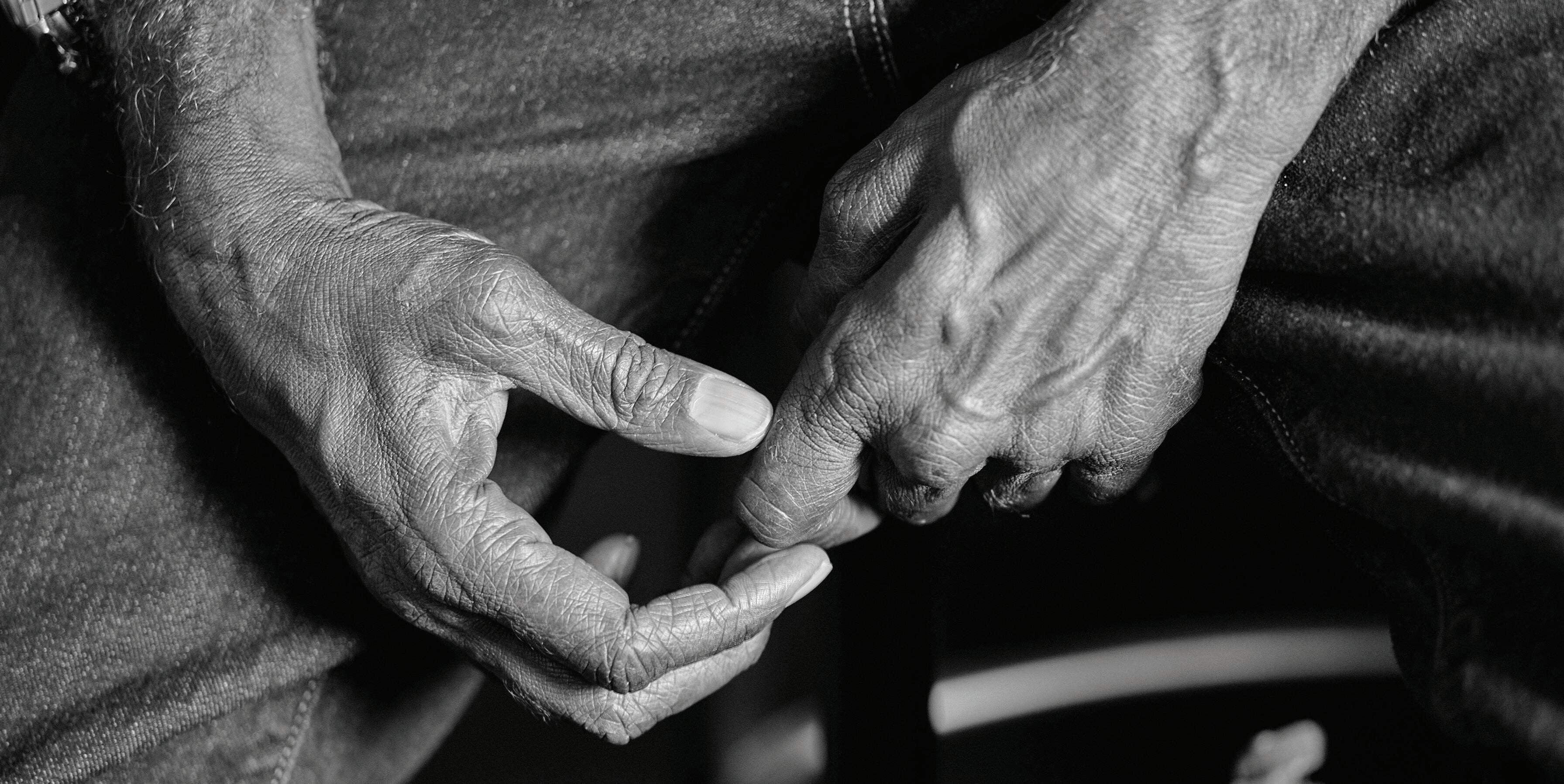
GOVERNANCE - (CONTINUED) 64 I MINERAL RESOURCES LIMITED 2023 SUSTAINABILITY REPORT


“LEADERSHIP MEANS STAYING GROUNDED BUT ALWAYS KEEPING AN EYE TO THE FUTURE. ”
Yenna Ong | Director International Trade and Strategy
“YOU CAN BE A GOOD LEADER IF YOU’RE ABLE TO ACTUALLY LISTEN. EVERYBODY HEARS, BUT HOW MANY LISTEN? IT’S A SKILL MANY PEOPLE DON’T HAVE.”
Tuesday Lockyer | Robe River Kumura Elder | Pilbara region, WA

HEALTH, SAFETY AND WELLBEING
PAGE 68 - 84
SAFETY
PAGE 69 - 77
HEALTH AND WELLBEING
PAGE 78 - 84
ATTRACTING AND RETAINING TALENT
PAGE 86 - 94
DIVERSITY AND INCLUSION
PAGE 96 - 106
MANAGING LAND ACCESS AND CULTURAL HERITAGE
PAGE 108 - 117
COMMUNITY AND STAKEHOLDER RELATIONSHIPS
PAGE 118 - 121
MINERAL RESOURCES LIMITED 2023 SUSTAINABILITY REPORT I 67 SOCIAL UN GLOBAL COMPACT PRINCIPLES SUSTAINABLE DEVELOPMENT GOALS 8 DECENT WORK & ECONOMIC GROWTH 10 REDUCED INEQUALITES 17 PARTNERSHIPS FOR THE GOALS ANTI-CORRUPTION
LABOUR HUMAN RIGHTS 11 SUSTAI(NABLE CITIES & COMMUNITIES 3 GOOD HEALTH & WELL-BEING 4 QUALITY EDUCATION 5 GENDER EQUALITY
MINERAL RESOURCES LIMITED 2023 SUSTAINABILITY REPORT I 67
FY23 HIGHLIGHTS
MATERIAL TOPIC: MAINTAINING A SAFE WORKING ENVIRONMENT THAT PROMOTES HEALTH AND WELLBEING
OUR MANAGEMENT APPROACH
MinRes works hard to protect the safety and wellbeing of our workforce, their families and the communities in which we operate. We recognise that healthy and safe working conditions are a fundamental human right that our workforce deserves. We are committed to ensuring health and safety prevention and promotion, both physical and mental, remains at the core of our operations.
In June 2023, an incident occurred during construction at the Ken’s Bore site, which tragically resulted in the death of 20-year-old contractor Kieren McDowall. MinRes Managing Director, Chris Ellison and senior leaders immediately travelled to site to offer support for those impacted by this tragedy. We continue to offer every support to Kieren’s family, colleagues and loved ones. An investigation into the cause of the incident has been launched. In conjunction, MinRes also undertook an immediate operational assessment of its critical risks and existing controls.
MinRes is committed to understanding and learning from this incident, which is a tragic reminder of the inherent risks within our industry and reinforces the importance of staying vigilant when it comes to employee wellbeing.
Our long-term safety performance has been strong for the industry, but we are determined to learn any lessons that help ensure our people go home safely to their families.
MinRes has a dedicated Health and Safety Management System which is designed to establish a clear set of values and objectives for; reducing the likelihood and severity of incidents, ensuring conformance with both regulatory and company requirements, and managing psychosocial hazards present in our workplaces.
Underpinned by our policies and driven by our leaders, we continue to monitor performance to ensure our management approach maintains its effectiveness.
GRI Indicators 3-3 | 403-1 | 403-2 | 403-3 | 403-4 | 403-5 | 403-6 403-7 | 403-8 | 403-9 | 403-10 SDG Targets 3.6 | 3.8 | 3.9 | 8.8 | 11.7 SASB Index EM-MM-320a.1
WE STRIVE TO MAINTAIN A HEALTHY AND SAFE WORKING ENVIRONMENT FOR OUR EMPLOYEES, CONTRACTORS AND VISITORS, WHILE ENHANCING THE WELLBEING OF OUR PEOPLE.
HEALTH, SAFETY AND WELLBEING
Continued focus on safety with a Total Recordable Injury Frequency (TRIFR) of 2.08 Establishment of the MinRes Health Centre >9 per cent of our workforce engaged in professional proactive psychological support services 68 I MINERAL RESOURCES LIMITED 2023 SUSTAINABILITY REPORT
This is measured against the five pillars of our health and safety strategy:
SAFETY OUR SAFETY COMMITMENTS
LEADERSHIP
Highly engaged, visible and proactive safety leadership at all levels. 1
OPERATIONAL DISCIPLINE
Unwavering discipline and commitment to perform through training, awareness and enhanced governance.
2
FIT FOR PURPOSE SYSTEMS
Continually improve and simplify the health and safety framework and processes to ensure they are fit for purpose. 3
CRITICAL RISK MANAGEMENT
Ensuring critical risk activities are identified and managed with clear accountabilities for verification of critical controls. 4
5
HEALTHY PEOPLE AND WORKPLACES
Active investment in the health and wellbeing of our people through education and initiatives. We have a clear focus on the wellbeing of our people, which encompasses physical and mental health.
The MinRes Board provides oversight of the health and safety strategy and performance as an essential aspect of our corporate governance structure, ensuring the wellbeing of our employees and stakeholders. This enables the identification of areas for concern, assessment of control effectiveness and up-to-date management on emerging risks, evolving regulatory requirements and industry best practice. Our Board-level Sustainability Committee also receive regular reports on the health and safety performance across all sites.
At MinRes, health and safety are core values that underpin everything we do. We are focused on maintaining a healthy and safe working environment for our employees, contractor partners and the communities in which we operate.
We are committed to complying with all health and safety laws and regulations governing our activities and have developed a suite of comprehensive policies, standards and procedures to guide compliance. MinRes’ Health and Safety Policy is supported by a suite of policies such as our Injury Management Policy and Fitness for Work Policy, which lay the foundation of our safety management framework – supported by cascading standards, procedures, plans and tools to meet the requirements of the Mine Safety and Inspection Act 1994 and the Mines Safety and Inspection Regulations 1995
We assure best practice by obtaining regular updates from safety law on occupational health and safety legislation, codes of practice, guidelines and published standards.
SAFE AND RESPECTFUL BEHAVIOURS
The findings from the WA Parliamentary Inquiry into sexual harassment against women in the FIFO mining industry uncovered the unsettling and disturbing truths of the industry. We recognise the gravity of these findings and are committed to eliminating sexual harassment from our business and taking any steps necessary to ensure our workplace is safe and all people feel valued and included. That means feeling safe and respected at work, in camp accommodation, during travel and at workrelated events. Any person in our business who has witnessed or experienced sexual harassment, sexual assault or any behaviour that doesn’t align with the Code is encouraged and supported to report through internal channels or externally through our confidential whistleblowing service (refer to Whistleblowing Provisions).
Through FY23, MinRes received 32 reports through our internal grievance mechanism which related to sexual harassment and 13 related to racial harassment. MinRes takes commensurate action to prevent, address and eliminate harassment from the workplace on a case-by-case basis. Of the sexual harassment cases reported internally, 10 resulted in terminations/dismissal, four resulted in resignation and nine required counselling and/ or written warnings. Of the racial harassment cases reported, four resulted in terminations/dismissal, five required counselling and/or written warnings and two resigned. The remainder of cases were unsubstantiated.
SOCIAL - (CONTINUED)
Figure 10: Five pillars of health and safety strategy
MINERAL RESOURCES LIMITED 2023 SUSTAINABILITY REPORT I 69
Our Board has oversight, including but not limited to, disclosures in the event of any incidents/complaints. Information provided is de-identified and provides complainant type, detail, and actions/ resolution. As with mitigating health and safety risks in the workplace, managing the risk of sexual harassment is an ongoing, embedded process. MinRes has set very clear expectations for our senior leaders.
In response to the WA Parliamentary Inquiry and the number of sexual harassment cases identified through our internal grievance mechanism, MinRes undertook an internal assessment to better understand the physical spaces, psychological environment and culture with respect to gender safety. The three key assessment areas included:
• physical work environment assessment
• 34 focus group sessions held across both MinRes and client sites to understand the lived experiences of female employees in relation to workplace culture, gendered violence, inequality and power imbalances
• voluntary online employee engagement survey.
The focus groups provided the greatest insight into the experiences of women in our business and nine recommendations were made, seven of which are currently being implemented.
Our Safe and Respectful Behaviour campaign
Our Show Up, Stand Up, Speak Up campaign encourages three simple actions our employees and contractors are encouraged to take to ensure our workplace is safe, respectful and inclusive.
• Show Up means supporting colleagues and friends at work by never accepting bullying, racism, sexism, discrimination, harassment or inappropriate behaviour towards anyone.
• Stand Up means supporting any person being harassed or insulted and showing that support publicly, making note of incidents and stepping in where appropriate.
• Speak Up means raising concerns with a direct manager/ supervisor, HR representatives or through our confidential whistleblower service, MinRes Integrity Assist.
The Show Up, Stand Up, Speak Up campaign has been rolled out across all our locations. Through FY23, this message continued to be reinforced to create a shared language and visible and verbal reminder of our expectations of our people.
In FY23, we expanded the Safe and Respectful Behaviours program of works to include:
• implementation of a new Safe and Respectful Behaviours training video which all employees are required to complete
• a dedicated reporting mailbox to support concerns, which redirects concerns from MinRes Integrity Assist directly to the MinRes Industrial Relations Team, maintaining confidentiality
• creation of a dedicated Safe and Respectful Behaviours intranet page which includes the reporting options, Employee Assistance Program, the Safe and Respectful Behaviours Procedure and key contacts
• new posters and fridge magnets for all MinRes sites to reinforce the Show Up, Stand Up, Speak Up messaging with a QR code to link employees to the various channels available to report a concern
• Bystander training to complement the Show Up, Stand Up, Speak Up campaign, providing employees with the tools and resources they need to speak up to poor behaviour in a safe and appropriate manner
• in-person Stop for Safety sessions across all teams to address psychosocial hazards, outline expectations of leaders and employees and inform employees of the various reporting channels
• refreshed annual mandatory Code of Conduct training to improve the focus on respect at work
• involvement in the industry response to safe and respectful behaviours.
While recognising there is still more to do, we will be intensifying our efforts to ensure our sites are safe, respectful and equipped to adequately support our people and hold offenders accountable. We are committed to listening to our employees about their experiences and seeking suggestions for tackling this complex issue.
In FY24 we plan to conduct:
• quarterly Safe and Respectful Behaviour Return to Work programs
• Gender Safety Audit focus groups at each MinRes location to explore gendered violence, power imbalances and workplace culture in a deep dive approach
• Safe and Respectful Behaviours interactive refresher training to the workforce which explores microaggressions
• Bystander training for all employees located across our sites
• development of a Contact Officer Program to further support employees at our sites.
It is our intention to continue to upgrade the physical aspects of our camps to provide more spacious and comfortable accommodation, along with a broader range of sporting facilities
SOCIAL - (CONTINUED) 70 I MINERAL RESOURCES LIMITED 2023 SUSTAINABILITY REPORT
and social activities. We intend to develop facilities which promote family and support greater occupancy by couples. Our expectation is that the changes we are planning will strengthen the sense of community at each site and in turn enhance safety for all our workforce. Refer to Onslow Resort-Style Accommodation for further information.
CASE STUDY: BYSTANDER TRAINING
In response to the WA Parliamentary Inquiry, MinRes committed to delivering in-person Bystander training with the aim of providing the tools and resources required to speak up and be an active bystander when witnessing poor workplace behaviour.
We piloted the training at our Kwinana Workshop in October 2022 to test the program delivery effectiveness and commenced the roll-out of metro-based training in January 2023. A total of 61 sessions were delivered to 1,215 employees, representing 20 per cent participation of the Kwinana Workshop workforce and 76 per cent of our metro-based employees.
The feedback received from our employees clearly demonstrated the program’s effectiveness in resonating with our employees, with observations of post-delivery discussions which reinforced the MinRes “Show Up, Stand Up, Speak Up” message. The program received an average engagement and satisfaction score of 93.5 per cent, with over 1,000 positive comments received. MinRes is committed to continuing the roll-out of the Bystander training to all employees in the future.
OUR SAFETY MANAGEMENT FRAMEWORK
The MinRes Health and Safety Management System is designed to establish a clear set of values and objectives to reduce the likelihood and severity of incidents and ensure conformance with both regulatory and Company requirements for managing workplace health and safety.
Supported by a dedicated team of health and safety professionals, the Health and Safety Management System has been tailored to meet the specific needs of the Company and assist MinRes business units, and their operations, to effectively manage health and safety through the execution of established Company policies, standards and procedures. The complexity of the management system, and the extent of the documentation and resources devoted to it, have been developed with consideration of the nature, scale and risk of the business activities, products, and services we provide to ensure health and safety, all of which are integrated into the overall management system.
The Health and Safety Management System is continuously reviewed based on ongoing internal performance data, feedback from internal and external sources and identification of legislative updates to ensure currency of information to support and improve health and safety throughout the Company, including our subsidiary employees, contractor partners, subcontractors and visitors to all our sites and facilities.
HAZARD IDENTIFICATION, RISK ASSESSMENT AND INCIDENT MANAGEMENT
MinRes has thorough processes for hazard identification, risk assessment and incident management. The MinRes Hazard and Risk Management Procedure defines minimum requirements to identify, analyse, evaluate, control, monitor and review occupational hazards and risks within the business. Definitions of risk consequence levels, likelihood, risk ratings and a hierarchy of controls ensure consistent application across the business.
MinRes identifies all principal mining hazards (PMH) that are specific to our operations, in accordance with new provisions in the Work Health and Safety (WHS) Mines Regulations 2022. To provide a consistent approach for identifying and assessing a PMH, MinRes has created a Principal Mining Hazard Management Plan framework for implementation across our mining operations.
Facilitators of hazard and risk assessment processes must be trained and competent in the tools and techniques used. The MinRes workforce undertakes compulsory training on the taskbased assessment tools in use. We evaluate the effectiveness of the risk assessment process to mitigate hazards and ensure continuous improvement.
MinRes has a clear focus on near-miss reporting at all our operations. We believe learning from these events is essential in helping to prevent reoccurrence in the future and continually improving our safety culture and performance.
Incident investigation and management
The investigation of work-related incidents involves a systematic process that includes hazard identification and risk assessment, root cause analysis, determining corrective actions using the hierarchy of controls and identifying improvements in the occupational Health and Safety Management System. These improvements may involve updating policies, enhancing training programs or implementing organisational changes to promote a culture of safety.
The MinRes Incident Management Procedure describes requirements for initial response, notifications and reporting, classification and investigation of incidents. This is supported by our Injury and Illness Classification Procedure by clarifying the definitions for occupational injury and illness to ensure accurate classification of health and safety related incidents.
SOCIAL - (CONTINUED) MINERAL RESOURCES LIMITED 2023 SUSTAINABILITY REPORT I 71
MinRes maintains a Lessons Learnt process that applies to all serious incidents, with the intent to consistently share learnings that are identified through our investigation processes across the organisation. This ensures all stakeholders are appropriately informed of the hazards that are present in the workplace and understand the actions that need to be implemented to ensure that risks are controlled, and incidents are not repeated.
Stop work authority
We empower our people to speak up when they don’t feel safe and report all hazards identified in the workplace. Our stop work authority empowers workers to stop any work that they consider to be unsafe, at any time.
Stop work authority is actively promoted and encouraged through the MinRes Communication and Consultation Procedure and during all safety inductions, emphasising the responsibility and obligation of all employees and contractors to stop working if they perceive a hazard, unsafe conditions or behaviours that may present danger to personnel, equipment or the environment.
Situations warranting a stop work authority may include alarms, lack of knowledge or understanding of a task, change in workplace conditions, reported hazards or near-miss incidents, improper equipment use, or other unsafe conditions and behaviours.
The stop work authority, combined with our Hazard and Risk Management processes promote a proactive approach to safety, encouraging open communication, and supporting a shared responsibility for maintaining a safe work environment.
Hazardous substances management
MinRes requires the review and approval of all hazardous substances prior to use. We also require all hazardous substances to be appropriately managed, stored and handled, and used in accordance with applicable Australian Standards and Safety Data Sheets. This includes:
• storing hazardous substances in the correct storage areas
• consideration of secondary containment to capture potential spills
• fire prevention
• ventilation
• PPE
• access by emergency response teams
• safety signage
• appropriate labelling.
Hazardous substances classified as dangerous goods must be managed, stored, handled and used in accordance with dangerous goods regulations. This includes ensuring any person involved with hazardous substances is trained, competent and authorised to do so. MinRes uses an external web-based software program to
develop a register of all chemicals and materials stored on each site. It also provides Safety Data Sheets and information about the health and environmental effects of the chemicals listed.
Emergency response and management
Our emergency management strategy prioritises a proactive stance, actively identifying potential risks and implementing measures designed to prevent emergencies or lessen their impact should they occur. This is achieved through rigorous operational risk assessments, leveraging our Health and Safety Management System and targeted workplace training initiatives. The strategy is structured on a comprehensive four-phase model:
MinRes has put in place a Crisis and Emergency Response Management Plan (CERMP). This has been formulated to provide a comprehensive framework for swift and decisive actions during emergencies. The CERMP defines roles, responsibilities and arrangements to activate a rapid and organised response to emergency or crisis situations. These may include cyclones, security issues, fatalities, significant environmental damage, kidnappings, accidents and destruction of assets.
To complement the CERMP, all MinRes operations, projects and facilities have documented Emergency Management Plans focused on:
• ensuring the safety and health of all people associated with the project/contract/facility
• protecting MinRes property and assets
• minimising the impact on the environment
• ensuring business or project continuity as soon as practical
• safeguarding MinRes business reputation and commercial viability.
We ensure the continuous relevance and effectiveness of all Emergency Management Plans by conducting annual reviews and updating where required.
We ensure our teams are appropriately prepared through continual training programs and emergency drills carried out across our operations. Our emergency exercises are grounded in practical, foreseeable scenarios identified in our operational risk assessments.
SOCIAL - (CONTINUED)
PREPAREDNESS RESPONSE RECOVERY PREVENTION
Figure 11: Four-phase emergency response model
72 I MINERAL RESOURCES LIMITED 2023 SUSTAINABILITY REPORT
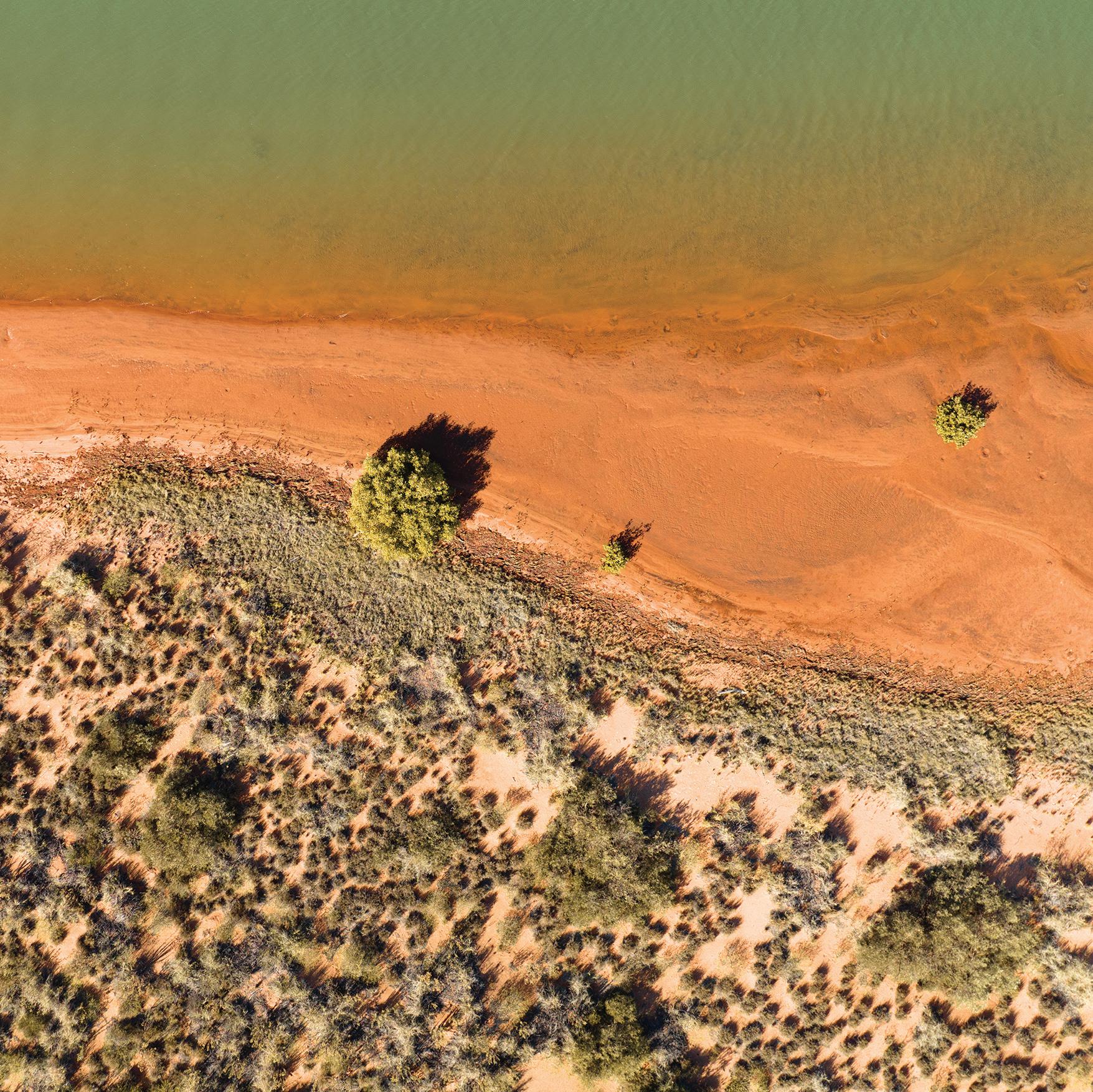
CONTRACTOR MANAGEMENT
Our contracting partners are an important part of our workforce and are integral to the safe delivery of a high-quality product to our customers. The MinRes Contractor Management Procedure outlines the process for verifying that contractor and subcontractor groups have the necessary skills, resources and equipment to safely undertake work activities assigned by MinRes. Our Contractor Safety Requirements Manual supports the Contractor Management Procedure, outlining the minimum safety and health requirements of all contractors and subcontractors undertaking work for MinRes and our subsidiary worksites.
We have several key processes that we follow when engaging with our contracting partners, to ensure they remain compliant with MinRes standards and agreed obligations and responsibilities. There are several key elements to successful contractor engagement at MinRes.
• Scope of work – all contracted work must be adequately scoped and planned to ensure all potential risks are considered and controlled.
• Submission of a Safety Management Plan – that systematically addresses all aspects of the intended work scope and compliance to all health and safety legislation, approvals, licences, permits and standards applicable to the work.
• Completion of Contractor Authorisation to Commence Work and Close Out Form – this is a fundamental tool in ensuring WHS requirements and due diligence obligations have been met. It helps verify that contracting partners comply with MinRes expectations, site rules and contactor engagement processes.
• Completion of a Contractor Induction Checklist – this includes a MinRes Medical Declaration Form, a negative result from drug and alcohol screening and a pre-employment medical fit for work assessment completed by a registered medical practitioner. All contractors are also required to complete the MinRes Corporate Safety Induction, the Code of Conduct and Business Integrity training, the Safe and Respectful Behaviours e-learning video training, and a site and area specific induction prior to being mobilised to any MinRes site.
• Monitoring performance – this includes monitoring of a contractor’s performance to ensure they maintain compliance with agreed expectations and work at the level required to safely execute their role. As a minimum, periodic on-site inspections, observations and interactions need to be conducted and documented.
To effectively manage our contracting partners and ensure quality engagements, all leaders are required to complete an online training package for contractor management. Additionally, we work closely with our contracting partners, monitoring their performance and ensuring safe execution through our Contractor Safety Interaction process. This process supports the implementation of our revised and updated Contractor Safety Management system.
SAFETY TRAINING
All MinRes operations include a robust health and safety induction program for all employees, contractors, subcontractors and visitors. This provides an overview of our business, vision and values, key MinRes policies and procedures, and critical health, safety and environmental information. It is compulsory for all employees, contractors, subcontractors and visitors at MinRes sites to complete the Corporate Safety Induction, which is deemed valid for two years post completion.
MinRes also maintains site-specific induction packages, which can be completed prior to arriving on site. These training packages allow operational teams to receive site-specific information and transition to site in a more streamlined manner.
We continue efforts to streamline our training processes, conducting a training needs analysis of our training systems, requirements and onboarding process for all personnel joining the business. Minimum and recommended training requirements are identified for specific job roles to ensure that workers, supervisors and managers are suitably experienced and qualified to perform their work.
MinRes assesses the competency of our workforce to meet safety requirements through a verification of competency assessment. MinRes has a Verification of Competency Procedure to ensure:
• workers have the required skills and knowledge to successfully achieve their job scope safely
• workers are competent to successfully complete their job scope to the required standard
• we comply with all legislative, organisational, industry and client requirements.
In recognition of the critical role that our supervisors and leaders play in achieving safety success, in FY23 we rolled out a new leadership training program. All MinRes leaders are required to successfully complete the MinRes WHS for Leader's program.
SOCIAL - (CONTINUED) 74 I MINERAL RESOURCES LIMITED 2023 SUSTAINABILITY REPORT
This program addresses core supervisory skills inclusive of:
• new WHS Laws
• statutory positions
• duty of care for supervisors
• safety leadership
• legislation and legal obligation
• communication
• hazard and risk management
• workplace inspections
• change management
• crisis and emergency management
• contractor management
• incident management.
Training records are retained and are made accessible to the relevant individuals and departments as appropriate. As a minimum, training records include details on who has been trained, what the training course covered, what competencies or qualifications were achieved or obtained, the identification of the provider and training duration.
Awareness and safety culture
All sites and departments have a safety representative that actively engages in health and safety matters at a site level, including reported hazards, near misses and safety performance.
A weekly safety and training notification is sent to all operational teams with internal safety alerts and other health, safety and training notifications. This includes toolbox topic documents for discussion at pre-start and toolbox meetings for the following week. Toolbox topics have included identifying, assessing and controlling risks, electrical awareness, road safety, noise-induced hearing loss, tyre fires and explosions, isolation and tagging, and sustaining nightshift and fatigue.
Worker health and safety meetings at project sites are also held each month, with strong safety performances recognised through safety achievement certificates and individual or team awards.
To allow effective communication and consultation on relevant health and safety matters, MinRes ensures the following across our operations:
• all relevant information is to be provided as early as practicable
• management teams with responsibility of health and safety will have sufficient information to make well informed decisions
• the views of employees shall be considered, and they will be given the opportunity to contribute to the decision-making process regarding workplace health and safety
• employees who may be affected by decisions which relate to their health and safety will be given an opportunity to express their views and understand the reasons for the decisions undertaken
• time is to be allowed for each party to consider relevant health and safety information (within available timeframes)
• health and safety information is to be made available and provided upon request and presented in easy-to-understand language and format
• if workers are represented by a health and safety representative (HSR), communication and consultation will involve the HSR so far as is reasonably practicable.
OUR PERFORMANCE
During FY23, MinRes experienced an increase in our Lost Time Injury Frequency Rate (LTIFR) from 0.00 in FY22 to 0.07. Regrettably, this was due to a Lost Time Injury involving a contractor who sustained a fractured lower leg injury whilst undertaking de-watering activities and the tragic fatality during construction at Ken’s Bore. This reflects a need to further improve risk management culture and our safety performance.
MinRes’ Total Recordable Injury Frequency Rate (TRIFR) was 2.08 and represents a year-on-year improvement from 2.33 in FY22. We continued to work closely with our key contracting partners to ensure alignment of safety and health expectations to deliver successful safety outcomes.
A summary of MinRes’ FY23 safety performance is outlined in Table 5, Figure 12 and Figure 13. Figure 12 shows MinRes’ injury frequency rate based on one million hours worked by employees and contractors.
SOCIAL - (CONTINUED)
MINERAL RESOURCES LIMITED 2023 SUSTAINABILITY REPORT I 75
Injury Frequency Rates
1 External limited assurance is provided over our FY23 LTIFR and TRIFR. Refer to page 181 for a copy of the Independent Limited Assurance Statement.
2 High-consequence injuries are defined as significant injuries, which include lost time injuries and fatalities.
3 All incidents rate excludes non-work-related injuries.
For further information on MinRes historical injury rate performance and frequency rates, refer to the standalone publication of our 2023 Sustainability Performance Data Tables
FY23 safety metric per one million hours worked Employees Contractors Combined Employees and Contractors Work-related Fatality Rate 0.00 (FY22: 0.00) 0.26 (FY22: 0.00) 0.07 (FY22: 0.00) Lost-time Injury Frequency Rate (LTIFR)1 0.00 (FY22: 0.00) 0.26 (FY22: 0.00) 0.07 (FY22: 0.00) Total Recordable Injury Frequency Rate (TRIFR)1 1.45 (FY22: 1.96) 3.67 (FY22: 3.36) 2.08 (FY22: 2.33) High-consequence Work-related Injuries Rate2 0.00 (FY22: 0.00) 0.52 (FY22: 0.00) 0.15 (FY22: 0.00) All Incident Rate3 -187.99 (FY22: 150.14) Near Miss Incident Frequency Rate -46.70 (FY22: 32.47) Hours worked 9,675,016 (FY22: 7,637,402) 3,814,993 (FY22: 2,679,478) 13,490,008 (FY22: 10,316,879)
Table 5: FY23 safety performance
LTIFR TRIFR FY19 FY20 FY21 FY22 FY23 5.00 4.00 3.00 2.00 1.00 0.00 Total Recordable Injury Frequency Rate (TRIFR) 0.80 0.60 0.40 0.20 0.00 Lost Time Injury Frequency Rate (LTIFR)
Figure 12: Historical trends in LTIFR and TRIFR – combined employees and contractors
(
SOCIAL - (CONTINUED) 76 I MINERAL RESOURCES LIMITED 2023 SUSTAINABILITY REPORT
Injuries per million hours worked)
MONITORING AND EVALUATING OUR PERFORMANCE
MinRes has a Safety Internal Audit Procedure outlining three layers of safety audits, including:
• project, facility and contract audits conducted by site-specific safety leads

• corporate or business unit audits conducted by the MinRes Safety team
• third-party audits conducted by independent auditors.
The MinRes Safety team maintains a corporate audit schedule for monitoring the completion of internal safety audits.
SOCIAL - (CONTINUED)
Superficial injury 28% Burns 3% Contusion 8% Disorder of muscle, tendon and tissue 1% Other 8% Foreign body 3% Open wound 7% Sprains and strains 42% MINERAL RESOURCES LIMITED 2023 SUSTAINABILITY REPORT I 77
Figure 13: Nature of FY23 work-related injuries
HEALTH AND WELLBEING OUR STRATEGIC APPROACH
At MinRes, our highest priority is the health and wellbeing of our people. We believe that achieving our business objectives stems from our employees feeling valued, supported and able to reach their full potential. To ensure this, we empower our leaders to prevent harm, mitigate illness and promote thriving environments. We have a human-centered approach focusing on supportive leadership, proactive education and our people’s wellbeing.
Our health and wellbeing system is defined by a prevention, detection and response model focusing on three pillars.
OUR HEALTH AND WELLBEING PROGRAM
MinRes has a dedicated Health Services team who support employee health and wellbeing across the full spectrum of health services. Our health and wellbeing program strengthens our focus on supporting our people by providing end-to-end services to suit individualised needs.
MinRes services support physical and mental wellbeing, injury prevention and management, and lifestyle and social wellbeing. Our target towards WELL Platinum Certification also aligns with our organisational commitment to ongoing employee health and wellbeing.
Job Dictionary Project
Supporting employee health and wellbeing across the MinRes
PREVENT HARM
Prevent harm, drive decisions and guide strategy with intent.
• Increase job resources and mitigate psychosocial hazards.
• Use of ergonomic risk methodology for position assessments and job matching.
• Integrate psychosocial hazard identification into job task analysis.
• Develop leadership capability to reduce stigma and promote a psychologically safe work environment.
• Foster resilience and provide multiple avenues for help seeking.
• Empower employees and their families to access support throughout their employment lifecycle.
These pillars are supported by the following activities:
• exposure assessment and monitoring
• risk-based pre-employment screening
employment life cycle is a fundamental principle of our strategic approach to health and wellbeing. To support this commitment, it is imperative to have an accurate understanding of the physical, psychosocial and cognitive demands of our roles within our workplaces. By identifying these demands and assessing their potential risk to health, safety, wellbeing and performance, the Company can make informed decisions around intervention and control. This includes workforce planning, task redesign, workplace modifications and tailored injury prevention programs.
The Job Dictionary Project aims to enhance workforce collaboration, innovation and operational efficiency by reviewing 20 high-risk and safety critical roles across MinRes operations. The Project will assist in identifying suitable duties for injured or ill employees, support pre-employment screening criteria, jobperson matching and determining key psychosocial risk areas within the business.
Fitness for work
All employees and contractors are required to be fit for work while on our work sites or undertaking activities on our behalf. Several factors may influence an employee’s fitness for work, including but not limited to, the adverse effects of alcohol and other drugs, fatigue, physical stress, heat illness, mental health or psychological issues, medications, medical issues, smoking, health and fitness and nutrition. The MinRes Fitness for Work Procedure outlines the minimum standards for managing fitness for work.
MITIGATE ILLNESS
Detect early to foster a safety culture and ensure a risk approach to management.
• Detect and manage occupational diseases, work-related injuries, and non-work-related conditions.
• Embed recovery at work initiatives and campaigns to reduce long-term illness.
• Prioritise employee health with access to high-quality healthcare services, including check-ups and preventive screenings.
• Conduct educational programs to raise awareness about personal hygiene and disease prevention.
• Promote mental wellbeing through counseling services, stress management and a supportive work environment.
• risk-based health monitoring
• early intervention and rehabilitation support
• health promotion and lifestyle support
• coaching
PROMOTE THRIVING
Ensure high-level support for injured employees and promote safe return to work.
• Engage with local communities and collaborate on wellbeing initiatives, while supporting education, job training and access to essential services for the community to thrive.
• Invest in employee professional development through training, mentorship and career advancement to foster personal and professional growth.
• education and awareness initiatives
• mental health and psychological support and intervention.
SOCIAL - (CONTINUED)
78 I MINERAL RESOURCES LIMITED 2023 SUSTAINABILITY REPORT
Health risk management
Effective health risk management enables us to identify priority areas for resource allocation and meet the standards and expectations of our stakeholders. We have completed Companywide health risk assessments to provide oversight of material and non-material health risks. Our minimum controls support critical health risk management and drive risk reduction actions to ensure our people are protected from harm.
Workplace exposures to health hazards
MinRes takes a proactive, holistic and risk-based approach to managing health and hygiene hazards across our operations. We identify, measure and manage health related hazards through the application of scientific methodologies and standards from the Australian Institute of Occupational Hygienists (AIOH), the American Industrial Hygiene Association, Safe Work Australia, applicable legislative requirements and Standards Australia.
The types of health hazards we manage vary due to the demands of different roles and the environments in which our employees and contractors work. We regularly monitor common health hazards our employees and contracting partners may be exposed to, including:
• noise from our mining and workshop operations
• welding fumes
• naturally occurring fibrous minerals encountered in mining operations
• naturally occurring radioactive materials in minute concentrations associated with lithium mining
• silica and general dust.
These health hazards could result in occupational illnesses such as hearing loss and respiratory illness. Gradual onset musculoskeletal disorders also pose a health hazard to our workforce and contracting partners. In the event of potential exposures being identified, we apply the hierarchy of controls which aim to implement an inherently safer system where the risk to health is eliminated, prevented through design, or reduced.
MinRes undertakes baseline medical assessments of physical, hearing, and lung function to establish medical fitness for work prior to employment. Across all sites, we have established monitoring programs to assess potential exposures to health hazards. These programs assist in developing health exposure risk profiles, and associated controls, ensuring the prevention of occupational illness. We address health hazards with controls documented in our Health Management Plans. Each plan takes a risk-based approach to control health hazards specific to the work areas where our people are potentially exposed.
MinRes is committed to continuously enhancing our occupational health and hygiene risk assessment, monitoring efforts and exposure controls to protect the health of our employees.
As a business, MinRes proactively manages health hazards and the potential associated risks through a range of initiatives.
• Developing comprehensive health exposure risk profiles and categorising risks based on potential exposure levels and the health impact of the health hazard, which are communicated to site leadership and the workforce.
• Developing, implementing and reviewing health risk controls to protect the health of our workforce.
• Educating our workforce on the health risks that may be present in their workplace, as well as the controls in place and how to reduce their risk of exposure.
• Site-specific noise control management plans summarising noise control strategies.
• Quarterly noise and air contaminants monitoring to ensure exposure levels are within acceptable limits set by legislation and scientific bodies.
• Employee education and awareness sessions focusing on the correct selection and fitting of PPE, such as hearing protection devices and respiratory protection equipment.
• Provision of hearing testing.
• Task related “warm-up for work program”, which focuses on assessing the risks associated with manual hazards and exercises to minimise musculoskeletal injuries.
• Verification of existing controls through in-field verification programs.
In FY23, MinRes fulfilled our objective to improve on the collection of our hygiene sampling by building internal capability for all our operations including our contracting crushing operations.
We expanded our Hygiene team, increasing the capacity of our in-house expertise managed by Certified Occupational Hygienists (COH). Success in regulatory compliance and the prevention of occupational illnesses was marked by various outcomes.
• Review of our Hygiene Management System for alignment with the Western Australian WHS Act 2020, WHS Regulations 2022 and ISO 31000 risk management.
• Ongoing roll-out of our Occupational Hygiene Standard, stipulating the performance requirements for the business and measuring performance.
• Continued implementation of site-specific management plans, programs and reporting tools to execute the performance requirements of the Occupational Hygiene Standard.
• Successfully rolling out hygiene monitoring across all MinRes owner/operator sites achieving 100 per cent sampling regulatory compliance across all sites throughout the year.
• Completion of baseline exposure monitoring for the identification and control of health risks at our Wodgina Lithium operation
MINERAL RESOURCES LIMITED 2023 SUSTAINABILITY REPORT I 79 SOCIAL - (CONTINUED)
• Completion of exposure monitoring for hazardous substances and other health hazards at our CarbonArt operation, with results indicating low risk of exposure to hazardous substances.
• Developing and implementing a simplified fibrous materials management framework, based on exposure data indicating low level of risk.
• Development and implementation of a silica management plan for our operations.
• Controlled silica exposures through dust suppression across the processing plant and laboratory facility at Mt Marion, thereby reducing exposures of personnel.
• Ongoing assessment of Mt Marion spodumene and confirming non-detection of fibrous contamination in the shipping product.
• Ongoing assessment of radiological contents of bore water across the Mt Marion tenement for production and dust suppression.
• Continued collection of quality samples including, but not limited to, exposure assessment, control and verification.
• Developed and implemented a hearing conservation program across our operations, a framework for the management of radioactive bore and a procurement noise control process.
MinRes strives to prevent occupational illnesses through proactive identification, assessment and management of risk factors and monitoring the health status of our workforce. The systems in place are robust to manage exposure health risks to our employees and contractors.
During FY23, there were no recordable incidents among our employees and contractor partners from exposure to health hazards.
Health monitoring
Health monitoring plays a crucial role in early occupational disease detection, prevention and treatment. In FY23, the MinRes Health Services team developed the Health Monitoring Program to identify changes in employee health status as a result of workplace exposures such as dust and noise. To determine the work groups requiring health monitoring, the Health Services team undertook risk and exposure assessments to ensure our people are supported in the early identification and treatment of potential occupational related diseases.
Coaching
The role of coaching in supporting the health and wellbeing of our people is an important element of the broader health and wellbeing strategy. The coaching team plays an integral role by working closely with frontline leaders and supervisors. The coaching support they deliver is broad, often complex and
complements the clear focus MinRes maintains on creating a psychologically safe work environment for our people.
A specific focus of the coaching team has been to partner with the Leadership Essentials program by providing practical and consistent coaching support for the program participants. This support has included on-site coaching support, along with wellbeing discussions with frontline leaders when they are located at MinRes headquarters for program delivery. Refer to Frontline Leaders for further information on the Leadership Essentials program.
Mental health
MinRes considers mental health as important as physical health and critical to employee engagement and productivity. With over 80 per cent of the MinRes workforce fly-in fly-out (FIFO) across our operational sites, both employees and their families may face significant challenges that can profoundly impact their mental health. Recognising this, there is a growing emphasis on implementing enhanced prevention and early intervention programs, alongside psychosocial and non-clinical support measures, which encompass education and employment opportunities. It is crucial to identify and explore these avenues to better support the wellbeing of our workforce and their families.
The Department of Mines, Industry Regulation and Safety (DMIRS) published the Psychosocial Hazards in the Workplace Code of Practice which identifies the 20 key workplace hazards that can lead to psychological injury. MinRes has welcomed the identification of these hazards and has been proactive in implementing positive mental health initiatives through our Mental Health Framework. The framework reflects a vision that MinRes is a recognised employer of choice, prioritising positive mental health and wellbeing alongside physical health and safety.
Our full-time, in-house Psychologist continued the development of MinRes’ mental health strategy, programs and initiatives. This includes access for all employees and their families to our Employee Assistance Program (EAP) which provides confidential professional counselling and support to employees with personal or work-related difficulties. During FY23, we conducted a review of our EAP to ensure we are providing a more holistic wellbeing program with improved accessibility, service quality and presence. As a result, we engaged a new EAP provider, Assure Programs.
There are six key objectives that have driven positive mental health across the business in FY23.
1. Promote help-seeking, positive mental health and resilience in the workplace.
2. Education and training for all employees to recognise and respond to mental health symptoms, including suicidal behaviours.
SOCIAL - (CONTINUED) 80 I MINERAL RESOURCES LIMITED 2023 SUSTAINABILITY REPORT
3. Improve the competency and confidence of frontline workers to assess psychosocial risks and intervene early.
4. Engage and provide opportunities for employees to be part of the change toward improving mental health.
5. Encourage strength based and capacity building language when discussing mental health in the workplace.
6. Use evidence-informed preventative and early intervention models to support positive mental health and wellbeing.
During FY23, MinRes participated in several mental health initiatives.
• Hosting quarterly Mind Matters events which encourage open, honest and courageous conversations about mental health.
• Hosting community events including R U OK? Day, World Mental Health Day and Movember.
• Conducting Mental Health First Aid training in partnership with Lifeline WA, with 214 employees accredited Mental Health First Aiders at the end of FY23.
• Continuing our partnership with Youth Focus, which promotes access to counselling for our apprentices and people aged under 25.
• Delivered 38 mental health literacy presentations to more than 604 staff during inductions.
• Adopted an Onsite Wellbeing Strategy to support local Health and Wellbeing Advisors to embed health and wellbeing in everyday activities across our regional operations.
The integrated health and wellness service at MinRes headquarters combines mental, physical and social health care with wellbeing initiatives. This holistic approach ensures that assessment, treatment and management of mental health issues are tailored to the needs of the individual.
Non-work related health and wellbeing
At MinRes, we believe overall wellbeing is influenced by personal and work-related factors, and we aim to empower our people to be their best selves. We believe in an integrated model to support the health and wellbeing of our employees while at work and in their private lives.
Our Health and Wellbeing team delivers a comprehensive, inclusive and holistic program to support physical, mental, social and spiritual wellbeing.
Program components include.
• Tertiary qualified Health & Wellbeing Advisors located at each MinRes operation are dedicated to each pillar of health management to focus our prevention, detection and mitigation efforts.
• Management of fitness and active lifestyle facilities and events such as on-site gyms, running tracks, fitness equipment and social sporting events.
• Assessment, provision and review of gym-based exercise programs, group fitness classes, one-on-one training and fitness challenges.
• Health promotion and awareness for our site-based workforce, delivered through an annual health promotion calendar, weekly newsletters, interactive toolbox sessions and social media campaigns.
• Screening for health conditions including blood pressure assessments, blood glucose and cholesterol screening, body composition testing and range of movement and flexibility testing.
• Mental health awareness and education campaigns promoting help seeking and stigma reduction. This is complemented by site visits through our EAP, guest speakers throughout the calendar year, Psychosocial Hazard Awareness training and Mental Health First Aid training facilitated across our operations.
Additionally, we provide access to the following free health services for our workforce:
• vaccinations for influenza and COVID-19
• skin cancer checks
• smoking cessation coaching
• health risk assessments
• nutritional coaching and meal planning
• general health and wellbeing support and guidance
• in-house clinical psychology services.
Further initiatives to support psychosocial risk management include:
• EAP promotion, reporting and portfolio management
• peer support and mental health awareness program through Mates in Mining
• fatigue risk management program
• increased services scope through health and wellbeing partnership with Assure
SOCIAL - (CONTINUED) MINERAL RESOURCES LIMITED 2023 SUSTAINABILITY REPORT I 81
• leadership capability development to identify and manage psychosocial hazards
• coaching team working with frontline leaders to support leadership capability
• ongoing and strengthened partnerships with Lifeline WA, CME and Mental Health First Aid
• Mental Health First Aid facilitation.
HEALTH TRAINING
We are committed to ensuring our workforce receives training on the importance of health and wellbeing to foster a safe, supportive and resilient work environment. By equipping individuals with the necessary knowledge and skills, we promote a culture of care, enhance productivity and safeguard the overall wellbeing of our workforce.
MinRes offers a comprehensive program of health and wellbeing training, including:
• Psychosocial Hazard Awareness
• Mental Health First Aid
• Suicide awareness and prevention
• Vicarious trauma training
• Privacy principles awareness.
In FY23, MinRes delivered Psychosocial Hazard Awareness training for 2,299 employees, supporting them in the identification, reporting and management of psychosocial hazards. This was complemented by a virtual module to support new employees in understanding psychosocial hazards in the context of mining operations at MinRes.
As part of our strategy to reduce stigma in the workplace and encourage help seeking behaviours, we also trained 92 Mental Health First Aiders and deployed a Peer Support Program, as well as suicide prevention strategies to support all employees. This supports our strategic goal to ensure psychosocial hazards are managed in line with regulatory requirements.
CASE STUDY: MINRES HEALTH CENTRE
Putting the health and wellbeing of our people at the centre of everything we do.
In October 2022, we opened the MinRes Health Centre to deliver free and holistic health care for our employees. The state-of-the-art facilities located at our headquarters reflects our commitment to becoming a leader in workplace wellbeing, supporting them in all their health needs. The first of its kind in the mining and resources industry, the Health Centre focuses on:
• standardisation of pre-employment medicals completed by a team of in-house health experts
• early detection and mitigation of potential occupational diseases such as silicosis or noise-induced hearing loss
• providing free and accessible GP services for all staff
• rapid response for emergencies and treatment whilst at work.
The Health Centre also provides medical services as well as occupational health services, which has seen an overwhelming uptake of activity including:
• 1,166 pre-employment medicals
• 225 drug and alcohol screenings
• 332 skin cancer checks
• 454 flu vaccinations
• 355 COVID-19 vaccinations
• 588 ergonomic assessments
• 132 dietician consults.
SOCIAL - (CONTINUED)
82 I MINERAL RESOURCES LIMITED 2023 SUSTAINABILITY REPORT
“THE BETTER YOU UNDERSTAND YOURSELF AND RECOGNISE YOUR OWN BEHAVIOUR, EMOTIONS AND PERSONALITY TRAITS, THE MORE EFFECTIVE YOU CAN BE AS A LEADER.”
“BE GENUINE, CONSISTENT, TRANSPARENT AND HONEST. THESE ARE ALL FUNDAMENTAL FOR BUILDING TRUST THROUGHOUT OUR BUSINESS.”
 Chris Soccio | Chief Executive Iron Ore
Chris Soccio | Chief Executive Iron Ore

Rebecca Alexander | Health and Wellbeing Advisor
LOOKING FORWARD
MinRes is committed to the continuous health and safety improvement of our culture, risk profiling, behaviours and performance. Our objective is to become institutionalised as an organisation-wide Centre of Excellence for all Health Services.
Our FY24 strategy focuses on five key areas to bring our vision of supporting our people to be safe, healthy and productive in their workplace.
RISK MANAGEMENT
• Enhance risk management and assurance activities by implementing streamlined processes to ensure comprehensive and reliable assessments of organisational performance and risk mitigation are undertaken and effective controls are documented and implemented.
• Implement revised Critical Risk Management program and infield technology tools to enable real-time focus on identifying, managing and verifying effective fatality prevention controls.
• Focus on a digital-first strategy to leverage cutting-edge technology and data-driven approaches to proactively identify, prevent and respond to potential safety risks in real-time.
OCCUPATIONAL HYGIENE
• Implement targeted exposure reduction projects in known areas where there are potential exceedances.
• Integrate hygiene and radiation into the broader health and safety data analytics and reporting dashboards.
• Implement the new Radioactive Water Management Strategy
OPERATIONAL HEALTH AND SAFETY
• Enhance the health and safety capability of our people to ensure high performance through deep levels of technical understanding, and the application of balanced decisionmaking using analysis of critical information and operational insights.
HEALTH AND SAFETY FRAMEWORK AND SYSTEMS
• Continual improvement of our Health and Safety Framework to ensure its relevance and effectiveness for our current and future business needs.
• Progress our data maturity journey to optimise and improve reporting through new technology to enhance business performance knowledge to enable responsive decision-making.
HEALTH AND WELLBEING
• Implement robust risk, governance and assurance activities for managing health risks.
• Continue to deliver on our health monitoring commitments and supporting our people in the event of occupational disease.
• Integrate our health and wellbeing strategy with our village strategy to ensure our people have the best experience whilst working remotely, mitigating psychological risks.
• Enhance our EAP presence onsite, reducing stigma and encouraging help seeking.
• Continue to develop data-driven insights, predictive analytics and leveraging AI technology for managing health risks at our operations.
• Embed early intervention and recovery at work initiatives.
SOCIAL - (CONTINUED)
84 I MINERAL RESOURCES LIMITED 2023 SUSTAINABILITY REPORT
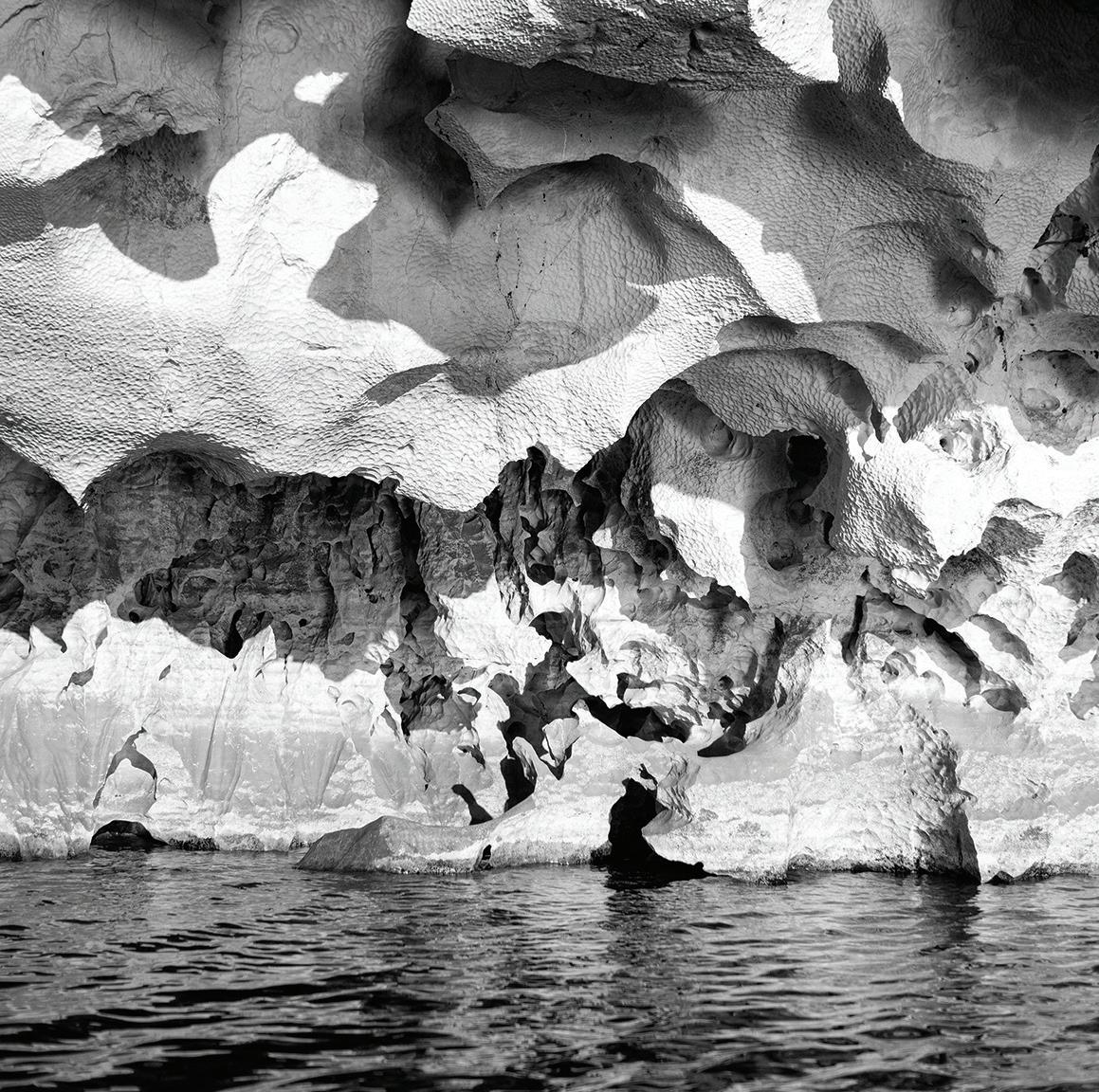
ATTRACTING AND RETAINING TALENT
MATERIAL TOPIC: ATTRACTING AND RETAINING TALENT
OUR MANAGEMENT APPROACH
Our people are the foundation of our business and instrumental to our growth and success. In FY23, MinRes employed 5,687 people7, an increase of 47 per cent when compared to FY22. It is critical for our business to identify, attract and retain high quality talent to help us meet our objectives. This is supported by our People team who work to build organisational capability by ensuring our people are treated fairly, have access to career development opportunities and have a positive employee experience.
As competition for quality talent continues to increase, our ability to attract, support and retain talented people is fundamental to delivering our business strategy. Our goal is to attract and retain people who are aligned to our values and those who are considered best industry talent. In FY23, we increased our overall female representation in the workplace from 20 per cent to 22 per cent (including internal construction workers), hiring 2,884 new employees, 23 per cent of which were female. Refer to Diversity and Inclusion for further information.
ATTRACTING TALENT
FY23 HIGHLIGHTS
To ensure MinRes is well positioned to attract top talent, in FY23 our People team drove several initiatives to support our ambitious growth plans.
Recruitment campaigns and talent acquisition
• Launched the Onslow Iron recruitment campaign ‘Expect Better’ in April 2023, comprising of out-of-home and digital advertising in Western Australia. The campaign resulted in 131 hires to date.
• Launched an international recruitment campaign ‘Guaranteed’ in November 2022 in New Zealand (NZ) to attract key skilled workers. The campaign resulted in 24 hires to date.
• Attended and sponsored the United Kingdom (UK) Down Under Live international recruitment expos in Birmingham and London in October 2022. The visit presented an opportunity to build connections with UK-based recruitment agencies and present career prospects to 1,200 event attendees.
• Concluded a six-month national awareness campaign in March 2022 to promote a new employee value proposition and highlight MinRes as an employer of choice. The advertising message “get your best life” encouraged potential employees to seek out a rewarding career with MinRes. The campaign resulted in 1,600 applications.
• Delivered the campaign “The Work. The Lifestyle” via the Australia and NZ Magazine, social media and event branding. The first hire commenced work in 2023 as an electrician for CSI Mining Services (CSI).
7 This figure does not include contractors or Non-Executive Directors.
WE SUPPORT BUSINESS GROWTH AND PERFORMANCE BY PROVIDING LEARNING AND DEVELOPMENT PATHWAYS THAT INTRODUCE NEW TALENT AND DEVELOP EXISTING TALENT.
GRI Indicators 3-3 | 401-1 | 401-2 | 404-1 | 404-2 | MM4 SDG Targets 4.3
New Reward Framework approved for
in FY24
implementation
Formation of strategic partnership with Curtin University to drive innovation in mining
86 I MINERAL RESOURCES LIMITED 2023 SUSTAINABILITY REPORT
23 per cent of new hires identifying as female
Talent engagement and branding
• Delivered a unique event experience to 14,563 school children and students as partner of the 2023 Resources Technology Showcase. The interactive MinRes activation brought to life the world of lithium, showcasing the many ways lithium is powering modern technology, future careers and guiding the world’s transition to a cleaner energy future.
• Sponsored the Recruit WA event at Ascot Racecourse in June, with two activation zones including a recreation of the new resort-style accommodation, and a showcase of new equipment on display. Over 11,000 attendees visited the event across three days, allowing the recruitment team to engage with potential recruits. A total of 571 prospective employee leads were generated as part of the MinRes competition delivered at the event.
Career development and programs
• Attended and sponsored several career development events including diamond sponsorship of the three-day Get into Resources 2023 program.
• Continued our Apprenticeship Program in partnership with the Kwinana Industries Council (KIC).
• Introduced the NextGen Scholar Program in partnership with Curtin University, which offers work experience, mentoring and financial assistance to 15 students to aid their undergraduate studies in disciplines critical to MinRes’ success.
• Continued to grow our Career Entry Pathways, including apprenticeships, traineeships, entry level dump truck operator training, work experience, graduate and vacation programs, which are designed to attract new entry level talent to MinRes. Refer to Figure 14 for a breakdown of the number of individuals entering each program stream and the representation of women in these intakes.
EMPLOYEE RETENTION
While employee attraction and recruitment are important, retaining talent is critical to the success of our business and to support the Company in pursuit of significant growth opportunities. Our People team builds capability by ensuring our people are treated fairly, receive career development opportunities and enjoy positive employee experiences. A key element of employee attraction and retention is workplace culture. MinRes continues to embrace our “can do” attitude and celebrates what makes our business different.
We recognise the complexities and unique challenges associated with the mining industry, which have proven challenging for the Company when striving to maintain a skilled and dedicated workforce.
MinRes’ employee turnover rate has improved significantly, from 41 per cent in
FY22 to 22 per cent in FY23. With the aim to improve employee retention, MinRes undertook several initiatives during FY23.
Employee engagement and development
• Conducted an employee engagement survey for the second year to gain insights into what matters most to our people. The survey had a response rate of 76 per cent, providing valuable data which has informed numerous initiatives designed to increase retention.
• Continued our strong focus on providing development and career progression opportunities for our people, inviting employees to drive their own development in an environment that provides access to opportunities for growth through a mix of formal training, on-the-job learning and mentoring opportunities.
SOCIAL
CAREER ENTRY PATHWAYS (including gender breakdown) 0 20 40 60 80 Apprentices 71 Entry Level Operator ProgramDump Truck 69 Work Experience 53 Graduates 50 32 Dozer Pathway Program 20 19 Vacation Students NextGen Scholars 18 15 Entry Level Operator ProgramBlast Crew Trainees Interns 10 Trade Upgrade Grader Pathway Program 8 3 Drill Pathway Program 1 34% female
- (CONTINUED)
MINERAL RESOURCES LIMITED 2023 SUSTAINABILITY REPORT I 87 Female Male
Figure 14: Career entry pathways
• Introduced a new frontline leader program, Leadership Essentials, which has been designed to support Superintendents and Supervisors seeking to enhance their skills. The six modules of the program have been mapped to nationally recognised units of competency so that participants have the opportunity to qualify for a nationally recognised Certificate IV in Leadership and Management.
• Offered weekly employee training sessions to support performance and development opportunities through bespoke development programs such as the Adaptive Program, the Resilience Program and the Power Bites. Refer to Leadership Development for more information.
Reward and remuneration
• Created a new Reward Framework to drive fairness, consistency and transparency in remuneration and benefits across the business. This framework will be implemented in early FY24.
• Maintained an understanding of market pay and conditions to ensure MinRes is competitive in the market and our employees are fairly rewarded in line with their skills, abilities and experience.
Talent management and succession planning
• Further developed talent management and succession planning in key business areas, including the deployment of a new tool and dashboard for reporting.
• Further enhanced the performance and goals process by creating consistency in how employees are assessed against the same core performance and behaviour measures.
Employee support and wellbeing
• Continued to support returning mothers by providing a dedicated on-site lactation room in our headquarters.
REMUNERATION AND EMPLOYEE BENEFITS
Remuneration and employee benefits are an important element of attraction and retention. Our remuneration framework consists of the following elements:
• Fixed remuneration which includes competitive base salaries, allowances, superannuation and other fixed benefits
• Bonus and incentive plans to reward commitment to MinRes and share our business success with employees
• Employee share plans to enable our employees to own a part of MinRes and share in the long-term success of the business8
In addition to our remuneration framework, we offer a range of other benefits which give our employees access to deals, support and discounts to help them look after the important things in life –health, family, fun and their future.
Several of our leave benefits also extend beyond our legal requirements in Australia, including paid parental leave, which is available to all permanent employees regardless of gender. Recognised community service and volunteering is also encouraged and supported.
NON-COMPENSATION BENEFITS
• Employee Assistance Program
• Salary packaging options
• Private health insurance discounts
• Health and wellbeing assessments
• Discounted gym memberships
Securities ownership
• Hotel accommodation discounts
• Employee referral program
• Discount tool purchase
• Service awards
• Vehicle discounts
Directors and senior employees are encouraged to have a personal financial interest in MinRes and to hold securities on a long-term basis. This is subject to the MinRes Securities Trading Policy, which imposes general trading restrictions on all those who possess inside information on the Company.
Refer to our Remuneration Report for further information.
OUR WORKPLACE CULTURE
MinRes acknowledges that creating a positive workplace culture, including both the social and psychological environment of the Company, improves the attraction and retention of talent, employee satisfaction, engagement and overall productivity.
Our state-of-the-art headquarters has been built, designed and constructed in line with the International WELL Building Standards, which aims to set a new standard for employee wellbeing and ensures we provide the best conditions for our people, supporting the attraction and retention of high-quality talent. All MinRes employees and their families, including our site-based workforce, enjoy access to facilities at our headquarters.
The headquarters provides a range of facilities and services, including a restaurant and café with subsidised food and beverages, a creche, health centre, reflection room and 800sqm fitness facility. Through our investment in our headquarters, we continue to foster a positive and impactful workplace culture that caters to the needs of our workforce. We remain dedicated to improving the employee experience, empowering our team to excel in every aspect of their careers.
SOCIAL - (CONTINUED)
8 Our Employee Share Plan entitles employees to salary sacrifice up to $5,000 pre-tax salary each year towards the purchase of MinRes shares, which the company will match (double) in two years.
88 I MINERAL RESOURCES LIMITED 2023 SUSTAINABILITY REPORT
Our headquarters was shortlisted for the prestigious Australian Interior Design Awards 2023 and will be the benchmark for how we develop workplaces and our mining camps going forward.
Read more about the concepts of wellness that have been implemented at our headquarters here.
CASE STUDY: ONSLOW RESORT-STYLE ACCOMMODATION
Our Onslow Iron project in the Pilbara region will feature two resort-style accommodation villages set to create a new standard for the fly-in fly-out (FIFO) lifestyle in Australia’s mining and resources industry.
Resorts will feature rooms three times the size of traditional FIFO accommodation, each including a queen size bed, separate ensuite, laundry with washer and dryer, kitchenette, lounge, big screen television and balcony. These amenities will ensure employees make the most of their time on site and stay connected with loved ones.
Together with restaurants, a commercial gym, a swimming pool and a fully-equipped wellness centre, these facilities will help create a home-away-from-home experience like no other mining camp in Australia and encourage more women and couples to enrich our diverse workforce.
Read more about our resortstyle accommodation at Onslow here
LEADERSHIP DEVELOPMENT
MinRes encourages respect and collaboration to create a positive workplace culture, enabling the growth and development of the business and the individuals who work for the Company.
We have continued to offer a number of development initiatives, covering topics such as communication, safety, resilience and mental health. These customised programs are accessible to all employees across the business, from operations to our corporate headquarters.
• Continued the Adaptive Program, the Resilience Program and Power Bites, which focus on key performance areas including communication and physical and psychological safety. Together, these three programs have had over 700 participants since their inception, with over 250 participants in FY23.
• Launched our inaugural Inspire Female Leadership Program with content developed in collaboration with MinRes ambassador the Hon Julie Bishop. The six-month program brought together frontline leaders from across our operations, providing support for them to develop their pillars of success, personal brand, relationships and performance.
• Initiated the Leadership Essentials program, a comprehensive and tailored leadership development program designed to empower frontline leaders.
Frontline leadership
In FY23, we turned our focus to our frontline leaders. We achieved this by introducing a new leadership development program called Leadership Essentials. This bespoke program provides leaders with experiential learning, practical tools and insights from senior MinRes leaders.
The Program spans six modules that focus on core leadership accountabilities:
The modules have been mapped to nationally recognised units of competency so that participants have the opportunity to qualify for a Certificate IV in Leadership and Management.
In FY23, 101 frontline leaders were nominated to attend the Leadership Essentials program, of which 92 per cent decided to pursue a formalised qualification. The program was designed to provide various learning methodologies, such as in-person group learning, peer group mentoring sessions and on-site coaching. Participants receive over six hours of individualised coaching throughout the duration of the program.
The roll-out of the program will continue throughout FY24, with our goal to continue providing development opportunities for all our frontline leaders.
CAREER ENTRY PATHWAYS
During FY23, we expanded and increased our Career Entry Pathways. These pathways include training to entrylevel operation roles, apprenticeships, traineeships, work experience, graduate, vacation and internship programs, which are designed to attract new talent to our Company.
Our approach to capability development is that we must build our talent pipeline sustainably by improving diversity and inclusion, attracting quality candidates and promoting shared experiences and development opportunities across MinRes.
SOCIAL - (CONTINUED)
Leading Values Leading Safety & Wellbeing Leading Communication Leading People Leading Production Leading Cost
MINERAL RESOURCES LIMITED 2023 SUSTAINABILITY REPORT I 89
Entry level programs
The MinRes Entry Level Program (ELO) continues to enable us to successfully fill market gaps, while growing a second generation of the MinRes workforce.
Over a three-month duration, our program offers a comprehensive blend of safety and operation induction, one-on-one simulator training and intensive on-site coaching conducted by our Training team. This structured approach focuses on skill development, gradually advancing participants through increasing complexity levels.
In FY23, we onboarded 79 new employees to our Dump Truck Operator ELO and Blast Crew ELO programs, achieving a 52 per cent female participation rate in both programs combined.
To ensure the highest quality of training and feedback, we currently limit the number of trainees to one individual per machine. This approach enables us to provide highly personalised and specialised training tailored to the unique needs of each trainee.
Read more about our new training facility here
Apprentices
The MinRes Apprenticeship Program aims to support and develop our apprentices into high performing and successful members of our workforce. The program aims to:
• ensure our apprentices receive a high-quality learning experience and are well supported on their learning journey
• provide experiences, exposure and opportunities that support apprentice development
• develop appropriate behaviours for the workplace and interpersonal skills.
During FY23, MinRes employed 71 apprentices across a range of trades including heavy duty fitters, electricians, boilermakers and mechanical fitters, representing an increase of 25 per cent from the previous financial year.
We continue to expand our Apprenticeship Program by offering trade upgrades to current employees as opportunities for career development. To support our apprentices, we have two dedicated full-time apprentice mentors who provide pastoral care, mentoring and guidance to help support their professional and personal development. Through our partnership with Youth Focus, employees under the age of 25 have access to a counsellor trained to assist and support young people.
Trade upgrades
The growth and development of our people is key to our future success, and we need to ensure they have the right capabilities to make a positive impact on our future. We are committed to providing professional development opportunities for our employees. During FY23, MinRes offered trade upgrades to eight employees. This program, in partnership with Technical and Further Education (TAFE), upskills current employees to help them obtain a new trade qualification. The focus of this program has been to address the skills shortage by providing apprenticeship upgrades to heavy diesel mechanics and auto electricians.
In FY23, we reviewed our Trade Upgrade Program to ensure we continue to provide development opportunities for our people, by establishing clear guidelines and expectations around program duration and the commitment required from our participant employees. The revised program will allow us to increase our pathways and allow trades people to continue to progress in their career across the Company. The program is due to be launched by the end of 2023, with 10 new positions offered to employees.
Trainees
In addition to our Apprenticeship Program, we also offer several traineeship programs with registered training organisations.
During FY23, we trained and onboarded one cohort from our Crushing Traineeship Program. The program consists of a 12-month structured training curriculum, providing participants with the essential skills and knowledge gained through practical training at our remote sites. On successful completion of the program, participants receive a Certificate III in Resource Processing, providing trainees the opportunity to kick start their career in mining with no previous experience required.
We also launched two new traineeship programs:
• Serviceperson Traineeship: aligned with a Certificate II in Automotive Service Technology
• Tyre Fitter Traineeship: aligned with a Certificate II in Automotive Tyre Servicing Technology.
These programs use a hybrid teaching model which includes online and classroom-based learning, mentor led and on-the-job training. During FY23, 32 trainees were part of these programs, of which 31 per cent identified as female.
Graduates
The MinRes Graduate Program is a 24-month structured program, internally developed and assessed across a mixture of site and office-based rotations. Our FY23 intake welcomed 24 graduates, taking our total to 50 graduates. Our graduates span a variety of technical and support service disciplines including Engineering (Mining, Process and Mechanical), Geology, Finance, Health, Land Access and Heritage, Safety and Environment.
SOCIAL - (CONTINUED)
90 I MINERAL RESOURCES LIMITED 2023 SUSTAINABILITY REPORT
“SURROUND YOURSELF WITH PEOPLE WHO HAVE DIFFERENT KNOWLEDGE TO YOURSELF. ALWAYS COLLABORATE AND EMPOWER THOSE AROUND YOU.”
Chris Harris | Head of Mental Health

“GREAT LEADERSHIP IS ABOUT RECOGNISING THAT LEARNING NEVER ENDS AND INSPIRING OTHERS TO COME ALONG FOR THE JOURNEY.”
Claire Haynes | Principal Organisational Development


During FY23, we conducted a comprehensive review of our Graduate Program, which included a review of the individual’s development plans, performance and goals. This was undertaken to improve their engagement and sense of belonging within the Company.
In FY24, we plan to introduce a capability framework for graduates, which will further assist our leaders and graduates in providing greater role clarity and purpose when planning development goals.
Vacation students
In FY23, we reviewed and re-launched our Vacation Program. This structured 12-week program, held during the summer, actively involves undergraduate students who are embarking on their final year of university studies.
During FY23, we welcomed 18 students, each of whom had the opportunity to contribute to at least one significant project throughout their 12-week placement. This experience provides students with exposure to various aspects of our organisation, spanning both our MinRes headquarters and our operational sites.
Upon successful completion of the Vacation Program, eligible students may receive an offer to join our Graduate Program. This next step provides them with a platform to kickstart their professional journey with MinRes.
PROMOTING CAREERS IN THE MINING INDUSTRY
MinRes is committed to supporting different scholarship programs. Our goal is to support communities across WA, increase our ability to attract specific skills and promote career pathways.
In FY23, MinRes supported various initiatives and organisations to promote careers in the mining industry.
• Established an important values-based partnership with Curtin University in addition to MinRes’ 2021 pledge to support the Moorditj Yorga Scholarship, which provides four scholarships per year for mature-aged Indigenous Australian women to attend Curtin University and complete a course of their choice.
• Introduced the NextGen Scholar program which awarded 15 students from Curtin University with work experience, mentoring and financial assistance to support their studies. This program also aims to support the next generation of talented individuals who will become future technical experts and leaders in their respective fields. The participants all study undergraduate degrees in disciplines that are critical to MinRes’ success, including Metallurgy, Electrical Engineering, Civil Engineering, Mining Engineering, Surveying, and Geology.
• Continued to provide scholarships at Rockingham Senior High School. This scholarship program supports students who excel in hands-on skills and have achieved outstanding results in trade-related areas of study. The funding goes towards the recipients’ TAFE fees, school fees, books and uniforms.
• Continued to strengthen our relationship with the Kwinana Industries Council (KIC), which supports the growth, development and sustainability of businesses in the Kwinana industrial area.
• Continued our sponsorship of the iWomen Project, an initiative promoting career opportunities in the mining sector to Year 10 female students from the KIC and collaborating schools in the region. This included hosting 24 female students on work experience placements at our Kwinana workshop.
• Hosted 53 students from Years 11 and 12 on work experience placements across the Company.
• Partnered with PMW Industries to implement MinRes’ first ever Indigenous Trainee Operator Program, supporting longterm employment and business opportunities for Indigenous Australians.
• Sponsored several career development events including the Get into Resources event, the Resources Technology Showcase 2023, the AusIMM Perth Student Chapter’s Student Meets Industry event and several university graduate fairs. These events were attended by employees across the Company who engaged with students and offered advice on career pathways available within the industry and at MinRes.
WORK EXPERIENCE OPPORTUNITIES
KIC pre-apprenticeship support
CSI Mining Services (CSI), a wholly owned subsidiary of MinRes, is an associate member of the KIC and has a long history supporting the growth, development and sustainability of business in the Kwinana industrial area.
The KIC Introduction to Careers in Industry is a two-year program designed for females, with the aim of encouraging greater diversity in the industry. Students undertake the program during Years 11 and 12 alongside their school studies. Through support of this program, MinRes aims to create a talent pipeline of female apprentices for future intakes of our Apprenticeship Program.
Another initiative of KIC is the Metals and Engineering School Based Traineeship, which provides Year 11 and 12 students with the skills needed to graduate with a Certificate II in Engineering.
During FY23, we hosted 53 students in partnership with KIC providing work experience placements and donating toolkits to the students. The work experience rotations included steel fabrication, electrical and mobile equipment maintenance, light and heavy fitting.
MinRes participation in the KIC Traineeship provides our business with an opportunity to employ skilled pre-apprentices and students with a career pathway to MinRes.
SOCIAL - (CONTINUED) MINERAL RESOURCES LIMITED 2023 SUSTAINABILITY REPORT I 93
Internships
In FY23, MinRes provided 19 internship opportunities to students from diverse disciplines and academic experience, which achieved 47 per cent female participation. These internships were designed to provide students with invaluable practical experience in their respective fields of interest, all while continuing their studies.
By participating in our internship programs, students gain the unique opportunity to apply their academic knowledge to real-world scenarios, fostering a deeper understanding of their chosen professions. This hands-on experience serves as a steppingstone towards their future careers, empowering them with the skills and insights necessary to thrive in their respective industries.
At MinRes, we firmly believe that investing in the growth and development of emerging talent not only benefits individuals but also contributes to the advancement of our Company as a whole. We remain steadfast in our commitment to providing meaningful opportunities that shape the professional journey of aspiring individuals.
OPERATIONAL AND ORGANISATIONAL TRAINING
Providing high-quality and up-to-date training solutions is important to ensure our people are equipped and supported to have a positive impact on our organisation. The MinRes Training and Compliance Policy formalises our commitment to providing our workers with the appropriate knowledge, skills and understanding to safely and effectively complete tasks to the expected standard of performance.
MinRes has a dedicated Training team who identify training needs within the business based on the scope of specific roles and associated work activities. MinRes implements a Learning Management System (LMS), which allows all employees and contractors to complete online learning modules. Each individual’s development plan, located on the LMS, outlines specific training needs for their role.
CASE STUDY: INDIGENOUS TRAINEE OPERATOR PROGRAM
MinRes established a partnership with PMW Industries to implement our first ever Indigenous Trainee Operator Program, supporting long-term employment and business opportunities for Indigenous Australians, as well as supporting the local community.
PMW Industries is a 100 per cent Indigenous-owned business specialising in providing high quality rail, civil and earthmoving services.
The traineeship combines work and study, providing participants with a nationally recognised qualification on completion – a Certificate III in Resource Processing. MinRes CSI will provide the technical expertise and experience while facilitating the traineeship, building capacity and long-term employment opportunities.
Read more on the MinRes Indigenous Trainee Operator Program here
LOOKING FORWARD
Going forward, MinRes aims to achieve various objectives to continually support attracting and retaining talent to our Company.
• Implement a new leadership capability framework which will provide greater visibility of behavioural expectations for all leaders.
• Continue to expand the Leadership Essentials Program to all frontline leaders.
• Develop and implement leadership development opportunities for other levels of leadership across our business.
• Establish and implement a Development Hub which will provide a catalogue of growth opportunities for our employees.
• Continue to improve our Talent and Succession Planning process.
• Seek and act on our employees’ feedback as part of the Your Voice survey and improve our total engagement score.
• Enhance our performance management process to track key performance indicators and provide employee feedback throughout the year to ensure alignment with the broader Human Resources Information System strategy.
• Implement a consistent onboarding process across all our locations.
SOCIAL - (CONTINUED)
94 I MINERAL RESOURCES LIMITED 2023 SUSTAINABILITY REPORT

DIVERSITY AND INCLUSION
MATERIAL TOPIC: DEVELOPING A DIVERSE AND INCLUSIVE WORKPLACE
OUR MANAGEMENT APPROACH
MinRes recognises the importance of creating and maintaining a diverse, inclusive and non-discriminatory workplace that values diversity of thought and experience. We know that celebrating our differences plays a vital role in our growth, culture and long-term success, with several benefits such as improved organisational performance, positive impact on our culture and reputation, increased employee attraction and retention, and stronger internal, customer, and stakeholder relationships.
At MinRes, we firmly believe in fostering diversity at all levels, regardless of gender identity, nationality, marital or family status, sexual orientation, age, disability or impairment, neurodiversity, Indigenous Australian identity, ethnicity, cultural background, religious beliefs, political conviction, union membership, socioeconomic background, perspective, or life experience. This commitment is outlined in our Diversity and Inclusion Policy
FY23 HIGHLIGHTS
In FY23, our primary focus was on bridging the gap in participation rates of those who identify as female and Indigenous Australian, as well as initiating efforts to raise awareness of the LGBTIQA+ community. We also commenced our membership with Diversity Council Australia to provide employees with resources across all diversity dimensions and invitations to attend events and programs offered through the membership.
FEMALE DEVELOPMENT AND EMPLOYMENT
To demonstrate our commitment to female attraction, engagement and retention, our Gender Equity Strategy, introduced in FY23, saw us work diligently to eliminate gender pay gaps and improve female representation across all areas of the Company. The Gender Equity Strategy incorporates seven key focus areas across gender balance, pay equality, leadership, governance, gendered violence and respectful workplace behaviours, which will be delivered over a three-year period.
During FY23, we continued to focus on the representation of females in our workplace and achieved our Gender Equity Strategy target of increasing female participation by 10 per cent year on year (excluding our internal construction workforce), with 22.6 per cent participation. We also hired 671 females and increased female representation on our Board. These results are due to our broader focus on talent sourcing and retention.
We are committed to improving gender diversity through the implementation of various initiatives which aim to attract, retain and develop our female talent, while fostering a supportive work environment for our female employees.
WE STRIVE TO CREATE A FAIR, DIVERSE AND INCLUSIVE WORKPLACE WHERE EVERYONE FEELS VALUED, INCLUDED AND EMPOWERED.
GRI Indicators 3-3 | 405-1 SDG Targets 5.1 | 5.5 | 8.5 | 10.2
37.5 per cent female participation on our Board
3.5 per cent Indigenous Australians participation in our workforce
96 I MINERAL RESOURCES LIMITED 2023 SUSTAINABILITY REPORT
22 per cent female participation across our workforce
These initiatives include:
• improving recruitment practices to foster gender inclusivity with more stringent measures to ensure new roles consider female applicants equitably
• conducting gender safety focus groups across our operations to understand the lived experiences of our female employees
• establishing a female personal protective equipment (PPE) range available to all employees, including maternity wear
• opening a crèche at our headquarters which is fully subsidised for employees
• dedicated parents’ rooms at our headquarters
• established mentoring circle for senior female leaders with the Hon Julie Bishop
• providing development opportunities to drive conversations and grow successful careers in mining through our gold membership with the National Association of Women in Operations (NAWO)
• providing 18 weeks primary carer leave and four weeks secondary carer leave available to all employees
• ongoing commitment to gender pay equity
• participation with various professional associations, including the Australasian Institute of Mining and Metallurgy (AusIMM), Association of Mining and Exploration Company (AMEC), Chamber of Minerals and Energy (CME) and Women in Mining WA (WIMWA)
• participating in the AusIMM International Women’s Day lunch celebrating the achievements of women in the industry.
Read more about our Inspire Female Leadership Program here
This year, MinRes established a quarterly female leader mentoring circle with the Hon Julie Bishop, which facilitates networking among female leaders throughout the Company, fostering discussions on professional growth, and offering guidance and support. During FY23, seven female leaders at General Manager level participated.
We continued to welcome new employees into our entry-level pathway programs, with 369 employees joining in FY23, of which 34 per cent were female. The MinRes Entry Level Operator Program, which supports new mining operators and provides practical operational experience to trainees to attain a Dump Truck Operator role saw 55 per cent female participation. In addition, our Apprentice program received the greatest number of female applicants, with 15 females joining the program. Refer to Career Entry Pathways for further information.
In FY23, our sponsorship with NAWO facilitated the participation of 27 women in the NAWO mentoring program. This program connects female mentees with experienced leaders from various industries and member companies through four mentoring sessions.
CASE STUDY: CELEBRATING WOMEN
International Women’s Day provides a platform to celebrate women’s achievements and advocates for gender parity. For International Women’s Day 2023, three events were held to mark the occasion and celebrate the women of MinRes and our industry.
CELEBRATING STRONG WOMEN PANEL
Female development
At MinRes, we provide several training and professional career development programs for our female employees to promote gender equity in the workplace.
During FY23, MinRes launched the Inspire Female Leadership Program, which focused on career resilience, leadership development and fostering connections among women within the business. The program consisted of six workshops delivered over six months for select female employees. To date, three cohorts have been successfully implemented, benefiting a total of 44 female employees. Notably, following the initial pilot program, 33 per cent of the 14 participants were promoted to leadership positions within six months of the program’s commencement. The program will continue throughout FY24.
MinRes hosted a panel discussion “Celebrating Strong Women” featuring key executives and the Hon Julie Bishop as panelists. The panel discussed topical issues faced by women and how individuals can empower and support the next generation of strong women. The audience also had the opportunity to ask questions and participate in the dialogue. The event was a huge success with the largest employee attendance for an event since moving to our new headquarters.
Click the video link to hear from our Non-Executive Director Susie Corlett on building a diverse and inclusive workplace.
SOCIAL - (CONTINUED) MINERAL RESOURCES LIMITED 2023 SUSTAINABILITY REPORT I 97
I AM MINRES – INTERNATIONAL WOMEN’S DAY
Following the success of the I AM MINRES portrait collection, our International Women’s Day pop-up exhibition showcased five outstanding participants from our inaugural Inspire Female Leadership Program. The exhibition took place at Benny’s restaurant at our MinRes headquarters, providing employees with the opportunity to view the photographs and watch the videos captured by MinRes Brand Director and renowned photographer, Russell James.
Read more about our five outstanding participants here
BRIGHTER FUTURE FOR WOMEN
MinRes partnered with Australian Super to deliver two sessions discussing the gender superannuation gap and tips to maximise superannuation contributions. Over 30 female employees across MinRes operations attended the sessions online and in-person at MinRes.
Pay equity
MinRes is working hard to improve gender diversity while creating an environment of fairness, equity and opportunity for every MinRes employee. We are committed to ensuring that all employees are paid fairly and equitably, without any discrimination based on gender.
The Gender Equity Strategy saw us work hard to eliminate gender pay gaps and improve female representation across all areas of the Company. During FY23, MinRes reported no gender pay gaps for comparable positions. MinRes is committed to conducting a formal gender pay review annually to ensure salaries are equitable on a role-by-role basis.
INDIGENOUS DEVELOPMENT AND EMPLOYMENT
In FY23, MinRes took progressive steps to provide real considered employment opportunities and support mechanisms for Indigenous Australians during their employment at MinRes.
We aim to build a workplace that understands, supports and champions Indigenous Australians through:
• creating a culturally supportive and safe work environment
• increasing representation of Indigenous Australians in our workforce
• reducing structural, process and cultural barriers to employment for Indigenous Australians
• contributing to the elimination of discrimination and harassment based on race
• promoting an inclusive workplace culture through education, flexible mindsets, work practices and physical environment.
Increasing Indigenous Australian employment and retention remains a key priority for MinRes. In FY23, 164 roles were offered to Indigenous Australian candidates, representing an increase of 93 per cent from FY22. This is a result of appointing dedicated Indigenous employment professionals to engage with Traditional Owners and the wider Indigenous community to focus on sourcing Indigenous candidates.
MinRes commenced its employee retention initiatives in FY23 by appointing site-based Indigenous engagement professionals to support site-based personnel. Indigenous employee retention will continue to be a key focus for FY24, with the investigation of a regional Indigenous Employment Hub to provide on Country support to Indigenous employees.
CASE STUDY: INDIGENOUS ENGAGEMENT SESSION
MinRes hosted its first Indigenous engagement session at the MinRes training facility in April 2023. The engagement session was exclusively offered to Indigenous Australians who have demonstrated an interest in joining MinRes. Attendees received a comprehensive overview of the Company, participated in group activities and underwent an interview with MinRes hiring managers.
The session attracted 56 potential candidates, 19 of whom had existing skills which were matched to existing vacancies. The session allows for candidates to be pre-qualified for positions within MinRes, providing an advantage for candidates to be ready for placement during the recruitment stages.
The team received overwhelmingly positive feedback from participants following the event with a total of 20 offers made to Indigenous Australian candidates.
SOCIAL - (CONTINUED)
98 I MINERAL RESOURCES LIMITED 2023 SUSTAINABILITY REPORT
In FY23, MinRes celebrated the appointment of our first Indigenous Board member, Emeritus Professor Colleen Hayward AM, as an Independent Non-Executive Director. Colleen Hayward is a senior Noongar woman with over 35 years of experience developing and leading programs to support and empower Indigenous Australians in Western Australia.
SUPPORTING FAMILIES AND NEW PARENTS
During FY23, MinRes launched its new Parental Leave Guideline to demonstrate our family values and recognise all family types at MinRes. The notable changes to parental leave included:
• terminology changes from pregnant employee to primary and secondary carer
• removal of the 12-month waiting period
• covering birth, adoption, surrogacy and stillbirth
• primary carers receiving 18 weeks paid leave
• secondary carers receiving four weeks paid leave
• 10 paid keeping-in-touch days
• superannuation paid on unpaid portion of parental leave (capped at 12 months)
• breastfeeding support.
MinRes also has a Flexible Work Procedure, which supports the commitment in our Diversity and Inclusion Policy as an enabler of employment. In FY23, 1.6 per cent of our employees were under a part-time employment contract. MinRes provides support to employees and their families, through our International WELL Standard headquarters, which provides creche services at our NextGen Creche facility. Returning parents can access the feeding rooms at our headquarters including a 50 per cent subsidy for breastfeeding support and the option to purchase a portable breast pump. Refer to Our Workplace Culture for further information.
During FY23, MinRes commenced construction on our Onslow Iron project, the future site of resort-style accommodation. This camp aims to set a new standard for FIFO accommodation by supporting couples, creating a safe working environment, and promoting employee health and wellbeing. Refer to Onslow Resort-Style Accommodation for further information.
CASE STUDY: FIFO AND ME
“FIFO and Me” is a children’s book about iron ore mining and addressing the unique experiences faced by children whose parents work in the FIFO mining industry. The book aims to raise awareness and provide understanding about the FIFO lifestyle among children between the ages of four and eight. A second edition titled “Mum and Me” focuses on highlighting women thriving in a maledominated industry. Currently, 75 per cent of our workforce at MinRes are FIFO, many of whom have families they leave for extended periods of time. Our core value at MinRes is family, and supporting our employees and their families in understanding their work is essential.
MinRes purchased 1,200 copies of “FIFO and Me” and 300 copies of the “Mum and Me” books, each with a personalised message inside that reads, “From your MinRes Family”, along with the signature of Managing Director Chris Ellison. These books were delivered to our employees based at iron ore owner-operated sites in the weeks leading up to Christmas. Additionally, the books are featured in our NextGen Creche at the MinRes headquarters. The book has been well received by employees with additional copies also sent to employees returning from parental leave.
LGBTIQA+ AWARENESS
In FY23, MinRes commenced its awareness raising campaign of the LGBTIQA+ community including the celebration of WA’s PrideFEST by participating in Perth Pride Luncheon, a MinRes corporate booth at the Pride Fairday and launching MinRes pride lanyards.
SOCIAL - (CONTINUED)
MINERAL RESOURCES LIMITED 2023 SUSTAINABILITY REPORT I 99


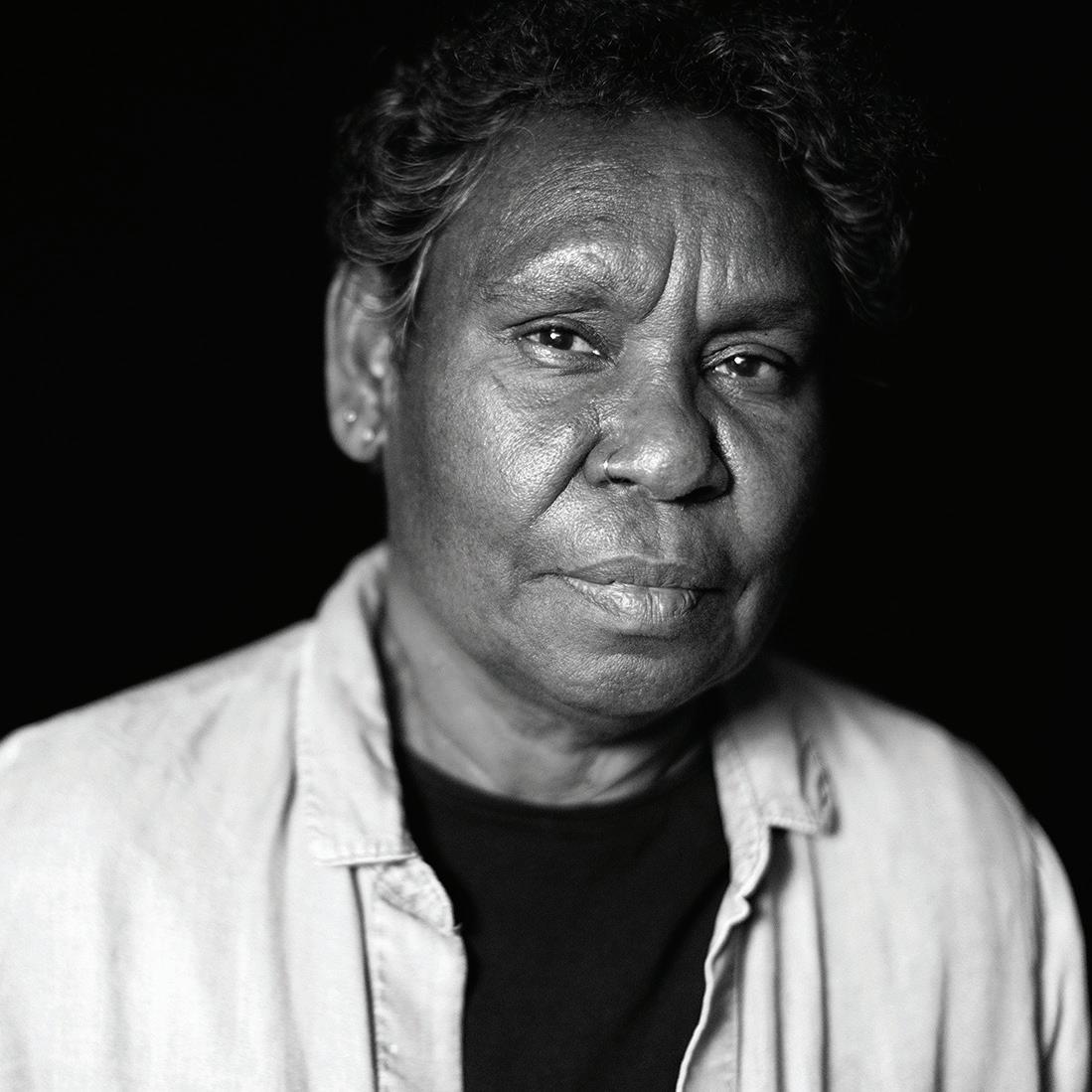
“THE WAY YOU CONDUCT YOURSELF AS AN ELDER IS IMPORTANT. BE KIND, SHOW RESPECT. ”
Georgina Bobby | Robe River Kumara Elder | Pilbara region, WA
“GREAT LEADERSHIP CHARACTERISTICS NEED TO WORK TOGETHER IN HARMONY, INCLUDING HUMILITY, DETERMINATION AND EMOTIONAL INTELLIGENCE.”
Andrea Chapman | Executive General Manager People

FAIR WORK
MinRes aims to develop and maintain strong ongoing relationships with our people based on mutual trust and open lines of communication. As we operate in Australia, the Fair Work Act 2009 (Cth) and the Fair Work Regulations 2009 (referred to as Fair Work Legislation) govern the employer/employee relationship.
The Fair Work Legislation provides a safety net of minimum entitlements for employees, enables flexible working arrangements and fairness at work and prevents discrimination against employees.
Non-discrimination
Our Code of Conduct and Business Integrity (the Code) represents our commitment to uphold the highest standards of ethics and integrity in our business. The Code applies to all employees, directors, officers and contractors of MinRes and its subsidiaries.
Through the Code we are committed to creating an environment where differences are respected and the working environment is diverse and inclusive. We do not permit discrimination, bullying or harassment at any level of MinRes or in any part of the employment relationship. During FY23, we continued implementing our e-learning package on the Code throughout the Company with over 90 per cent of our employees completing this training in the financial year. We remain committed to our annual training requirements.
Supporting our Code is the Safe and Respectful Behaviours Procedure. This Procedure outlines the definitions of discrimination, bullying, harassment and victimisation, and provides guidance on the steps taken to investigate and address any complaints of inappropriate workplace behaviour. MinRes offers bias awareness, bullying, discrimination and harassment training.
SAFE AND RESPECTFUL BEHAVIOURS
MinRes is dedicated to taking any steps necessary to ensure our workplace is safe and all people feel valued and included. This means feeling safe and respected at work, in camp accommodation, during travel and at work-related events. Any person in our business who has witnessed or experienced sexual harassment, sexual assault or any behaviour that doesn’t align with the Code is encouraged and supported to report through internal channels or externally through our confidential whistleblower hotline, MinRes Integrity Assist (refer to Whistleblowing Provisions for further detail). We identify a safe and respectful culture as one which is values driven, where the reporting culture is driven by a strong commitment to our MinRes family and keeping our family safe. Refer to Safe and Respectful Behaviours for further information.
Domestic violence
MinRes is committed to preventing violence against women and acknowledges that violence against women is caused by
and reinforces gender inequality. Our Code recognises that all our employees have a right to work in an environment free from violence, aggression, discrimination, bullying and harassment, including sexual harassment. MinRes actively supported White Ribbon Day, the national day for the prevention and elimination of violence against women.
Additionally, MinRes has an established Family and Domestic Violence Procedure outlining the important role leaders play in ensuring our people are guided and supported through challenging times.
GRIEVANCES AND DISPUTES
Our grievance mechanism is a critical component for employees to raise concerns and seek resolution to disputes or grievances in the workplace, in turn building an improved workplace culture. In FY23, MinRes launched the Speak Up mailbox as an additional reporting option for employees to confidentially raise concerns internally.
The MinRes Speak Up Procedure outlines the process for employees to raise and seek resolution to disputes or grievances in the workplace. Grievances and disputes are treated seriously, promptly and sensitively, with due regard for procedural fairness and confidentiality.
Employees are encouraged to speak with their line manager, the People team or leader. If concerns are not addressed or the individual seeks anonymity through the reporting process, they can report externally through our confidential whistleblower hotline, MinRes Integrity Assist. Refer to Whistleblowing Provisions for further information.
MinRes does not support use of non-disclosure agreements to silence employees who report any form of workplace discrimination, harassment, bullying or violence in the course of their employment and these will not be used by the Company, unless requested by the complainant.
Rights to freedoms of association
Freedom of association is preserved under Australian law and supported by global standards such as the International Labour Organisation Convention on Freedom of Association and Protection of the Right to Organise. MinRes respects the rights of all employees to join and form a trade union of their choice in accordance with national law. During FY23, 30 per cent of MinRes employees were covered by collective bargaining agreements, with a further 40 per cent covered by a Modern Award.
We ensure appropriate management of union right of entry through our Right of Entry Procedure, which outlines our practices to ensure we align with legislative rights and responsibilities.
SOCIAL - (CONTINUED)
MINERAL RESOURCES LIMITED 2023 SUSTAINABILITY REPORT I 103
OUR DIVERSITY AND INCLUSION PERFORMANCE EMPLOYEE DIVERSITY
During FY23, we achieved our target to increase female participation by 10 per cent year-on-year, with women now making up 22.6 per cent of our workforce (excluding internal construction workers). During FY23, the representation of those who identify as Indigenous Australian almost doubled, with a total of 3.5 per cent (Table 6). MinRes recognises the need to improve both our female and Indigenous Australian representation, which will be a key focus during FY24.
1 Excluding internal construction workers.
Table 7 shows our employee statistics per employee category based on gender, Indigenous Australian identity and age profile. In FY23, we continued to make progress across our employee categories, with an increase in female representation across management and professionals categories, increasing by 85 per cent and 82 per cent respectively. Additionally, Indigenous Australian participation across our professionals rose by more than 350 per cent, along with a further 183 per cent increase in our operational, support and services employees. Across all employment categories, we will continue to focus on increasing diversity over the next five years.
Refer to our 2023 Sustainability Performance Data Tables for historical periods and data breakdowns.
1 External limited assurance is provided over our FY23 gender balance per MinRes categories. Refer to page 181 for a copy of the Independent Limited Assurance Statement.
FY21 FY22 FY23 Overall Female Representation1 (%) 17.0 20.3 22.0 Overall Indigenous Australian Representation (%) 1.8 1.8 3.5
Table 7: Percentage employee diversity
SOCIAL - (CONTINUED) 104 I MINERAL RESOURCES LIMITED 2023 SUSTAINABILITY REPORT MinRes Category % Gender1 % Indigenous Peoples % Age Female Male Under 30 30-50 Over 50 C-Suite 12.5 87.5 0 0 50 50 Executives and Senior Management 11.0 89.0 0 0 50.7 49.3 Management 14.3 85.7 0.5 1.2 66.2 32.6 Professionals 30.0 70.0 1.7 19.4 63.2 17.5 Operations, Support and Service 21.4 78.6 4.2 18.8 54.6 26.6
Table 6: Overall female and Indigenous Australian representation

DIVERSITY IN LEADERSHIP
Senior leaders are responsible for driving gender equity as a key organisational deliverable and ensuring operational decisions consider the impact on gender equity and, more broadly, driving an organisational culture that values diversity and supports inclusivity.
In FY23, our Board comprised five male members (62.5 per cent) and three female members (37.5 per cent). The average age of our Board is 58 years, with one member (12.5 per cent) between the ages of 40 and 50, four members (50 per cent) between the ages of 50 and 60 and the remaining three members (37.5 per cent) aged over 60 years. One Board member identifies as Indigenous Australian (Figure 15).
EMPLOYEE PERCEPTION SURVEY
During FY23, MinRes conducted an employee engagement survey, called Your Voice, for the second year to gain insights into what matters most to our people. The Your Voice survey provided benchmark data on workplace culture, allowing us to gather anonymous feedback and review trends and opportunities for improvement. The survey assessed 15 engagement factors, with over 3,100 employees (76 per cent) contributing to the results, which ranks above the industry participation benchmark. The overall engagement factor scored 69 per cent, ranking marginally below the Resources and Utilities industry benchmark. The survey will be conducted annually.
LOOKING FORWARD
We continue to support initiatives that promote attracting and retaining talent while fostering a diverse and inclusive workforce. In FY24 we plan to:
• launch our Indigenous Employment Strategy to the workforce and continue to provide Indigenous engagement sessions in metro locations and commence in regional locations
• conduct two Inspire Program cohorts targeting emerging leaders
• provide divisional diversity reports on a quarterly basis to support our organisational commitment to increasing female and Indigenous Australian representation
• complete a formal gender pay review
• continue to broaden entry-level pathways to support emerging female talent.
The Safe and Respectful Behaviours program for FY24, will include:
• quarterly Safe and Respectful Behaviour Return to Work programs
• Gender Safety Audit focus groups at each MinRes location to explore gendered violence, power imbalances and workplace culture in a deep dive approach
• Launch of a Safe and Respectful Behaviours interactive refresher training to the workforce, which will explore microaggressions
• Roll-out of Bystander training to employees located across sites
• Development of a Contact Officer Program to further support employees at our sites.
SOCIAL - (CONTINUED) 106 I MINERAL RESOURCES LIMITED 2023 SUSTAINABILITY REPORT
INDEPENDENCE TENURE COUNTRY OF BIRTH GENDER AGE GROUP Executive Non-Executive 0-10 years 10+ years International Australia 12% 12% 25% 37% 17% 17% 33% 33% 83% 88% 67% 67% 83% 75% 67% 88% 25% 33% 63% 75% FY23FY22 FY23FY22 FY23FY22 FY23 F Y 22 Female Male 30-50 50+ FY23FY22
Figure 15: Board composition and diversity

LAND ACCESS AND CULTURAL HERITAGE
MATERIAL TOPIC: PROTECTION OF LAND ACCESS AND CULTURAL HERITAGE
OUR MANAGEMENT APPROACH
MinRes recognises and respects the Traditional Owners of the land on which our operations are located and their connection to culture and heritage. We recognise their connection to Country, prioritise mutually beneficial relationships and are committed to the management, protection and preservation of cultural heritage. At MinRes, we respect internationally recognised human rights principles, including those contained in the United Nations (UN) Universal Declaration of Human Rights and the UN Declaration on the Rights of Indigenous Peoples. We acknowledge and respect the human rights principles of Free, Prior and Informed Consent (FPIC), which highlights the importance of consulting with people in making decisions that affect their lives, and we strive to consider this across our operations.
MinRes has established a robust governance framework enabling us to build positive and sustainable relationships with our host communities, including Indigenous Australians. During FY23, MinRes reviewed and strengthened our:
FY23 HIGHLIGHTS
• Indigenous Peoples Policy
• Community Policy
• Human Rights Policy
• Community and Stakeholder Engagement Strategy
• Aboriginal Employment Strategy
Additionally, MinRes has developed supporting procedures and standards to provide guidance on the identification, protection and prevention of unauthorised disturbance to cultural heritage sites resulting from our operations and business activities, including the below procedures and standards.
• Heritage Management Procedure
• Heritage Spatial Data Standard
• Land Activity Permit Procedure.
These procedures and standards are internally reviewed and managed by our senior leadership team. When related to corporate governance these are further reviewed by the Sustainability Committee and approved by our Board.
Our Board-level Sustainability Committee receives regular reports on the implementation and status of our commitments to cultural heritage engagement and program implementation. This enables increased Board oversight of our relationships with Indigenous Australians and host communities.
WE ARE COMMITTED TO RESPECTING AND RECOGNISING THE TRADITIONAL OWNERS OF THE LAND ON WHICH WE OPERATE AND THEIR LINK TO CULTURE AND HERITAGE.
271 days of heritage monitoring works by Traditional Owners
Successful implementation of
108 I MINERAL RESOURCES LIMITED 2023 SUSTAINABILITY REPORT GRI Indicators 3-3 | 203-1 | 203-2 | 411-1 SDG Targets 11.4 SASB Index EM-MM-210a.3
164 cultural awareness training sessions delivered to employees
our Reflect RAP actions and deliverables
OUR AGREEMENTS
In Australia, the Native Title Act 1993 (Cth) provides the legal framework to recognise the rights and interests of Indigenous Australians in land and waters according to their traditional lore and customs. It has processes to guarantee the involvement of Native Title holders and claimants in decisions related to the use of land and waters, representing standard FPIC practices, including the right to negotiate with the relevant Native Title party to reach an agreement regarding the proposed land use.
MinRes is committed to ensuring agreements are in place with all Indigenous Australians on whose land we conduct business. Our Native Title and Community Engagement teams are responsible for negotiating and implementing these agreements to secure our ongoing social licence to operate. We respect and support the collective decision-making process of our Traditional Owners and ensure the groups we engage with are appropriately resourced to participate in negotiations. This includes supporting groups engaging independent legal and technical advisors.
We have both heritage-specific and Native Title agreements in place for the Indigenous Australians on whose land we conduct business. The agreements we currently have in place provide a range of cultural heritage protections and benefits for Traditional Owners, such as the provision of employment and business opportunities, health and education initiatives and work ready programs. MinRes is currently engaged in active negotiations
with several Native Title holders and claimants in the Pilbara and Yilgarn regions to establish new agreements. Additionally, we are embarking on a program to review and update our historical agreements to reflect evolving legislative requirements and community expectations.

We also work proactively with Traditional Owners to identify opportunities to collaborate beyond what is provided for in our agreements. In FY23, this included on Country interactions and support to revitalise local communities. Refer to Our Approach to Indigenous Engagement for further information.
The MinRes Community Grant Program is open to community groups operating in the Pilbara, Goldfields-Esperance regions or within the Shire of Yilgarn, who are invited to apply for grants up to $10,000 to support their programs or services and help create happy, healthy communities. Refer to Our Social Investment Program for examples of community grants recipients.
SOCIAL - (CONTINUED) MINERAL RESOURCES LIMITED 2023 SUSTAINABILITY REPORT I 109


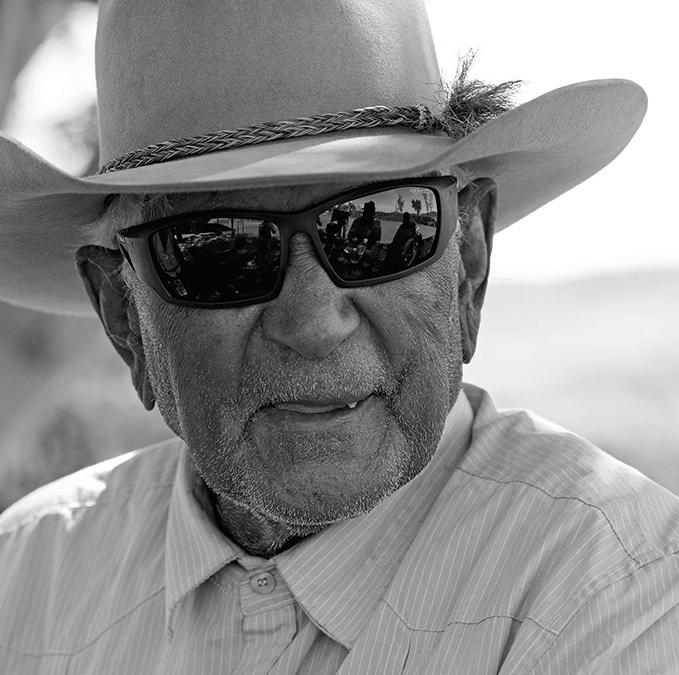
“LEADERSHIP IS PROVIDING THE VISION AND SUPPORT FOR YOUR TEAM TO DEVELOP AND PERFORM AT THEIR BEST. WALK THE TALK.”
Heath Nelson | General Manager Communities and Heritage
“WE HAVE TO FOLLOW OUR LORE, IT MAKES YOU STRONG AND IS WHY I AM STILL ALIVE.”
Stephen Stewart | Ngarla Elder | Pilbara region, WA
LEGEND
Petroleum Titles
LEGEND
Petroleum Titles
Exploration Permit
Production Licence
Exploration Permit
Unclaimed Area
Production Licence
Registered Claim Marlinyu Ghoorlie (LGATE-004)
Unclaimed Area
Alternative Settlement Area (LGATE-067)
Registered Claim Marlinyu Ghoorlie (LGATE-004)
Alternative Settlement Area (LGATE-067)
Native Title (Determination) (LGATE-006)
Kariyarra People
Native Title (Determination) (LGATE-006)
Kuruma Marthudunera
Kariyarra People
Nyamal People
Kuruma Marthudunera
Nyiyaparli People
Nyamal People
South West Settlement
Nyiyaparli People
Thalanyji
South West Settlement
Thalanyji
ONSLOW
UTAH POINT & SOUTH WEST CREEK
UTAH POINT & SOUTH WEST CREEK
ONSLOW
The Esperance Nyungars
The Esperance Nyungars
Yaburara and Mardudhunera People
Yamatji Nation
Yaburara and Mardudhunera People
Other Determination
Yamatji Nation
Other Determination
LUCKY BAY
LUCKY BAY
PERTH
KWINANA WORKSHOP
KEMERTON
PERTH
KWINANA WORKSHOP
KEMERTON
WODGINA
IRON VALLEY
WODGINA
ONSLOW WONMUNNA
ONSLOW WONMUNNA
IRON VALLEY
KOOLYANOBBING
KOOLYANOBBING
MT MARION
PARKER RANGE
MT MARION
PARKER RANGE
ESPERANCE PORT
ESPERANCE PORT
SOCIAL
(CONTINUED)
-
112 I MINERAL RESOURCES LIMITED 2023 SUSTAINABILITY REPORT
Figure 16: MinRes operations Native Title determinations, registered claims and alternative settlement areas location
PROTECTING AND MANAGING CULTURAL HERITAGE
We acknowledge that our operations, both existing and planned, may intersect with areas of cultural heritage significance. Cultural heritage refers to the dynamic tangible and intangible heritage assets of a group or society that are inherited from past generations. In the Australian context it includes both Indigenous and post-contact (European) heritage.
At MinRes, we are committed to ensuring our compliance with all relevant legislation and regulations concerning the preservation and protection of cultural heritage. The incoming Aboriginal Cultural Heritage Act 20219 (WA) replaces the Aboriginal Heritage Act 1972 (WA), providing a modern framework for the recognition, protection, conservation and preservation of Aboriginal cultural heritage while recognising the fundamental importance of cultural heritage to Indigenous Australians. MinRes is preparing for this transition by including the implementation of new systems to conduct the required due diligence assessments, reviewing our historical heritage survey coverage, reviewing existing Cultural Heritage Management Plans, and preparing for the development of new statutory plans.
MinRes is aware that Traditional Owner expectations regarding engagement in statutory processes are evolving and we continue to support Traditional Owners to manage their cultural heritage. We are moving beyond simply complying with legislative requirements to a “site avoidance” model, which will see cultural heritage sites avoided to the greatest extent possible across our operations.
Identification of cultural heritage
We collaborate with Indigenous Australians to ensure cultural heritage is identified, managed and protected. The heritage protection protocols in our Native Title agreements and standalone heritage agreements are the bedrock of our heritage management system.
Our Heritage team engages with Traditional Owner representatives to carry out cultural heritage surveys prior to the commencement of any activities across our operations. These surveys inform the location and design of our operations to avoid or minimise, to the greatest extent, the risk of disturbance to potential and known areas of cultural heritage.
MinRes conducts two types of heritage surveys across our operational and exploration sites.
• Archaeological – identifying places where physical evidence of past activities of Indigenous Australians have been preserved in the landscape.
• Ethnographic – identifying places that are culturally significant to the Traditional Owners.
As part of the ethnographic survey and consultation process, we also ensure that Traditional Owner views regarding the importance and significance of archaeological sites and materials is documented.
During FY23, we completed 271 days of heritage surveys across our project locations, representing a 62 per cent increase from FY22.
MinRes appreciates the fundamental importance of cultural heritage to Indigenous Australians and adopts the approach of avoiding impacts to cultural heritage places to the greatest extent practicable.
Improved heritage record and data management systems
During FY23, MinRes made considerable progress to improve our approach to managing cultural heritage places.
• Implementing a consolidated database of verified spatial information relating to Indigenous heritage places.
• Developing Heritage Survey Spatial Data Requirements to ensure new cultural heritage survey spatial data meets minimum accuracy and meta-data standards.
• Implementing an Agreements and Obligations Register to consolidate the tracking of obligations and their delivery.
• Developing a Register of Ministerial Consents to track and manage any conditions attached to Ministerial consents that have been obtained.
Heritage monitoring and compliance
MinRes collaborates with Traditional Owners to undertake routine monitoring of known Registered Indigenous heritage sites and other places of cultural heritage importance to ensure there is no unauthorised disturbance.
Any sites of significance to Indigenous Australians that are identified through an archaeological or ethnographic heritage survey are demarcated with industry standard “heritage flagging”, including an appropriate buffer area, therefore no works occur until approvals are in place and conditions are fulfilled. Where heritage places are being permanently avoided, the demarcation ensures that no unauthorised activities occur on this land.
SOCIAL - (CONTINUED)
MINERAL RESOURCES LIMITED 2023 SUSTAINABILITY REPORT I 113
9 In a new Bill to be presented to the WA Parliament, the Aboriginal Cultural Heritage Act 2021 (WA) will be repealed and the Aboriginal Heritage Act 1972 (WA) will subsequently be amended. MinRes will continue to monitor changes to the legislation and update our approach to ensure compliance.
OUR APPROACH TO INDIGENOUS ENGAGEMENT
MinRes acknowledges and respects the Indigenous Peoples’ lands and waters on which we operate and recognises that our Australian operations are located on or near lands that are significant to Indigenous Australians.
At MinRes, we respect internationally recognised human rights principles, including Indigenous Peoples’ right to consultation and to engage with affected Indigenous communities in ways that are consistent with the principles of seeking FPIC.
With our operations spanning regional and remote areas of Western Australia and the Northern Territory, our ability to build strong and trusting relationships with our communities is critical to our success. In addition to the social investment framework, MinRes focuses on contributing to Indigenous communities by supporting social and cultural health, economic empowerment and community driven projects. Our dedicated Heritage, Native Title and Indigenous Engagement teams work closely with Indigenous communities and Native Title groups to increase Indigenous engagement and participation in the regions where we operate.
Indigenous engagement are interactions that take place between MinRes, Indigenous communities and other stakeholders. Engagement includes a broad set of activities, from the provision of information through to active dialogue and partnering.
Through proactive consultation and engagement, we have identified business support, cultural awareness training and community investment initiatives as some of the primary areas of interest for Traditional Owners.
Our key focus is to:
• continue to implement MinRes Indigenous Small Business Grants which provide targeted support for Indigenous businesses
• increase awareness of cultural awareness training across our operations, which has resulted in increased attendance and completion of the training by our people
• continue to work with Traditional Owners to identify programs and initiatives that can be funded through our community investment program.
CASE STUDY: ON-COUNTRY MEETING OF THE KARIYARRA ABORIGINAL CORPORATION AND MINRES BOARDS
MinRes’ land management, cultural heritage, and agreement governance sustains strong Indigenous stakeholder relationships. Meaningful and culturally appropriate stakeholder engagement embeds Indigenous perspective and feedback into business process.
In November 2022, members of the MinRes Board travelled to our Wodgina lithium operation where they met with the Board of the Kariyarra Aboriginal Corporation. The Kariyarra People are the Traditional Owners of the land where Wodgina is situated. The meeting provided a valuable opportunity for members of both Boards to establish meaningful connections with one another. The meeting included a Welcome to Country, with a traditional dance performance, and a tour of the Wodgina site.
The MinRes Board travelling to Kariyarra Country is understood to be the first time the Board of an ASX-listed company has travelled to meet with the Kariyarra Board on Country.
Our action plan for reconciliation
At MinRes we recognise our responsibility is to take meaningful action to advance reconciliation. We developed our inaugural Reflect Reconciliation Action Plan (RAP) in 2022, which outlined and strengthened our commitment to reconciliation with Indigenous Australians. We successfully implemented the Reflect RAP’s actions and deliverables during FY23. Refer to our 2023 Sustainability Performance Data Tables for further information.
Our RAP included opportunities to make meaningful contributions towards reconciliation within the communities where MinRes operates, while outlining proposed initiatives across relationships, respect, opportunities, and governance. Our RAP included a commitment to cultural heritage, ensuring a high level of collaboration with Indigenous Australians to ensure Indigenous heritage is managed and protected appropriately. Our RAP can be read here
Our vision for reconciliation prioritises education, mutual respect and positive action as key pillars in building a successful and respected business that appreciates and is enriched by Indigenous Australians and cultures.
SOCIAL - (CONTINUED)
114 I MINERAL RESOURCES LIMITED 2023 SUSTAINABILITY REPORT

In FY23, we revitalised our Reconciliation Action Plan Working Group in preparation to commence the drafting of an Innovate RAP and to drive the governance and implementation of the RAP across the Company, with an aim to grow a diverse business and workforce who respect and embrace Indigenous Australian culture.
Ensuring meaningful Indigenous economic participation and opportunity
In addition to providing a considered Indigenous community investment approach, MinRes aims to economically empower Indigenous Australians through the provision of training opportunities, employment, procurement and business development support.
As of 30 June 2023, MinRes achieved 3.5 per cent Indigenous workforce representation, a 94 per cent increase from the FY22 Indigenous workforce representation and significantly exceeding our FY23 Indigenous employment target of two per cent.
During FY23, MinRes appointed an experienced leadership team to drive the economic participation of Indigenous Australians in our business across a range of opportunities including employment, training, business development, community investment, partnerships and cultural awareness.
Our Indigenous Engagement and Human Resources teams collaborate to ensure accessibility of internal and external support mechanisms for Indigenous employees within our business.
The MinRes Indigenous Procurement Strategy commits MinRes and its contracting business partners to promote, support and employ local Indigenous Australians. MinRes has worked with Traditional Owners to identify Indigenous businesses who would benefit from an Indigenous Small Business Grant. The funding supports the set-up costs associated with a new business, including registration, business advice, legal structure and basic training.
In FY23, MinRes increased Indigenous business spend by 140 per cent from FY22. MinRes currently contracts with more than 30 Indigenous businesses with this number projected to grow exponentially.
CASE STUDY: HELPING LOCAL INDIGENOUS BUSINESSES
MinRes has been supporting the local community by helping residents of the Yandeyarra community, located about 30 minutes from our Wodgina lithium operations. Once a thriving home to more than 300 people, Yandeyarra’s population has been declining rapidly over the years. Today, less than 50 people live in the community.
MinRes has provided resources to support the local families to be able to stay on Country, provide for visitors who come to the community and support local businesses to grow.
During FY23, MinRes awarded a three-year agreement with a local Yandeyarra business – Jutiya Gardening and Landscaping – to provide village gardening, maintenance services and cultural awareness training at our Wodgina lithium operation in the Pilbara.
Read more about our partnership with Jutiya Gardening and Landscaping here
BUILDING A CULTURALLY RESPECTFUL AND INCLUSIVE WORKPLACE
MinRes is committed to increasing understanding, value and recognition of Indigenous Australian cultures, histories, knowledge and rights within our organisation. We recognise that cultural respect and understanding are not only a moral imperative, but are a fundamental aspect of responsible corporate citizenship, with these values embedded within our Code of Conduct and Business Integrity
We aim to develop our employees’ understanding, respect and appreciation of the local Indigenous Australians’ lore and culture, both within and outside of business activities, through the implementation of cultural awareness training sessions. We view cultural awareness as an ongoing journey of learning and education. In FY23, MinRes contracted four Indigenous cultural awareness providers to deliver crosscultural awareness training to our operations. Our cultural awareness providers delivered a total of 164 sessions to 1,868 employees across our corporate, Yilgarn and Pilbara operations. This represents over one third of MinRes’ permanent workforce.
SOCIAL - (CONTINUED)
116 I MINERAL RESOURCES LIMITED 2023 SUSTAINABILITY REPORT
During FY23, seven employees attended a pilot cultural immersion program at Yandeyarra, led by Traditional Owners from the Yandeyarra Community. The program consisted of a three-day cultural experience on Yandeyarra Country, situated 45 kilometres from our Wodgina lithium project in the Pilbara. Led by Kariyarra Elders, our employees learnt about Indigenous Australian lore, customs, Dreamtime stories, visited historical sites and ate traditional food.
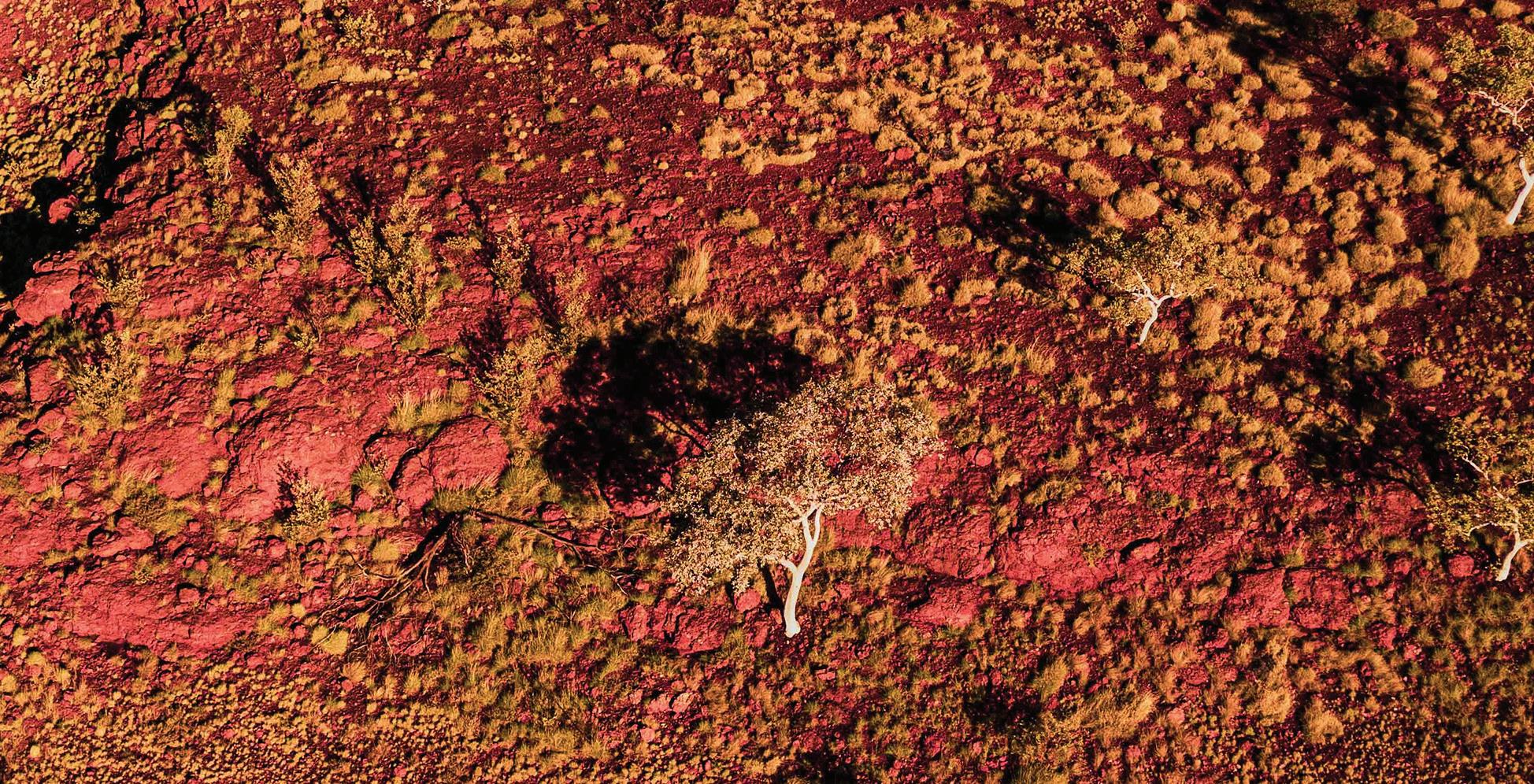
MinRes are exploring opportunities for more employees to take part to increase understanding, value and recognition of Indigenous Australian culture. This program will be extended to additional MinRes employees and leaders in FY24.
During FY23, we continued to celebrate Reconciliation Australia’s National Reconciliation Week and NAIDOC Week across the business. To read more about how we celebrated the “Be a Voice for Generations” theme for National Reconciliation Action Week, click here
LOOKING FORWARD
In FY24, MinRes is committed to continuing to implement various initiatives to further improve our approach to land access and cultural heritage management.
• Modernise our Native Title and heritage agreements and review existing Cultural Heritage Management Plans.
• Develop and fully implement Innovate Reconciliation Action Plan deliverables.
• Deliver on all planned stakeholder reference groups for our projects and operations.
• Deliver Native Title party endorsed cultural awareness training programs to eligible workforce across key operational and corporate sites.
• Increase awareness and build respect for Indigenous Australian culture and history within our workforce by participating in National Reconciliation Week and NAIDOC Week events.
MINERAL RESOURCES LIMITED 2023 SUSTAINABILITY REPORT I 117
COMMUNITY AND STAKEHOLDER RELATIONSHIPS
MATERIAL TOPIC: DEVELOPING AND MAINTAINING STRONG COMMUNITY AND STAKEHOLDER RELATIONSHIPS
OUR MANAGEMENT APPROACH
An important part of maintaining our social licence to operate is demonstrating the value we create in society. We achieve this through developing strong community and stakeholder relationships.
To support engagement activities, MinRes has a dedicated Heritage and Communities team responsible for managing and building sustainable and positive relationships with local communities, pastoralists, private landowners, Traditional Owners, Indigenous groups, business partners, non-government organisations and local government, to ensure mutually beneficial outcomes. Indigenous Australians and local communities are critical partners and stakeholders for MinRes. Positive Indigenous community relationships are essential to MinRes operations and we are committed to providing local communities with open and transparent access to information about our operations. Refer to Our Approach to Indigenous Engagement for further information.
Our approach to social performance is guided by our Community Policy. This Policy plays a vital role in enabling us to identify and engage with key stakeholders, thereby providing us with an understanding of their needs and concerns. In doing so, we can proactively manage and mitigate any potential impacts on the communities we work with.
Building upon our approach to social performance, our Human Rights Policy seeks to ensure that our engagement practices respect human rights, ensure diverse voices are heard and that vulnerable and at-risk groups can participate in engagement processes.
As part of our commitment to stakeholder engagement we have implemented a Community Grievance Mechanism, providing stakeholders with a platform to raise any complaints or concerns. Through this proactive approach we gain an understanding of the needs and concerns of our stakeholders, enabling us to address potential challenges that may arise.
MinRes invests in local communities by providing meaningful economic opportunities, such as employment and business initiatives. Through our social investment program, we support the work of organisations and programs that help strengthen local communities.
WE DEVELOP AND MAINTAIN STRONG COMMUNITY AND STAKEHOLDER RELATIONSHIPS AS PART OF OUR SOCIAL LICENCE TO OPERATE AND TO BUILD CAPACITY.
GRI Indicators 3-3 SDG Targets 4.3 | 17.17 SASB Index EM-MM-210b.2
Reviewed our social investment framework to ensure we continue to make meaningful contributions 123 charitable organisations supported More than $7 million contributed to communities 118 I MINERAL RESOURCES LIMITED 2023 SUSTAINABILITY REPORT
FY23 HIGHLIGHTS
OUR SOCIAL INVESTMENT PROGRAM
MinRes is committed to making a positive impact in the local communities where we operate, through contributions that generate value for society and demonstrate our corporate social responsibility. Social investment, as we define it, involves voluntary contributions of financial and in-kind support to organisations and projects which bring benefits to the communities where we operate.
During FY23, we reviewed our social investment framework to ensure our approach to investment aligns with industry best practice and supports our long-term strategy of making a meaningful contribution to the communities in which we operate. This review was led by an independent consultant and was further informed by internal workshops and one-on-one feedback sessions. As result of this, we identified three key focus areas to which we will be directing our support.
We partner with organisations that are improving health outcomes, raising awareness of mental wellbeing and providing accessible support services.
• Mental and physical wellbeing.
• An emphasis on programs and initiatives that support youth.
Through our partners, we support programs and initiatives that help create vibrant and resilient communities.
• Contribute to initiatives that support vibrant and inclusive communities.
• Community health and welfare.
Good Health and Well-being Sustainable Cities and Communities
We work with our partners to drive economic empowerment by equipping people with the skills and opportunities they need to succeed today and into the future.
• Skills development and employment pathways.
• Indigenous Australian employment and business opportunites.
Quality Education
Decent Work and Economic Growth
During FY23, we contributed $7.5 million to support social investment initiatives and programs, an increase of 29 per cent from FY22. MinRes has contributed more than $23 million to support social investment initiatives over the past five years. This represents a significant investment in the communities where we operate.
1 External limited assurance is provided over our FY23 social investment data. Refer to page 181 for a copy of the Independent Limited Assurance Statement.
Figure 18: Social investment contributions (AUD $ million) and percentage of profit before tax
SOCIAL - (CONTINUED) SDG GOAL FOCUS INVESTMENT PILLAR
Figure 17: MinRes social investment framework
FY19 FY20 FY21 FY22 FY23 Community investment % of profit before tax 1.99 2.6 5.25 5.77 8 6 4 2 0 2.00% 1.50% 1.00% 0.50% 0.00% 7.5 5.77 Community investment ($ millions) Percentage of profit before tax 0.84% 0.84% 2.08% 0.18% 0.29% 1.18% MINERAL RESOURCES LIMITED 2023 SUSTAINABILITY REPORT I 119 HEALTH AND WELLBEING STRENGTHEN LOCAL COMMUNITIES ECONOMIC EMPOWERMENT
SOCIAL - (CONTINUED)
In FY23, we supported more than 120 organisations through our social investment program. A summary of our social investment contributions is outlined in Figure 19 below and highlights the major organisations we made significant contributions to in FY23. For more details on our social investment activities, please read our 2023 Social Investment Report.
HOW WE SUPPORT LOCAL COMMUNITIES
Partnerships & Sponsorships
Total Contribution $2.5 million
• Ronald McDonald House Charities WA
• McGovern Foundation
• Lifeline WA
• Starlight Children’s Foundation
• Youth Focus
• West Coast Eagles
• Ear Science Institute
• Shooting Stars
Donations
Total Contribution $4.5 million
• Telethon
• Harry Perkins Institute of Medical Research
• Foundation for the WA Museum
• Lord Mayor’s Distress Relief Fund
• Lucy Saw
• Foodbank WA
Community Grants
Total Contribution $237,000
• Red Country Music Festival
• Marine Rescue Onslow
• Onslow Family Support Program
• Yilgarn Bowling Club
• Kambalda Mens Shed
• Port Hedland Visitor Centre
In-Kind Contributions1
Total Contribution $245,000
• Telethon Family Festival and Phone Room
• Healthy Strides Move-AThon for Telethon
• Foodbank Million Meal Challenge
• Supporting the Cancer 200 Ride with equipment and volunteers
• Ronald McDonald House and Perth Children’s Hospital House
In addition, MinRes has committed $50M to the Resources Community Investment Initiative. The funds will see us partner with the State Government to deliver iconic West Australian infrastructure projects.
MANAGING OUR RELATIONSHIPS WITH COMMUNITIES AND STAKEHOLDERS
Positive community relationships are an essential component of our operations. They align expectations, minimise disruptions and delays to projects and harmonise working relationships.
Engagement activities
MinRes is committed to providing local communities with open and transparent access to information about our operations. The aim of our Stakeholder Engagement Management Plan and Community Relations Strategy is to ensure we engage effectively with local
communities, government and other key stakeholders on matters concerning environment, land access, heritage and community during all phases of our operations.
We recognise genuine and effective stakeholder engagement involves building relationships based on mutual trust, respect and understanding. To further support this, MinRes has seven regional Community and Indigenous Engagement Advisors who manage and support stakeholder, community and Indigenous engagement activities. Our regional based teams ensure that MinRes has a consistent and accessible presence in the regions that can support future Indigenous employees and businesses.
MinRes continues our memberships of, and participation in, local industry events held in the regions as a meaningful way to engage with community members, other businesses and support our Indigenous community partners.
Figure 19: FY23 local community support
120 I MINERAL RESOURCES LIMITED 2023 SUSTAINABILITY REPORT
1 This includes use of company facilities and equipment, employee volunteering and donating goods.
This ensures we are well-informed of issues and strengthens our community connections year-on-year by:
• developing deeper relationships with members of the communities in which we operate, including non-government entities
• building awareness of projects to ensure they are known and understood prior to approval processes
• engaging with non-government conservation organisations and individuals
• conducting MinRes community forums to provide information about our activities
• participating in existing local community forums and local shire meetings
• presenting our plans to the Chamber of Commerce and Industry WA
• establishing relationships with schools and developing work experience programs at mine sites for local high schools
• hosting business development and employment sessions
• further investing in our community development partnerships at a local level
• supporting school NAIDOC events, Country Week events, regional fairs and community festivals.
UNDERSTANDING AND RESPONDING TO COMMUNITY CONCERNS
We are committed to the highest standards of conduct in all our business activities and actively support a culture of honest and ethical behaviour.
MinRes has a Community Grievance Mechanism which allows community members or other stakeholders to express any concerns, grievances or provide feedback about their interactions with our people, activities or operations. The intent of the mechanism is to ensure feedback and grievances are managed consistently and in line with MinRes policies and procedures.
The mechanism assists us to:
• facilitate early resolution of grievances
• provide an open and responsive grievance management process
• enable MinRes Community, Indigenous Engagement and Stakeholder Management teams to resolve grievances in a consistent, timely and effective manner
• avoid issues escalating
• identify risks and trends to inform strategies or work plans and identify improvement opportunities
• meet compliance requirements.
Our independent, external whistleblowing service, MinRes Integrity Assist, complements our Community Grievance Mechanism. MinRes Integrity Assist is designed to provide employees, consultants, suppliers, and stakeholders who have observed violations, unethical behaviour or actions that contradict our Code of Conduct and Business Integrity, with a confidential way to raise their concerns. Refer to Whistleblowing Provisions for further information.
CASE STUDY: SUPPORTING WA FAMILIES – RONALD MCDONALD HOUSE CHARITIES WA
MinRes is a long-term partner of Ronald McDonald House Charities WA, which helps sick children and their families stay together and close to the medical care they need in Perth. For almost eight years, we have employed two chefs who cook dinner for the families staying at Ronald McDonald House and the Perth Children’s Hospital House every night of the year. Our chefs, Tommy and Zi, also support the Home for Dinner volunteering program which invites groups from the community to help prepare the meals.
This year we extended our support, with two MinRes gym instructors volunteering their time each fortnight to lead gym classes for the children. With a focus on building confidence and fostering an environment of joy, these classes provided an opportunity for children to engage in physical activity while allowing their caregivers to take a well-earned break.
LOOKING FORWARD
In FY24, MinRes will:
• continue engaging with the communities where we operate to identify community investment and development opportunities
• revise the MinRes Stakeholder Engagement Plan and Community Engagement Strategy to align with our new stakeholder management system for consistency across the business and facilitate effective community and social risk management
• revise our Community Grievance Mechanism to ensure community stakeholders can continue to raise grievances and provide feedback about our operations and projects.
SOCIAL - (CONTINUED)
MINERAL RESOURCES LIMITED 2023 SUSTAINABILITY REPORT I 121
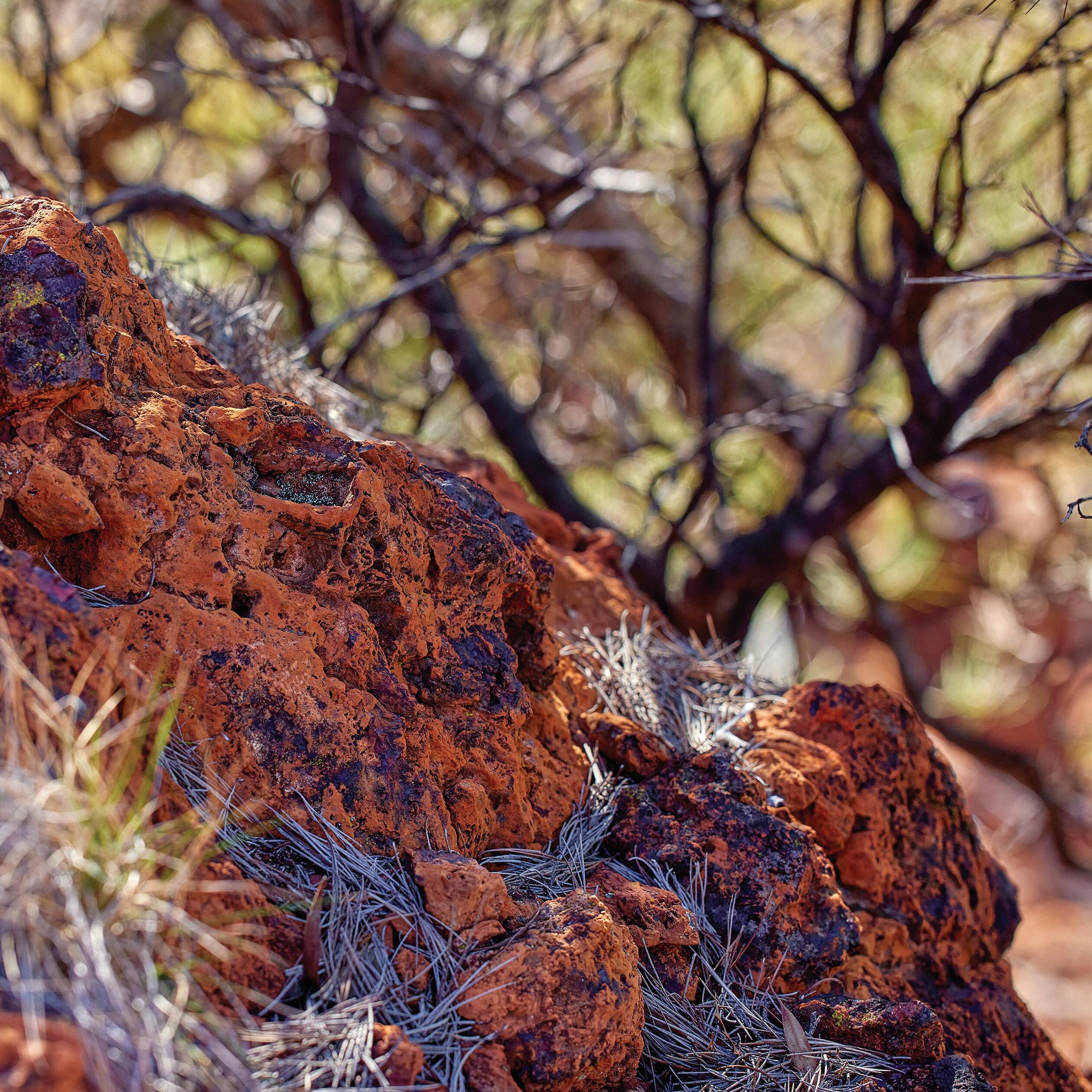
“LEADERSHIP IS ABOUT REMOVING BARRIERS TO ALLOW TEAMS AND INDIVIDUALS TO ACHIEVE THEIR BEST POSSIBLE RESULTS.”
Tegan Read | Principal Community Engagement

“WHEN IT COMES TO LEADERSHIP, I’M INSPIRED BY MY ELDERS’ FUNDAMENTAL BELIEF IN THE POWER OF RESPECT AND EQUALITY.”
Tania Champion | Principal Tenements
| Kalamaia Kaprun Elder / Applicant
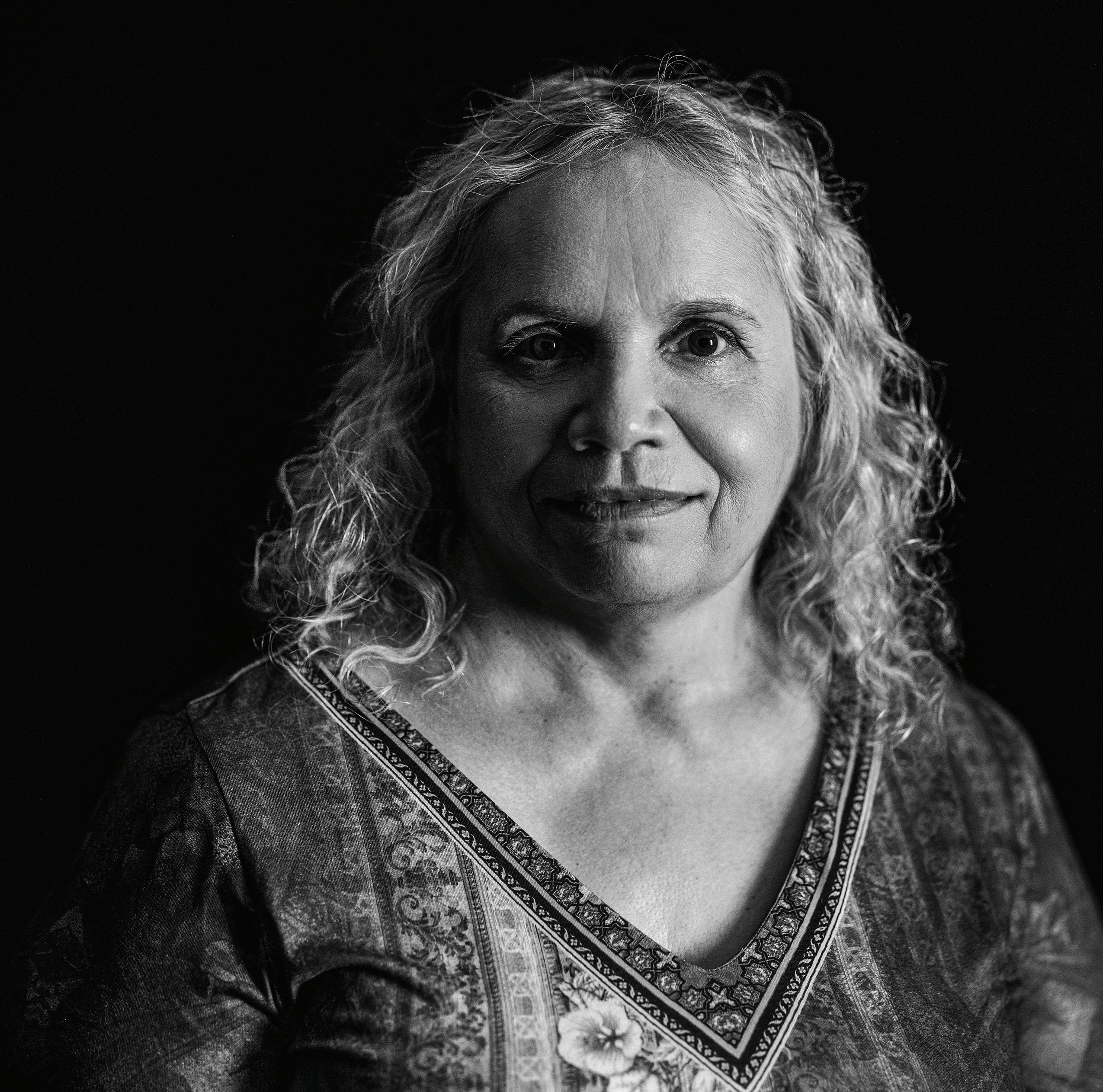

ENVIRONMENT
MANAGING ENVIRONMENTAL IMPACT
PAGE 126 - 159
AIR QUALITY
PAGE 127 - 128
WATER STEWARDSHIP
PAGE 128 - 136
NON-MINERAL WASTE
PAGE 137 - 139
TAILINGS AND MINING WASTE
PAGE 139 - 147
BIODIVERSITY
PAGE 147 - 154
LAND MANAGEMENT AND REHABILITATION
PAGE 154 - 158
MINE CLOSURE PLANNING
PAGE 158 - 159
MANAGING CLIMATE CHANGE
PAGE 160 - 174
SUSTAINABLE DEVELOPMENT GOALS
UN GLOBAL COMPACT PRINCIPLES
MINERAL RESOURCES LIMITED 2023 SUSTAINABILITY REPORT I 125 ENVIRONMENT 3 GOOD HEALTH & WELL-BEING 15 LIFE ON LAND 13 CLIMATE ACTION 6 CLEAN WATER & SANITATION 7 AFFORDABLE AND CLEAN ENERGY 12 RESPONSIBLE CONSUMPTION & PRODUCTION
MANAGING ENVIRONMENTAL IMPACT
MATERIAL TOPIC: MANAGING ENVIRONMENTAL IMPACT BY ENHANCING WATER STEWARDSHIP AND NATURAL RESOURCE EFFICIENCY
Environmental management is essential in maintaining our social licence to operate. We adopt a systematic approach to mitigate risk and identify management strategies to ensure our operations avoid unacceptable environmental impacts.
We diligently monitor our compliance with licences and permits, through internal and third-party environmental audits. In FY23, MinRes had no high-impact environmental incidents10 and received no fines or prosecutions relating to environmental performance at our operations.
OUR ENVIRONMENTAL MANAGEMENT APPROACH
FY23 HIGHLIGHTS
Our mining operations are managed in line with an environmental regulatory framework governed by both Commonwealth and State legislation. The Environment Protection and Biodiversity Conservation Act 1999 (Cth) (EPBC Act) outlines the legal framework for managing significant impacts on matters of national environmental significance and is supported by Western Australian State legislation, including but not limited to the Environmental Protection Act 1986 (WA) (EP Act), the Mining Act 1978 (WA) and the Rights in Water and Irrigation Act 1914 (WA) (RiWI Act).
Our MinRes Environment Policy covers emissions to air, operational greenhouse gas (GHG) emissions, water use, waste generation, biodiversity, land management and rehabilitation. The Policy is implemented through our Environmental Management System (EMS) and was developed in line with the ISO 14001 Environmental Management Systems standard. Our EMS includes operationspecific Environmental Management Plans (EMPs), specifically developed to manage the key environmental aspects and impacts at our operations, and supporting procedures, work instructions and forms. Some of the typical environmental aspects covered in our EMPs include land clearing, flora and vegetation, fauna, soils, water, heritage, air quality, GHG emissions, energy, noise and vibration, waste rock, hydrocarbons, chemicals and non-mineralised waste. In FY23, the Mt Marion lithium operation received formal certification under ISO 14001.
During FY23, the Environment Policy was reviewed and strengthened, reflecting MinRes’ commitment to continual improvement of our EMS.
10 MinRes classifies high impact environmental incidents as incidents with an actual environmental consequence of high or major. These events have an adverse impact on flora/ fauna, habitat, soil, aquatic and land ecosystems, atmosphere or water resources typically lasting multiple years (Level 4 and above).
WE ARE COMMITTED TO ENVIRONMENTAL MANAGEMENT THAT MAINTAINS OUR LICENCE TO OPERATE IN AN ENVIRONMENTALLY RESPONSIBLE AND SUSTAINABLE MANNER.
Developed a business wide Biodiversity Strategy Completed onsite water efficiency audits at a number of operations Zero high impact environmental incidents recorded 126 I MINERAL RESOURCES LIMITED 2023 SUSTAINABILITY REPORT GRI Indicators 3-3 | 303-2 | 303-3 | 303-4 | 304-1 | 304-4 305-7 | 306-1 | 306-2 | 306-3 | 306-4 | 306-5 | 307-1 G4-EN21 | G4-EN23 | MM1 | MM3 | MM8 SDG Targets 3.9 | 6.1 | 6.3 | 6.4 | 12.3 | 12.6 | 15.3 | 15.5 SASB Index EM-MM-160a.1 | EM-MM-540a.2 | EM-MM-540a.3
MinRes supports the precautionary principle11 and actions the principle through risk assessments, strategic planning, and environmental and social baseline studies embedded in our EMS processes. To ensure our EMS remains relevant, we subscribe to EnviroLaw (an online directory) to obtain regular updates on environmental legislation, codes of practice, guidelines and published standards. We have representation on the Association of Mining and Exploration Companies (AMEC) Environment and Water Committee and the Chamber of Minerals and Energy (CME) Environment Committee, which ensures we are engaged on emerging developments in Australian environmental policy.
MinRes is continually assessing environmental risks and monitoring environmental performance. Our dedicated Environment team delivers a diverse range of environmental support and is responsible for environmental approvals, environmental management and regulatory reporting, as well as compliance, rehabilitation and closure. The team continued to expand to meet project requirements during FY23, and additional specialists in key areas of geographic information systems (GIS), biodiversity, compliance, mine closure and project approvals have been onboarded to further strengthen our in-house capability and skills base. Each operational site has Environmental Advisors responsible for onsite environmental governance, training and awareness, compliance and monitoring. The corporate Environment team, in conjunction with site-based operational staff, manage sites in care and maintenance.
MinRes ensures relevant environmental information is shared through weekly environmental incident review meetings, participated by all on-site environmental personnel including the corporate Compliance Systems team, to review incidents over the past week to ensure appropriate classification and close-out. In addition, MinRes employs a roving superintendent to ensure consistency in our environmental management approach across operational sites, and that systems and processes are embedded on site to appropriately address and manage environmental risks.
The following sections describe some key environmental impacts associated with our operations, actions taken to manage these impacts and performance measures.
AIR QUALITY OUR MANAGEMENT APPROACH
Across our business, the equipment used to undertake operational activities – such as drilling, blasting, load and haulage and ore processing – generates dust and other air emissions such as exhaust emissions. Exhaust emissions are the main source of CO, NOX, PM10, PM2.5 and SO2. The Australian National Environment Protection (National Pollutant Inventory) Measure 1998 requires facilities to report the emission of any of the 93 listed substances. MinRes reports our emissions of listed substances annually to the National Pollutant Inventory (NPI) for facilities that meet the relevant reporting thresholds. Emissions are estimated using the approaches defined in the NPI Emission Estimation Technique (EET) manuals, with most calculations undertaken using emission factors.
To manage air emissions at our operations, we apply dust suppression measures such as the use of water carts on high traffic areas, roads and tracks, and sprinkler systems installed on transfer points at our crushing and train load out facilities. MinRes utilises dust deposition gauges as required by site-specific regulatory requirements to monitor potential impacts of dust to the environment. At our Yilgarn operations, where we manage several private haul roads, investment in surface sealing has delivered a range of benefits including significant reductions in wheelgenerated dust from our road haulage fleet. At our Wonmunna operations, a trial program was initiated to evaluate available dust suppression additives and their effectiveness. The initial trial outcomes have resulted in reduced water usage and improved dust suppression in highly trafficked areas such as haul roads and stockpile areas.
At present, MinRes relies on diesel as the primary energy source for our mining equipment, as well as for loading and transporting materials, and for electricity generation at our iron ore operations. Equipment operated on our sites is fitted with diesel particulate filters and regularly maintained to limit air emissions. In accordance with MinRes’ strategic vision to decrease our dependence on diesel fuel, we operate liquefied natural gas (LNG) and pipeline natural gas (PNG) fired power stations at Mt Marion and Wodgina, respectively. Additionally, we have recently commissioned our first modular solar PV and battery system at Wonmunna. Refer to Emissions Reduction Initiatives for further information.
ENVIRONMENT - (CONTINUED) MINERAL RESOURCES LIMITED 2023 SUSTAINABILITY REPORT I 127
11 Principle 15 of the 1992 Rio Declaration “where there are threats of serious or irreversible damage, lack of full scientific certainty shall not be used as a reason for postponing cost-effective measures to prevent environmental degradation”.
OUR PERFORMANCE
Table 8 provides the FY21 to FY23 aggregated emissions for eight key NPI substances emitted across reportable MinRes facilities. The overall rise in emissions during this period can be attributed to the expansion of our operations. Further information on the breakdown of air emissions by commodity and region can be found in our 2023 Sustainability Performance Data Tables.
Table 8: Air quality emissions1
1. FY21-FY22 MinRes (Total) emissions restated following a review of reported figures. Pilbara Hub total emissions previously double counted.
2. FY23 emissions exclude Coobina Chromite Mine, Carina Iron Ore Project, J4 Iron Ore Project, Phils Creek Iron Ore Mine, Mango Yard and Onslow Iron project as facilities did not exceed the NPI reporting threshold. FY23 emissions include Boodarie Yard as facility was operational and exceeded the NPI reporting threshold.
3. Sulfur dioxide measurements based on engineering calculation emission estimation technique.
WATER STEWARDSHIP OUR MANAGEMENT APPROACH
MinRes recognises water as a vital resource for all aspects of life and as a key resource for our operations and supply chain. MinRes aims to apply strong and transparent water governance, manage water effectively at our operations and collaborate with key stakeholders to achieve responsible and sustainable water use.
Water is a key input to our operations, being used for exploration and resource definition drilling, dust suppression, domestically in our camps and offices, vehicle and infrastructure washdown, and processing at our lithium and iron ore operational sites. MinRes designs, constructs, operates and maintains water withdrawal, storage, treatment, and discharge facilities adhering to relevant standards and local legislative requirements.
MinRes conducts comprehensive baseline assessments and modelling during the planning stages of our projects, and as required, during the life of the mine. These assessments play a pivotal role in water management planning, risk identification and mitigation, infrastructure design, community engagement and consultation, and regulatory environmental compliance. These assessments ensure mining practices are sustainable in the long-term, as they effectively mitigate negative impacts on water resources and surrounding ecosystems.
We take a holistic approach to water management, with several corporate policies and procedures addressing the effective and efficient management of environmental resources and stakeholder relationships, including but not limited to:
• Environment Policy
• Climate Change Policy
• Community Policy
• Groundwater Operating Strategies – internal strategies providing a framework for the management of groundwater to prevent any unauthorised use or adverse impact to groundwater resources
• Potable Water Management Procedure – internal procedure outlining the process for managing potable water to ensure it meets the Australian Drinking Water Guidelines 2011
Substance FY21 Total tonnes FY22 Total tonnes FY232 Total tonnes Carbon monoxide 1,910 1,584 1,413 Lead and compounds 0.8 0.9 0.9 Mercury and compounds <0.01 <0.01 <0.01 Oxides of nitrogen 2,716 2,964 3,001 Particulate matter <10 μm 17,920 19,240 19,434 Particulate matter <2.5 μm 155 171 178 Sulfur dioxide3 2 2 2 Total volatile organic compounds 188 196 208 ENVIRONMENT - (CONTINUED) 128 I MINERAL RESOURCES LIMITED 2023 SUSTAINABILITY REPORT
MinRes maintains Drinking Water Management Plans (MPs), Groundwater Operating Strategies, and Surface Water MPs as required at each of our operational mine sites, which define how we implement monitoring programs to assess operational performance, verify compliance with adopted performance criteria, facilitate reporting requirements and track water quality parameters that have the potential to cause adverse environmental or community health impacts. Monitoring programs are developed in accordance with regulatory approval requirements, relevant legislation, national standards and guidance notes.
MinRes water performance is reported to the Board monthly and progress against water-related sustainability targets is provided as a standing agenda item at each Sustainability Committee meeting. MinRes has a dedicated Water Working Group responsible for matters and activities related specifically to the management, conservation and preservation of water resources located within, and adjacent to, our operations. The Working Group supports the implementation of water accounting and efficiency projects, aligns to progress effective water stewardship, advances water performance reporting and provides a consultation mechanism to raise water governance issues and queries. The Working Group meets monthly and includes senior hydrogeology, sustainability and environmental representatives.
Community engagement on water
To ensure water is responsibly governed and to protect water quality and water access, it is important to be a collaborative partner within the communities where we operate. As MinRes progresses our water stewardship pathway, we will engage with stakeholders to identify risks and opportunities associated with water resources and share updates on our work, the water quality of the watershed, and technologies being implemented to improve water quality.
Refer to Managing our Relationships with Communities and Stakeholders for further information.
OUR WATER STEWARDSHIP
We recognise the increasing materiality and importance of water as a fundamental societal, environmental and economic resource. We are committed to advancing our understanding of water risks and value while seeking new opportunities for water efficiency. We manage water across the lifecycle of our operations and services, supported by stakeholder engagement and risk management, and embed water efficiency considerations within our MinRes growth profile. Refer to Figure 20.
DRIVERS
• Climate Change
• Water Excess
• Business Risk
MISSION
• Water Scarcity
• Water Security
• Community
To apply strong and transparent water governance, manage water at operations effectively and collaborate to achieve responsible and sustainable water use, building resilience of the mining value chain to climate and weather disruptions.
Understanding our operational context
MinRes operates in the Pilbara and Goldfields regions in Western Australia, which have varying climatic conditions and water risks. Figure 21 illustrates MinRes operations according to their overall water risk as defined by the World Resources Institute (WRI) 2021 Aqueduct Water Risk Atlas and proximity to environmentally important water resources. Table 9 provides an overview of each of our operational sites and outlines the location of the operation relative to water risk, stress and quality, biodiversity and community values.
ENVIRONMENT
- (CONTINUED)
Figure 20: MinRes water stewardship
MINE
WATER IN THE MINING LIFECYCLE Mine site water management including treatment, recovery, recycle, reuse and storage Waste water remediation management Water impact assessment/studies Water supply & sourcing Water system design engineering Water asset construction management MINERAL RESOURCES LIMITED 2023 SUSTAINABILITY REPORT I 129
MINECLOSURE MINEDESIGN&PLANNING WATER ST EWARDSHIP
OPERATION MINECONSTRUCTION

ENVIRONMENT - (CONTINUED)
d Estuar y st em
LEGEND
LEGEND
Overall Water Risk
Low (0-1
Low - Medium (1-2)


Medium - High (2-3
Overall Water Risk
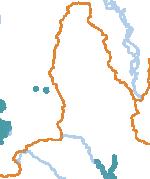

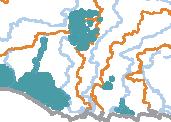
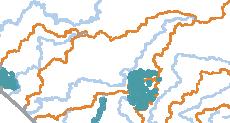

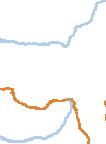

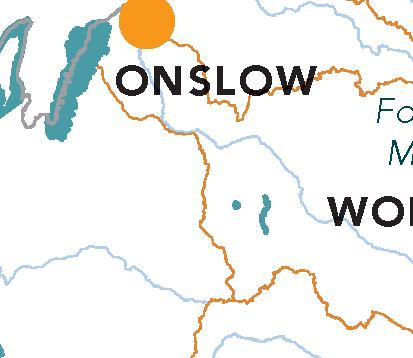




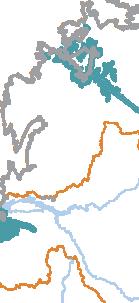













Low (0-1
High (3-4
Extremely High (4-5)
Low Medium (1-2)
UTAH POINT & SOUTH WEST CREEK
Wetlands (DBCA - 045)
Medium - High (2-3


High (3-4)
Hydrographic catchmentbasin boundary (DWER-027)
Extremely High (4-5)
Wetlands (DBCA - 045)
Hydrographic catchmentbasin boundary (DWER-027)

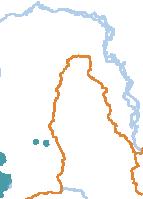



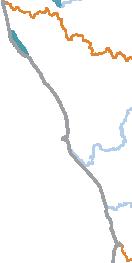
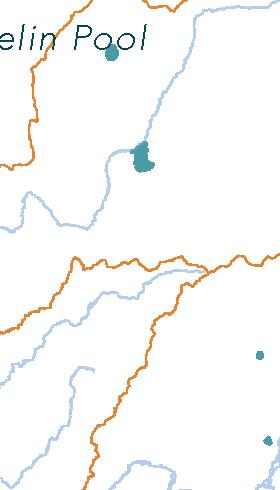


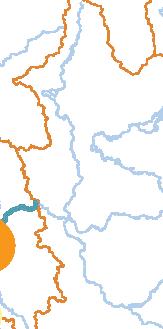
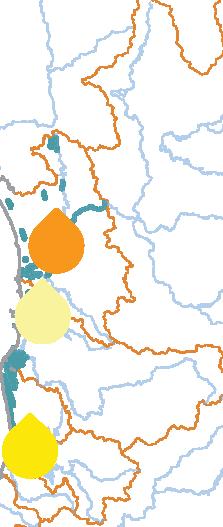
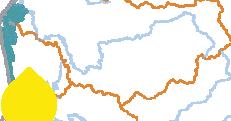

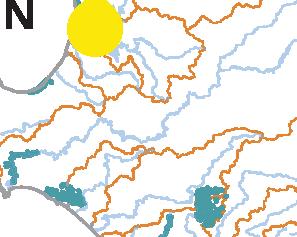










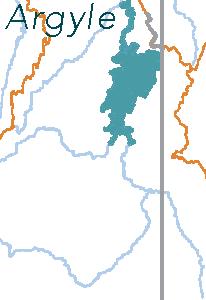
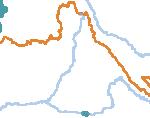
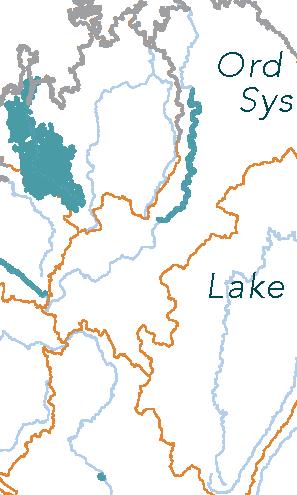
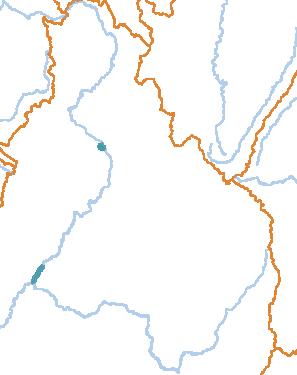


























Exmout h Gulf East
La ke Ma cLeod
La ke Ma cLeod
Shar k Bay East
Exmout h Gulf East
UTAH POINT & SOUTH WEST CREEK
Fortescue Marshes
WONMUNNA
Shar k Bay East
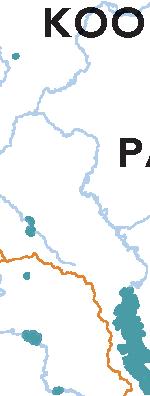



H amelin
Ya mp iS oun d
Tr aining Ar ea
Ya mp iS oun d
Ar le
H amelin
PERTH
KWINANA WORKSHOP
PERTH
KEMERTON
KWINANA WORKSHOP
KEMERTON
Eighty Mile Beac h Sy st em

Tr aining Ar ea Eighty Mile
IRON VALLEY
Do ra udall Riv er) S yst em
IRON VALLEY
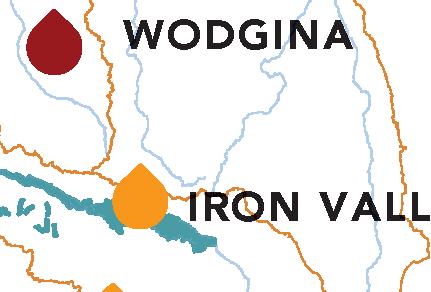

La ke Do ra (R udall Riv er) S yst em
La ke Disappointment (Sav or y Cr eek) Sy st em
La ke Disappointment (Sav or y Cr eek) Sy st em
La ke Ca rnegi e
Gibson Deser t G namma Ho le s
Gibson Deser t G namma Ho le s
La ke Ba rl ee Sy st em
La ke Ca rnegi e
La ke Ba rl ee Sy st em
La ke Ballar d
La ke Ballar d
KOOLYANOBBING MT MARION
PARKER RANGE
KOOLYANOBBING
PARKER RANGE
MT MARION
0 100 200km N
ESPERANCE PORT
0 100 200km N
ESPERANCE PORT
Figure 21: MinRes operations by water risk and proximity to environmentally important water resources
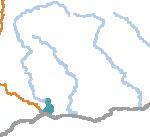

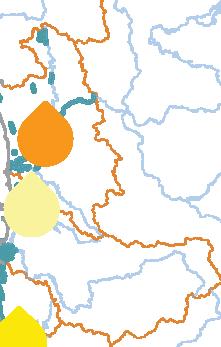
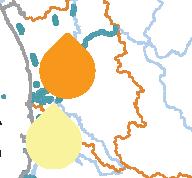


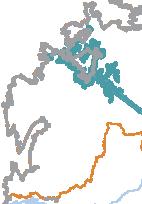
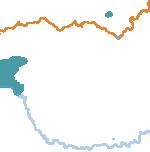
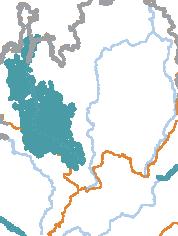











LIMITED 2023 SUSTAINABILITY REPORT I 131
MINERAL RESOURCES
WATER RISK MANAGEMENT
Our management approach to water-related risks is holistic and considers the contextual setting of the natural environment and the interactions that we, and our host communities, have with water resources.
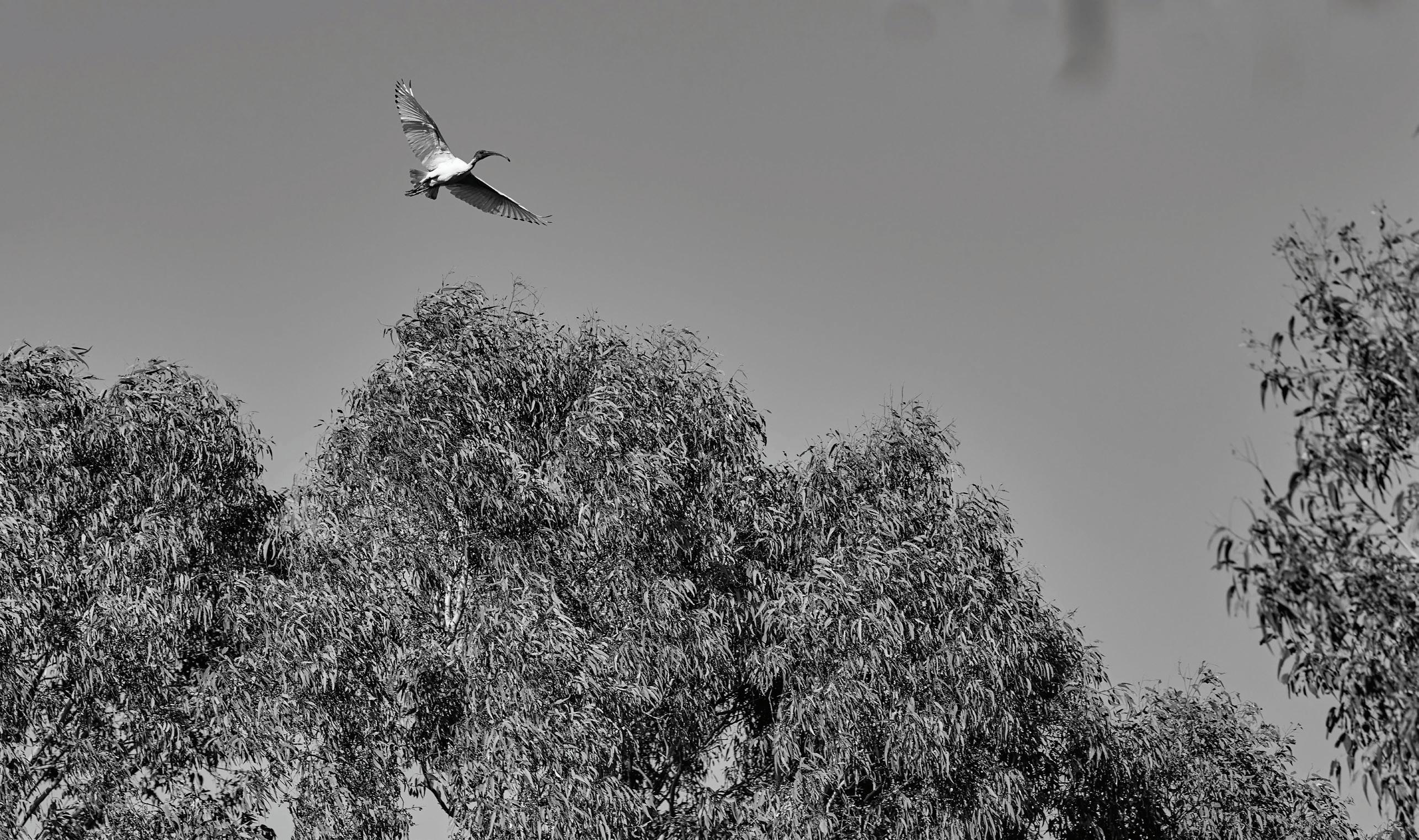
MinRes manages water-related risks through several mechanisms including, but not limited to, our corporate Enterprise Business Risk Register and Operational Risk Registers maintained at each of our mine sites. Strategic water-related risks are included in our Enterprise Risk Register, which is presented to the Audit and Risk Committee, Sustainability Committee, and the Board, four times a year. MinRes proceeds with operational activities when the residual risks to water values are considered acceptable and on the basis that there is no material risk to high-quality or scarce regional water resources, or water bodies of conservation significance.
Additionally, to support risk identification processes, MinRes assesses at a catchment level our operations’ baseline water stress level, according to the WRI 2021 Aqueduct Water Risk Atlas. The WRI provides a high-level overview of baseline water stress and considers 13 metrics, including water stress, water depletion, interannual and seasonal variability, groundwater table decline, riverine and coastal flood risk, drought risk, untreated connected wastewater, coastal eutrophication potential, unimproved/no drinking water, unimproved/ no sanitation and the Peak RepRisk country ESG12 risk index. This is complemented by our local water context and analyses to inform our approach towards developing and implementing appropriate management actions for each operation based on their level of risk.
Our year-on-year approach will evolve to reflect changes in risks and opportunities associated with water resources, and to support our operational, host community and environmental water-related needs.
ENVIRONMENT -
132 I MINERAL RESOURCES LIMITED 2023 SUSTAINABILITY REPORT
12 The Peak RepRisk country ESG risk index is an online database by RepRisk which quantifies business conduct risk exposure related to ESG issues for each country.
(CONTINUED)
ENVIRONMENT - (CONTINUED)
Table 9: Operational water status and sensitivity
YILGARN HUB PILBARA HUB LITHIUM COMMODITIES
Koolyanobbing Iron Valley Wonmunna Wodgina Mt Marion
Geographic location
Yilgarn Hub is located approximately 47km northeast of Southern Cross in the Shire of Yilgarn in Western Australia.
Iron Valley is located approximately 75km north-west of Newman in the Pilbara Region of Western Australia.
Climatic conditions
Arid to semi-arid with hot dry summers and cold winters.
Arid with warm to hot humid summers and prone to tropical cyclones.
Wonmunna is located approximately 80km north-west of Newman and approximately 360km south of Port Hedland in the Pilbara region of Western Australia.
Arid with warm to hot humid summers and prone to tropical cyclones.
Wodgina is located approximately 90km south of Port Hedland in the Pilbara region of Western Australia.
Arid with warm to hot humid summers and prone to tropical cyclones.
Mt Marion is located approximately 40km south-west of Kalgoorlie in the Goldfields region of Western Australia.
Water source / aquifer
Goldfields – Palaeochannel aquifer
Goldfields Combined – Fractured Rock West –Fractured Rock aquifer
Goldfields and Agricultural Water Supply Pipeline
Pilbara Hamersley –Fractured Rock aquifer
Pilbara Hamersley –Fractured Rock aquifer
Pilbara – Fractured Rock aquifer Decant water from processing operations
Arid to semi-arid with hot dry summers and cold winters.
Goldfields – Palaeochannel aquifer
Goldfields Combined –Fractured Rock West – Fractured Rock aquifer
Decant water from processing operations
Scheme water - Kalgoorlie to Esperance Water Supply Pipeline
Weeli
Water bodies of value or importance to Indigenous Australians and/or local communities3
Salt lakes (Lake Deborah & Lake Seabrook) Weeli Wolli Creek
1. Water risk as defined by the World Resources Institute (WRI) Aqueduct Water Risk Atlas. The WRI tool is open data and available for use under the Creative Commons Attribution International 4.0 License.
2. Biodiversity value is characterised by the number of water sources significantly affected by withdrawal where water bodies are designated as a nationally or internationally protected area; are listed in the Ramsar Convention; or have been identified as having high biodiversity value, such as species diversity and endemism that rely on the affected water source.
3. Water bodies listed as of value or importance to Indigenous Australians and/or local communities that are adjacent to or in close proximity of our operations and have management mechanisms in place to ensure both cultural and/or environmental values are maintained.
Water risk1 High Medium-high Medium-high Extreme-high High Precipitation (mm/annum) 284.9 314.5 314.5 328 265.2 Hydrographic catchment basins Avon River Fortescue River Fortescue River Port Hedland Coast Salt Lake Basins
Biodiversity value2 N/A
Wolli
Weeli Wolli
N/A N/A
Creek flows adjacent to the mine
Creek
Weeli Wolli Creek Turner River & Yule River Lake Lefroy
2023
I 133
MINERAL RESOURCES LIMITED
SUSTAINABILITY REPORT
Table 10 outlines key potential strategic risks associated with our water-related activities and management actions and controls that are planned or are currently in place.
Table 10: Risk identification and management approach for water-related activities
Potential risks
Climate change - Extreme weather events - Water risk
Changes to the intensity and frequency of extreme events such as cyclones, floods and droughts have the potential to increase the risk of damage to our facilities and existing infrastructure such as access roads, rail lines, mining pits, processing equipment and port facilities.
Mine operations - Secure water resources
The geographical locations, changing climatic conditions and nature of our operational activities have the potential to impact our ability to access secure water resources. The predicted decrease in annual rainfall due to climate change trajectories will increase our reliance on groundwater for dust suppression, mineral processing, slurry transport and drinking water. In addition, MinRes lithium operations are largely reliant on the availability of high-quality groundwater sources to support the beneficiation process. This reliance could potentially impact our operations’ water security and may result in the costly import of water into certain locations.
Management actions/controls
MinRes manages and has controls in place for current extreme weather events. Natural disaster preparedness includes, but is not limited to, cyclone emergency plans, managing stockpiles and factoring in wet weather delays into logistics schedules. As the frequency and magnitude of these events increase under a changing climate, MinRes will assess whether current controls are appropriate.
Refer to Our Climate Change Strategy for further information on how we identify, assess and manage climate-related risks.
MinRes optimises water management across all mine stages by implementing management controls through environmental impact assessments, ongoing hydrological monitoring and assessments.
Our dedicated teams review our operational water balance by adopting the Water Accounting Framework to understand the water resource risks and opportunities, enhancing the transparency around water stewardship.
Our operations, such as Wodgina and Mt Marion, have been designed to improve the efficiency of water consumption through recirculation and builtin water recovery circuits. Monthly reporting ensures ongoing governance of this aspect.
On-site water efficiency audits have been completed across our Wodgina, Mt Marion, Iron Valley and Yilgarn Iron Ore operations, with remaining operational sites planned for FY24. Improvement programs will be developed for some operations to increase water monitoring capability, assessing appropriate upgrades to our water monitoring infrastructure and determining investment avenues to better our water management.
Mine operations - Dewatering and discharge
Rainwater, water from dewatering and water from other sources can cause offsite run-off and erosion, and potentially collect sediment, nutrients and other contaminants.
All MinRes operations are designed as “closed loop” systems, except Iron Valley which requires approved discharges related to its large water surplus from mine dewatering activities.
MinRes conducts comprehensive baselines and ongoing monitoring of groundwater quality, and routinely inspects and maintains drainage system erosion and sediment control structures.
At our Iron Valley operation, physiochemical water parameters are monitored for discharge water and in receiving creek lines to assess and act on any potential threats to aquatic fauna and groundwater dependent ecosystems. Discharge points are designed to reduce the impacts of potential erosion and scouring on the receiving creek line, and thereby reduce potential impacts on the receiving environment, such as increased turbidity and sedimentation.
Mine closure
If managed incorrectly, mine closure activities have the potential to impact hydrological regimes of groundwater and surface water, cause adverse environmental and social impacts, and increase capital costs associated with management of water resources.
Effective asset closure and management is integral across our operations to ensure safe, stable, non-polluting and sustaining landforms remain.
All our mine sites have Mine Closure Plans which are developed and revised in consultation with key stakeholders and ensure all potential risks to both groundwater and surface water are appropriately considered. Refer to Mine Closure Planning for further information.
ENVIRONMENT - (CONTINUED) 134 I MINERAL RESOURCES LIMITED 2023 SUSTAINABILITY REPORT
OUR PERFORMANCE
Improving water efficiency
This year, MinRes continued to undertake water audits, developed our site-wide water balances and aggregated Company level water balance to identify water use efficiencies and facilitate more sustainable water management. Throughout FY23, MinRes also:
• increased our water team resourcing across the Iron Ore business
• improved compliance with the Mineral Council of Australia (MCA) Water Accounting Framework
• designed and commenced Water Efficiency Framework (WEF) audits across the MinRes portfolio, with audits completed at Wodgina, Mt Marion, Iron Valley, and Yilgarn Iron Ore operations
• improved the accuracy and reliability of our data collection and updated data simulation models of all sites in accordance with the MCA Water Accounting Framework
• installed telemetry to automatically collect, transmit and measure data on new flow meters and key monitoring bores, and progressively installed telemetry on existing flow meter infrastructure
• committed to creating a system for maintaining calibration of flow metering through on-site verification and off-site calibration when required by manufacturers and will maintain enough spares to cover periods when calibrations are required.
Water-related compliance
MinRes had no significant environmental incidents or incidents of non-compliance associated with water licences, standards and regulations during FY23.
Water balance
MinRes aligns its water disclosures with the accepted industry water accounting standard, the MCA’s Water Accounting Framework. This framework aims to improve data integrity and comparability across the industry to ensure the continuous improvement of water reporting.
We achieved improvements in water metering and data capture through water efficiency and modelling initiatives, which allows for an enhanced understanding of our water withdrawals, use and re-use opportunities.
ENVIRONMENT - (CONTINUED) MINERAL RESOURCES LIMITED 2023 SUSTAINABILITY REPORT I 135
- (CONTINUED)
Figure 22 provides a simplified overview of where water was withdrawn from, discharged and consumed across our operations during FY23. Refer to our 2023 Sustainability Performance Data Tables for further information on water volumes by commodity, water source, water quality and water stress.
Water abstracted and reused to enable operational activities including, but not limited to: • Ore processing • Dust control •
1. Water withdrawn is defined as water received, extracted or managed to meet operational water demand and reported by type – surface water, groundwater, and third party (municipal) water.
2. Change in storage includes temporary storage pits.
3. Task water: water used in tasks / operational activities which use water.
4 Surface water discharge: water removed from Iron Valley operation and returned to the environment.
Overall, our water withdrawals for FY23 amounted to 24.9GL, which represents a 16 per cent increase since FY22, attributable to increases in iron ore production.
MinRes applies criteria for determining water quality categories in accordance with the MCA’s Water Accounting Framework with high quality water (Category 1) and low-quality water (Category 3). Medium to low quality water (Category 2 and 3) accounted for 34 per cent of the total water withdrawal, comparative to 63 per cent of total water output aligning to high quality Category 1 type water. See Figure 23 for a breakdown.
Figure 22: FY23 water balance
ENVIRONMENT
136 I MINERAL RESOURCES LIMITED 2023 SUSTAINABILITY REPORT FY22 FY23 5,000 - 10,000 15,000 20,000 25,000 TOTAL OUTPUT (ML) TOTAL INPUT (ML) 21,391 24,880 19,177 16,756 FY22 FY23 Category One (High Quality) Category 2 Category 3 (Low Quality) SURROUNDING COMMUNITY & ENVIRONMENT 96% Category 1, 2 & 3 3% Category 1 <2% Category 1 & Category 3 58% Category 1 3% Category 2 & Category 3 21% Category 1, 2 & 3 8% Category 2 & Category 3 9% Category 3 Surface Water Third Party & Other Surface Water Discharge Groundwater GROUNDWATER OTHER EVAPORATION ENTRAINMENT TASK LOSS3 SURFACE WATER DISCHARGE4 7,386ML 4,069ML 1,716ML 1,600ML 11,119ML 671ML 625ML SURFACE WATER (includes precipitation) WATER OUTPUT OPERATION (TASK) ACTIVITIES WATER INPUT (WITHDRAWAL)1 TOTAL OUTPUT 19,177ML OTHER (pit groundwater recovery) 23,738ML GROUNDWATER 331ML THIRD PARTY 186ML Groundwater WATER REUSE 1,040ML TOTAL INPUT 24,880 ML CHANGE IN STORAGE 5,704 ML 2 Evaporation Entrainment Task Loss
Irrigation
• Tailings • Product and sanitation
Figure 23: FY23 water input and output by water quality (ML)
• Potable water transportation • Cooling • Wash down
NON-MINERAL WASTE OUR MANAGEMENT APPROACH
The generation of waste throughout the lifecycle of mining operations, processing and associated activities has the potential to cause environmental damage and human health hazards to our employees, contractors, communities and landscapes adjacent to our operations. To ensure waste is appropriately managed, MinRes monitors and reports on all hazardous and non-hazardous waste streams in accordance with the Waste Avoidance and Resource Recovery Act 2007 and landfill licence conditions issued by the Department of Water and Environmental Regulation (DWER).
MinRes developed a Waste Strategy during FY22 in consultation with a specialist waste consultant to advance the business towards more efficient waste management practices and circular economy outcomes across our operations. The Waste Strategy seeks to utilise waste assets and resources in the most efficient manner to maximise waste avoidance, waste reduction, and resource recovery in alignment, where possible, with the WA Waste Avoidance and Resource Recovery Strategy 2030. Key objectives of the Waste Strategy include:
• reducing environmental impacts resulting from the management of non-mineral waste by managing waste responsibly
• aligning with the WA State Waste Strategy, GRI and SASB standards for waste management
• identifying opportunities to minimise and manage waste in an efficient and sustainable manner.
As part of the Waste Strategy, an Implementation Plan was developed to provide a set of improvement initiatives. During FY23, MinRes progressed several initiatives, including:
• commencing a site waste audit and developing site Waste Management Plans
• improving waste data capture and reporting tools
• reviewing existing waste services and identifying opportunities for local and Indigenous services provider engagement.
OUR NON-MINERAL WASTE PERFORMANCE
During FY23, MinRes produced a total of 171,709 metric tonnes of non-hazardous and hazardous non-mineral waste across our operations. Approximately 20 per cent of non-hazardous waste was diverted from landfill in the form of recycled waste (Table 11). Overall waste volumes increased in FY23 in line with expanding construction and operational activities carried out by the business.
No significant spills or unauthorised disposal of non-mineralised waste occurred during FY23.
NON-HAZARDOUS WASTE
Non-hazardous waste generated by our mining operations and supporting facilities and offices includes general waste, comingled waste, construction and demolition waste, tyres and rubber, organics, scrap metal such as steel and lead, as well as non-hazardous liquid waste. Where waste cannot be reused or recycled, most of our operations maintain licenced landfill facilities on site to dispose items such as waste tyres, general putrescible, and inert waste.
During FY23, MinRes produced a total of 11,204 metric tonnes of non-hazardous non-mineral waste across operations (Table 11).
ENVIRONMENT - (CONTINUED) MINERAL RESOURCES LIMITED 2023 SUSTAINABILITY REPORT I 137
ENVIRONMENT - (CONTINUED)
HAZARDOUS WASTE
MinRes identifies, manages and reports on the potential risks and impacts of chemicals and hazardous substances on general safety, human health and the environment across our operations under site based EMPs and Safety Management Plans
Additionally, MinRes provides a framework for the management of chemical and hazardous substances through our Working with Hazardous Substances Procedure, Working with Hazardous Substances Management Standard and Hazardous Substance Registers
A total of 156,438 metric tonnes of solid and liquid waste was treated through wastewater treatment plants (WWTPs) operated at our Koolyanobbing, Windarling, Parker Range, Carina, Iron Valley, Wonmunna, Mt Marion, Wodgina and Onslow camp sites. Treated septic waste is disposed of via licenced evaporation ponds or irrigation fields. Wastewater quality and volumes are monitored and reported as part of annual environmental reports and annual audit compliance reports submitted to regulators.
During FY23, MinRes operations produced a total of 4,067 metric tonnes of hazardous non-mineral waste (excluding septic waste). Of this, approximately 73 per cent was diverted from landfill (Table 12).
Waste Type Non-hazardous(tonnes)waste FY21 FY22 FY23 Disposal Method General waste 1,801 3,369 7,128 Landfill Comingled waste1 44 219 227 Recycling Construction and demolition waste 25 83 201 Recycling Tyres and rubber 630 1,275 1,475 Landfill Tyres and rubber 0 0 189 Recovery - Recycling Liquid waste 0 7 9 Landfill Organics2 - - 299 Composting Scrap metal recycled - 1,341 1,676 Recycling Total 2,501 6,294 11,204
Table 11: Non-hazardous waste by type, weight and disposal method
Table 12: Hazardous waste by type, weight and disposal method
Waste Type (tonnes) Hazardous waste FY21 FY22 FY23 Disposal Method Medical waste - - 0.3 Incineration Liquid waste 1,370 1,716 2,944 Recycling Solid waste 130 607 1,115 Treatment and disposal Solid waste 0 0 8 Recycling Septic waste1 108,645 143,153 156,438 Treatment and disposal Total 110,145 145,475 160,505 138 I MINERAL RESOURCES LIMITED 2023 SUSTAINABILITY REPORT
1 Recycled solid waste category included in FY22 (0.15 tonnes reported) has been removed. All recycled solid waste was included under the comingled waste category and therefore the comingled waste figure for FY22 has been restated from 299.00 to 299.15.
2 Inclusion of organic waste category. Organic waste is recovered in a composting facility.
1 Septic waste includes the treatment and disposal of wastewater both on and off site.
SUPPORTING A CIRCULAR ECONOMY
MinRes supports WA’s efforts to become a plastic-free leader in Australia with the implementation of the West Australian Government’s Plan for Plastics in 2021. In alignment with the Plan for Plastics and our recently developed Waste Strategy, MinRes is committed to reducing and eliminating the use of single-use plastics across all operations and Perth-based sites.
mining camps have transitioned to biodegradable packaging resulting in the diversion of plastic waste from landfills.
Waste education
During FY23, MinRes collaborated with the external waste contractor responsible for managing waste at our headquarters to conduct waste education sessions with an aim to enhance awareness of the various streams of waste and appropriate item disposal. To tailor the education sessions effectively, we deployed a survey to gauge employees understanding and knowledge of waste segregation.
Additionally, we have implemented clear and informative signage across our headquarters to promote sustainable waste management practices.
TAILINGS AND MINING WASTE
Our mining operations generate mining-related waste including tailings and waste rock. Tailings are a by-product of the mining process, consisting of fine-grained processed rock or soil left over from the separation of the commodities of value from the ore within which they occur.
GOVERNANCE AND ASSURANCE
Container deposit schemes
In 2020, the WA Government introduced a state-wide beverage container deposit program known as Containers for Change, which helps ensure eligible containers are diverted from landfill. This program leads to cleaner recycling streams and improved resource recovery, while supporting increased employment and fundraising opportunities.
At our Kwinana Workshop and Wonmunna operation, we have supported the Containers for Change program with the source and separation of beverage containers for recycling at their nearest refund points. Funds received from the program will be donated to charity.
Sustainable packaging
During FY23, our Site Services and Procurement teams continued to progress the evaluation of sustainable packaging options available for our business to reduce our reliance on single-use plastics. MinRes continued to engage with eco-friendly WAbased suppliers and manufacturers and rolled out a range of biodegradable food and beverage packaging solutions across all operation camps and our Perth-based corporate office. All our
Responsible tailings management throughout the mine life cycle is a critical part of managing and minimising the risks from waste produced during the mining process. In line with best practice, management responsibility of the tailings storage facility (TSF) sits with the executive team while the Board maintains oversight of all tailings management. Potential consequences of a TSF failure can range from impact to sensitive receptors due to seepage to catastrophic release of solids and water.
To reduce the risk of TSF failure, a rigorous regulatory process is followed in WA. TSF details, including design, technical data, analyses, construction method, quality control and operational procedures, must conform to the DMIRS TSF Code of Practice, along with design, management and operational guidelines published by the Australian National Committee on Large Dams (ANCOLD) and other relevant bodies.
MinRes has committed to operating in line with the 15 principles and 77 requirements set out by the Global Industry Standard on Tailings Management (GISTM), published by the International Council on Mining and Metals (ICMM), the United Nations Environment Program (UNEP), and the Principles for Responsible Investment (PRI). MinRes sees value in the performance aspects of the GISTM and has elected to align its operations to these guidelines.
In compliance with the GISTM, MinRes has a Tailings Storage Facility Policy which outlines our commitment to designing, operating and managing our TSFs in a safe and responsible manner to ensure we meet the goal of zero harm to people and the environment, with zero tolerance for human fatality.
ENVIRONMENT - (CONTINUED) /ESUER R EPAIR RAW MATERIALS DESIGN PROCESS EMBEDDING CONSIDERATIONS FOR LATER RECYCLING REDUCED WASTE TO LANDFILL TAKEBACK RE-MANUFACTURE MANUFACTURE COLLECTION DISTRIBUTION CONSUMPTION RECYCLE
MINERAL RESOURCES LIMITED 2023 SUSTAINABILITY REPORT I 139
Figure 24: Circular economy principles

“AS A CHILD
I TRAVELLED AROUND KARIYARRA COUNTRY ON HORSEBACK LEARNING ABOUT KARIYARRA LORE, CULTURE, LANGUAGE, COUNTRY AND CUSTOMS FROM MY
ELDERS.”
Irene Roberts | Kariyarra Elder | Pilbara region, WA
OUR OPERATIONAL MANAGEMENT APPROACH
MinRes’ tailings management process is informed by surveillance and monitoring programs, conducted across all TSFs, with active TSFs undergoing daily inspections, annual audits and external design reviews. Ongoing surveillance programs collect key information such as the geological and structural features of the TSFs and their foundations, enabling early detection of any potential deterioration. Refer to Business Ethics and Integrity: Risk Management for further detail regarding our risk management reporting and Board oversight.
MinRes focuses on the safety of our TSF’s through all phases of the lifecycle with consideration of factors impacting all key stakeholders through project conception, planning, design, construction, operation, closure and post closure. This includes the proximity to employees, communities and infrastructure, and the geological conditions and deposition of the tailings. Our TSF management is incorporated into broader site management systems in a safe and compliant manner consistent with regulatory requirements, applicable guidelines and standards. We engage external design engineers for each facility and independent reviews are undertaken by external engineers. Additional assurance is provided by our technical specialists, with support from external experts.
Our risk-informed approach includes the below overarching operating practices to provide a robust approach for sustainable tailings management:
• Site operational controls, surveillance and monitoring
• Technical and operational support provided by internal subject matter experts
• Design, operational support and risk review provided by external Engineer of Record
• Regular inspection, review and reporting by independent experts
• Board oversight of risks.
We are confident in the safety and security of our TSFs and are committed to continually reviewing our facilities and procedures to maintain a high standard of safety at our operations. We take into consideration learnings from our peers to promote continual improvement and ensure the most suitable approach to performance and risk management.
Our tailings storage facilities
MinRes' strategy for tailings disposal management is to design TSFs that are suitable for the local conditions and tailings material to be deposited.
MinRes separates its tailings into “coarse” and “fine” streams in the process plant. The coarse streams, with larger particles, are dewatered via filtering and then trucked to the waste rock dumps for comingling with the waste rock material. The blending of the tailings with the waste rock provides benefits including reducing the potential for surface water ingress into the waste rock landforms by the tailings consuming a portion of the void space. Separating out the tailings allows only the fine stream to be directed to the TSF, reducing the storage volume and therefore size of facility required.
MinRes currently has two main approaches to TSF design for the finer tailings: valley-fill (Figure 25) and in-pit storage (Figure 26) type facilities, based upon review of site characteristics, the availability of suitable materials for embankment construction, including maximising the use of waste rock where possible, and consideration of the geotechnical characteristics of the tailings. These design approaches align with industry best practice.
Regardless of the design and construction, it is critical that the TSF is operated in accordance with the design intent and risk mitigation measures in place. The MinRes Board and engineering personnel work with the operators of each TSF to ensure the facility is managed according to the design basis. Personnel involved in daily operations at our TSFs are regularly briefed on the latest developments in TSF design, operation and risk management.
Compacted embankment Natural ground level Decant pond Freeboard Tailings (inert) Tailings deposition Waterproof liner
ENVIRONMENT - (CONTINUED) 142 I MINERAL RESOURCES LIMITED 2023 SUSTAINABILITY REPORT
Decant water returned to plant
Figure 25: Valley-fill type TSF (TSF3E is an example of this type of facility)
MinRes manages four active TSFs, three decommissioned TSFs and one TSF in care-and-maintenance. All TSFs are in remote areas and significant distances from local communities and infrastructure.
1. Wodgina TSFs
a. TSF3 Extension (TSF3E): This is a partially lined valleyfill type TSF. A continual surveillance program collects information on the hydrological and structural features in the dam and its foundation, amongst other operational data, enabling early detection of any deterioration of the tailings dam structure posing a potential risk.
b. Atlas in-pit TSF: This in-pit tailings disposal in a mined-out pit void represents a reduced risk when compared to an above-ground TSF, as the potential of discharge of tailings to the environment is negligible. Mitigating factors to flooding risk include current mine drainage infrastructure in and around the Atlas pit, net site water use requirements, along with current optimised return water pumping protocols to promote beach formation and consolidation.
c. TSF1 – 3: Three decommissioned TSFs remain at the Wodgina operation, all capped with waste rock.
2. Mt Marion - Ghost Crab In-pit TSF: This in-pit tailings disposal in a mined-out pit void represents a reduced risk when compared to an above-ground TSF, as the potential of discharge of tailings to the environment is negligible. Mitigating factors to flooding risk include current mine drainage infrastructure in and around the Ghost Crab pit and net site water use requirements.
3. Koolyanobbing - C Pit In-pit TSF: This in-pit tailings disposal represents the lowest tailings disposal risk of current industry methods – a combination of filtering the tailings (substantially reducing the moisture content) and disposing in a mined-out pit void. Disposal of tailings into this pit began in FY23, which involves placement of filtered lithium tailings from Albemarle’s lithium hydroxide monohydrate production plant in Kemerton, Western Australia.
4. Coobina TSF1: The Coobina Chromite mine (Pilbara Chromite Pty Ltd) is currently in care and maintenance. TSF1 is a paddock-type storage, inactive and stable.
Further information on our TSFs hazard classification and consequence of failure, both active and decommissioned, can be found in our 2023 Sustainability Performance Data Tables
Figure 26: In-pit type TSF (Ghost Crab TSF is an example of this type of facility)
Pit walls
Natural
level
Pre-mining water table
ground
Tailings deposition
Tailings (inert)
ENVIRONMENT - (CONTINUED) MINERAL RESOURCES LIMITED 2023 SUSTAINABILITY REPORT I 143
Mined-out pit void
Freeboard Decant water returned to plant Decant pond



“WHEN YOU’RE A LEADER, THE HIGHER UP YOU GO IN AN ORGANISATION, THE LESS IT BECOMES ABOUT YOU.”
Ivor Jezdik | Executive General Manager Project Development
“WE TEACH OUR GRANDCHILDREN ABOUT LORE AND CULTURE, TO PASS ON OUR KNOWLEDGE AND KEEP OUR TRADITIONS AND CULTURE ALIVE FOR FUTURE GENERATIONS.”
Anne Hayes | Thalanyji Elder | Pilbara region, WA
OUR PERFORMANCE TAILINGS
During FY23, MinRes conducted a high-level gap assessment between the GISTM requirements and the current design, administrative and operational aspects of our tailings management system which identified a number of actionable items. We progressed addressing some of the gaps against the GISTM requirements across all our directly controlled and managed operations, including but not limited to:
• development of a TSF Policy
• appointment of an external Engineer of Record
• formation of a multi-disciplined team to focus on understanding and implementing relevant actions to bridge the gaps with GISTM
• ongoing TSF surveillance and design, administrative and operational review.
During FY23, MinRes produced 4,154,664 metric tonnes of tailings across our operations. Tailings data is shown in Table 13. No incidents relating to tailings spills took place during FY23.
WASTE ROCK
Waste rock is excavated to reach the ore body and is typically disposed in waste rock landforms and/or backfilled into pits, where possible. Selected inert waste is used for the construction of mine roads and run-of-mine pads.
Baseline and progressive physical and geochemical characterisation test work is undertaken on all waste rock to determine if dispersive, saline or potentially acid forming materials are present. These studies inform appropriate operational management of waste rock and guide our rehabilitation and mine closure planning and design.
Waste rock is our largest stream of waste generated during operations. MinRes total waste rock is disclosed in Table 14. Waste rock mined at Koolyanobbing and Iron Valley decreased due to most of the material extracted from pit voids being a marketable quality product. Waste rock mined at Wonmunna, Mt Marion and Wodgina increased in quantity reflecting changes in our operations over time and significant growth in our mining operations.
Operation FY21 DMT FY22 DMT FY23 DMT Mt Marion – Wet Tailings (Ghost Crab Pit) 757,573 826,766 808,263 Mt Marion – Coarse Tailings (waste rock dumps) 945,381 994,337 736,709 Wodgina1 – Wet Tailings (TSF3E) 0 194,474 1,953,945 Wodgina1 – Coarse Tailings (waste rock dumps) 0 0 635,707 Koolyanobbing2 (Tailings from Albemarle Kemerton Plant) 0 0 20,040 Total 1,702,954 2,015,577 4,154,664
Table 13: Historical cumulative tailings for Mt Marion, Wodgina and Koolyanobbing operations
ENVIRONMENT - (CONTINUED)
1 Wodgina was in care and maintenance from FY20 to February FY22.
146 I MINERAL RESOURCES LIMITED 2023 SUSTAINABILITY REPORT
2 Koolyanobbing in-pit TSF did not receive tailings during FY21 to FY22.
- (CONTINUED)
BIODIVERSITY OUR MANAGEMENT APPROACH
MinRes recognises the nature of our operations has the potential to impact natural habitats and ecosystems, both directly and indirectly, with any reduction in the quantity, quality or resilience of ecosystem services from a biodiversity loss posing a significant risk to our environment, climate, livelihoods and societies. We acknowledge our responsibility in avoiding, minimising and rehabilitating the impact our operational activities may cause to ecosystems, and the inherent value healthy ecosystems provide in supporting the long-term viability and sustainability of the mining industry.
We operate in accordance with all applicable legislation, standards, compliance obligations and codes of practice and are committed to respecting all legally designated protected areas and conservation significant species, including UNESCO Natural World Heritage sites, UNESO Man and the Biosphere Reserves, Wetlands designated under the Ramsar Convention, and International Union for Conservation of Nature (IUCN) category I-IV areas.
MinRes integrates responsible environmental management practices during all aspects of the mine lifecycle to protect the long-term health of the environment and communities where we operate. Our dedicated Environment team are responsible for ensuring that biodiversity is appropriately managed and protected across our operations, while the MinRes Board is charged with ultimate oversight of biodiversity risks and opportunities. Refer to Our Environmental Management Approach for further information on our environmental management, policies and processes.
As required under the EP Act, MinRes undertakes ecological surveys of biodiversity values including for local flora and fauna, with the support of external consultants, to assist in the development of environmental impact assessments. When undertaking these assessments, we consult with all relevant and affected stakeholders, including but not limited to Traditional Owners, Federal and State government authorities and local communities. Consultation and collaboration with stakeholders are ongoing throughout the lifecycle of our operations to develop integrated approaches to effectively minimise and rehabilitate impacted areas. Refer to Community and Stakeholder Relationships for further information.
Recognising the need to enhance our understanding of the relationship between nature and our operations to enable scientifically informed decisions to better mitigate risks and build resilience, MinRes is committed to aligning with the Taskforce on Nature-related Financial Disclosures (TNFD) framework, due to be released in September 2023.
ENVIRONMENT
Unit ‘000 WMT Operation FY21 FY22 FY23 Yilgarn Hub (Iron Ore) Koolyanobbing 51,301 51,553 29,786 Pilbara Hub (Iron Ore) Iron Valley 28,816 20,205 11,827 Wonmunna 3,603 14,791 16,854 Lithium Commodities Mt Marion 27,654 29,196 43,375 Wodgina1 176 609 9,201 Total 111,549 116,356 111,043
1 Wodgina was in care and maintenance from FY20 to February FY22.
MINERAL RESOURCES LIMITED 2023 SUSTAINABILITY REPORT I 147
Table 14: Waste rock quantities
OUR STRATEGY
During FY23, MinRes developed a dedicated biodiversity function to coordinate the development and implementation of a corporate Biodiversity Strategy and ecological research programs in key biodiversity areas. The Biodiversity Strategy, currently undergoing internal subject matter expert review, aims to set out the principles and proposed actions by which MinRes aims to manage its collective interactions with biodiversity, identify and evaluate its environmental impacts, apply the mitigation hierarchy framework, and track progress against environmental targets and goals. The Biodiversity Strategy has been designed in alignment with the TNFD, as well as relevant state, national and international reporting requirements, guidance and initiatives. This will aid in meeting the interests and expectations of our key stakeholders, including regulators and the community.
We work to ensure both direct and indirect environmental impacts are avoided, minimised, rehabilitated or restored and offset in alignment with the mitigation hierarchy (Figure 27).
BIODIVERSITY CONSERVATION AND MITIGATION OF ENVIRONMENTAL IMPACT
Improving biodiversity, ecological integrity and ecosystem services. Aspiring towards no net loss of biodiversity, and where possible net positive biodiversity and ecosystem outcomes, resulting from activities.
UNDERPINNING VALUES:
TRANSFORM
Engage in efforts that promote transformational change to address the drivers and root causes of biodiversity loss. This may involve implementing changes to technology or promoting shifts in values and behaviours.
INTEGRATE KNOWLEDGE
Establish mechanisms that incorporate and share evidence and experience-based knowledge into planning, design, and operations across all phases.
ENGAGE STAKEHOLDERS
Ensure active engagement with stakeholders on biodiversity related issues and actions, monitoring, and evaluation.
MINIMISE AVOID REHABILITATE OR RESTORE
OFFSET
ENVIRONMENT - (CONTINUED) 148 I MINERAL RESOURCES LIMITED 2023 SUSTAINABILITY REPORT
Figure 27: Biodiversity management principles as underpinned by the mitigation hierarchy

To successfully apply the mitigation hierarchy and track progress against targets and goals across our operations, we have developed 10 high-level aspirational objectives, which are supported by actionable plans and procedures (Figure 28).
MINRES BIODIVERSITY AND ENVIRONMENTAL OBJECTIVES
Strive for net positive environmental impacts and biodiversity and ecosystem functioning beyond baseline compliance requirements.
Monitor biodiversity and ecosystem responses with robust metrics to track progress.
Integrate biodiversity valuing, protection and awareness across all business operational stages, supply chains and communities.
Take a holistic, life-of-mine, ecosystem and landscape level approach to biodiversity conservation and ecosystem management and understand the biodiversity values in our areas of operation.
Implement conservation, restoration, and offsetting activities with an aim to achieve outcomes at species, habitat, and ecosystem levels.
Apply the mitigation hierarchy to protect and prevent loss of species with a focus on threatened and culturally significant taxa and maintenance of high biodiversity areas and ecosystem services.
RISK MANAGEMENT
Seek opportunities to contribute and collaborate to promote positive environmental outcomes beyond land under Company stewardship and within our supply chain.
Manage and minimise biosecurity risks from invasive species, pathogens, and pests.
Foster collaboration with stakeholders, particularly Indigenous Australians for broadscale success in biodiversity conservation and ecosystem management.
Base environmental decision-making on science, reliable data, and diverse cultural knowledge.
Our management approach to biodiversity-related risks has been designed to safeguard not only the natural ecosystems and habitats surrounding our operations, but also the communities and stakeholders reliant on the integrity of these environments. MinRes manages biodiversity-related risks through several mechanisms, including but not limited to our Corporate Enterprise Business Risk Register and Operational Risk Registers maintained at each of our mine sites. These registers are presented to the Audit and Risk Committee, Sustainability Committee and the Board on a quarterly basis. Refer to Operating with Ethics and Integrity: Risk Management for further information.
Table 15 outlines key potential biodiversity-related risks that have been identified and the management actions and controls that are planned or are currently in place.
ENVIRONMENT - (CONTINUED)
Figure 28: Biodiversity and environmental objectives
150 I MINERAL RESOURCES LIMITED 2023 SUSTAINABILITY REPORT
Potential risks
Biodiversity loss, extirpation of local flora or fauna populations, and potential species extinctions.
Partial or total loss of habitat, including critical habitat such as coarse woody debris, hollow bearing trees, or cave structures.
Fragmentation of habitat resulting from creation of infrastructure corridors and cumulative regional impacts.
Changes to water availability or quality through contamination, dewatering, injection and recharge, and infrastructure impacts.
Direct death of fauna from vehicle strike, clearing activities, or inadequate egress structures.
Alteration to fauna species behaviour from secondary disturbances such as noise, artificial light, and vibration.
Introduction and assisting spread of invasive species and pests.
Contamination from hydrocarbon spills, inappropriate waste disposal, leaching of materials, PAF material.
Reduced air quality and impacts to vegetation from dust and other particulates.
Creation of post-mining environments unsuitable for flora and fauna requirements.
Changes to ecosystem structure and functioning, alteration to natural processes such as fire regimes and hydrological cycles.
Contribution to changes in regional and global climate.
Erosion of genetic diversity and isolation or restriction of gene flow among flora and fauna populations.
Management actions/controls
• Adhere to approved clearing areas and permits.
• Implement fauna and flora management plans.
• Conduct appropriate baseline surveys.
• Develop and implement land clearing procedures.
• Plan and execute rehabilitation works.
• Create artificial habitat structures.
• Engage with regional stakeholders to develop landscape-scale projects.
• Plan and execute rehabilitation works.
• Advance offset opportunities.
• Engage with regional stakeholders to develop landscape-scale projects.
• Ensure appropriate landform design.
• Implement water management plans and water sensitive designs.
• Implement fauna MPs.
• Conduct environmental education.
• Adhere to approved clearing areas and permits.
• Develop and implement management plans.
• Implement noise, vibration, and artificial light control measures.
• Implement feral fauna and weed management plans.
• Engage with regional stakeholders to undertake joint targeted feral fauna and weed control programs.
• Develop and implement PAF management plans.
• Ensure appropriate landform design and water sensitive design.
• Embed a waste management strategy.
• Embed dust management strategies.
• Develop and implement significant flora MPs.
• Plan and execute rehabilitation and closure plans.
• Engage in targeted research programs for significant species.
• Conduct appropriate baseline surveys.
• Develop and implement fauna and flora MPs.
• Plan and execute rehabilitation and closure plans.
• Consider climate change in Company policies.
• Implement efforts to reduce emissions.
• Develop and implement offset programs.
• Develop and implement fauna and flora MPs.
• Advance offsets opportunities.
• Execute effective rehabilitation and closure.
(CONTINUED)
ENVIRONMENT -
MINERAL RESOURCES LIMITED 2023 SUSTAINABILITY REPORT I 151
Table 15: Risk identification and management approach for biodiversity-related activities
Where required, we implement noise, vibration and artificial light control measures, such as the separation or enclosure of noise sources and design considerations to reduce noise and vibrations. Vibration impacts associated with blasting activities are managed and mitigated through effective blast designs and monitoring programs. MinRes manages the prevention of introduced weed species through strict hygiene practices for all vehicles and mobile equipment entering and exiting sites where weeds are present. Feral fauna on our sites is managed by measures including feeding restrictions, appropriate waste hygiene practices, onsite training on feral fauna management, feral fauna monitoring and active control where required.
We undertake further biodiversity risk assessments during operational phases and as part of the expansion of mining activities. Sitespecific environmental commitments are outlined as part of the conditions of environmental approval. In accordance with Part IV of the EP Act, MinRes implements EMPs for the management, monitoring and reporting processes associated with environmental impacts of approved operations and activities, where applicable. We implement a range of EMPs to ensure all conservation significant fauna, flora, vegetation, and ecological communities as listed under the EPBC Act, the Biodiversity Conservation Act 2016 (BC Act) or under the DBCA as Priority species/communities are appropriately managed to minimise the direct and indirect impacts of our operations. These include management plans on aspects such as fauna, flora and vegetation health and condition, weed monitoring, artificial light and land clearing.
Research initiatives
During FY23, we continued our support through the implementation of various conservation research initiatives.
• Environmental DNA (eDNA) research program with Curtin University to examine how recent technological advances can provide more robust and efficient biodiversity survey techniques to define rehabilitation success. Click here for further information.
• The use of drone technology to undertake rehabilitation surveys and see broadcasting with Dendra Systems, improving the speed and accuracy of survey and rehabilitation works.
• Research programs to investigate the ecology and habitat requirements of Malleefowl with the National Malleefowl Recovery Group, towards better conservation and restoration outcomes for the species.
• Development of a tool to utilise high resolution satellite imagery for near real-time monitoring of the health of groundwater dependent vegetation and other important ecosystems with FrontierSI and Curtin University.
152 I MINERAL RESOURCES LIMITED 2023 SUSTAINABILITY REPORT ENVIRONMENT - (CONTINUED)
OUR BIODIVERSITY PERFORMANCE
Table 16: Site biodiversity status and species per IUCN Red List conservation status
Koolyanobbing
Yilgarn Hub is located approximately 47km
Lithium Commodities Ashburton Hub
Geographic location
north-east of Southern Cross in the Shire of Yilgarn in Western Australia.
Iron Valley is located approximately 90km north-west of Newman in the Pilbara Region of Western Australia.
Wonmunna is located approximately 80km north-west of Newman and approximately 360km south of Port Hedland in the Pilbara region of Western Australia.
Wodgina is located approximately 90km south of Port Hedland in the Pilbara region of Western Australia.
Mt Marion is located approximately 40km south of the City of Kalgoorlie-Boulder in the Goldfields region of Western Australia.
The Ashburton Hub port facilities are located 12km from Onslow. Mining deposits are located between 35 and 85km south of Panawonica. A connecting haul road will facilitate transport of ore.
Type of operation
Iron ore mine operations including haulage on private haul road, on-site processing and train loading.
Iron ore mine operations including on-site processing.
Iron ore mine operations including on-site processing.
Lithium mine operations and on-site beneficiation plant.
Lithium mine operations and on-site beneficiation plant.
Iron ore mining, processing, haulage and shipping.
Position in relation to protected area (in the area, adjacent to, or containing portions of) or the high biodiversity value area outside protected areas
Biodiversity value characterised by the attribute of the protected area or area of high biodiversity value outside the protected area (terrestrial, freshwater, or maritime ecosystem)
Biodiversity value characterised by listing of protected status (such as IUCN Protected Area Management Categories, Ramsar Convention, national legislation)
Operation is located near the Mount Manning - HelenaAurora Ranges.
Rare flora are also located in the Koolyanobbing Range and the Windarling Range.
The operation is adjacent to Weeli Wolli Creek, located along the eastern boundary of the site.
Wonmunna is located approximately 26.5km upstream of the Weeli Wolli Springs Priority Ecological Community (state listed PEC).
The operation is not located in or adjacent to any protected areas under either state or Commonwealth legislation.
The operation is not located in or adjacent to any protected areas under either state or Commonwealth legislation.
This operation is located near the Cane River Conservation Park, and adjacent to state listed PEC.
Conservation park that is part of Australia’s National Reserve System (NRS).
Priority 1 Ecological Community under the Biodiversity Conservation Act 2016
Priority 1 Ecological Community under the Biodiversity Conservation Act 2016
Conservation park that is part of Australia’s NRS, and Priority Ecological Community under the Biodiversity Conservation Act 2016
ENVIRONMENT - (CONTINUED)
Yilgarn Hub Pilbara Hub
Iron Valley Wonmunna Wodgina Mt Marion
Size of operational site (ha) 4,539 587 483 1,277 958 251
Terrestrial Freshwater N/A N/A N/A Terrestrial Maritime
N/A N/A
MINERAL RESOURCES LIMITED 2023 SUSTAINABILITY REPORT I 153
ENVIRONMENT - (CONTINUED)
Table 17 provides the number of National Conservation listed species as per the EPBC Act and IUCN listed species located in and around areas of operations.
Table 17: Number of IUCN Red List species and species with national conservation status, occurring in areas affected by the operations of the organisation, by level of extinction risk
1 Koolyanobbing, Mt Jackson, Windarling and Deception are connected by a private haul road. Our Carina operations (Carina and J4) which form part of the ‘Yilgarn’ hub are connected to the Koolyanobbing operations via the private J4 haul road. Parker Range is connected by the public road network to Koolyanobbing and by a private road to Carina. A private haul road linking Parker Range and Koolyanobbing has been approved by the Environmental Protection Authority (EPA) and is currently under assessment with Department of Climate Change, Energy, the Environment and Water (DCCEEW).
2 Species distributions for IUCN listed species were downloaded from the Integrated Biodiversity Assessment Tool in May 2023. ArcGIS was utilised to identify all species with habitat that occur within MinRes operational areas.
3 Number of EPBC Act listed species with potential habitat in the area of MinRes operations were attained through state of Western Australia Department of Biodiversity, Conservation and Attractions (DBCA) habitat searches cross referenced to the EPBC Act listing to indicate species of national conservation. Where site specific biodiversity survey and impact assessment information was available, it was utilised to complement the database information.
4 Onslow Iron project data has been included.
▲ increase / ▼ decrease from previous financial year as a result of updated GIS spatial data increasing or changing operational footprint resulting in additional species and/or as a result of flora and fauna study verification.
LAND MANAGEMENT AND REHABILITATION OUR MANAGEMENT APPROACH
Land disturbance is an inevitable part of the mining process. MinRes recognises the important role of land management and rehabilitation in responsible mining across the life of a mining operation. Landscape rehabilitation is critical to reinstate ecosystem functionality and land productivity to ensure the long-term stability and sustainability of the landforms, soils and hydrology at each mine site.
MinRes aims to rehabilitate and close disturbed land in a manner that is physically safe to humans and animals, is geo-technically stable and geochemically non-polluting/non-contaminating, and capable of sustaining an agreed post-mining land use without unacceptable liability to the state. This commitment is in accordance with the WA Government DMIRS objectives for mining activities.
Mine site rehabilitation is a legal obligation for all mining operations in Australia. MinRes aims to comply with all applicable legislation and standards, as poorly rehabilitated mine sites can leave significant legacy problems for the environment, local communities and governments. The Mining Rehabilitation Fund Act 2012 (MRF Act) established the Mining Rehabilitation Fund (MRF) as a pooled fund, levied annually according to the environmental disturbance existing on a tenement. Levies paid into the MRF support rehabilitation efforts where an operator fails to meet their rehabilitation obligations and every other effort has been made to recover the funds from the operator.
Tenement holders operating on Mining Act 1978 tenure are required to report data on land disturbance and land under rehabilitation to DMIRS under the MRF.
IUCN 2 Yilgarn
Pilbara
Lithium Commodities Ashburton Hub Onslow Iron project4 Koolyanobbing 1 Iron Valley Wonmunna Wodgina Mt Marion Critically endangered 0 ▲ 1 ▲ 1 0 0 0 Endangered ▼ 15 ▼ 1 ▼ 0 3 3 3 Vulnerable ▲ 28 2 ▲ 4 ▲ 6 ▲ 8 4 Near Threatened 12 3 3 ▼ 11 9 8 Least Concern ▲575 ▼ 363 ▲ 394 ▲ 463 ▲355 461 Critically endangered ▼ 0 0 0 ▲ 2 0 1 Endangered ▼ 1 2 ▲ 1 1 0 1 Vulnerable ▲ 3 ▲ 2 ▲ 3 ▼ 3 ▲ 3 3 = NATIONAL 3
Hub
Hub
154 I MINERAL RESOURCES LIMITED 2023 SUSTAINABILITY REPORT
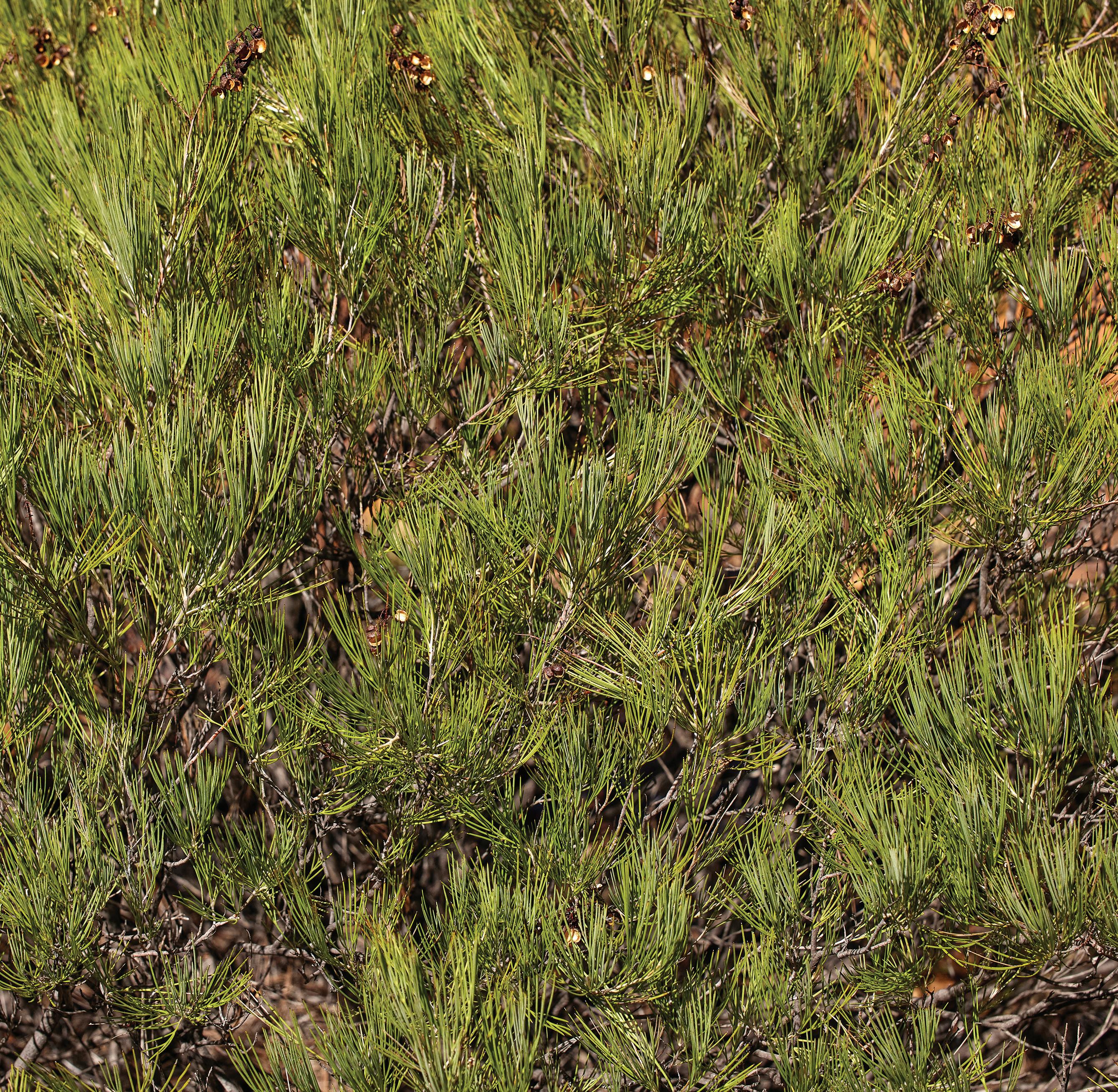
In support of best practice biodiversity outcomes, MinRes' Rehabilitation Strategy aligns to the United Nations Decade on Ecosystem Restoration 2021–2030, developed “with the aim of supporting and scaling up efforts to prevent, halt, and reverse the degradation of ecosystems worldwide and raise awareness of the importance of successful ecosystem restoration”. Our Rehabilitation Strategy sets standards to define outcomes for core activities associated with the planning and design phases of rehabilitation, including waste management, topsoil/growth medium management, landform construction and revegetation.
MinRes recognises the nature and extent of our operations may lead to residual impacts to the environment. To counterbalance any significant residual impacts due to applying the mitigation hierarchy, MinRes identifies suitable offsets areas. The overall management objective for MinRes offset areas is to maintain or enhance environmental outcomes through the protection, maintenance and enhancement of habitat and establishment of high-quality ecological communities for a wide range of species. Our approach to land management and rehabilitation aligns with regulator and stakeholder expectations and values. Refer to Managing Our Relationships with Communities and Stakeholders for further information.
Risk management
In-keeping with our broader approach to manage environmental risks, MinRes manages rehabilitation-related risks through our Enterprise Business Risk Register and Operational Risk Registers facilitated at each of our mine sites. These registers are presented to the Audit and Risk Committee, Sustainability Committee, and the Board on a quarterly basis.
We support research and seek to continually improve revegetation methods, conducting regular rehabilitation monitoring to ensure we progress towards achieving self-sustaining native vegetation.
OUR PERFORMANCE Technical studies
Technical studies play a crucial role for informed decision-making in mine closure planning by providing critical information about environmental impacts, feasibility of post mining land uses, hazard mitigation, stakeholder involvement, and compliance to regulations. These studies are instrumental in the development of closure plans that prioritise environmental sustainability and ensure successful rehabilitation.
Technical studies carried out across the portfolio include waste rock characterisation, topsoil assessments, hydrogeological and hydrological modelling as well as annual seed collection. During FY23, 17 technical studies were conducted to address closure knowledge gaps.
Seed collection
A critical component of mine site rehabilitation is the acquisition of native seeds for use in near-term works and in establishing a bank of seeds for use in future works.
The collection or sourcing of native plant seed is undertaken as part of the rehabilitation process of waste rock landforms and other disturbed areas during mining and exploration. Seed is typically collected as near as practical to the mine to develop a bank of local provenance seed. Each year, MinRes continues to develop and refine plant species lists to define the target plant species for the Yilgarn and Pilbara tenements.
ENVIRONMENT
(CONTINUED)
-
FY21 FY22 FY23 Number of studies conducted 4 39 17 Approximate cost ($) 250,000 5,000,000 4,000,000
156 I MINERAL RESOURCES LIMITED 2023 SUSTAINABILITY REPORT
Table 18: Technical study spend
Any seed collected is processed and stored by a commercial provider in a climatecontrolled environment ready for use in rehabilitation works. During seed collection, MinRes observed the large-scale native seed supply industry in Western Australia is constrained by a shortage of skilled and dedicated seed collectors. While engaging seed supply contractors, MinRes also built relationships with Indigenous organisations and enterprises across the State with the aim of fostering skills and capacity in areas including seed collection.
MinRes also fostered training with Traditional Owners to support seed collection and processing, and in the business aspects of native seed harvesting and brokering. Collaborative restoration processes further help protect traditional ecological knowledge while restoring knowledge, biodiversity and ecological functions to the lands on which MinRes operates.
Seedling performance
The rehabilitation of waste rock landforms is an important but expensive phase for mining companies, with the seeding of these areas presenting significant costs and uncertainties due to the hostile environmental conditions and challenges associated with seed establishment. To address these challenges, new technologies have been developed to try and enhance the survival rates of the seeds, with seed pelleting a promising approach to safeguard against predation, wind and surface runoff.
MinRes has recently undertaken drone seeding trials broken into one-hectare sections across six hectares on a newly rehabilitated landform at Jackson 1, located at our Yilgarn Iron Ore Operations. Bentonite pellets containing local provenance seeds were spread at controlled rates and within controlled areas, including various trials of 2kg to 8kg of pelleted seed.
Land disturbance and rehabilitation
Figure 29 provides a summary of land disturbed and rehabilitated for FY23 consolidated for all MinRes operational sites.
CASE STUDY: INCREASING LANDFORM STABILITY THROUGH THE ADDITION OF VEGETATION DEBRIS
In FY23 MinRes carried out a study with the intent to assess the performance of different treatments used in rehabilitation trials. The results of the assessment are intended to inform the suitable rehabilitation growth cover design across MinRes’ portfolio.
Results have shown that the application of wood debris in rehabilitation:
• improves erosion resistance of materials applied to outer surface of landforms
• achieves optimum vegetation growth at wood debris cover levels of between 10-20 per cent
• influence of wood debris on erosion is dependent on sizing – debris shown to have stronger influence on erosion resistance than mulch
• greater impact at reducing erosion when applied across slope.
5,000 4,000 3,000 2,000 1,000 0 769 443 3,770 1,065
5 1,842 Land (ha)
Yilgarn Hub (Iron Ore) Pilbara Hub (Iron Ore) Lithium Commodities
Land disturbed (ha) Land under rehabilitation (ha)
Figure 29: FY23 land disturbed and rehabilitated for all MinRes operational sites
ENVIRONMENT - (CONTINUED) MINERAL RESOURCES LIMITED 2023 SUSTAINABILITY REPORT I 157
CASE STUDY: MACHINE LEARNING IN REHABILITATION MONITORING
To ensure our monitoring data reflects the functioning and performance of an entire landform, during FY23 MinRes continued engagement with Dendra Systems to complete a portfolio-wide survey twice a year in spring and autumn (approx. 14,000 hectares a year). Data is currently being obtained for a baseline monitoring assessment on a landform scale to establish scientifically valid monitoring categories to inform MinRes’ completion criteria over an entire landform.
Remote sensing data will form the basis for tracking MinRes’ environmental management and rehabilitation performance against completion criteria over the life of a landform and will be used to identify high risk areas early in the landform evolution when remedial actions can be completed early. Using technology throughout the mine life cycle allows for effective tracking of rehabilitation success, from seeding to relinquishment.
Fauna monitoring
MinRes has trialled Malleefowl monitoring using remote sensing. Previously, surveys would require a ground team to walk survey areas, which takes considerable time and could lead to areas being missed. The technology allows MinRes to survey a large area with a high degree of accuracy and efficiency, identifying active Malleefowl populations. This technology also negates the need for labour intensive traditional surveys, improving employee safety in the field.
Vegetation monitoring
Using this technology, MinRes will continue to optimise its rehabilitation decisions and outcomes by consolidating, monitoring progress and enabling transparent reporting across all stakeholders.
Vegetation cover (%) alone is not an accurate measure of rehabilitation success. Species diversity is vital for a functional ecosystem and is further justification for MinRes’ approach to monitoring as a whole landform. While remote sensing aims to replace the requirement for field-based surveys, there remains the need for validation. MinRes identified 24,411 individual native plants across a 36-hectare landform while also visually displaying where certain native plants grow compared to others. Previously used traditional methods were only gathered from three transects across the whole landform; this new approach looks to a whole of landform approach.
MINE CLOSURE PLANNING OUR MANAGEMENT APPROACH
Closure planning is an integral part of our business processes. Effective asset closure explores every avenue to leave safe, stable, non-polluting and sustaining landforms, enabling timely and cost-effective relinquishment of the lease. The MinRes Environment Policy outlines our commitment to integrating closure considerations throughout all stages of our activities to transition to closure effectively. We recognise the ongoing nature of closure commitments throughout the lifecycle of our mining operations and work to ensure closure management accounts for economic, environmental, social and governance issues.
MinRes acts in accordance with all applicable legislation and regulations, including the requirement to develop Mine Closure Plans under the WA Mining Act 1978. All MinRes mine sites have Mine Closure Plans to ensure mining operations are closed, decommissioned and rehabilitated in an ecologically sustainable manner. MinRes applies a mine closure framework with an emphasis on the purposeful management of closures to integrate existing business processes with our Stakeholder Engagement Management Plan. This corporate closure framework is illustrated in Figure 30.
ENVIRONMENT - (CONTINUED)
158 I MINERAL RESOURCES LIMITED 2023 SUSTAINABILITY REPORT
Figure 30: MinRes mine closure framework
OPERATE Stakeholder Expectations Closure Outcomes Asset Information Closure Costs Operational Approach Closure Design Closure Scope CLOSE FIND STUD Y BUILD Stakeholder Engagement APPROVAL RELINQU I SHMENT O PERATE 158 I MINERAL RESOURCES LIMITED 2023 SUSTAINABILITY REPORT
This framework:
• integrates with existing corporate strategies that detail and define requirements for business planning, investment evaluation, risk management and the minimum expectations of key business units to protect and create value for MinRes and maintain our social licence to operate
• considers risks and opportunities to shareholder value and the communities and environment in which we operate
• helps MinRes transition to closure effectively, ensuring that all risks are managed appropriately, and opportunities realised where possible.
Mine closure is a critical consideration during the feasibility phase of project planning, with estimates of closure liabilities generated using a combination of external third-party estimates and the Standardised Reclamation Cost Estimator (SRCE) tool, acquired from SRK Consulting (Australasia) Pty Ltd. The SRCE model accounts for all facets of closure, from general earthworks and rehabilitation of waste rock landforms, to decommissioning and removal of infrastructure, waste disposal, access restrictions and monitoring. This is used for internal budgeting and scheduling purposes.
Closing a mine site and obtaining regulatory signoff requires that the rehabilitation activities meet specific stakeholder-agreed completion criteria or performance indicators that are site-specific, scientifically supported and capable of objective measurement or verification. Monitoring data must be quantitative so an objective and independent assessment can be made.
To ensure these measurements are scientifically valid and reflect the functioning and performance of the entire landform, MinRes conducted compliance health checks through a remote sensing assessment across our waste rock landform portfolio. This process utilised ultra-high-resolution drone technology coupled with machine learning to transform imagery into insights. Machine learning technology helps MinRes analyse and gain insights covering erosion risk, vegetation health per species, and quantification of native and invasive flora. This will provide further clarity of the conditions of our rehabilitation which will improve closure outcomes. Refer to Machine learning in rehabilitation monitoring for further information.
Risk management
The closure of our mining operations involves certain procedures to remedy and rehabilitate any environmental and social impacts on local communities. There is a potential risk that environmental rehabilitation, ongoing monitoring and mine closure may be unsuccessful, delayed, subject to increased closure costs or involve conflict with local communities. Ensuring the effective management of closure risks throughout the lifecycle of our operations is crucial to maintaining our social licence to operate.
MinRes manages closure-related risks through our Enterprise Business Risk Register and various operational risk registers facilitated at each of our mine sites. These registers are presented to the Audit and Risk Committee, Sustainability Committee and the Board on a quarterly basis.
In accordance with DMIRS guidelines, we review our operations closure plans at least every three years to ensure they are suitable to guide the implementation of rehabilitation and mine closure for a project.
MinRes has continued to intensify both closure planning and resources dedicated to closure planning with a newly established in-house multi-disciplinary rehabilitation and closure team.
LOOKING FORWARD
MinRes is focused on improving our environmental risk assessment, management and performance. Our FY24 strategy focuses on key environmental stewardship areas.
• Systems: Prioritising continual improvement with a focus on environmental and geospatial data collection, interpretation and dissemination.
• Management framework: Optimising the environmental management framework to enhance decision-making and environmental performance in line with business growth.
• Risk management and compliance: Ensuring all decisionmaking is underpinned by thorough risk assessment and mitigation.
• Empowering employees: Building employee knowledge and environmental awareness through targeted training programs to improve environmental outcomes.
• Water stewardship: Using innovation to reduce the water intensity of our ore processing through:
o developing Water Management Plans across all MinRes operational sites that describe the holistic management of water and all water-affecting activities on our mine sites
o maximising water recycle and beneficial reuse opportunities
o conducting water education and awareness campaigns with external and internal key stakeholders
o identifying water efficiency targets.
• Tailings: Re-evaluating relevant actions required to progress towards GISTM conformance through:
o conducting a comprehensive gap analysis across all facilities, utilising both internal and external resources
o completing internal self-assessments against the ICMM Conformance Protocols
o developing and endorsing a GISTM implementation plan, including specific resourcing requirements.
• Biodiversity: Building nature-based considerations into decision-making in alignment with the TNFD framework, to manage biodiversity impacts and set impactful goals.
• Rehabilitation and closure planning: Understanding mine closure requirements at all stages of our operations, including construction and continual enhancement of progressive mine rehabilitation and closure activities.
ENVIRONMENT - (CONTINUED)
MINERAL RESOURCES LIMITED 2023 SUSTAINABILITY REPORT I 159
MANAGING CLIMATE CHANGE
MATERIAL TOPIC: UNDERSTANDING AND MANAGING OUR CLIMATE-RELATED OBLIGATIONS, OPPORTUNITIES AND RISKS UNDER A CHANGING CLIMATE
MinRes supports the goals of the Paris Climate Agreement (Paris Agreement) and recognises the need to achieve these goals through a just and equitable transition which includes an understanding of the effects climate change may have on our customers and the communities in which we operate.
Our climate change strategies and reporting are guided by international principles, frameworks, best practice, regulatory compliance requirements and stakeholder engagement to ensure we take meaningful action to manage our impact on the environment.
Our disclosure primarily uses the recommendations of the Task Force on Climate Related Financial Disclosures (TCFD) as the core framework, with guidance from:
• the United Nations 17 Sustainable Development Goals (SDG) Goal 7 Affordable and Clean Energy and Goal 13 To Take Urgent Action to Combat Climate Change and its Impacts
FY23 HIGHLIGHTS
• the United Nations Global Compact Principles 7, 8 and 9
• the Science Based Targets initiative
• the Intergovernmental Panel on Climate Change (IPCC)
• the Carbon Disclosure Project (CDP)
• the FTSE-Russell ESG Index
• the Global Reporting Initiative (GRI).
Refer to our 2023 Sustainability Performance Data Tables for further information on our progress towards TCFD alignment.
OUR MANAGEMENT APPROACH CLIMATE GOVERNANCE
Climate change has been identified as both a material risk and opportunity for MinRes. To ensure appropriate management, it is incorporated through our corporate governance framework and receives Board and Committee oversight. Refer to Governance for further information.
Solar-battery system installed and commissioned at Wonmunna
Piloted hydrogen injection system on road haulage fleet at our Yilgarn Iron Ore Operations
WE ARE COMMITTED TO UNDERSTANDING AND MANAGING OUR CLIMATERELATED OBLIGATIONS, RISKS AND OPPORTUNITIES AS WE OPERATE WITHIN AN INCREASINGLY CARBON CONSTRAINED AND CHANGING CLIMATE.
160 I MINERAL RESOURCES LIMITED 2023 SUSTAINABILITY REPORT GRI Indicators 3-3 | 201-2 | 302-1 | 305-1 | 305-2 | 305-4 SDG Targets 7.2 | 13.2 SASB Index EM-MM-110a.1 | EM-MM-110a.2 | EM-MM-120a.1 EM-MM-130a.1
Piloted hydrogen injection system on road haulage fleet at our Yilgarn Iron Ore operations
733 MWh of renewable energy generated
Solar-battery system commissioned at Wonmunna
Board and Committee
The MinRes Board continues to oversee climate performance through the monthly tracking of greenhouse gas (GHG) emissions while delegating oversight of climate-related management and performance to the following committees.
• The Sustainability Committee – responsible for overseeing sustainability management, including climate-related issues, with standing agenda items including: the Company’s progress toward net zero, climate opportunity and risk, operationallevel GHG performance and status updates against the TCFD. The Committee is deemed to have the appropriate skills, knowledge, experience and competencies to have appropriate oversight of the risks and controls relevant to MinRes. Where necessary, each member of the Committee may seek independent professional advice on matters relating to their responsibilities.
• The Audit and Risk Committee – responsible for reviewing the organisational structure of the Company to ensure appropriate resources and processes are available and are being used to eliminate or minimise risk. The Committee also has oversight of the Group’s Enterprise Risk Register, including climate change risks, controls and mitigating actions, which is presented to the Board quarterly.
Climate management responsibility
The Chief Financial Officer provides the highest managementlevel responsibility for climate issues, serves as a joint Company Secretary, reports to the Board and Sustainability Committee on sustainability progress and authorises the monthly sustainability progress report, including consideration of climate-related performance.
Key Management Personnel (KMP) comprise members of our management team that have the responsibility, authority and accountability for planning, directing and controlling the activities of MinRes. The KMP remuneration decisions are guided by several principles including the prioritisation of MinRes culture and behaviours that continue to promote safety, social and environmental responsibility, innovation and risk management. MinRes utilises a balanced score card when assessing individual KMP performance for the purposes of calculating short-term incentive (STI) entitlements. Performance measures linked to the STI remuneration framework include safety, governance and sustainability (including the management of climate-related issues). Refer to our 2023 Remuneration Report for further information.
Decarbonisation Working Group
The Decarbonisation Working Group is responsible for matters and activities related to climate change and decarbonisation projects with the aim of reducing our carbon emissions. The Working Group supports the integration of climate change strategy into our business and progresses internal GHG targets across operations, ensuring these are aligned with MinRes’ overarching emissions reduction goals. The Working Group meets monthly and is comprised of KMP and subject matter experts.
Climate Change Policy
The MinRes Climate Change Policy acknowledges our responsibility to address the impact of our operations on the natural environment and to drive action to reduce carbon intensity.
The Policy outlines our commitment to managing our climaterelated obligations, risks and opportunities as we operate within an increasingly carbon-constrained and changing climate.
We understand that addressing climate change requires a coordinated effort and ongoing collaboration with a diverse range of stakeholders. For further information on our collaboration and engagement activities with industry and stakeholders, refer to Industry Collaboration and Stakeholder Engagement
National and State climate change regulator reform
In FY23, Australia witnessed a significant regulatory shift relating to climate change. In June 2022, the Federal Government updated its Nationally Determined Contribution (NDC) commitment targets, committing Australia to reduce its emissions by 43 per cent by 203013, with a commitment to achieve net zero emissions by 2050. In order to deliver emissions reductions in line with the Federal commitments, the reformed Safeguard Mechanism came into effect on 1 July 2023 and is applicable to all facilities which trip the 100,000 tonnes of carbon dioxide equivalent (tCO2-e) threshold. In addition, the WA State Government underwent a regulatory reform. The WA Environmental Protection Agency (WA EPA) released new guidance requiring projects exceeding 100,000 tCO2-e scope 1 and scope 2 GHG emissions to submit a management plan demonstrating linear emission reductions from 2030 to reach net zero by 2050 consistent with the Paris Agreement and the sixth report of the IPCC.
ENVIRONMENT - (CONTINUED) MINERAL RESOURCES LIMITED 2023 SUSTAINABILITY REPORT I 161
13 Australian NDC reduction target based on a 2005 baseline per https://www.dcceew.gov.au/climate-change/international-commitments.
OUR CLIMATE CHANGE STRATEGY RESPONDING TO CLIMATE CHANGE
MinRes recognises the need to take action to reduce our carbon footprint. Our strategy is to adopt a practical and project-based approach to decarbonisation, using known technologies that are available today and are economically feasible. This includes using the experience we have gained over three decades of operations, combined with our build-own-operate capability and innovative materials handling solutions, to deliver tangible outcomes in emissions reduction across our business. Further to this, our lithium operation portfolio makes us one of the world’s largest owners of hard rock lithium, which will help to meet the increasing global demand for electric vehicles and energy storage, key components required to decarbonise the planet.
In FY21, we implemented a Roadmap to Net Zero Emissions aligned to the Paris Agreement, provided in Figure 31, to guide our path to net zero emissions by 2050. We strive to achieve our net zero target by focusing on displacing diesel fuel with transitional fuels, such as in-house supplied natural gas, scope two emission grid power, and renewable energy sources including wind and solar energy generation. Our progressive decarbonisation scoping studies also include the partial (hybrid) and full electrification of mobile fleet, energy storage, transport and the adoption of new technology and cleaner future fuels. Our abatement projects prioritise operational efficiencies and ‘net zero ready’ asset design to drive emissions reductions before carbon offset purchasing is considered. We also take an active and collaborative approach in supporting the latest research and development of new clean energy technologies that are critical for the transition to a 1.5°C world. During FY23 we invested $20.1 million into emission reduction initiatives.
We annually review our performance against our Roadmap to Net Zero Emissions to ensure we remain agile and responsive to technological and commercial advancements as well as material project developments, acquisitions or divestments. Our roadmap shows our emissions profile fluctuating above and below the 1.5 and 2°C scenarios, which is a realistic depiction of how we will aim to reach our target.
ENVIRONMENT
(CONTINUED)
-
1 Roadmap includes modelling based on peak emissions for each current and forecast future operations over their project life. Abatement initiatives are proposed in accordance with forecasted technology readiness and procurement cycles.
Greenhouse Gas Emissions Fuel Mix Power Generation Well-below 2oC Emissions Pathway 1.5oC Emissions Pathway Pit to Port Mining Equipment Power Generation Pit-to-Port Mining Equipment Science-Aligned Emissions Pathways Process 1.5oC Emissions Pathway Well-below 2oC Emissions Pathway Financial Year 2025 2030 2035 2040 Diesel Renewables Gas 162 I MINERAL RESOURCES LIMITED 2023 SUSTAINABILITY REPORT
Figure 31: Roadmap to Net Zero Emissions1
KEY ROADMAP ASSUMPTIONS
Our roadmap incorporates all GHG emissions produced at sites under MinRes’ operational control, this includes the Yilgarn and Pilbara Hubs, our Mt Marion lithium operation and the development of the Ashburton and Pilbara Hubs. Modelling is based on peak emissions for each operation during its project life and is categorised into power generation, pit-to-port transportation and mining equipment.
The roadmap excludes MARBL JV investments relating to Wodgina Lithium as they are currently outside of MinRes’ operational control. Our gas exploration activities, carbon capture and storage opportunities are also excluded as the reservoirs are not yet sufficiently defined to provide known outcomes. The modelling does not assume the purchase of carbon offsets, although this could accelerate our carbon reduction efforts.
During FY23, our Roadmap to Net Zero Emissions was reviewed and remains unchanged, as there were no changes to our emissions methodology or structural changes in the Company that materially changed facility boundaries.
ABATEMENT PROJECT IDENTIFICATION
MinRes implements abatement initiatives to reduce emissions in accordance with forecast technology readiness and procurement cycles. We continually work to identify initiatives to increase energy efficiencies and reduce greenhouse gas emissions. Our abatement projects are evaluated against six key criteria.
1. Alignment with scientific pathways – the initiative is a common component of scientific pathways to net zero.
2. Decarbonisation potential.
3. Technology Readiness Level (TRL).
4. Ease of integration in current operations/assets.
5. Trade-offs.
6. Appetite of the business to introduce the technology.
As the business case progresses, projects are then categorised into tactical, transitional and transformational projects based on their assigned decarbonisation potential and complexity and considered for incorporation into the roadmap, as illustrated in Figure 32.
The categories are defined as:
• Tactical projects are abatement options which immediately reduce emissions, can be readily implemented but have relatively low emissions reduction potential
• Transitional projects are abatement options with longer implementation timeframes, greater complexity and higher emissions reduction potential
• Transformational projects are abatement options with the longest implementation timeframes, greatest complexity but provide the highest emissions reduction potential.
TRANSFORMATIONAL
• Electrification
• Energy storage and conversion
• Renewable generation
TRANSITIONAL
• Electrification
• Diesel displacement
TACTICAL
• Diesel displacement
• Renewable generation
• Operational efficiency
• Operational efficiency
• Renewable generation
DECARBONISATION POTENTIAL
ENVIRONMENT - (CONTINUED)
TIMING
MINERAL RESOURCES LIMITED 2023 SUSTAINABILITY REPORT I 163
Figure 32: Tactical, transitional and transformational
EMISSION REDUCTION INITIATIVES
MinRes is committed to investigating alternative and renewable energy opportunities to support the achievement of net zero emissions by 2050. To support this goal, MinRes is pursuing opportunities to displace diesel for power generation. Natural gas will play an important role as a baseload transition fuel, ensuring stable power supply at our operations while we advance our efforts to adopt renewable energy technologies to further reduce our emissions. We remain dedicated to investigating and evaluating a diverse range of options to address hard-to-abate emissions in areas such as road haulage, mining fleet and transhipper operations.
Throughout FY23, MinRes embarked on a multitude of initiatives focused on reducing emissions.
• Commissioning of a 2.1 megawatt (MW) solar-battery system at our Wonmunna Iron Ore project in the Pilbara region of Western Australia (WA). The combined solar-battery system will produce more than 30 per cent of the mine’s power requirements and ultimately reduce diesel consumption by approximately 760,000 litres each year, as well as reduce carbon emissions on site by around 2,000 tCO2-e each year.
• Increase in the fleet of hybrid front-end loaders. The new loaders have changed out fully diesel machines, resulting in a decrease in fuel consumption and an increase in productivity.
• Adoption of the hybrid front-end loaders which decrease fuel burn and increase tonnes of material moved per litre of fuel used.
• Placed order with mining industry vehicle supplier and global systems integrator Mevco to take delivery of Australianengineered electric Toyota HiLux utes across our mine sites.
• Completion of an autonomous 330 tonne payload road train test pilot in the Yilgarn region of WA. Once mobilised at our Ashburton Hub, MinRes will be able to commence testing to determine the emissions reduction potential through optimised acceleration, braking and reduced wind resistance.
• Early adopter of Ampol’s new Amplify Premium Diesel. The unique multi-functional additive in Amplify Premium Diesel cleans and maintains fuel injector systems in internal combustion engines ensuring our assets operate as close to Original Equipment Manufacturer specifications negating the normal deterioration in efficiency seen when using normal diesel.
• Commissioned a pilot study using the Hydi hydrogen on demand technology installed on a subset of road haulage trucks operating in the Yilgarn. The primary purpose of the pilot study was to test the feasibility and practicality of the system and collect data to confirm emissions reduction potential under operational conditions. The Hydi system functions by providing hydrogen gas to the diesel engine’s intake. Comparing the mass-to-mass basis, hydrogen possesses three times the energy content of diesel, resulting in a higher flame speed that enhances combustion efficiency. This potent combination effectively lowers fuel consumption and reduces carbon and GHG emissions, while simultaneously boosting overall engine performance. The initial findings from the pilot study have been positive, with MinRes moving to install Hydi on all new road haulage trucks to be mobilised to the Onslow Iron project.
ENVIRONMENT - (CONTINUED) 164 I MINERAL RESOURCES LIMITED 2023 SUSTAINABILITY REPORT
Wind Solar Electric LNG/Gas Efficiency
SOUTHWEST CREEK
Investigating emissions reduction opportunities ongoing.
ONSLOW IRON PROJECT
Designing for future electrification with solar and gas.
IRON
Designing for future electrification with solar and gas power
WONMUNNA SOLAR
2.1 megawatt peak solar array with battery storage.
WIND POWER MODELLING
Seven 600kW wind turbines installation at Lucky Bay Garnett project ongoing.
NEW OSBORNE PARK HEAD OFFICE
Rooftop solar, carbon neutral building with electric car bays.
EFFICIENCY TEST PILOTS
Hydrogen injection, autonomous road trains.
ONSLOW
KWINANA P O R T HED L A N D TOM PR I C E G E R A LDT O N KOOLYANOBB LOCKYER DEEP ING W ODG INA ONSL O W ESPE R A N C E K A L G O O R L I E M T MARIO N PARKER RANGE P E R T H NORTHERN TERRITORY SOUTH AUSTRALIA IRON VALLEY WONMUNNA UTAH POINT & SOUTH WEST CREEK
ENVIRONMENT
- (CONTINUED)
MINERAL RESOURCES LIMITED 2023 SUSTAINABILITY REPORT I 165
Figure 33: MinRes emissions reduction initiatives
INDUSTRY COLLABORATION AND STAKEHOLDER ENGAGEMENT
Addressing climate change requires a coordinated effort and collaboration with a diverse range of stakeholders. To achieve this, MinRes is committed to:
• developing and maintaining strong community and stakeholder relationships with those impacted by our operations to effect positive change including our employees, customers, suppliers, government partners, communities and investors
• collaborating and partnering with Traditional Owners. This includes supporting business development in the regions in which we operate to ensure we are building climate resilience and restoring Country
• participating with industry associations to engage with efforts to respond to climate change.
MinRes regularly engages with shareholders through a range of mechanisms including our website, publications, meetings, investor roadshows, industry events and at our Annual General Meeting (AGM). As awareness of climate change continues to grow, we remain dedicated to conducting continual and frequent engagement with stakeholders, fostering a deeper understanding of their concerns, interests, and potential opportunities.
To fulfill this commitment, we collaborated with various stakeholders in FY23.
Future Energy Exports Cooperative Research Centre
MinRes has been a partner in the Future Energy Exports Cooperative Research Centre (CRC) since its inception in 2020. The Federal Government has provided $40 million over 10 years to support the Centre, and we are a partner in the CRC along with 28 other industry, government and research partners. The CRC’s goal is in “Future proofing Australia’s energy exports through industrial scale innovation”.
MinRes’ contribution to the Future Energy Export’s Cooperative Research Centre Kwinana Energy Transformation Hub (KETH) project came to an end in FY23. We remain a big advocate for the project and look forward to the output of the recent $15 million injection into the Kwinana clean energy project.
As a partner, we are directly involved via:
• The Paths to a sustainable hydrogen supply chain project supporting the development of the hydrogen export industry. MinRes, along with Horizon Power, Wood Group and the University of Western Australia continues to be involved in the project. The project aims to assist in the identification of decarbonisation pathways and serves as an educational tool for accessing future feasibility studies on clean fuels
• The Net Zero Australia study was aimed at proving rigorous and independent analysis of how Australia can achieve net zero emissions for both our domestic and export economies. The project was completed with the release of the ‘Mobilisation report: how to make net zero happen’, which was released publicly on 12 July 2023. The report builds upon the study’s final modelling results which projected the energy mix, costs and other parameters for six net zero scenarios. It explores what governments, business and households should do to accelerate towards net zero.
Climate and Energy Reference Group
The Chamber of Minerals and Energy (CME), Climate & Energy Reference Group (CERG) advocates for a sustainable development approach to climate change policy including the transition to net zero emissions, a framework that balances the social, economic and environmental aspects associated with emissions reduction, and ensures a just transition for those affected by change. The CME’s position on climate change is consistent with MinRes’ position and through our involvement in the CERG, we ensure that our response to climate change remains aligned with legislation while preparing for upcoming policy changes.
ENVIRONMENT - (CONTINUED)
166 I MINERAL RESOURCES LIMITED 2023 SUSTAINABILITY REPORT
SCOPE 3 EMISSIONS
MinRes acknowledges the significance of understanding its indirect scope 3 GHG emissions. Using the GHG Protocol, the Company has initiated a materiality assessment and accounting process to measure scope 3 emissions and explore potential opportunities for influencing positive changes within its supply chain.
BUILDING OUR CLIMATE RESILIENCE Scenario development
To better inform the identification and assessment of climate-related risks and opportunities and their impact on our resilience, we have identified three future scenarios that include an array of physical and transitional impacts. Scenarios are not intended to be a comprehensive forecast or prediction but a model to highlight key elements of a possible future and guide identification of factors to be considered to drive future developments.
International climate researchers contributing to the IPCC Fifth Assessment Report use two sets of common scenarios as the basis for the construction of comparable scenarios across research and modelling groups – Representative Concentration Pathways (RCPs) and Shared Socio-Economic Pathways (SSPs). The combination of SSP-based socioeconomic scenarios and RCP-based climate projections provides an integrative framework for climate impact and policy analysis.
Representative Concentration Pathways
Representative Concentration Pathways (RCPs) are emission scenarios that include time series of emissions and concentrations of the full suite of GHGs, aerosols and chemically active gases, as well as land use/land cover. RCPs are used to develop climate projections by informing physical climate system models projecting how the physical climate may change under different levels of radiative forcing driven by GHG concentrations.
Shared Socio-Economic Pathways
Shared Socio-Economic Pathways (SSPs) were developed to examine how global society, demographics and economics may change over the next century. These pathways were designed to be used in conjunction with the RCPs to provide a framework for assessing climate change impacts and adaptation strategies.
ENVIRONMENT
(CONTINUED)
-
MINERAL RESOURCES LIMITED 2023 SUSTAINABILITY REPORT I 167
Table 19 provides an overview of each scenario under which we assess our resilience, risk and opportunities.
Scenario 1: Paris Aligned Below 2°C pathway - orderly and Paris-aligned transition to a low-carbon economy
This scenario aligns with the following:
• IPCC RCP 2.6: which represents an ambitious pathway where global annual GHG emissions peak and decline early
• SSP1: which represents a gradual and global shift to a sustainable path.
Demand for commodities
Demand for lithium increases with 58 per cent of road transport estimated to be electric vehicles by 2040.
This scenario requires a globally coordinated and government led decarbonisation effort, where the worst physical impacts are avoided. It involves the achievement of all current net zero pledges and associated extensive efforts to realise short- and mid-term emissions reductions with advanced economies reaching net zero by 2050 and other countries by 2070.
Iron ore demand remains stable.
Scenario 2: Current Pathway 4°C pathway – high GHG emissions with limited global coordination
This scenario aligns with the following:
• Elements of both IPCC RCP 6.0 and RCP 8.5: the most impactful scenario anticipated to impact the physical climate if almost no action taken, where GHG emissions continue to rise but there is an increasing penetration of renewable energy technologies
• SSP3: which represents a future with regional rivalry and nationalist concerns about competitiveness and security.
Demand for commodities
Demand for lithium slightly increases with 22 per cent of road transport estimated to be electric vehicles by 2040.
This scenario follows a business-as-usual approach with limited and uncoordinated climate change regulation and activity; and associated climate-related geopolitical tension. This scenario anticipates a significant increase in the impact of severe weather events and slow economic development, with material intensive consumption and increased global inequality.
Iron ore demand increases due to economic growth.
Scenario 3: Net Zero Trajectory Pathway to 1.5°C – approaching net zero emissions by 2050
This scenario aligns with the following:
• IPPC RCP 1.9: which represents immediate nature of the action required to meet target of a 1.3-1.4°C compliant pathway
• SSP2: pathway broadly consistent with the 1.5°C-low-overshoot11
Demand for commodities
Demand for lithium increases with 76 per cent of road transport estimated to be electric vehicles by 2040.
This scenario follows an accelerated action focus out to 2030-2050 to limit global warming to 1.5°C by the end of the century. It requires a globally coordinated orderly transition across the energy sector, all working together to a net zero goal, recognising the different stages of economic development and the importance of ensuring a just transition.
Iron ore demand increases due to economic growth.
1 IPCC, 2018. Mitigation Pathways Compatible with 1.5°C in the Context of Sustainable Development. In: Global Warming of 1.5°C. An IPCC Special Report on the impacts of global warming of 1.5°C above pre-industrial levels and related global greenhouse gas emission pathways, in the context of strengthening the global response to the threat of climate change, sustainable development, and efforts to eradicate poverty.
ENVIRONMENT - (CONTINUED)
Table 19: Climate scenarios
168 I MINERAL RESOURCES LIMITED 2023 SUSTAINABILITY REPORT


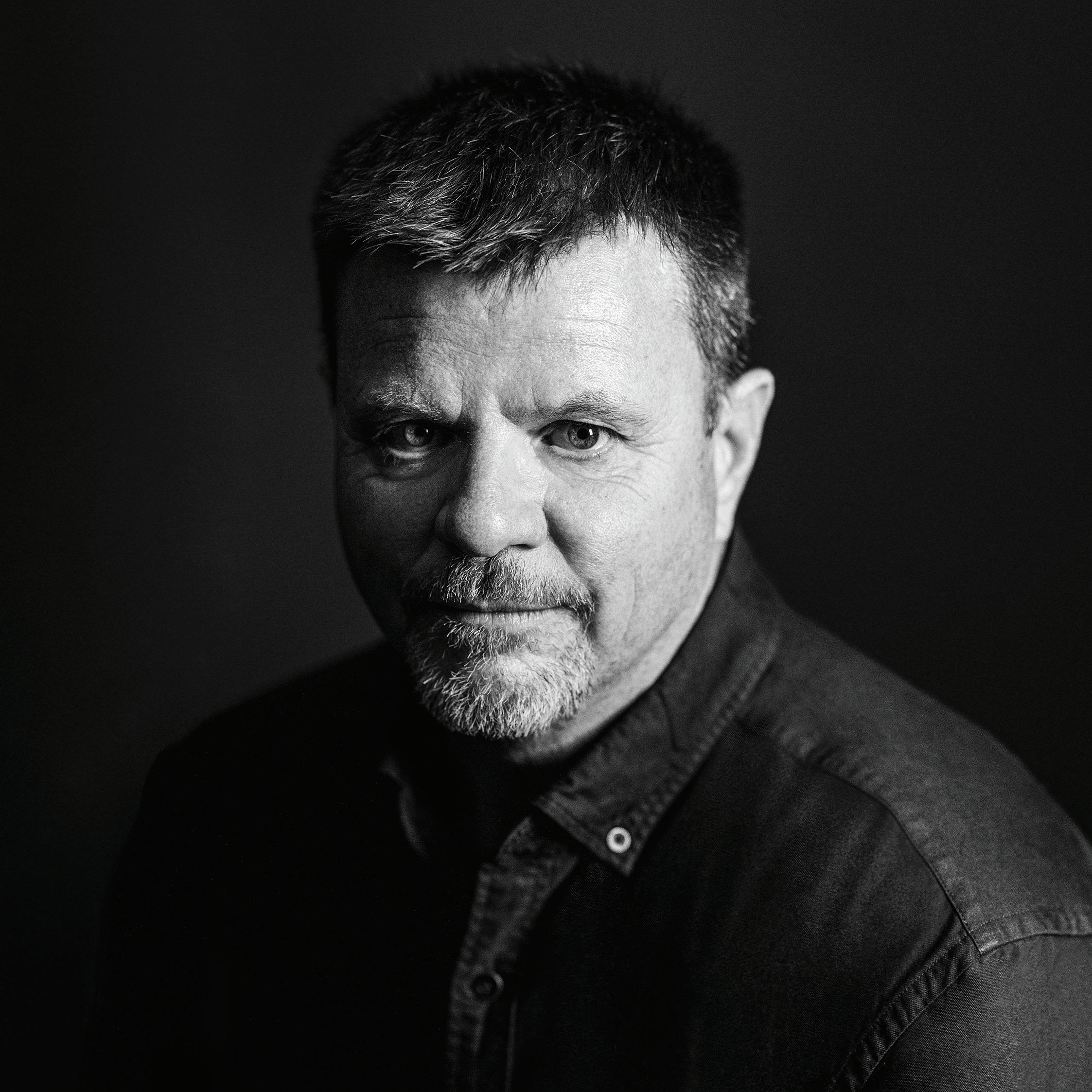

“PATIENCE AND TENACITY ALLOW LEADERS TO MAINTAIN A LONG VIEW AND BE RESILIENT IN THE FACE OF SETBACKS.”
Rowan Hill | General Manager Operations and Development
“AUTHENTICITY INSTILLS A SENSE OF TRUST. YOU CANNOT LEAD A TEAM IF PEOPLE DON’T BELIEVE YOUR MESSAGING.”
Darren Hardy | Chief Executive Energy
OUR CLIMATE-RELATED RISKS AND OPPORTUNITIES
As the climate changes and the world transitions to a low-carbon economy, MinRes continues to be exposed to technological, market, social and legislative policy changes. These changes present a range of risks and opportunities that will influence the way we operate. Our approach to the identification and assessment of key climate-related risks and opportunities will evolve year-on-year to support embedding climate-related issues into business-as-usual processes.
To respond to climate-related risks and opportunities, we embed climate risk analysis in our portfolio composition, emissions reductions, targets, technology and innovation developments. Guidance from our climate-related policy and stakeholder engagements progresses appropriate mitigation and management strategies. Company-level risks, such as the evolving climate change mitigation regulations, are monitored by our Sustainability Committee as well as a dedicated Decarbonisation Working Group.
Identifying and assessing climate-related risks and opportunities
Climate change presents both opportunities and risks for MinRes. Our innovative capabilities as a mining services provider positions us well to respond to climate change drivers by developing energy efficient materials handling solutions at our operations and displacing diesel fuel usage.
Using the TCFD recommendations, climate-related risks are characterised as either physical risks relating to the physical impacts of climate change, or transition risks related to the risks associated with transitioning to a lower-carbon economy. Climate-related opportunities are characterised in line with resource efficiency, energy source, product or service, market or resilience opportunities. MinRes identifies and assesses climate-related risks and opportunities through:
• assessment of physical climate information and projections for Australia for the areas where MinRes operations are located. This includes a series of climate indicators for 2030 and 2050 under Scenario 1, 2 and 3, including review of average temperature increases, maximum temperature increases, rainfall, days above 35°C and 99.9 percentile rainfall days. This information is used to identify the risks and opportunities that may affect MinRes’ business activities
• climate focused workshops and interviews engaging management, senior executives and subject matter experts across both corporate and operations to identify climate-related risks and opportunities
• embedding risk assessment processes to review and rank likelihood and consequence of the identified climate-related risks, using MinRes’ enterprise risk-rating matrix. Climate risks are reviewed on a quarterly basis to ensure the ranked likelihood and consequence of the identified risks and controls remains appropriate.
In identifying, assessing and responding to these risks and opportunities, we consider direct operations, and upstream and downstream impacts, over short, medium and long-term time horizons. During our identification process, we assess physical climate information and projections for Australia for the areas where our operations are located. The outcome of this process is a list of identified climate-related risks and opportunities, refer to our 2023 Sustainability Performance Data Tables for further information.
Through FY23, there has been no material shift in our risk profile with our top climate-related risk remaining the cost of capital. Other key risks relate to natural gas exploration and development, social licence and changing customer demand, government and regulatory expectation, emission intensive resources, carbon pricing and physical risks associated with extreme acute events. The top climate-related opportunity relates to energy sources and diesel displacement. This aligns with MinRes’ Roadmap to Net Zero Emissions, which seeks to progressively displace diesel with lower carbon energy solutions to reduce our emissions.
OUR PERFORMANCE – METRICS AND TARGETS
Setting targets helps drive business decisions which align to managing our climate-related risks and pursuing opportunities. We maintain our target of achieving net zero operational emissions by 2050. In FY22 we set a medium-term reduction target, to reduce our emissions by 50 per cent by 2035 from baseline FY22 emissions14. The baseline includes all existing operations under MinRes operational control as of 30 June 2022, including the Pilbara Hub (Wonmunna, Iron Valley), Yilgarn Hub (Koolyanobbing, Parker Range and Carina operations) and Mt Marion in alignment with our Roadmap to Net Zero Emissions. The baseline will be adjusted when structural changes occur in the Company that change the facility boundary or mining activity (such as acquisitions or divestments).
ENVIRONMENT - (CONTINUED)
172 I MINERAL RESOURCES LIMITED 2023 SUSTAINABILITY REPORT
14 On existing operations under MinRes operational control as of 30 June 2022, inclusive of scope 1 and scope 2 and equating to 321,744 tCO2-e.
We track our emissions monthly and annually disclose our energy consumption, scope 1 and scope 2 GHG emissions data to the Clean Energy Regulator, through the Australian Government’s National Greenhouse and Energy Reporting Act 2007 (NGER Act). We also disclose this information as part of our annual reporting suite.
ENERGY
Energy is a critical input into our business operations and makes a significant contribution to our operational emissions. Figure 34 provides energy consumption for entities under our operational control.
Our total net energy consumption increased by 10 per cent from FY22 as a result of increased activity and associated diesel use. As many of our operations are located in remote areas of Western Australia, we are reliant on diesel fuel as an energy source for our mining equipment, transportation and haulage, and for electricity generation at our non-grid connected iron ore operations. During FY23, diesel consumption amounted for over 90 per cent of our energy consumption with LNG being the second highest source of non-renewable fuel consumed. We continue to investigate ways to reduce our reliance on diesel fuel to support our emissions targets. In FY23, we commenced several emission reduction initiatives with a total spend of over $20 million. These projects spanned multiple categories including energy efficiencies, renewable energy and research and development. Refer to 2023 Sustainability Performance Data Tables for further information.
GREENHOUSE GAS EMISSIONS PROFILE
Our GHG emissions are directly related to our energy use and growth of our operations. MinRes calculates its scope 1 and scope 2 GHG emissions for entities under its operational control in alignment with the GHG Protocol and the Australian NGER Act 2007. We use emission factors disclosed in the National Greenhouse and Energy Reporting (Measurement) Determination 2008 made under subsection 10(3) of the NGER Act 2007. The emission factors applied are for metric tonnes of carbon dioxide equivalent, including the greenhouse gases CO2, CH4 and N2O.
The Global Warming Potential (GWP) measures the potential of a greenhouse gas to trap heat in the atmosphere, as referenced in the NGER Regulations 2008. These GWP values are calculated based on the 100-year GWP timeframe, as referenced in the IPCC 2007 Fourth Assessment Report. No biogenic CO2 emissions have been included in our scope 1 GHG emissions, while scope 2 GHG emissions are calculated using a location-based approach.
(CONTINUED)
ENVIRONMENT -
4,421,160 5,025,719 5,538,632 6,000,000 5,500,000 5,000,000 4,500,000 4,000,000 3,500,000 3,000,000 GJ FY21 FY22 FY23 Diesel fuel Other LNG Oils and greases Unprocessed natural gas
1 External limited assurance is provided over our FY23 energy consumption. Refer to page 181 for a copy of the Independent Limited Assurance Statement.
MINERAL RESOURCES LIMITED 2023 SUSTAINABILITY REPORT I 173
Figure 34: Energy consumption1
Table 20 shows our scope 1 and scope 2 GHG emissions in metric tonnes of CO2 equivalent (tCO2-e) from FY21 to FY23. In FY23, absolute emissions (scope 1 and 2) increased by 11 per cent due to a rise in diesel consumption, primarily driven by electricity generation and mobile equipment usage, which can be linked to an escalation in construction activities within the Company. Additionally, there was a 13 per cent increase in LNG consumption at Mt Marion, which can be attributed to construction activities and the expansion of mining operations. Refer to our 2023 Sustainability Performance Data Tables for our historical GHG emissions.
The emission intensity at our operational sites per total material mined (TMM) is shown in Table 21. There has been a 19 per cent increase in the calculated GHG emission intensity between FY22 and FY23. This is reflective of construction activities and ramp-up in mining activities at Mt Marion which is currently in a high strip ratio phase of the operation.
We continue to invest in activities that reduce the carbon intensity of our operations. To support the growth of our business, it is important we pursue reliable, stable, low cost and sustainable energy solutions. Our Roadmap to Net Zero Emissions outlines a pathway to progressively incorporating gas, LNG, renewable energy technologies and other emerging technologies over time to reduce our carbon intensity. See Figure 31, which illustrates our energy mix source transition over time for electricity generation, mining equipment, transportation and logistics.
LOOKING FORWARD
In FY24, we will actively pursue multiple initiatives to strengthen our response to climate change. Some of the key initiatives include:
• onboarding additional specialist resources to enhance internal capabilities to effectively execute emission reduction projects
• reviewing the Roadmap to Net Zero Emissions and climate scenario analysis to enhance our climate resilience
• continuing to integrate decarbonisation into our operations and practices
• continuing to engage with international mobile mining fleet Original Equipment Manufacturers on emissions reduction opportunities
• implementing the deployment of autonomous road haulage fleet, consisting of prime mover trailer combinations at the Onslow Iron project
• installing solar PV with battery storage at Ken’s Bore.
ENVIRONMENT - (CONTINUED)
FY21 FY22 FY23 Scope 1 emissions (tCO2-e)1 296,343 337,489 373,461 Scope 2 emissions (tCO2-e)1 1,993 3,026 3,490 Total 298,336 340,515 376,951
Table 20: Scope 1 and 2 GHG (tCO2-e)
1 External limited assurance is provided over our FY23 scope 1 and scope 2 GHG emissions. Refer to page 181 for a copy of the Independent Limited Assurance Statement.
FY21 FY22 FY23 Tonnes Material Mined (TMM) (wet metric kt) 131,565 136,877 124,487 GHG intensity: tCO2-e/ TMM (wet metric kt)1 2.3 2.5 3.0
1 The GHG emissions included in the intensity metrics are total scope 1 and 2 GHG emissions, which include the greenhouse gases CO2, CH4, N2O and SF6
Table 21: Carbon intensity of our operations (tCO2 -e/TMM)
174 I MINERAL RESOURCES LIMITED 2023 SUSTAINABILITY REPORT

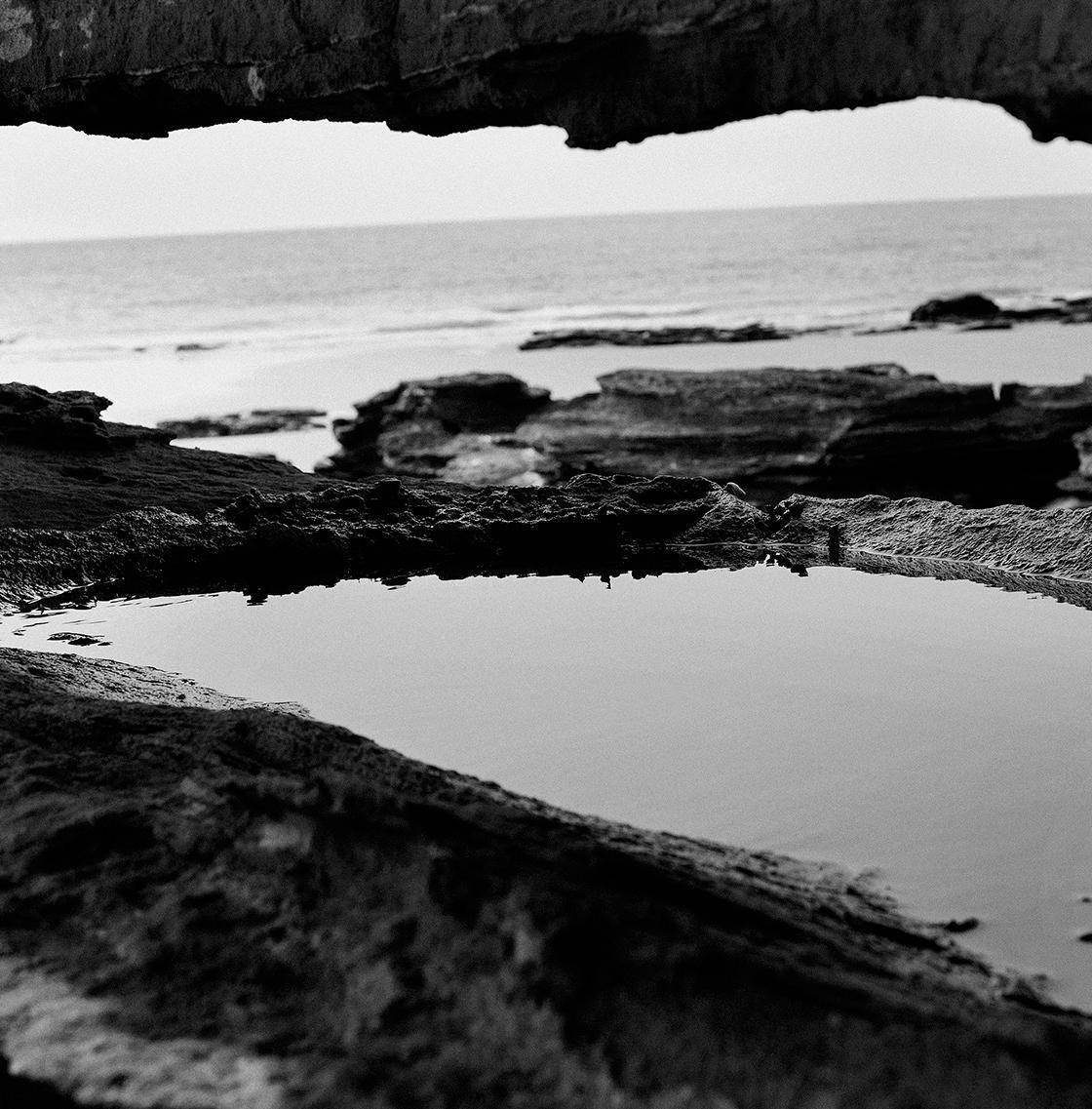
TABLES AND FIGURES INDEX
MINERAL RESOURCES LIMITED 2022 SUSTAINABILITY REPORT I 177 MINERAL RESOURCES LIMITED 2023 SUSTAINABILITY REPORT I 177
TABLES Table 1: Stakeholder engagement 26 Table 2: Performance against our FY23 sustainability targets 32 Table 3: Governance appointment matrix 42 Table 4: Value generated and distributed 52 Table 5: FY23 safety performance 76 Table 6: Overall female and Indigenous Australian representation 104 Table 7: Percentage employee diversity 104 Table 8: Air quality emissions 128 Table 9: Operational water status and sensitivity 133 Table 10: Risk identification and management approach for water-related activities 134 Table 11: Non-hazardous waste by type, weight and disposal method 138 Table 12: Hazardous waste by type, weight and disposal method 138 Table 13: Historical cumulative tailings for Mt Marion, Wodgina and Koolyanobbing operations 146 Table 14: Waste rock quantities 147 Table 15: Risk identification and management approach for biodiversity-related activities 151 Table 16: Site biodiversity status and species per IUCN Red List conservation status 153 Table 17: Number of IUCN Red List species and species with national conservation status, occurring in areas 154 affected by the operations of the organisation, by level of extinction risk Table 18: Technical study spend 156 Table 19: Climate scenarios 168 Table 20: Scope 1 and 2 GHG emissions 174 Table 21: Carbon intensity of our operations (tCO2-e/TMM) 174 TABLES AND FIGURES INDEX 178 I MINERAL RESOURCES LIMITED 2023 SUSTAINABILITY REPORT
Figure 1: FY23 materiality matrix 24 Figure 2: FY23 sustainability framework – material topic alignment to SDGs 25 Figure 3: Sustainability governance framework 38 Figure 4: FY23 Code of Conduct competency 45 Figure 5: Number of whistleblower cases per category received in FY23 and 46 a breakout of the number of psychosocial cases per category Figure 6: Enterprise risk management framework 49 Figure 7: The Four T’s model for determining a risk treatment strategy 49 Figure 8: Top 10 international suppliers as a percentage of our overall spend 62 Figure 9: Supply chain percentage spend and count breakdown 63 Figure 10: Five pillars of health and safety strategy 69 Figure 11: Four-phase emergency response model 72 Figure 12: Historical trends in LTIFR and TRIFR – combined employees and contractors 76 Figure 13: Nature of FY23 work-related injuries 77 Figure 14: Career entry pathways 87 Figure 15: Board composition and diversity 106 Figure 16: MinRes operations Native Title determinations, registered claims and alternative settlement areas location 112 Figure 17: MinRes social investment framework 119 Figure 18: Social investment contributions (AUD $ million) and percentage of profit before tax 119 Figure 19: FY23 local community support 120 Figure 20: MinRes water stewardship 129 Figure 21: MinRes operations by water risk and proximity to environmentally important water resources 131 Figure 22: FY23 water balance 136 Figure 23: FY23 water input and output by water quality (ML) 136 Figure 24: Circular economy principles 139 Figure 25: Valley-fill type TSF (TSF3E is an example of this type of facility) 142 Figure 26: In-pit type TSF (Ghost Crab TSF is an example of this type of facility) 143 Figure 27: Biodiversity management principles as underpinned by the mitigation hierarchy 148 Figure 28: Biodiversity and environmental objectives 150 Figure 29: FY23 land disturbed and rehabilitated for all MinRes operational sites 157 Figure 30: MinRes mine closure framework 158 Figure 31: Roadmap to Net Zero Emissions 162 Figure 32: Tactical, transitional and transformational 163 Figure 33: MinRes emissions reduction initiatives 165 Figure 34: Energy consumption 173
MINERAL RESOURCES LIMITED 2023 SUSTAINABILITY REPORT I 179
FIGURES
TABLES AND FIGURES INDEX - (CONTINUED)
180 I MINERAL RESOURCES LIMITED 2022 SUSTAINABILITY REPORT INDEPENDENT
180 I MINERAL RESOURCES LIMITED 2023 SUSTAINABILITY REPORT
LIMITED ASSURANCE STATEMENT
Our Conclusion:
Ernst & Young (‘EY’, ‘we’) were engaged by Mineral Resources Limited (‘MinRes’) to undertake a limited assurance engagement as defined by Australian Auditing Standards, hereafter referred to as a ‘review’, over the Subject Matter defined below for the year ended 30 June 2023. Based on the procedures we have performed and the evidence we have obtained, nothing has come to our attention that causes us to believe the Subject Matter has not been prepared, in all material respects, in accordance with the Criteria defined below
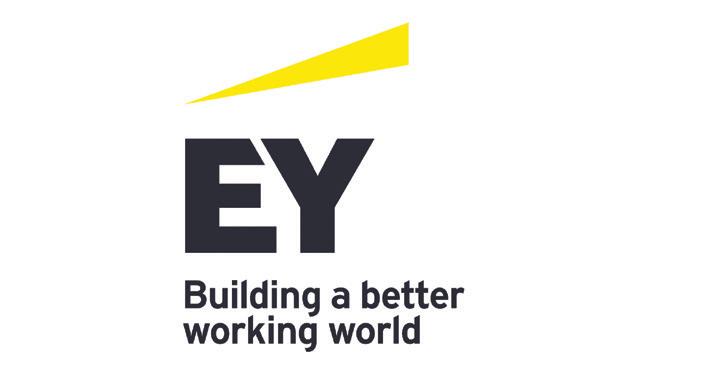
What our review covered
The Subject Matter for our limited assurance engagement included selected sustainability performance data, limited to those aspects listed below for the year ended 30 June 2023:
Community contributions (AUD)
LTIFR (Lost Time Injury Frequency Rate)
TRIFR (Total Recordable Injury Frequency Rate)
Business Code of Conduct and Integrity training (per cent employee completion rate)
Gender balance as per MinRes categories
Scope 1 greenhouse gas emissions (tonnes CO2-e)
Scope 2 greenhouse gas emissions (tonnes CO2-e)
Energy consumption (GJ)
Direct economic value generated and distributed (AUD)
Suppliers screened for modern slavery risk by third party platform (%).
Assured Metric Assured Value
Scope 1 greenhouse gas emissions (tonnes CO2-e) 373,461 tonnes CO2-e
Scope 2 greenhouse gas emissions (tonnes CO2-e) 3,490 tonnes CO2-e
Energy consumption (GJ) 5,538,632 GJ
Direct economic value generated and distributed (AUD)
Value generated $M 4,779.1
Value distributed $M 6,134.2
Suppliers screened for modern slavery risk by third party platform (%) 99.80%
The Subject Matter did not include Management’s forward-looking statements.
Criteria applied by MinRes
In preparing the Sustainability Report, MinRes applied the following criteria: MinRes’ self-determined criteria for the reporting of non-financial information
Most appropriate GRI indicator relevant to the Subject Matter National Greenhouse and Energy Reporting (NGER) Act 2007, NGER Regulations 2008, and NGER (Measurement) Determination 2018.
Key responsibilities
EY’s responsibility and independence
Our responsibility is to express a conclusion on the Subject Matter based on our review.
Gender balance as per MinRes categories
C-Suite Male: 7
1 Executives and Senior Management Male: 65 Female: 8
Management
Male: 365 Female: 61
Professionals Male: 585 Female: 251
Operations, Support and Services Male: 3,416 Female: 928
Total Male: 4,438 Female: 1,249
We have complied with the independence and relevant ethical requirements, which are founded on fundamental principles of integrity, objectivity, professional competence and due care, confidentiality and professional behavior.
The firm applies Auditing Standard ASQM 1 Quality Management for Firms that Perform Audits or Reviews of Financial Reports and Other Financial Information, or Other Assurance or Related Services Engagements, which requires the firm to design, implement and operate a system of quality management including policies or procedures regarding compliance with ethical requirements, professional standards and applicable legal and regulatory requirements.
MinRes’ responsibility
MinRes’ management is responsible for selecting the Criteria, and for presenting the Subject Matter in the Sustainability Report in accordance with that Criteria, in all material respects. This responsibility includes establishing and maintaining internal controls, maintaining adequate records and making estimates that are relevant to the preparation of the Subject Matter, such that it is free from material misstatement, whether due to fraud or error.
INDEPENDENT LIMITED ASSURANCE STATEMENT MINERAL RESOURCES LIMITED 2023 SUSTAINABILITY REPORT I 181
Community contributions (AUD)
LTIFR (Lost Time Injury Frequency Rate) 0.07 TRIFR (Total Recordable Injury Frequency Rate) 2.08 Business Code of Conduct and Integrity training (per cent employee completion rate) 91%
Assured Metric Assured Value
$7.5 million
Female:
Independent Limited Assurance Statement to the Management and Directors of Mineral Resources Limited
Independent Limited Assurance Statement to the Management and Directors of Mineral Resources Limited
Our approach to conducting the review
We conducted this review in accordance with the Australian Auditing and Assurance Standards Board’s Australian Standard on Assurance Engagements Other Than Audits or Reviews of Historical Financial Information (‘ASAE 3000’) and the Australian Standard on Assurance Engagements on Greenhouse Gas Statements (‘ASAE 3410’) and the terms of reference for this engagement as agreed with MinRes on the 23 May 2023 and amended on 11 September 2023. That standard requires that we plan and perform our engagement to express a conclusion on whether anything has come to our attention that causes us to believe that the Subject Matter is not prepared, in all material respects, in accordance with the Criteria, and to issue a report.
Summary of review procedures performed
A review consists of making enquiries, primarily of persons responsible for preparing the Subject Matter in the Sustainability Report and related information and applying analytical and other review procedures.
The nature, timing, and extent of the procedures selected depend on our judgement, including an assessment of the risk of material misstatement, whether due to fraud or error. The procedures we performed included, but were not limited to:
Conducted interviews with key personnel to understand the process for collecting, collating and reporting the selected Sustainability Performance Data during the reporting period
Performing analytical tests and detailed substantive testing to source documentation for material qualitative and quantitative information
Assessing the accuracy of calculations performed
Obtaining evidence to support key assumptions in calculations and other data
Identifying and testing assumptions supporting calculations
Assessing that data had been accurately transcribed from corporate systems and/or supporting evidence.
We believe that the evidence obtained is sufficient and appropriate to provide a basis for our review conclusion.
Inherent limitations
Procedures performed in a review engagement vary in nature and timing and are less in extent than for a reasonable assurance engagement. Consequently, the level of assurance obtained in a review engagement is substantially lower than the assurance that would have been obtained had a reasonable assurance engagement been performed. Our procedures were designed to obtain a limited level of assurance on which to base our conclusion and do not provide all the evidence that would be required to provide a reasonable level of assurance.
While we considered the effectiveness of management’s internal controls when determining the nature and extent of our procedures, our assurance engagement was not designed to provide assurance on internal controls. Our procedures did not include testing controls or performing procedures relating to assessing aggregation or calculation of data within IT systems. The GHG quantification process is subject to scientific uncertainty, which arises because of incomplete scientific knowledge about the measurement of GHGs. Additionally, GHG procedures are subject to estimation and measurement uncertainty resulting from the measurement and calculation processes used to quantify emissions within the bounds of existing scientific knowledge.
Other matters
We have not performed assurance procedures in respect of any information relating to prior reporting periods, including those presented in the Subject Matter. Our report does not extend to any disclosures or assertions made by MinRes relating to future performance plans and/or strategies disclosed in MinRes’ Sustainability Report.
Use of our Assurance Report
We disclaim any assumption of responsibility for any reliance on this assurance report to any persons other than management and the Directors of MinRes, or for any purpose other than that for which it was prepared.
Adam Carrel Ernst & Young Partner Perth, Australia 16 October 2023

INDEPENDENT LIMITED ASSURANCE STATEMENT - (CONTINUED) 182 I MINERAL RESOURCES LIMITED 2023 SUSTAINABILITY REPORT

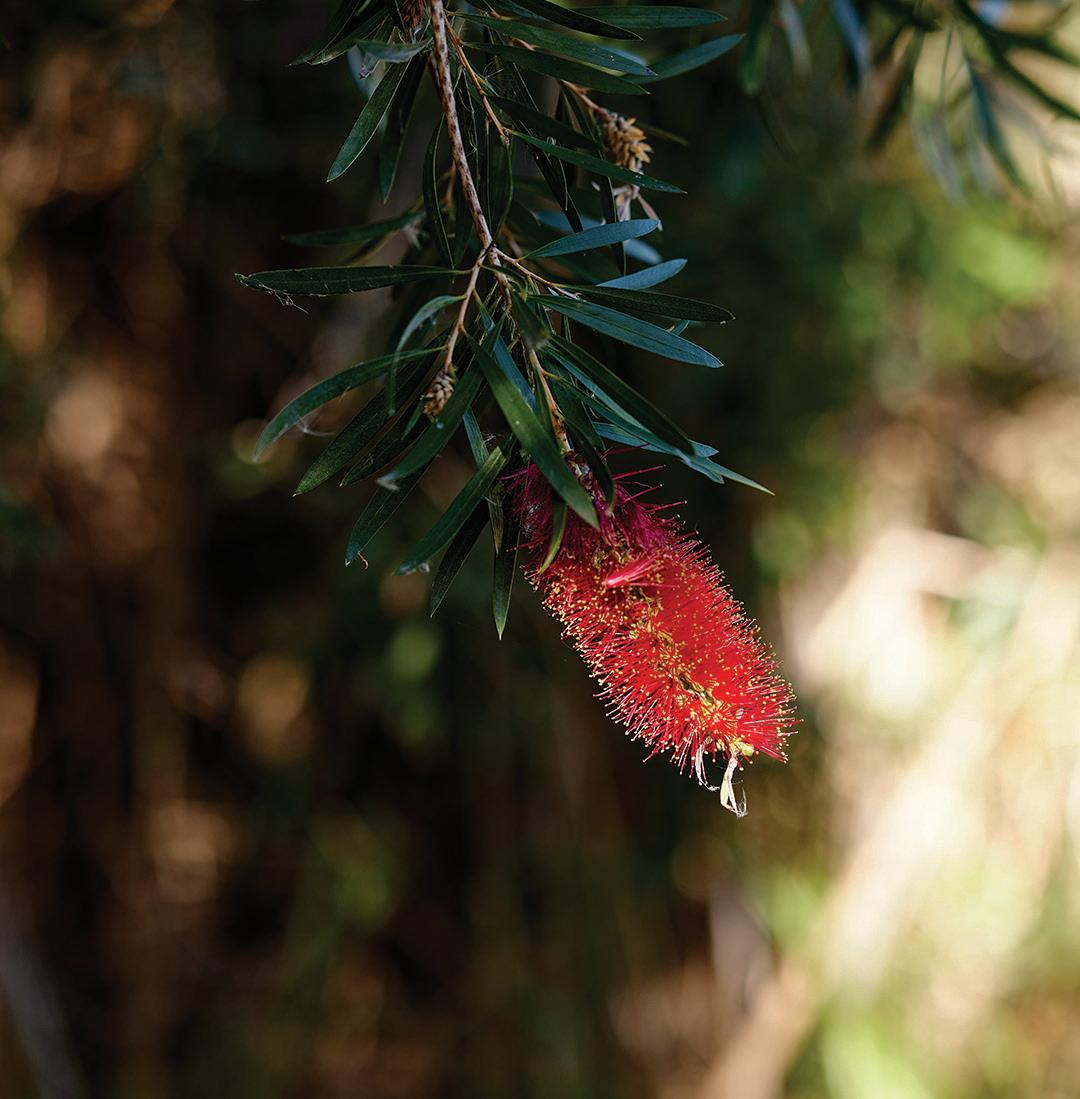
GLOSSARY AND LIST OF ABBREVIATIONS
MINERAL RESOURCES LIMITED 2022 SUSTAINABILITY REPORT I 185
MINERAL RESOURCES LIMITED 2023 SUSTAINABILITY REPORT I 185
Term
All incidents
Annual Lead Indicator Frequency Rate
Annual High Potential Event Frequency Rate (HiPoFR)
Biodiversity
Description
Refers to the combination of first aid, lost time injuries and medical treatment cases.
MinRes’ health and safety lead indicator measurement, which is calculated based on the number of audits, hazards, inspections, meetings and observations. The frequency rate is determined by the number per one million hours worked.
High Potential Events are defined to be any incident or near miss that could, in other circumstances, have realistically resulted in one or more fatalities.
As defined by the United Nations: ‘The variability among living organisms from all sources including, inter alia, terrestrial, marine and other aquatic ecosystems and the ecological complexes of which they are part; this includes diversity within species, between species and of ecosystems’1
Bloomberg Gender Equality Framework
The framework defines a set of metrics used to determine a company’s progress towards equal representation of gender throughout the levels of the organisation, commitment to gender equality goals, policies in place to reduce the impact of familial stresses and responsibilities on the workplace, and progress towards positive impact on women outside of the employee base.
Board
CO2-e
Category 1 water quality
The Board of Directors of Mineral Resources Limited.
Carbon dioxide equivalent. The number of metric tons of carbon dioxide emissions with the same global warming potential (GWP) as one metric ton of another greenhouse gas.
Category 1 refers to high-quality water as defined by the Mineral Council of Australia’s (MCAs) Water Accounting Framework (WAF)2, which would require minimal and inexpensive treatment to meet appropriate drinking water standards.
Category 2 water quality
Category 2 refers to medium-quality water as defined by the MCAs WAF, which would require moderate levels of treatment to meet appropriate drinking water standards.
Category 3 water quality
Category 3 refers to low-quality water with individual constituents encompassing high values of total dissolved solids, elevated dissolved metals or extremely high levels of pH as defined by the MCAs WAF. This would require significant treatment to meet appropriate drinking water standards.
Circular economy
The circular economy is an approach in which existing materials and products are used, repaired, reused or recycled to extend their life cycle. The approach minimises waste and the need/use for raw materials.
1. ICBD (2018). Mainstreaming of biodiversity into the energy and mining Sector. Secretariat of the Convention on Biological Diversity, Montreal. https://www.cbd.int/doc/c/278a/ e222/7deeb28863d046c875885315/ sbi-02-04-add3-en.pdf.
2. MCA. Minerals Industry - Water Accounting Framework. User Guide, version 2.0. https://www.minerals.org.au/minerals-industry-water-accounting-framework.
GLOSSARY & LIST OF ABBREVIATIONS 186 I MINERAL RESOURCES LIMITED 2023 SUSTAINABILITY REPORT
Term
Conflict minerals
Contractor
Cultural heritage
Dewatering
Employee
Enterprise Risk Management
Environmental, Social, and Governance (ESG)
EPBC Act
FTSE Russell
Global Reporting Initiative Standards (GRI)
Description
According to OECD guidance3, conflict minerals refer to minerals mined in an area of armed conflict and traded to perpetuate the conflict. Conflict minerals currently include tungsten, tin, tantalum and gold.
An individual or business which has been engaged to undertake work for or on behalf of MinRes.
The dynamic tangible and intangible heritage assets of a group or society that are inherited from past generations. This refers to both Indigenous and post-contact (European) heritage in an Australian context.
The process of rainwater or groundwater removal from an excavated area.
An individual in full-time, part-time or casual employment who has been engaged by MinRes on a temporary or permanent basis pursuant to a contract.
A strategy to identify and prepare for hazards with a company’s finances, operations, and objectives.
ESG relates to the three central factors in measuring the sustainability and societal impact of a company.
Environment Protection and Biodiversity Conservation Act 1999 (Cth).
Provides ESG scores and data models which allow investors to understand a company’s exposure to, and management of, ESG issues in multiple dimensions.
GRI is an independent international organisation that has pioneered sustainability reporting, with the GRI Sustainability Reporting Standards as the first and most widely accepted framework for reporting on sustainability risks, performance, impacts and targets.
Greenhouse gas (GHG)
There are seven greenhouse gases listed in the Kyoto Protocol, which include carbon dioxide (CO2 ), methane (CH4 ), nitrous oxide (N2O), hydrofluorocarbons (HFCs) and sulphur hexafluoride (SF6 ). GHG emissions are calculated as carbon dioxide equivalents (CO2-e).
High-consequence Work-related Injuries Rate
High Potential Event Frequency Rate (HiPoFR)
Rate determined by the number of high-consequence work-related injuries (excluding fatalities) occurring per one million hours worked (# of high-consequence injuries / hours worked x 200,000 or 1,000,000).
Any work-related incidents with an actual or potential level four or five outcome in accordance with our internal Incident Management Procedure, such as vehicle collisions, explosions or malfunctioning equipment. The frequency rate can be determined by the number of potential events occurring per one million hours worked.
GLOSSARY
MINERAL RESOURCES LIMITED 2023 SUSTAINABILITY REPORT I 187
3. OECD (2016). OECD Due Diligence Guidance for Responsible Supply Chains of Minerals from Conflict-Affected and High-Risk Areas: Third Edition, OECD Publishing, Paris. https://www.oecd.org/ corporate/mne/mining.htm.
& LIST OF ABBREVIATIONS - (CONTINUED)
Human rights
Description
As defined by the United Nations: ‘human rights are inherent to all human beings, regard-less of race, sex, nationality, ethnicity, language, religion, or any other status and include the right to life and liberty, freedom from slavery and torture, freedom of opinion and expression, the right to work and education’4
In-kind contributions
Donation of product, property and services, which includes employee time volunteering, secondments, use of company equipment and facilities as well as the donation of products.
Incident
An incident can be classified as either reportable or recordable. A reportable incident is any incident or unwanted event which is reportable to MinRes through our internal management system. A notifiable incident is any incident or unwanted event which is reportable to a regulatory department and includes any event(s) as a result of exposure to psychosocial hazards.
Indigenous Australians
Indigenous Australians are people with familial heritage from, and membership in, the ethnic groups that lived in areas within the Australian continent before British colonisation. They consist of two distinct groups, the Aboriginal peoples of the Australian mainland and Tasmania, and the Torres Strait Islander peoples from seas between Queensland and Papua New Guinea.
Injury
Intangible heritage assets
Intergovernmental Panel on Climate Change (IPCC)
International Sustainability Standards Board (ISSB)
International Union for Conservation of Nature (IUCN)
Physical harm or damage on a part (or parts) of the body. Injuries are generally caused by an external force impacting or contacting the body and can include, but are not limited to, cuts, fractures, soft tissue sprains and strains or significant acute injuries.
Include traditions or living expressions such as language, knowledge, skills, performing arts (e.g., songs, stories, dances and craft), rituals, customs and beliefs.
The IPCC is an intergovernmental body of the United Nations responsible for assessing and advancing knowledge and science related to climate change.
The ISSB is responsible for developing International Financial Reporting Standards (IFRS) Sustainability Disclosure Standards in an aim to provide a global baseline of sustainability disclosures.
The IUCN is an international organisation working in the field of sustainable natural resource use and nature conservation.
Institutional Shareholder Services (ISS)
Provides ESG ratings and analysis for companies worldwide. These ratings assess a company’s performance and practices across various ESG factors, helping investors and stakeholders evaluate a company’s sustainability and responsible business practices.
Term
GLOSSARY & LIST OF ABBREVIATIONS - (CONTINUED)
188 I MINERAL RESOURCES LIMITED 2023 SUSTAINABILITY REPORT
4. United Nations (UN). Human Rights. https://www.un.org/en/global-issues/human-rights.
Term
Key Management Personnel (KMP)
Lost Time Injury Frequency Rate (LTIFR)
Description
KMP includes the MinRes management team with responsibility, authority, and accountability for planning, directing and controlling the activities of the Company.
A work-related injury or illness resulting in the worker being absent from work for their next scheduled / rostered shift. The frequency rate is determined by the number of lost time injuries occurring in a workplace per one million hours worked.
Materiality
The concept of defining why and how certain environmental, social and governance issues are significant for a company and/or relevant stakeholders to the company. The determination of material issues sets the reporting threshold for companies.
Mineral Resources Limited (MinRes)
Mineral waste
Mineral Resources Limited (ABN 33 118 549 910) and the entities it controlled, unless otherwise stated.
Mineral waste or mining-related waste refers to waste streams generated during the extraction and beneficiation of minerals and ores. This includes waste rock and tailings for MinRes’ operations.
Modern slavery
Modern slavery refers to situations where one person has taken away another person’s freedom so that they can be exploited; and may include human trafficking, slavery, servitude, forced labour, debt bondage, worst forms5 of child labour, deceptive recruiting for labour or services, and forced marriage.
Morgan Stanley Capital International (MSCI)
MSCI is widely known for its indices, which are used as benchmarks by investors and financial professionals to measure the performance of various investment portfolios, funds, and market segments.
National Greenhouse and Energy Reporting Scheme (NGER)
The Australian NGER Scheme, established by the NGER Act 2007, is a single national framework for reporting and disseminating company information regarding greenhouse gas emissions, energy production and consumption.
Native Title
Recognition of the rights and interests of Aboriginal and Torres Strait Islander people in relation to land or waters where rights and interests are possessed under the traditional lores and customs of Aboriginal and Torres Strait Islander people; where Aboriginal and Torres Strait Islander people through their lores and customs have a connection with the land or waters; and the rights and interest are recognised by the common law of Australia.
Near miss frequency rate
An incident that does not produce an injury or illness but has the potential to do so. The frequency rate can be determined by the number of near miss incidents per one million hours worked.
5. Worst forms of child labour defined in International Labour Organisation Convention No. 182 and Recommendation 190.
GLOSSARY & LIST OF ABBREVIATIONS - (CONTINUED) MINERAL RESOURCES LIMITED 2023 SUSTAINABILITY REPORT I 189
Net zero
Description
Net zero emissions refers to achieving an overall balance between greenhouse gas emissions produced and greenhouse gas emissions taken out of the atmosphere. Net zero is driven by the Intergovernmental Panel on Climate Change’s Special Report Global Warming of 1.5°C, released in 2018.
Non-mineral waste
Waste streams generated from the consumption of goods during regular daily activities, including general waste, comingled recycling, construction and demolition, tyres and rubber, and hazardous waste types such as septic waste.
Paris Agreement
Paris-aligned
Priority Ecological Community (PEC)
A legally binding international treaty between countries party to the United Nations Framework Convention on Climate Change (UNFCC) adopted in 2015, which aims to unify and strengthen efforts to reduce emissions and combat climate change.
Aligned to the Paris Agreement goals.
Ecological communities with insufficient information available to be considered a threatened ecological community (TEC) by the Department of Biodiversity, Conservation and Attractions (DBCA), are placed on the Priority list by DBCA and referred to as PECs.
Physical risk
Physical risks can be acute such as extreme weather events including heatwaves, cyclones and flooding, or chronic such as increase in average temperatures, precipitation patterns and sea level rise. Physical risks have direct impacts on health, infrastructure and productivity.
Psychosocial hazards
Psychosocial hazards at work are aspects at work and work situations which can result in harm to psychological and physical health. Examples may include high job demands, poor supervisor support and social factors such as workplace relationships.
Reconciliation
Strengthening relationships between Aboriginal and Torres Strait Islander peoples and non-Indigenous peoples for the benefit of all Australians.
Representative Concentration Pathways (RCP)
RCPs are emissions scenarios that include time series of emissions and concentrations of the full suite of GHGs, aerosols and chemically active gases, as well as land use/land cover. RCPs are used to develop climate projections by informing physical climate system models. In turn, these models project how the physical climate may change under different levels of radiative forcing driven by GHG concentrations.
Sanctions
Sustainability Accounting Standards Board (SASB)
An action to impose restrictions on activities that are related to a particular country, good, service, type of conduct, person or entity.
A non-profit organisation that develops standards to improve accounting on financial sustainability impacts. The SASB developed a set of 77 industry-specific sustainability accounting standards (SASB standards or industry standards).
Term
GLOSSARY & LIST OF ABBREVIATIONS - (CONTINUED) 190 I MINERAL RESOURCES LIMITED 2023 SUSTAINABILITY REPORT
Term
Scope 1 greenhouse gas emissions
Description
Scope 1 emissions are direct GHG emissions from operations, facilities and associated activities that are owned or controlled by the reporting company. For MinRes, Scope 1 emissions are primarily associated with fuel consumption.
Scope 2 greenhouse gas emissions
Scope 3 greenhouse gas emissions
Short-term incentive (STI)
Significant environmental incident
Shared Socio-Economic Path-ways (SSP)
Scope 2 emissions are indirect GHG emissions associated with the generation of purchased or acquired electricity, steam, heat or cooling consumed by operations and facilities owned or controlled by the reporting company. MinRes calculates Scope 2 emissions based on a location-based method.
Scope 3 emissions are non-operational GHG emissions associated with upstream and downstream activities that occur within the reporting company’s value chain.
STI formula driven awards provided to Executive KMP based on performance measures over 12 months and settled partially in cash and in MinRes shares over the following two financial years.
Significant environmental incidents comprise incidents of actual environmental or legal consequence of Level 3 and above as defined by MinRes’ Incident Management Procedure
SSP examine how global society, demographics and economics may change over the next century with varying socio-economic challenges to adaption and mitigation in the context of climate change scenario analysis.
Stakeholders
Individuals, groups or organisations who have a material influence on, or are materially influenced by, MinRes’ operations and activities. Examples of stakeholders include employees and contractors, local communities, customers, suppliers and investors.
Supplier
Sustainalytics
Tailings
Task Force on Climate-related Financial Disclosures (TCFD)
Taskforce on Nature-related Financial Disclosures (TNFD)
Technology Readiness Level (TRL)
An individual or business which has been engaged to provide services or goods for or on behalf of MinRes.
A company that provides ESG research, ratings, and analytics to help investors and businesses make more informed and sustainable decisions.
Fine-grained waste rock material discharged as a by-product of ore processing.
Established by the Financial Stability Board, the industry-led TCFD, developed a set of recommendations, the TCFD Recommendations, to guide improved disclosure of climate-related information.
A framework for organisations to report and act on the evolving nature-related risks, with the aim of supporting a shift in global financial flows away from naturenegative outcomes and toward nature-positive outcomes.
Technology readiness levels are a method for estimating the maturity of technologies during the acquisition phase of a program.
GLOSSARY & LIST OF ABBREVIATIONS - (CONTINUED) MINERAL RESOURCES LIMITED 2023 SUSTAINABILITY REPORT I 191
Term
Third-party water
Description
Water supplied by an external entity to an operational facility as defined by MCAs WAF. Third-party water contains water from three sources including surface water, groundwater and sea water.
Total Recordable Injury Frequency Rate (TRIFR)
The sum of (fatalities + lost-time cases + restricted work cases + medical treatment cases) x 1,000,000 hours worked) divided by actual hours. This is stated in units per million hours worked. MinRes uniformly applies these calculations across the business in accordance with the Occupational Safety and Health Administration (OSHA) guidelines.
Traditional Owner
An Indigenous Australian who is a member of a local descent group having certain rights and responsibilities in relation to a tract of land or area of sea.
Transition risk
Transitional risks are climate risks which have resulted from mitigation challenges as societies continue their decarbonisation efforts and align with the Paris Agreement. These risks include policy and regulation, technological development and market/ consumer preferences.
United Nations Global Compact (UNGC)
United Nations Sustainable Development Goals (SDG)
Water Accounting Framework (WAF)
A voluntary, non-binding initiative based on CEO commitments to implement universal sustainability principles regarding human rights, labour, environment and anti-corruption. MinRes is a signatory to the UN Global Compact, with our annual Sustainability Report serving as our Communication on Progress.
The SDGs are designed to end poverty, hunger, AIDS, and discrimination against women and girls.
Common approach in the mining and metals industry to consolidate operational water balance information.
WELL Building Standards
An international performance-based certification that focuses on the health and wellness of building occupants. The standards incorporate performance metrics, design strategies and policies to elevate human health in the built environment.
GLOSSARY & LIST OF ABBREVIATIONS - (CONTINUED) 192 I MINERAL RESOURCES LIMITED 2023 SUSTAINABILITY REPORT

HONESTY SETS THE FOUNDATION FOR TRUST, RESPECT AND STRONG RELATIONSHIPS WITH STAKEHOLDERS.”
Jenna Mazza | General Manager Corporate Legal
“

Brian Champion | Kalamaia Kaprun Elder | Eastern Goldfields and Yilgarn region, WA
The term Elder is meaningless unless it is paired with action and resonates into the future, believes this 85-year-old Gulamai-Guberin man. From Brian’s perspective, an Elder acts as a guide – steering others in the right direction and helping them along the way. With 31 great-grandchildren to nurture, he continues to honour his culture’s rich oral tradition of storytelling, transmitting stories from one generation to the next. His ancestor stories of the natural world offer a practical template to navigate survival on Country and a blueprint for how to live life.
Brian Tucker | Banjima/Nyiyaparli Elder | Pilbara region, WA

Brian admits it is not easy becoming an Elder. Learning and earning respect takes time and becoming heir to the accumulated ancestral knowledge cannot be hurried. This Banjima/Nyiyaparli Elder has spent four decades learning and describes it as a slow climb up a steep ladder. He is also insistent that knowledge is not for us to keep but must be shared and passed on. Preserving language, stories and song for future generations is his life’s mission. His visionary leadership has been integral in creating opportunities for his people to return to and remain on Country.
Len Collard | Whadjuk Noongar Elder | Perth region, WA

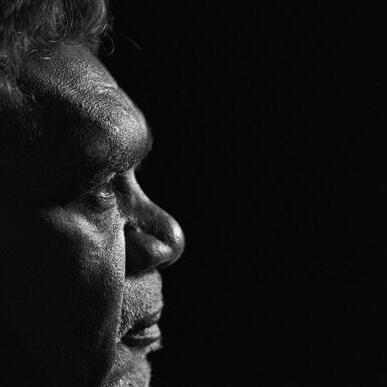
This Whadjuk Noongar man comes from an unbroken link of Elders who educated him in leadership from an early age. As a child he would listen to these knowledge keepers share all they knew and forewarn him that he would become the critical knowledge bridge between them and future leaders. For Len, being an Elder comes down to simple principles and practices that embrace safety, care and consideration, and build capacity to get people back on the right track if they drift. He believes these fundamentals apply equally across family unit and global corporations.
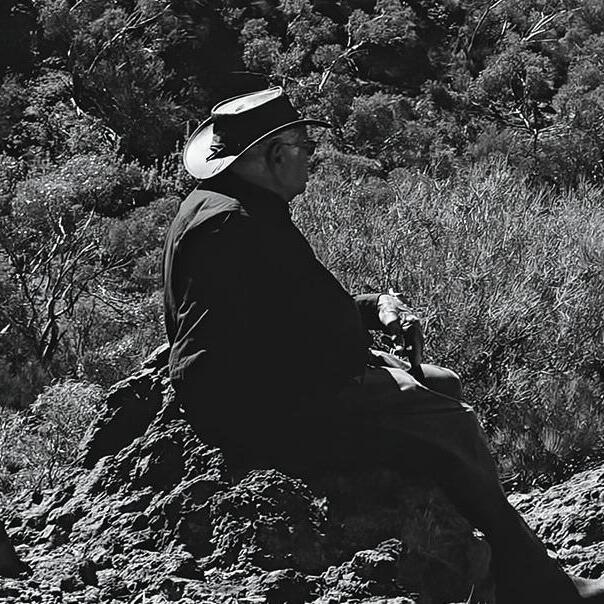
Emeritus Professor Colleen Hayward AM | Senior Noongar woman | Perth region, WA
Early in her career this proud Noongar woman followed her parents into the teaching profession. Over the next 35 years her career evolved to embrace increasingly challenging roles developing and implementing policies and programs across a diverse range of issues focused on the needs of minority groups at community, state and national levels. Her groundbreaking initiatives spanned the areas of health, education, training, employment, housing, child protection, law and justice. In 2023 Colleen joined the MinRes Board as an Independent Non-Executive Director.

Joshua Thurlow | Chief Executive Lithium
Joshua started his career as a mining engineer, joining MinRes in 2019 following two decades in operations, project development, mergers and acquisitions in Australia and internationally. Today he is responsible for the continued growth of MinRes’ world-class lithium assets and partnerships.

Trevor Parker | Banjima Elder | Peedamulla Station, Pilbara region, WA
Being a custodian for future generations means shifting your mindset to a very different way of thinking. Encouraging others to approach decision making with a much longer-term view is a key aim for this Banjima Elder. This recalibration will take not just decades or centuries, but millenia.
LEADERSHIP 196 I MINERAL RESOURCES LIMITED 2023 SUSTAINABILITY REPORT
Mike Grey | Chief Executive Mining Services
Mike is Chief Executive Mining Services and has worked across multiple commodities during his 35-year career in mining. In 2009 he joined MinRes, spearheading the growth of CSI Mining Services into one of Australia’s most recognised crushing and processing businesses.
Mark Wilson | Chief Financial Officer and Company Secretary


Mark is Chief Financial Officer and Company Secretary and joined MinRes in 2018. He is a business, finance and organisational strategist with more than 30 years of experience in senior executive positions across Australian and international high-growth, industry-leading organisations.
Yenna Ong | Director International Trade and Strategy

Yenna brings over three decades of experience working in financial and commercial roles within multinational companies and the mining industry. She joined MinRes in early 2006 and her deep understanding of the organisation has been integral to its success, particularly through its listing on the ASX and international growth.

Tuesday Lockyer | Robe River Kuruma Elder | Pilbara region, WA

Tuesday believes there are two types of Elders – those within a family, defined by age and family position, and those defined by law and culture. Tuesday is both; she considers herself a bush baby and spent a lot of time out bush with older people, learning about responsibilities handed down through generations. Tuesday says being an Elder comes with an obligation to look after Country and drive discussion – often on difficult topics which, when mixed with humour, can get the message across in a different way.
Chris Soccio | Chief Executive Iron Ore
Chris joined MinRes as Chief Executive Iron Ore in July 2022 and oversees our iron ore assets, mobile mining fleet and corporate safety. He brings more than 20 years of international experience managing mining operations and supply chains and will guide MinRes’ transition to long-life, low-cost iron ore operations.

Rebecca Alexander | Health and Wellbeing Advisor
Rebecca has been a Health and Wellbeing Advisor with MinRes since 2020. She holds more than 13 years’ experience in the FIFO industry and is well-placed to support MinRes’ focus on workplace wellness.
LEADERSHIP MINERAL RESOURCES LIMITED 2023 SUSTAINABILITY REPORT I 197
Claire Haynes | Principal Organisational

Development
Claire is the Principal Organisational Development and joined MinRes in 2022. She spent the prior decade developing programs and qualifications specialising in translating learning and leadership theory into practice.
Chris Harris | Head of
Mental Health
Chris is a psychologist and has been Head of Mental Health at MinRes since 2020. He is focused on the mental wellbeing of our people, leaning on a 30-year career in psychological and mental health services, and directorial roles across government, profit for purpose organisations and the corporate sector.


Georgina Bobby
| Robe River Kuruma Elder | Pilbara region, WA
Georgina is a proud Kuruma woman and Elder. As a child, she lived on Country on the Robe River, hunting, fishing, camping and learning culture and language from her own Elders. Georgina was educated at the Carnarvon Mission and soon after returning to Country began her involvement in leading cultural heritage surveys, a career she continues today. Georgina is committed to the preservation of language, believing it critical for the continuation of culture.
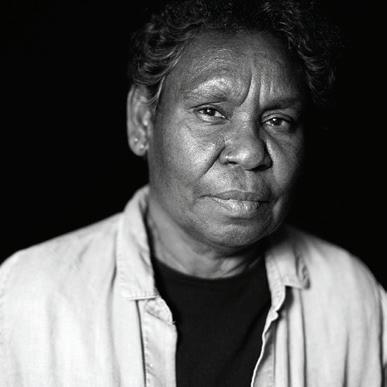
Andrea Chapman
| Executive General Manager People
As Executive General Manager People, Andrea brings more than a decade of leadership experience in human resources, employee relations and people services across the mining and resources industry. She oversees MinRes’ efforts to attract a talented and diverse workforce and deliver exceptional employee experiences.

Heath Nelson | General Manager Communities and Heritage
Heath became General Manager Communities and Heritage at MinRes in 2022. This followed more than 20 years in Indigenous economic development, including playing a pivotal role in establishing and implementing Indigenous procurement policies at federal, state and industry levels.
Stephen Stewart | Ngarla Elder | Pilbara region, WA
This Ngarla Elder has kept his culture alive for more than a century. Believed to be the oldest Aboriginal man in Australia, Stephen is regarded as a head lore man and the last remaining cultural singer of the Pilbara region. Although he concedes it is a significant and demanding undertaking, his strong sense of duty has never let anything get in the way of preserving Aboriginal lore. Working tirelessly to help others reunite with their culture, he believes it to be a source of strength.

198 I MINERAL RESOURCES LIMITED 2023 SUSTAINABILITY REPORT
LEADERSHIP
Tania Champion | Principal Tenements | Kalamaia Kaprun Elder / Applicant
Tania is a proud Kaprun, Ngadju, Mirning and Ballardong woman who stepped into her role as Principal Tenements with MinRes in early 2022. She brings more than 26 years of diverse experience across the mining industry, including open pit, underground, exploration and corporate.
Tegan Read | Principal Community Engagement
Tegan joined MinRes in 2022 as Principal Community Engagement. Her 12-year career in community engagement, reputation management and strategic communications includes Perth-based and regional roles.

Irene Roberts | Kariyarra Elder | Pilbara region, WA

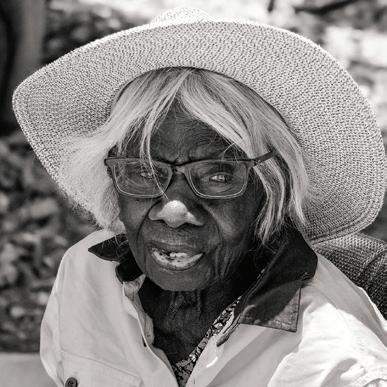

As a child, Irene travelled around Kariyarra Country on horseback with her parents and younger siblings, learning about Kariyarra lore, culture, language, country and customs from her father and Elders. This Kariyarra Elder of the Puyubungu Clan is fluent in six languages. She generously shares her wisdom and knowledge with her own community and more broadly with university researchers keen to capture and document it for future generations.
Ivor Jezdik | Executive General Manager Project Development

Ivor is a mining engineer who joined MinRes in 2022 and is now Executive General Manager Project Development. His career includes extensive leadership roles in technical and operational environments across multiple commodities and value chains.
Anne Hayes | Thalanyji Elder | Pilbara region, WA
Anne is a proud Thalanyji woman and Elder who has lived most of her life in Onslow. Sent to Carnarvon Mission to attend primary school, she was not permitted to speak her language. After her first job as a housemaid at Yanrey Station, she moved into a community health worker role. Anne ultimately became Pilbara project officer for the Heart Foundation. Concerned about the dwindling number of fluent Thalanyji language speakers and intent on the preservation of her language, Anne initiated classes and began teaching language to her community.
Rowan Hill | General Manager Operations and Development
Rowan joined MinRes in 2016 and today is General Manager Operations and Development for our Energy business. His career as a chemical engineer includes extensive experience on major oil and gas projects within Australia and internationally.

MINERAL RESOURCES LIMITED 2023 SUSTAINABILITY REPORT I 199
LEADERSHIP
Darren Hardy | Chief Executive Energy
Darren’s career with MinRes began in 1998 for an initial nine-year term. He returned in 2018 with extensive large-scale construction and project management experience and was appointed Project Director for the Wonmunna mine. As Chief Executive Energy, Darren now leads our strategy to secure reliable, low-cost and cleaner power.

Jenna Mazza | General Manager Corporate Legal
Jenna started her career as a lawyer in a private law firm prior to joining MinRes in 2014. During the past decade, she has refined her skills in a diverse range of this company’s expanding portfolio of projects and transactions. Today she is General Manager Corporate Legal.

200 I MINERAL RESOURCES LIMITED 2023 SUSTAINABILITY REPORT
LEADERSHIP
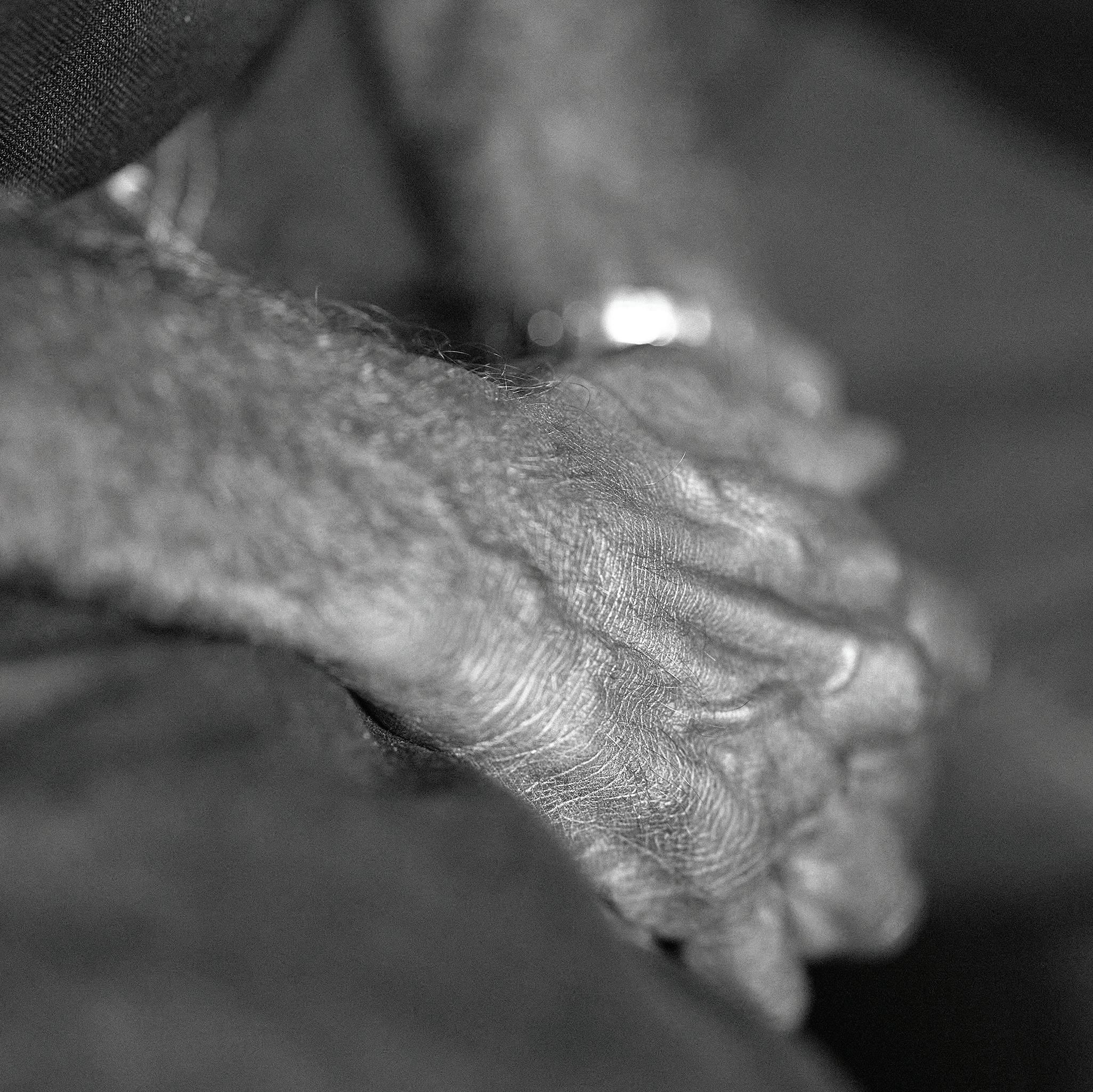
CELEBRATING A YEAR OF STRONG PROGRESS FOR OUR ONSLOW IRON PROJECT – NOW UNDER CONSTRUCTION AND LEADING OUR TRANSITION TO LOW-COST, LONG-LIFE OPERATIONS.
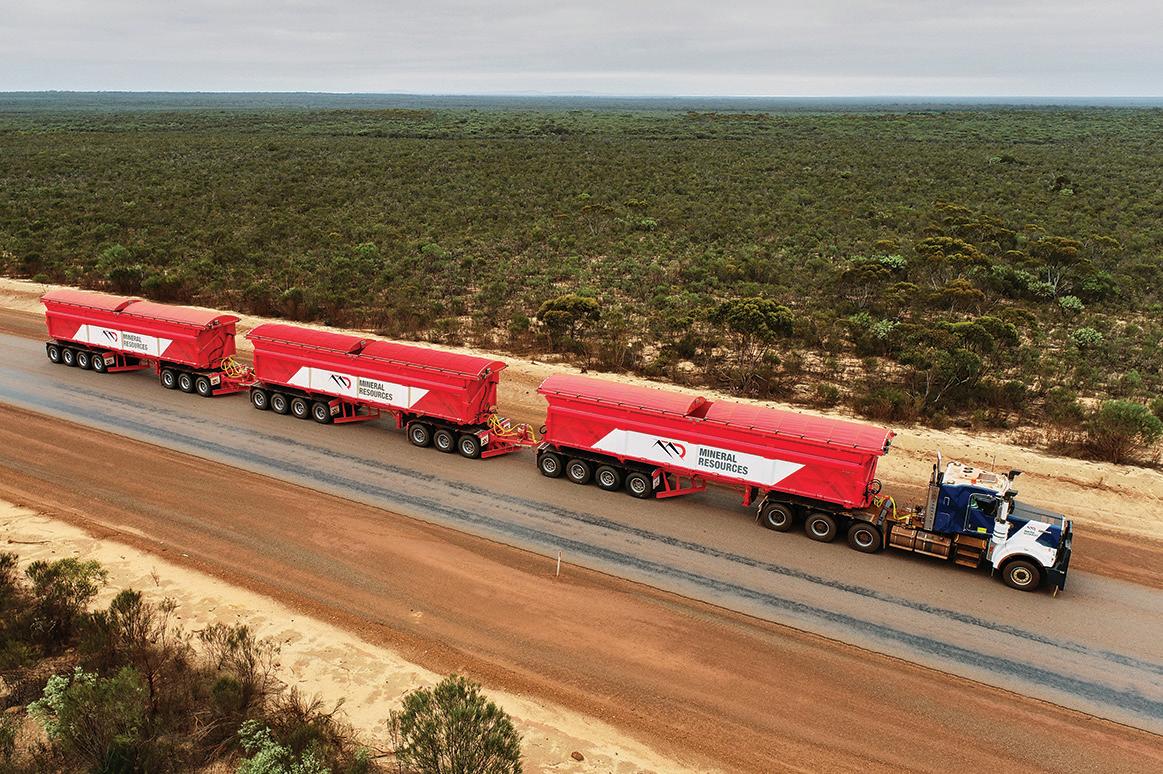

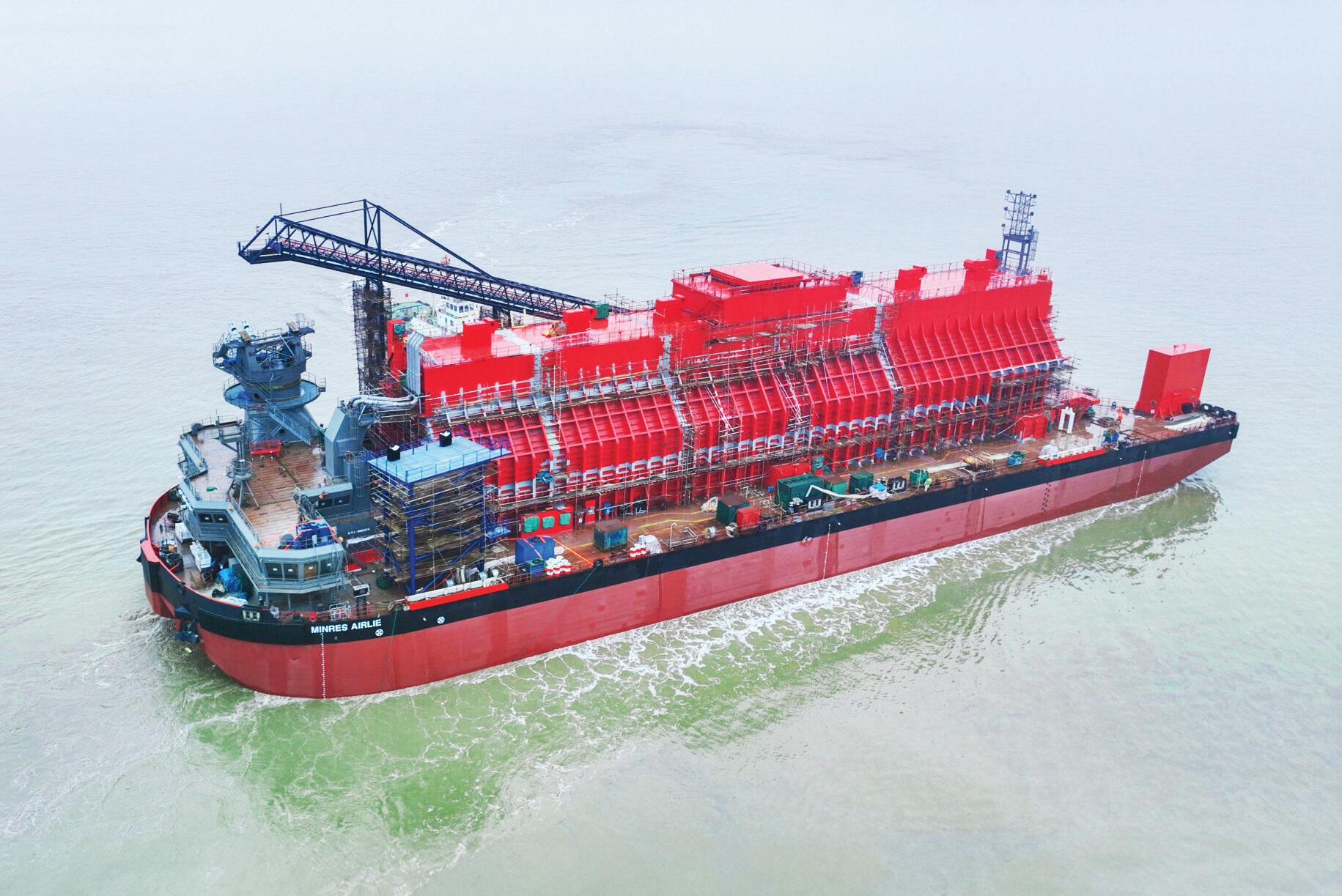
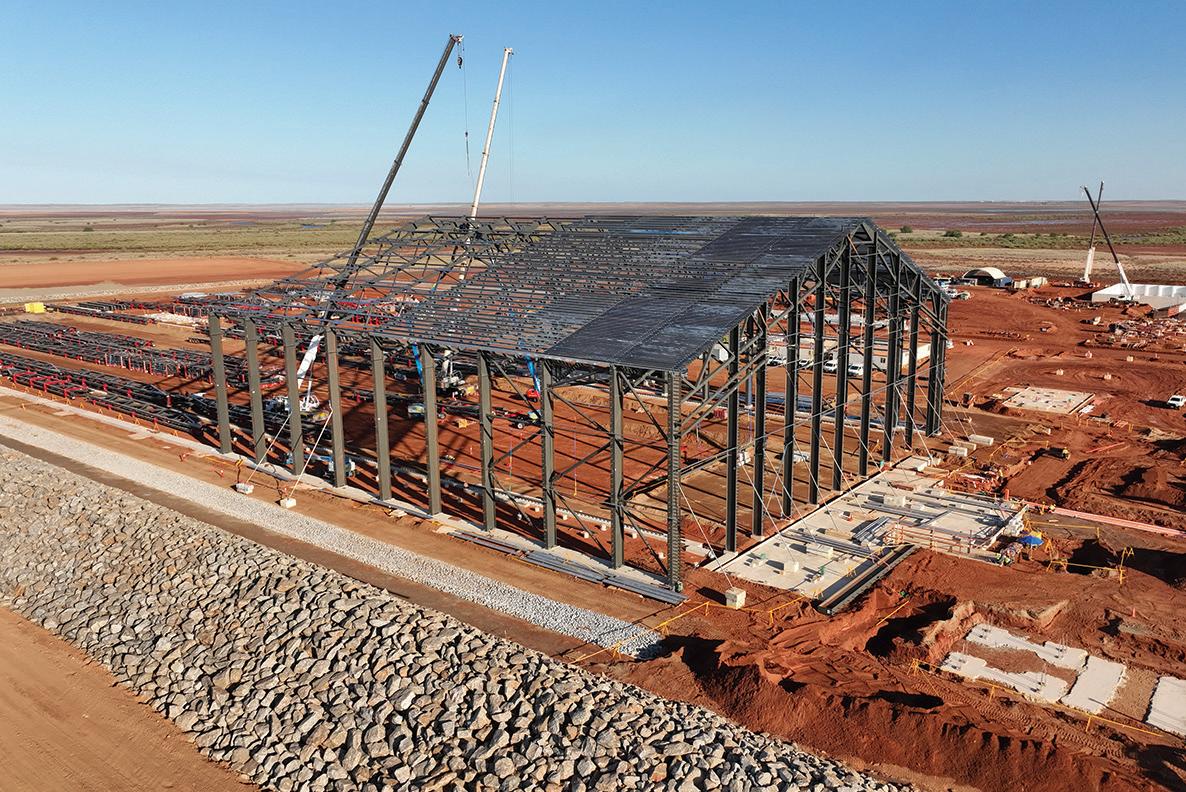
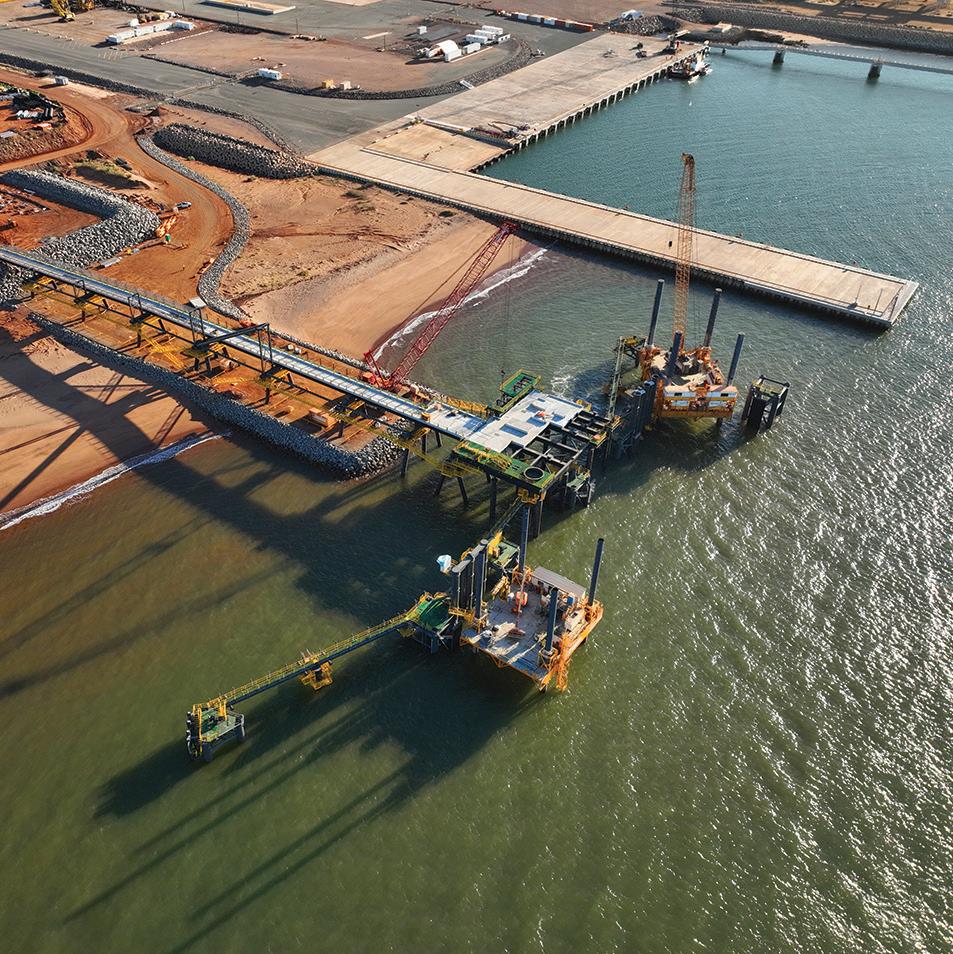
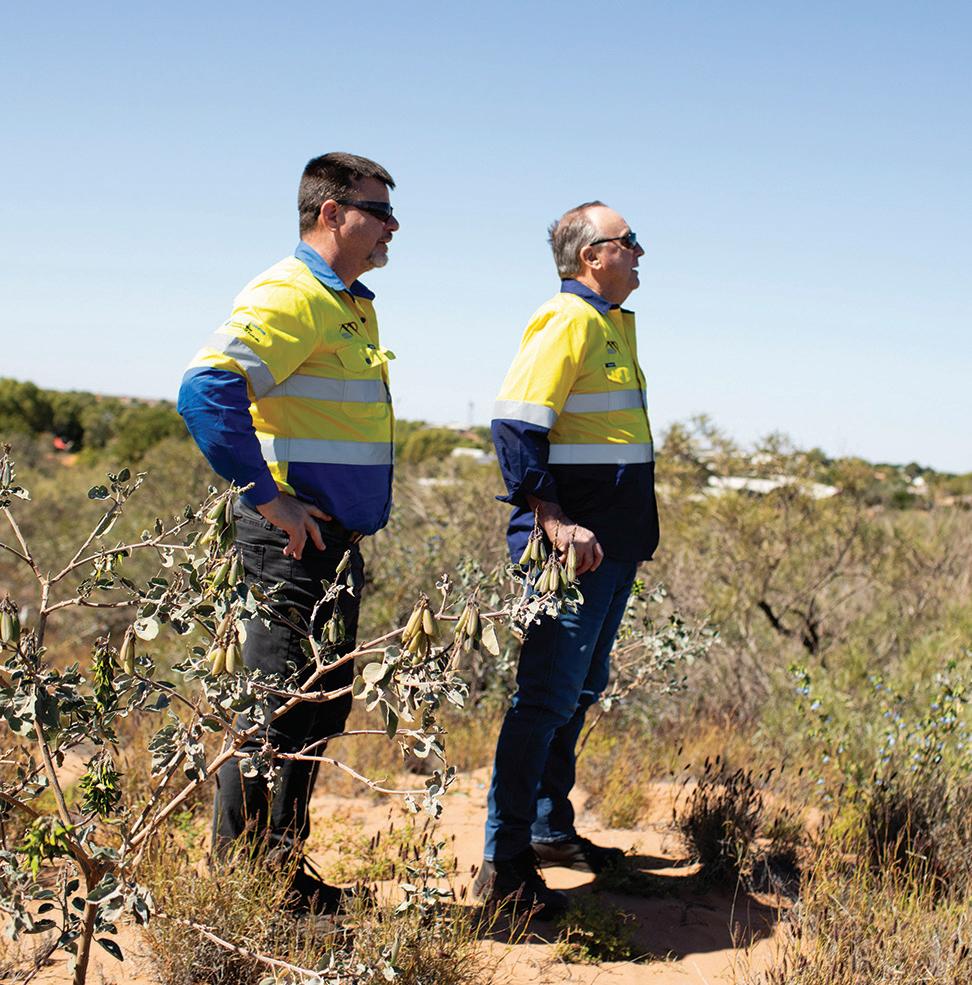





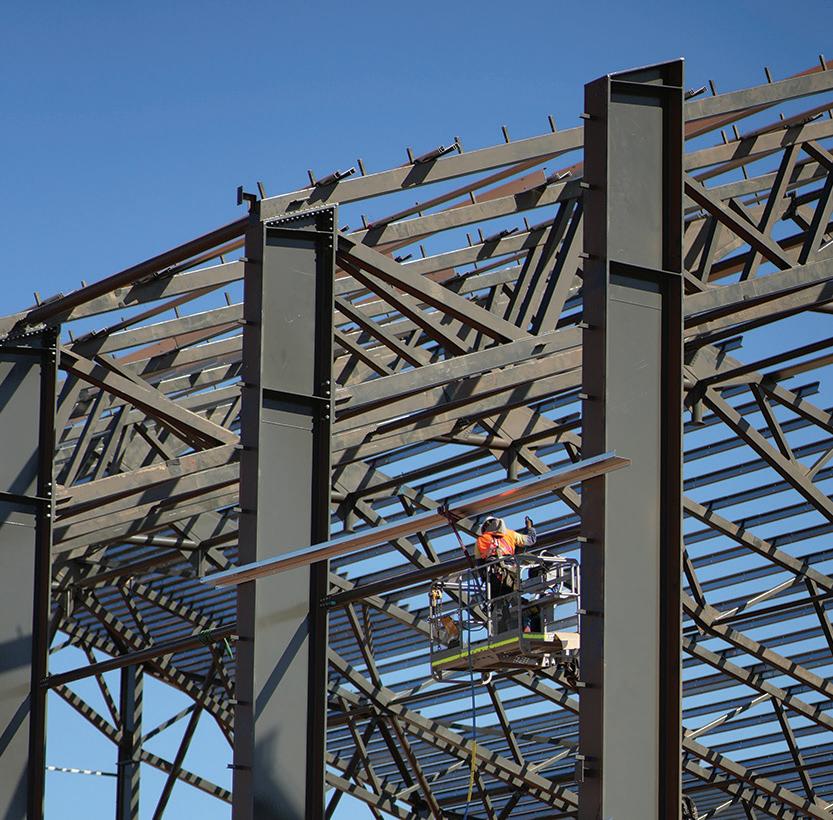
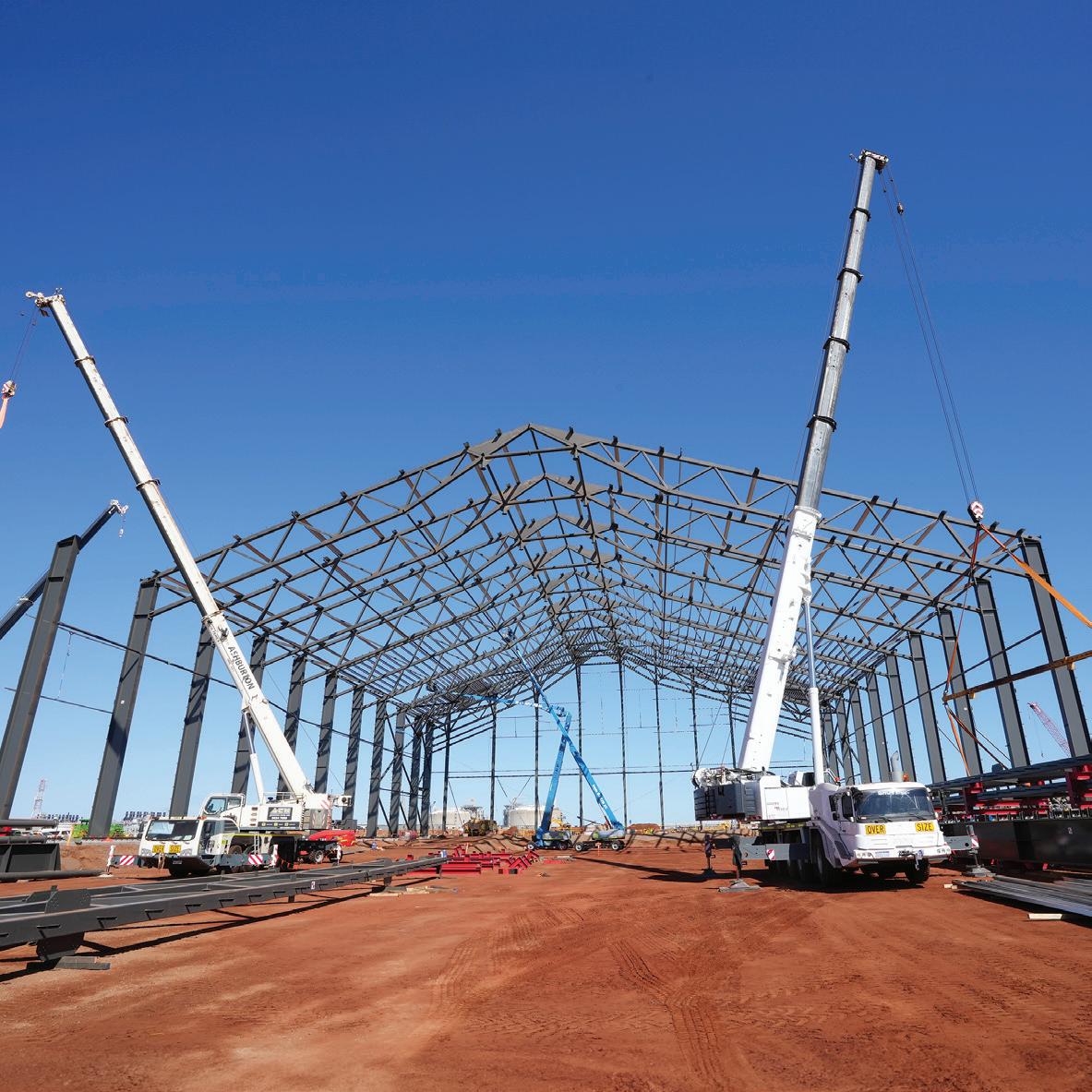
A: 20 WALTERS DRIVE, OSBORNE PARK WESTERN AUSTRALIA 6017 P: LOCKED BAG 13, OSBORNE PARK LPO, OSBORNE PARK, WESTERN AUSTRALIA 6916 T: +61 8 9329 3600 F: +61 8 9329 3601 E: RECEPTION@MRL.COM.AU W: WWW.MRL.COM.AU







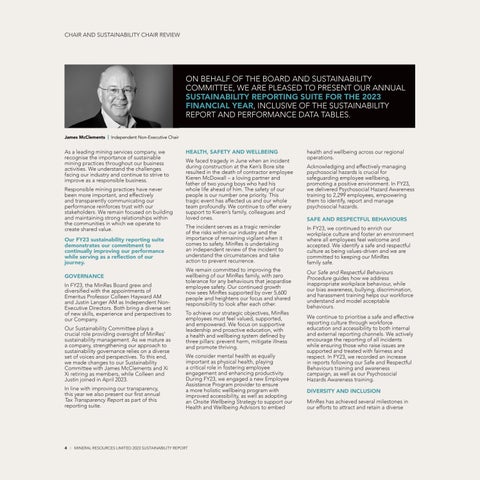























































































 Chris Soccio | Chief Executive Iron Ore
Chris Soccio | Chief Executive Iron Ore








































































































































